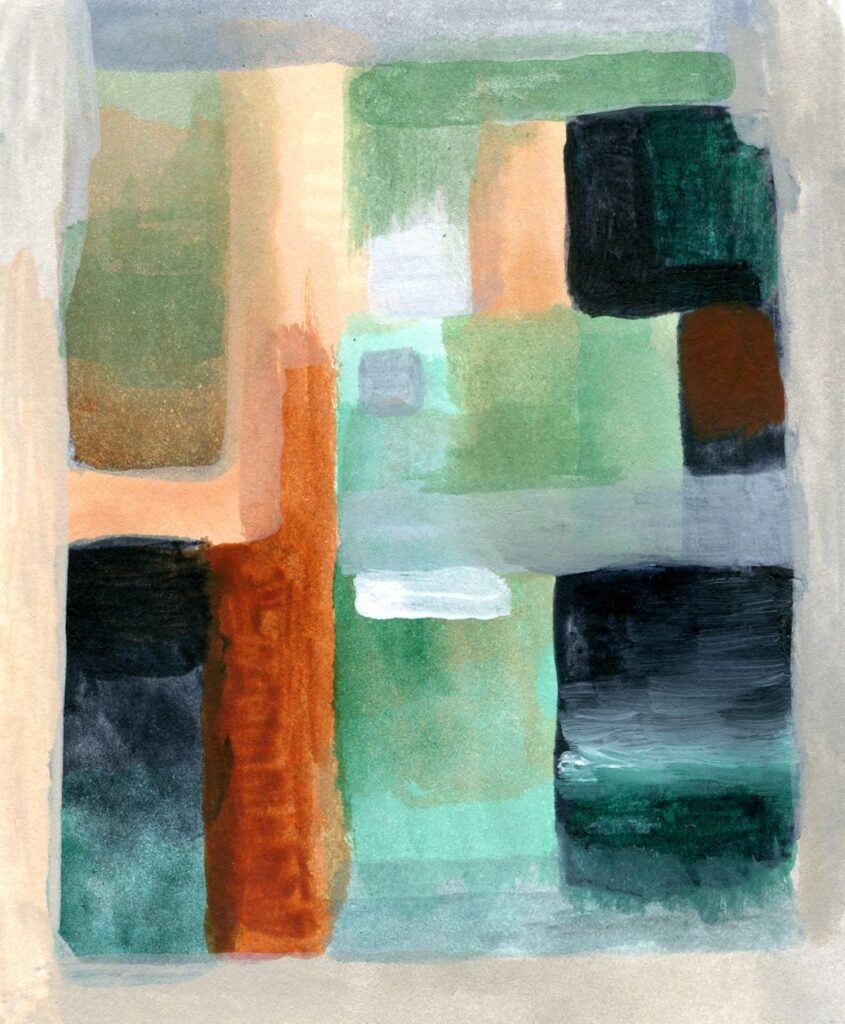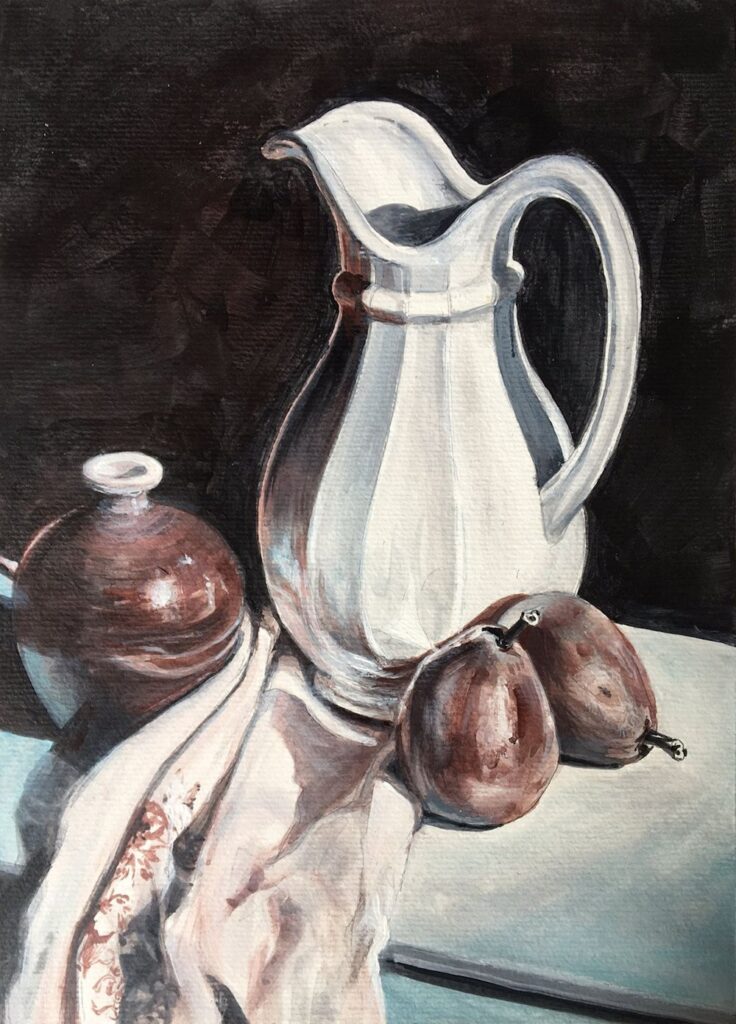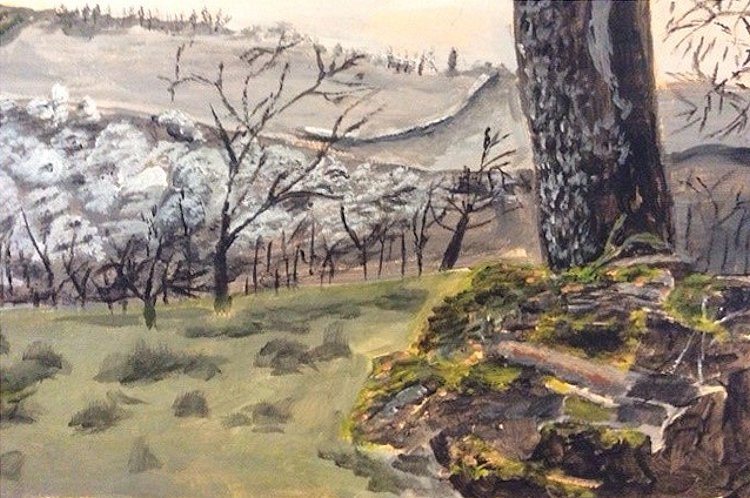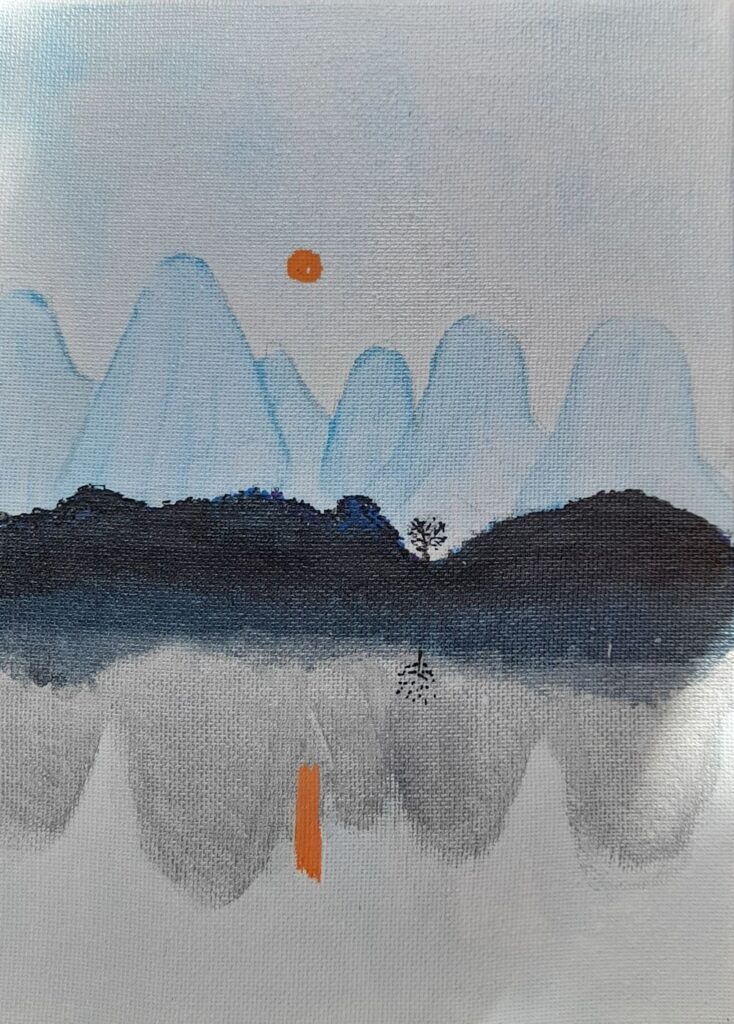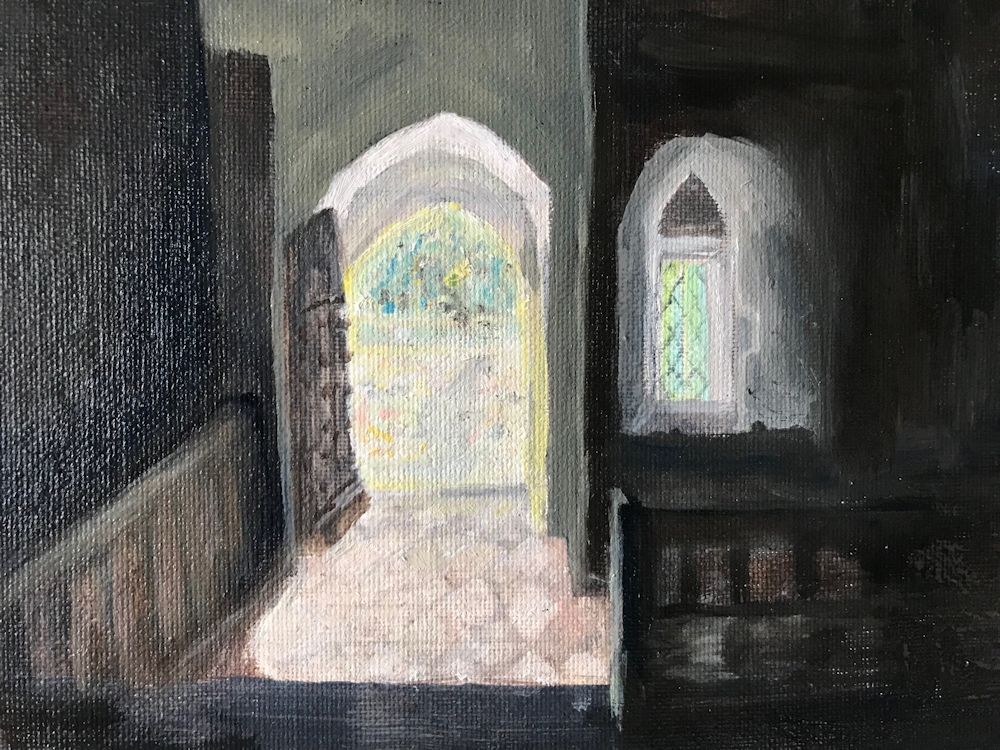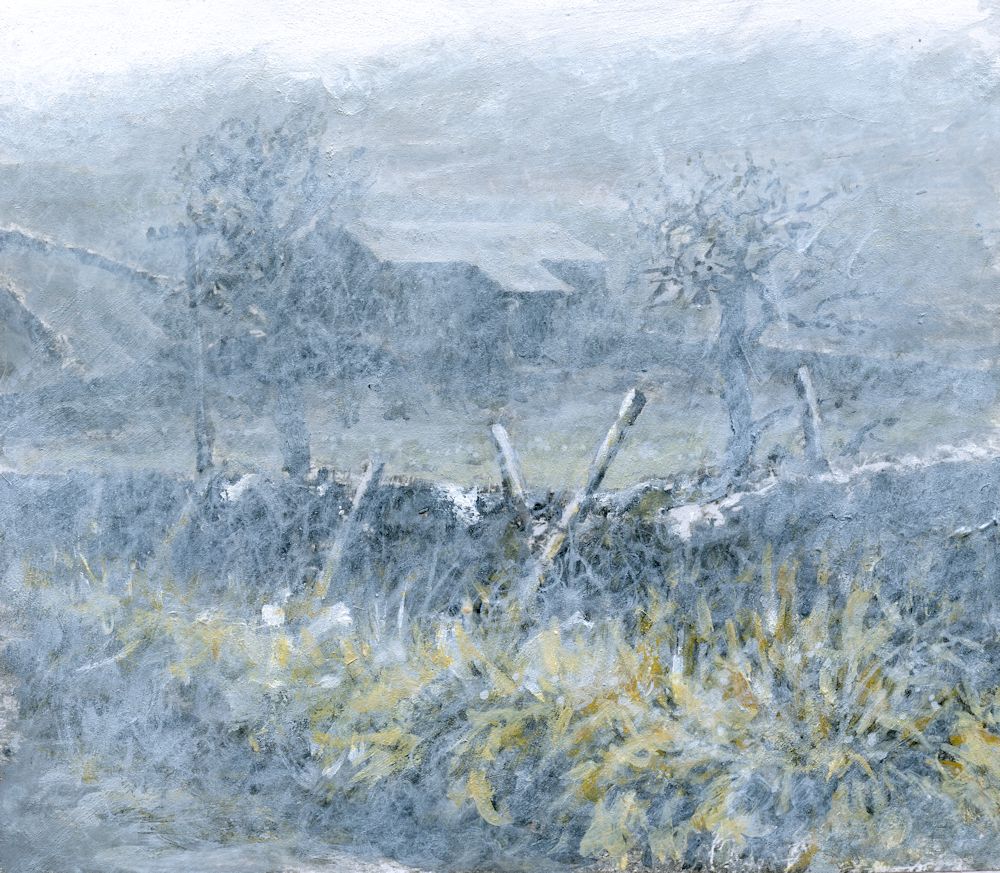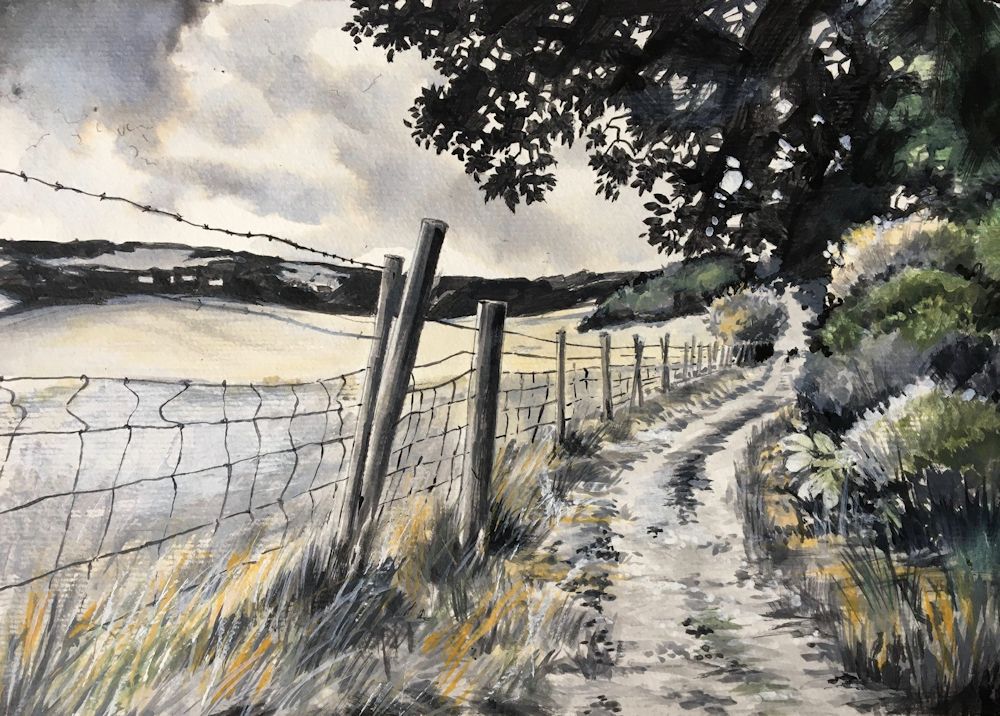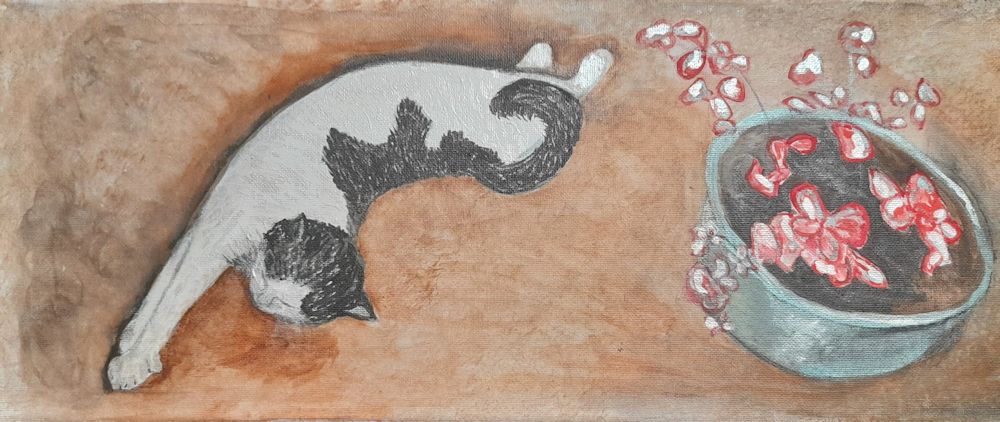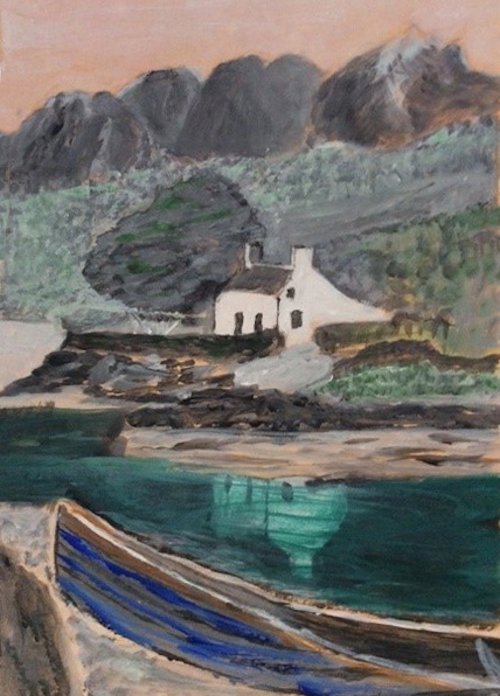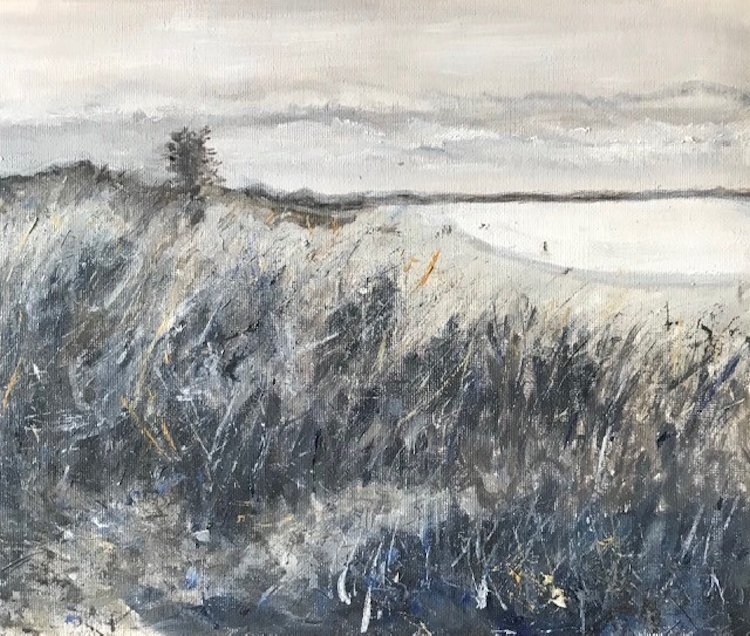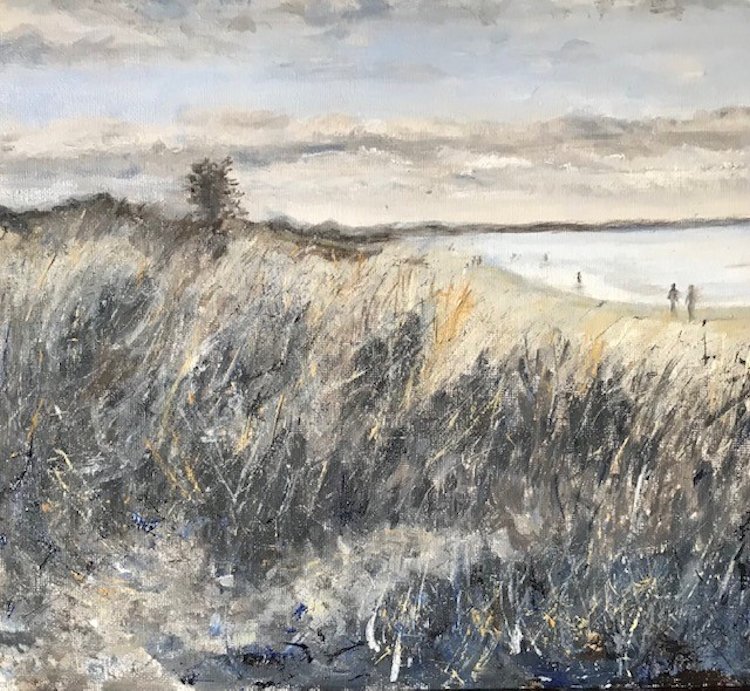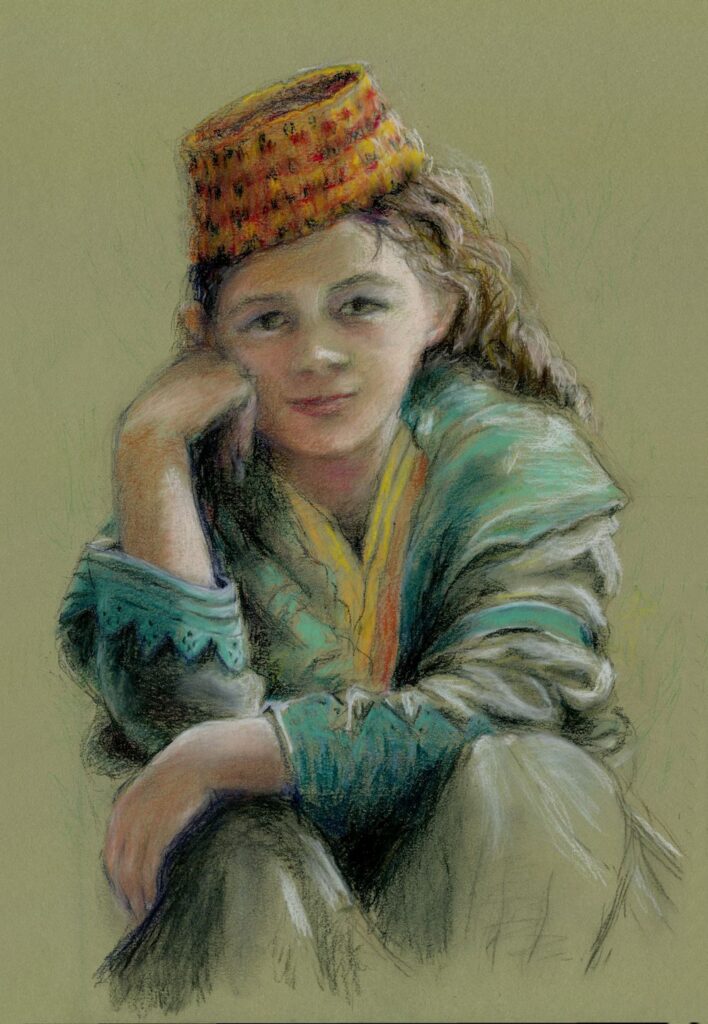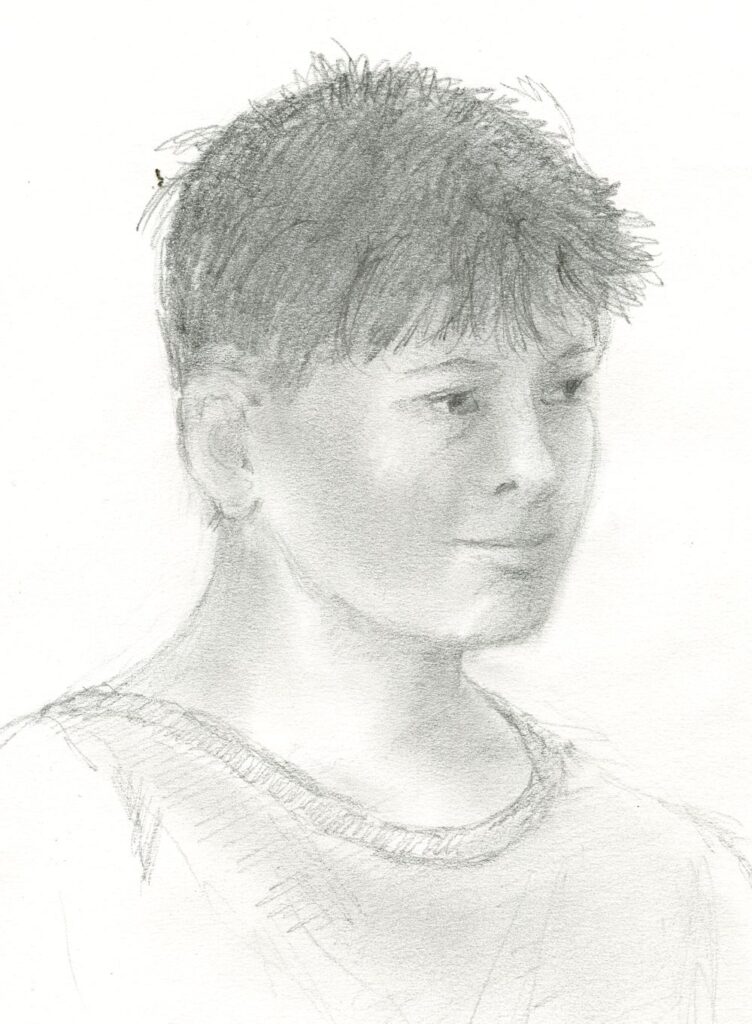Category Archive: Uncategorised
Almost Monochrome: Week 3
September 14, 2022
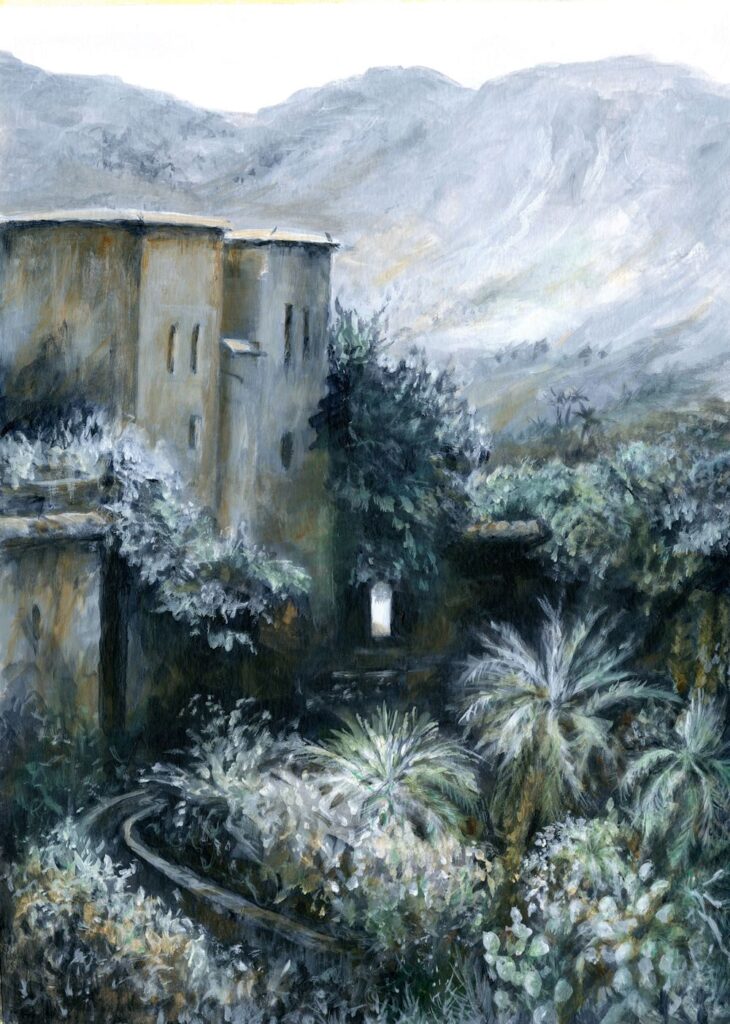
Acrylic by Jo
Painted in Indigo, White, Burnt Sienna and Phthalo Green
This week I chose to complete the painting of Oumesnat by adding Phthalo Green, alone and in mixes with the Indigo and Burnt Sienna already used. Only small amounts were used so the painting remains largely tonal. It is very different from the study of the barn in Yorkshire where the misty feel was added with opaque scumbles of white, Here everything remains relatively clear and with huge tonal shifts. I did alter some of the foreground vegetation but kept to the chosen pigments.
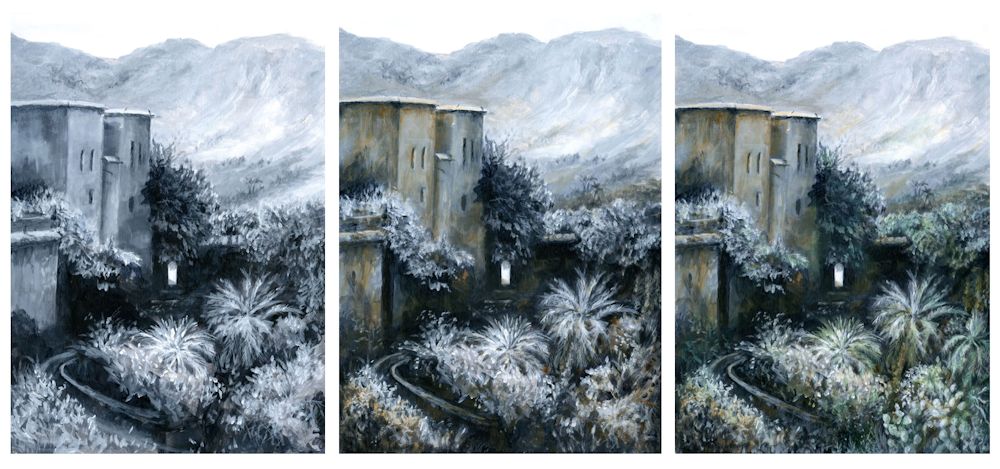
Choosing the Pigments to suit Your Painting
This can only be done by experiment and can be done as shown in the last post, or less formally as below where I have painted Indigo, Burnt Sienna and Phthalo Green unmixed to see how they would look together as saturated colours; mixed with white; and lastly by mixing any or all of these pigments together in varying proportions. Phthalo Green is a very strong pigment so only minute amounts were needed to effect the subtle changes I wanted to make in the painting above.
I like this way of working because you end up with little abstract paintings which can be quite fun in their own right. You may of course choose very different pigments to work with your monochrome base colour. It is also evident that I could have chosen to work in a much brighter way while still maintaining strong tonal contrasts.
This week the challenge will be to either add another hue to the painting or to start a new work. This time choose your main tonal colour but instead of adding the colour after making a purely monochrome work try and incorporate one or two more pigments in a subtle way as you progress. This painting should still rely heavily on tone for its impact but may end up being more colourful than the painting featured in this post. Have a look at the two Pinterest board links below for ideas or look at paintings by Andrew Wyeth, Victor Mirabelli, Alexandre-Louis Jacob or some of the sunset scenes painted by Anton Mauve.
https://www.pinterest.co.uk/jhall1282/limited-palettes/more-colour-subtle/
https://www.pinterest.co.uk/jhall1282/limited-palettes/more-colour-bright/
Choose to work entirely from your own reference or work in the spirit of one of these artists.
Your Paintings:
Almost Monochrome: Week 2
September 7, 2022
The image above is of the same painting that featured in last week’s post but with white paint “scribbled” rather than scumbled over the surface. The coloured greys took on a greenish tinge as in the chart below.
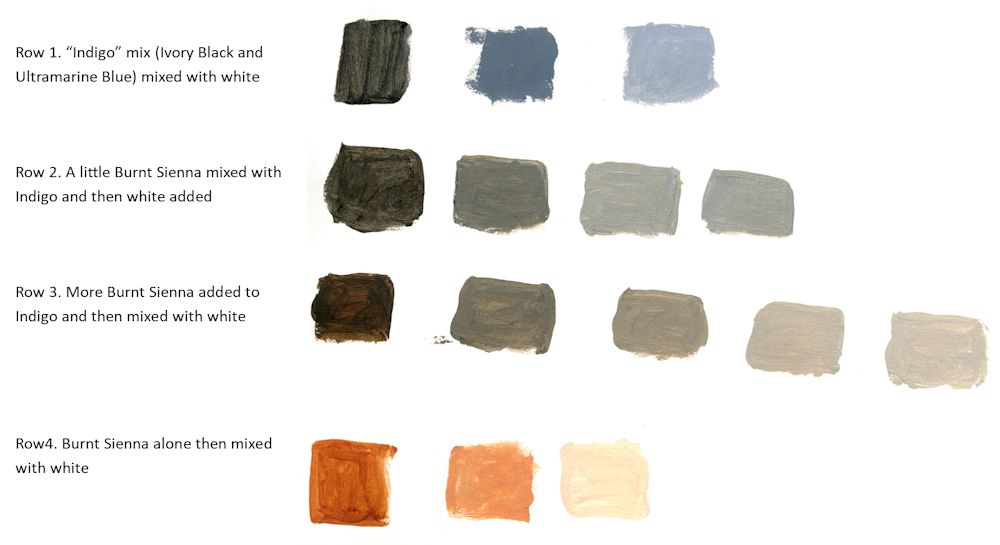
This week I made a large mix of Ivory Black and Ultramarine Blue to make an indigo like colour.
This was then mixed with White and burnt Sienna as in the chart above. Note how much bluer the greys are when indigo is mixed with white. Also note that because Burnt Sienna is much redder than Yellow Ochre their is no greenish tinge to the coloured greys, they just get warmer as more Sienna is added.
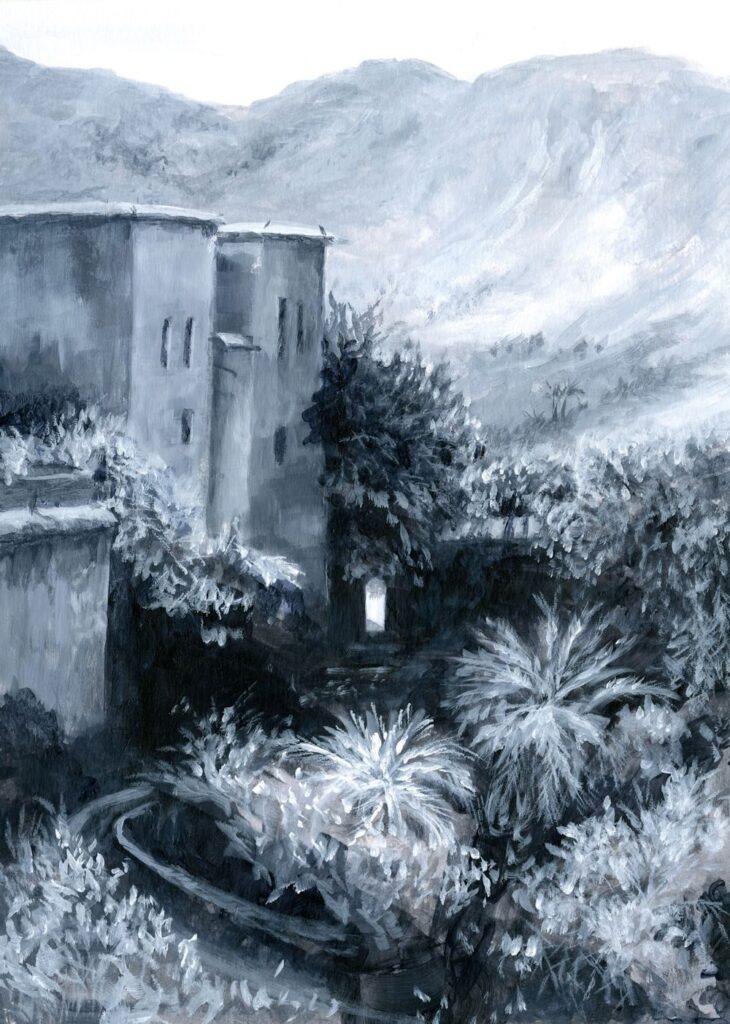
Acrylic by Jo
For this painting a large amount of an Ivory Black and Ultramarine Blue mix was made, then a monochrome painting created using this mix with varying amounts of Titanium White
This week we chose a dark pigment; black, burnt umber, Indigo or similar and added varying amounts of white to paint a monochrome picture.
Please photograph your painting at this stage then go on to identify another colour to enrich your painting. Explore a few colour mixes before homing in on the pigment you will use. Then think about how subtle or vibrant you want to make the added colour and make some colour swatches of mixes with white and the dark pigment used for the monochrome study. Last week I added Yellow Ochre; this week I will be adding Burnt Sienna and will post the result in a few days.
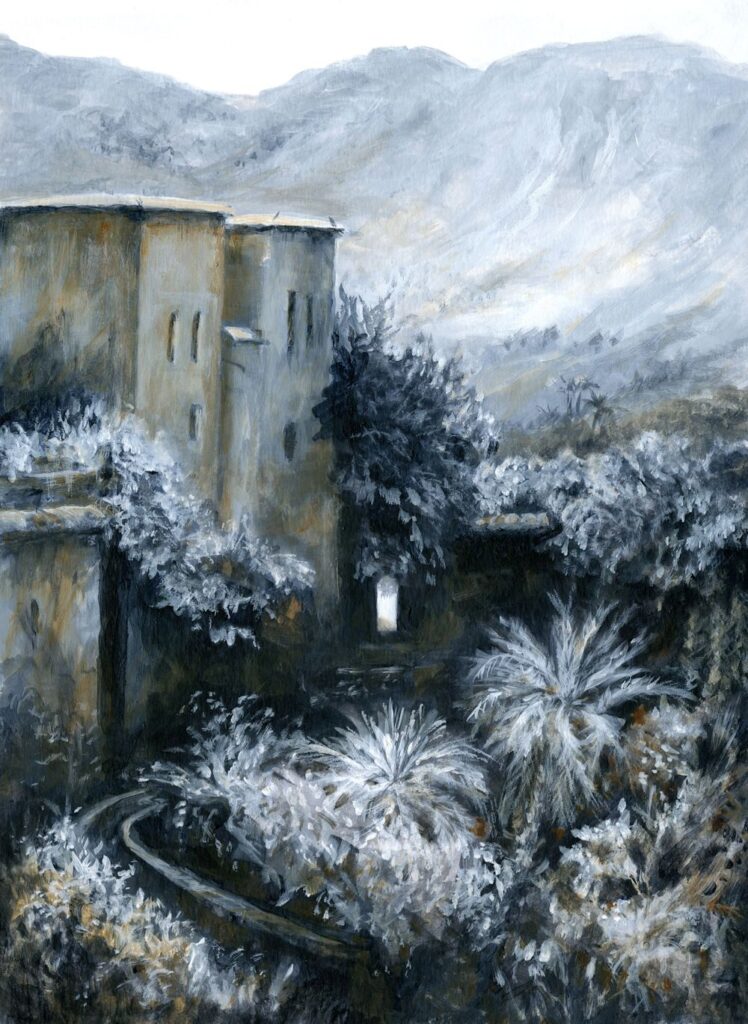
Either complete your painting during the week or at next week’s session when we will discuss adding a third colour into the mix. In any event please send an image of your colour mixes and a photo of the monochrome painting.
Your paintings:
Almost Monochrome: Week 1
September 1, 2022
Week 1: Monochrome mixes; plus a colour
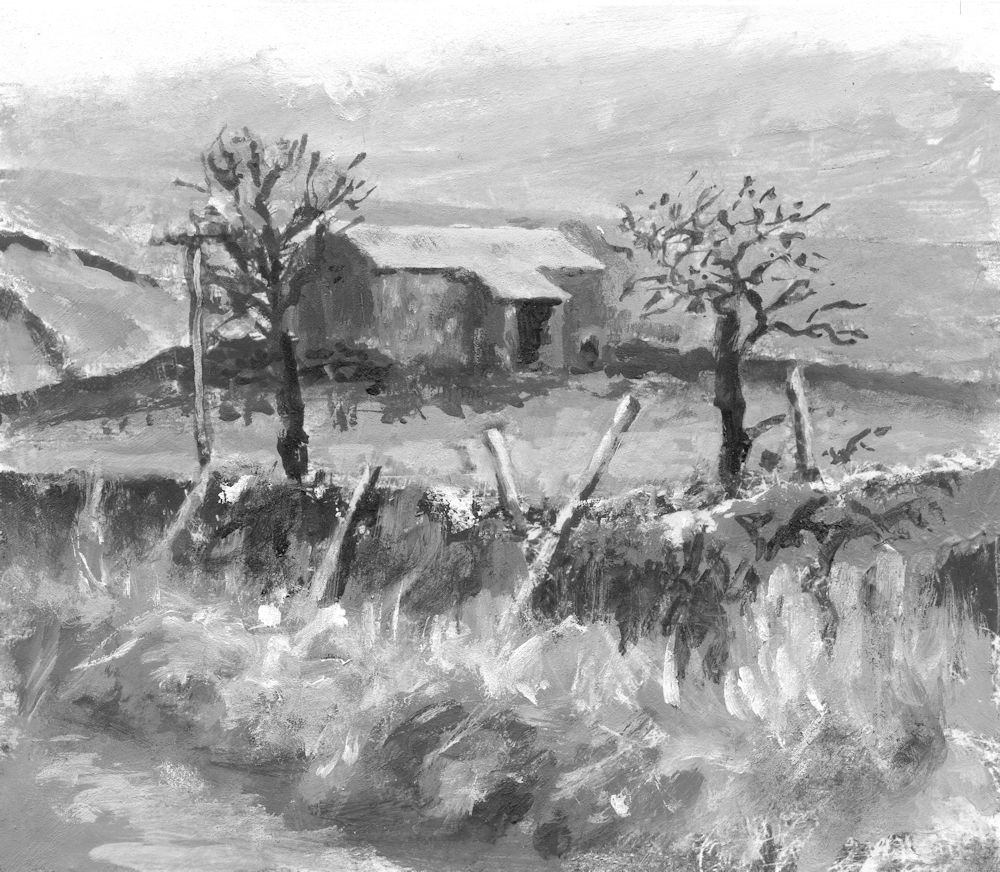
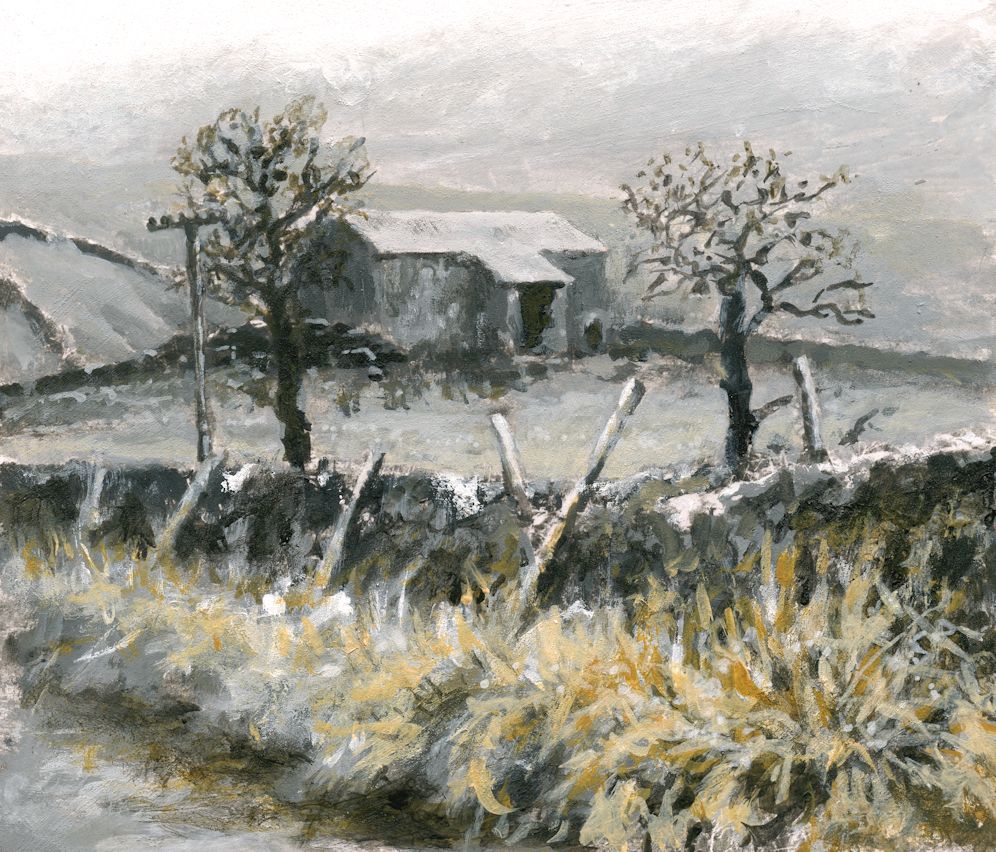
Alone or in mixes with white the Yellow Ochre appears bright and warm, bringing the foreground forward. Where small amounts of Yellow Ochre have been added to pale grey mixes a coloured grey with a greenish tinge resulted. Because the mixes were opaque I was able to modify the tones as well as the colour.
The roof of the barn was left untouched.
See further on in this post for making colour mixes to suit your composition.
Working in monochrome alone can be very dramatic. Introducing a subtle colour can soften this and alter the atmosphere of a painting. Over the next four weeks we will explore some of the possibilities.
Monochrome paintings rely on tone, shape, line and mark making for their impact, and although it is easy always to think of monochrome as a work constructed of black and white plus greys mixed from black and white, artists have used other colours such as Burnt Umber and Prussian Blue in mixes with white as a tonal bases for their work.
All paint hues can be muted either by adding black or by adding small amounts of their complementary colours. For these sessions we will work exclusively with tone and adding colour to black, white and grey mixes rather than using complementary colours, although you may like to work a composition using Neutral Tint/white, sepia or bunt Umber/white, or even Prussian Blue/white mixes as a tonal base.
Have at the ready; titanium White, Black and a few colours; yellow , Yellow Ochre or Raw Sienna, a red, a blue and a lemon yellow or similar pale yellow.
Shades, Muted Colours and Tints
Colours can be muted by adding black to make shades or by adding white to make tints. This range can be extended by adding the colour to greys made with mixes of black and white as below. It is useful to make a range of greys and try adding increasing amounts of a colour to each mix. It is very much the artist’s choice to decide on which parts of a composition will include some colour and which to leave as monochrome.
1.Reference the haunting works of Victor Mirabelli who uses limited amounts of subtle colour in largely tonal paintings of old farm buildings and barns. Google the artist or see a couple of his works and a couple of works by other contemporary artists on the following Pinterest board.
https://www.pinterest.co.uk/jhall1282/limited-palettes/almost-monochrome/
2.Find a landscape reference with an interesting tonal structure.
3.Then make up some colour swatches from black to white and experiment to find what happens when amounts of a different of a colour are added. It may be useful to make a formal grid for at least one colour and a few less formal experiments to home in on the colour that will suit your composition best. An example of how this could be set out is below.
| Monochrome base plus white in this case black | White | Pale Grey | Mid Grey | Dark Grey | Black |
| more white | more grey | more black | |||
| more white | more grey | more black | |||
| more white | more grey | more black | |||
| +white | +grey | +black | |||
| Pure colour e.g. yellow Ochre (YO) | YO | YO | YO | YO | YO |
My attempt this week wasn’t great. The dark grey was too dark! But it will give you the idea:
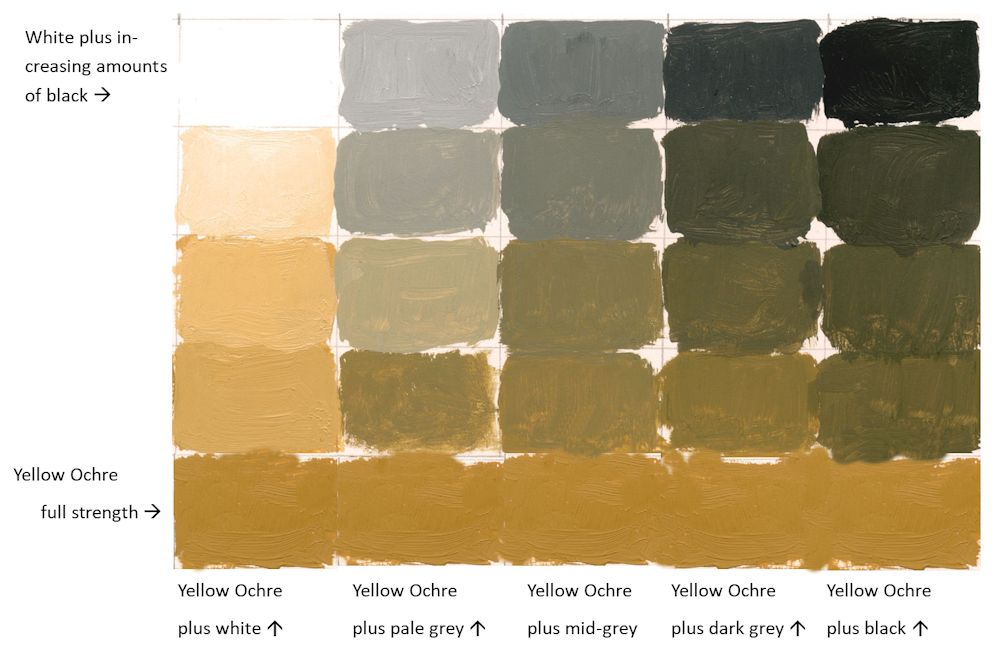
4.Make your own painting working in monochrome initially, and then working your chosen colour into the mix as appropriate.
During the session I’ll start a painting with a different monochrome base, perhaps using burnt umber or either indigo or a Payne’s Grey (blue shade).
Your paintings:
The next three images are different stages in the development of an oil painting by Virginia
Portraits of Older Children: Week 6
July 20, 2022
In this final week, after reviewing the work it would be good to finish any outstanding projects, complete last week’s portrait or start a new portrait with more than head and shoulders.
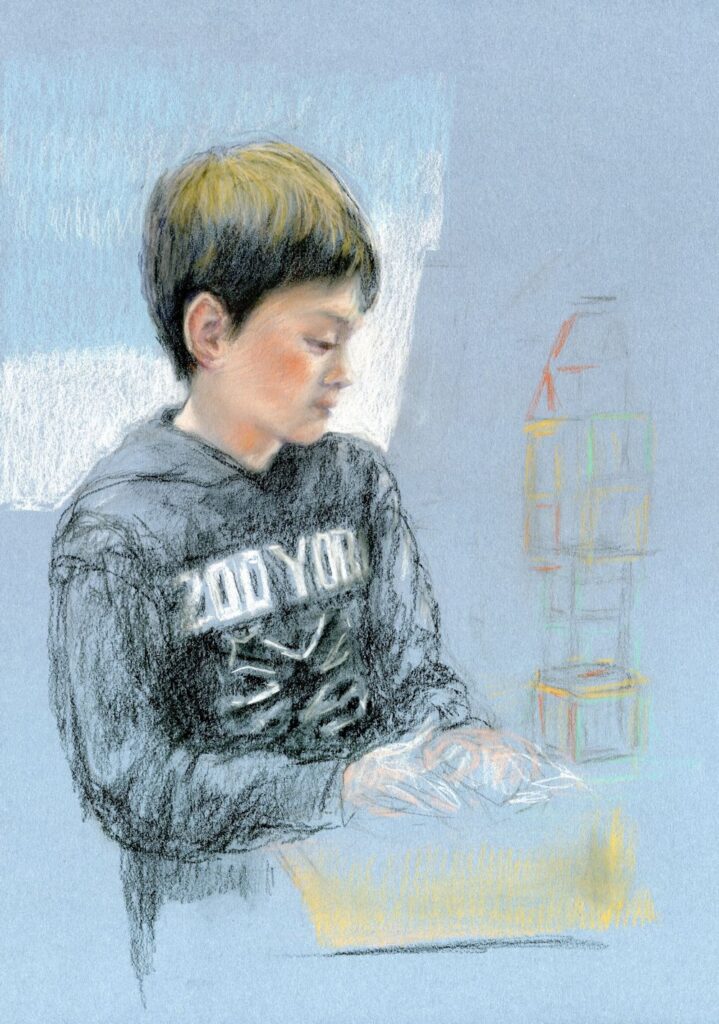
Charcoal and pastel pencil by Jo
Here the hands have been very freely sketched in. I am still deciding whether to work further on them or leave them suggesting movement. I may add a few more of the magnetic building blocks in the foreground instead.
You may like to work a portrait of a child engaged with a particular activity or in costume for a school play. If so aim to include some relevant objects. We haven’t talked much about backgrounds but look how effective it is to use the background colour and tone as part of the composition as in Toby at 9.
If you attempt a full length portrait you may like to work at a larger scale.
With the standing figure remember that the neck is always directly above the foot which is bearing most of the weight and central if the load is being equally shared by both feet. It can be useful to use a grid as last week or especially in the case of a standing figure drop a vertical on your reference and your support and measure heights and widths from that.
Your Paintings:
Portraits of Older Children: Week 5
July 13, 2022
This week you may like to work a profile view or include more of the figure.
First, a recap on useful mixes for flesh tones from a basic palette:
Two earth colours that are useful both for skin tones and hair are Burnt Sienna and Burnt Umber.
Burnt Umber makes great darks when mixed with Ultramarine Blue. When mixed with varying amounts of primary colours and white a great variety of skin colours can be mixed using Burnt Sienna and for darker complexions with Burnt Umber. A few of these mixes are illustrated below:
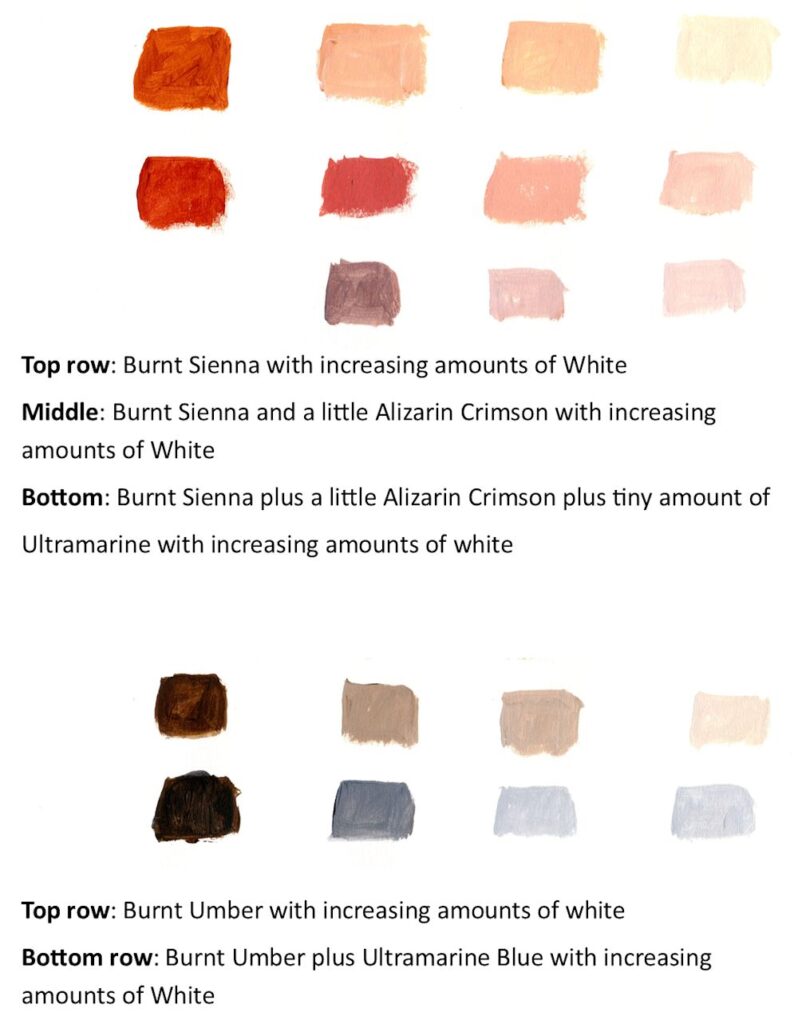
Try mixing other combinations of primary colours with Burnt Sienna and Burnt Umber and you will be able to make lively muted and coloured grays for shadow areas as well as much warmer and cooler skin colours.
In a way the above is a short cut as similar colours can be mixed from primary colours.
Below is a tiny sample of some of the colours that can be made with Alizarin Crimson, Ultramarine Blue and a pale yellow like Cadmium Yellow Pale or similar.
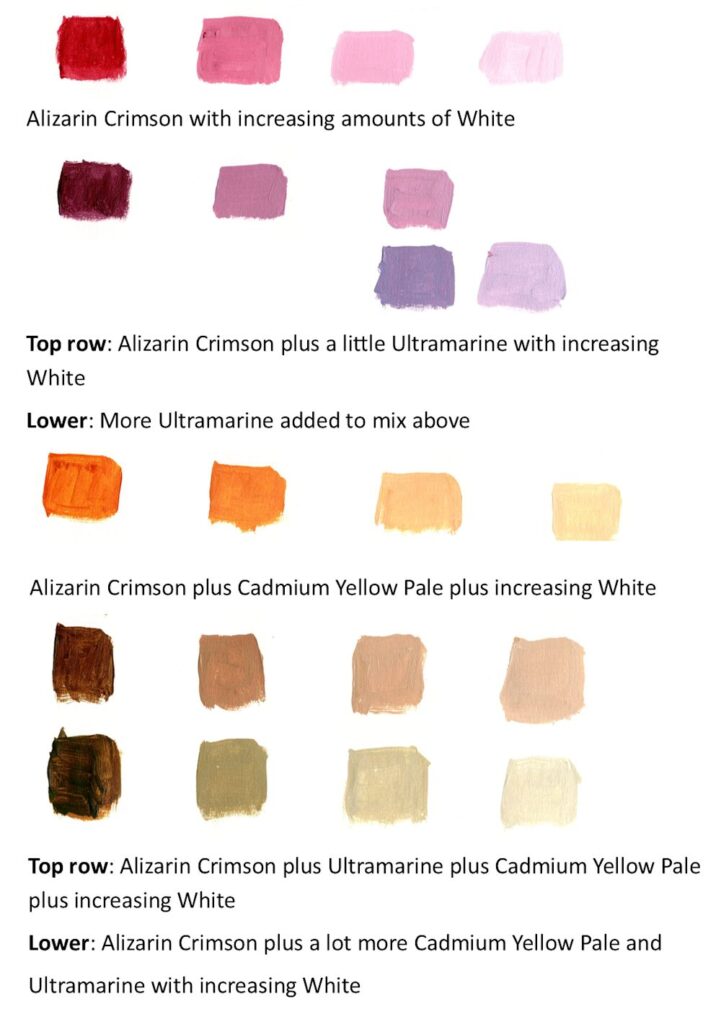
By adjusting the amounts of each pigment you can mix suitable skin colours just from these three plus white. Skin is NOT always a “flesh tint” hue; in the shadows you will find muted purples, greens and blues and coloured greys. As a general rule paint the mid tone areas first then at least one of the darkest and one of the palest areas to set the range of tones within which you are going to work. Also as with drawing, work on the largest shapes first before moving on to the detail.
This week’s challenge:
Arms and the way a person sits can reveal a lot of their character. With the head studies so far we generally included the shoulders and looked at their relation to the neck and head. This week we may include arms and shock horror, hands which I know are generally believed to be difficult. Well they are complicated and they are a challenge for everyone but one that can be overcome by understanding their structure. Also hands do not always need to be depicted in great detail. Sometimes all that is needed is an indication of their general form as revealed by the light.
If you can look at how arms and hands are depicted by other artists. Some examples are on one of my Pinterest boards, link below:
https://www.pinterest.co.uk/jhall1282/portraits/older-children-portraits-including-hands/
Perhaps try drawing your own hand to familiarise yourself with the way in which the finger joints and finger ends lie on a curve. Sit yourself in front of a mirror and observe how your shoulders and arms look when you have your hands on your knees, when one hand clasps the other in your lap, and when you fold your arms, and any other natural looking pose you can think of. If possible do a few quick sketchbook studies of the way your own head, shoulders arms and hands arrange themselves in these various positions.
I know you are not the same as a 9 to 14 year old BUT this will help you look at your reference photograph in a constructive way.
Below are two photos of children; look at them objectively in the same way, relating the sizes and angles of the various parts to each other. Then find a reference of your own and decide on how much you want to include in your portrait study and then work out the composition taking on board the structures and the lighting.
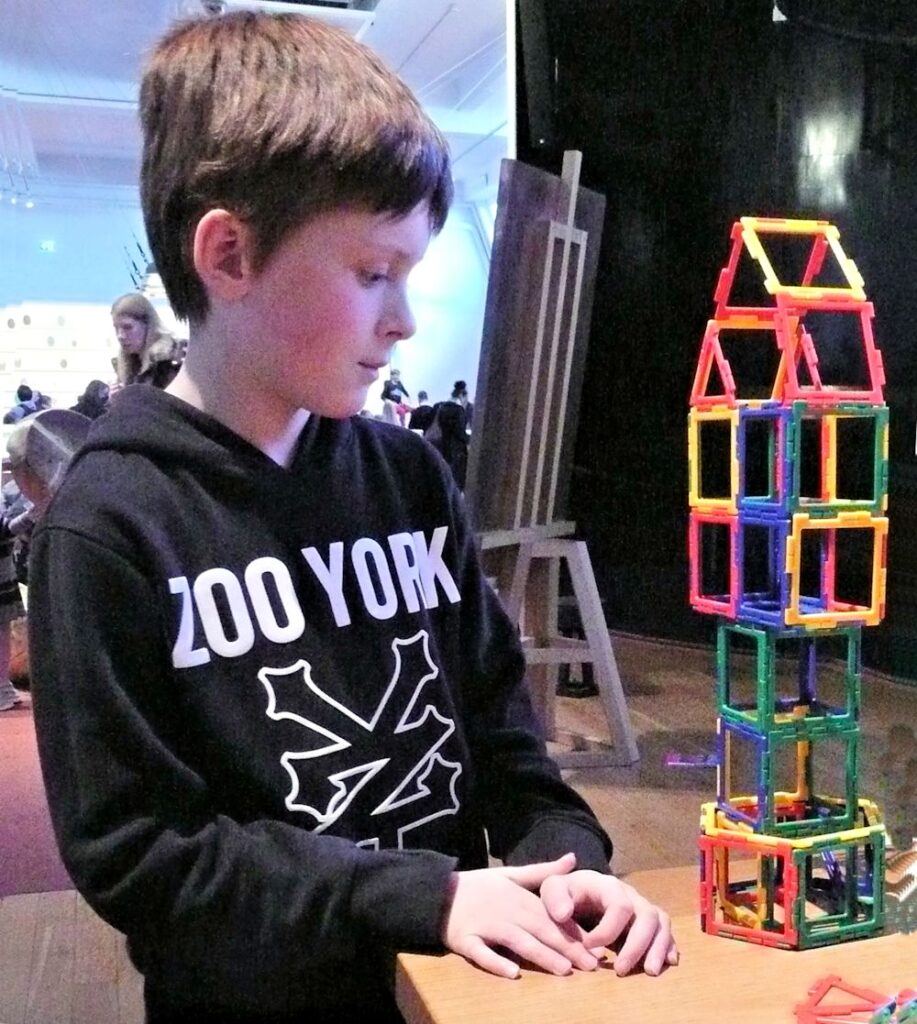
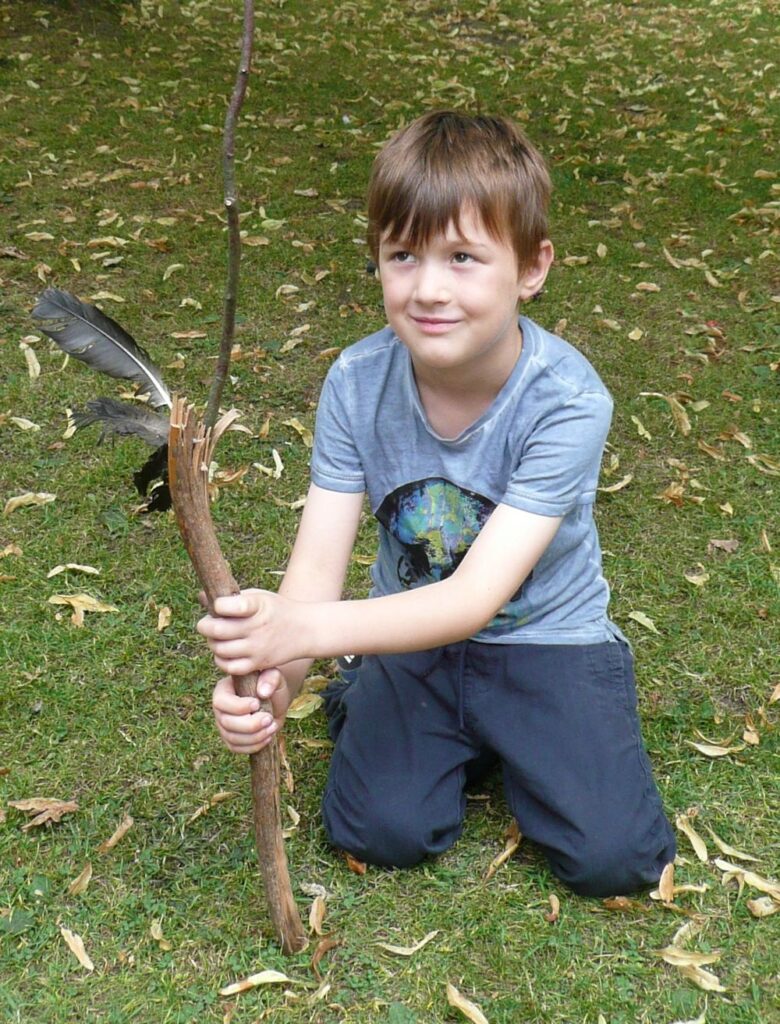
Think hard about the overall width and breadth of your figure; this will be very different in the case of standing and sitting figures. Make sure you plan the composition well and think about how the figure will be placed on the support. Similarly make sure that if you are transferring your photo reference to your support that the figure maintains the same aspect ratio i.e. the overall height and width of the figure in your reference is in the same proportion on the support.
You may like to use the grid method for this, even a simple four squares by three square grid drawn on the reference and a larger grid drawn in the same proportion on the support will help and allow you to check angles and lengths especially in complicated poses.
On your canvas or board either
1.Mark out the main lines of the composition and then work in paint or pastel
or
2.Make a tonal study in paint this week to which thin glazes of colour can be used to finish the portrait next week.
Your drawings and paintings:
Portraits of Older Children: Week 4
July 7, 2022
This week we will look at faces of older children in three quarter view. This is a different challenge as most of the front of the face can be seen but of course a lot of the side too.
If you have time practise drawing a few heads in three quarter view, and then mark out the board with a few useful lines ready to paint in pastel or acrylic.
Drawing a three quarter view; a few considerations
Try starting by getting the general head shape right and marking its relation to the neck and shoulders.
Make sure you get the overall width and height of your head correct and the width of the shoulders which are usually narrower than adult shoulders. Place the jaw line and suggest the position of the ear which you may have to adjust so go gently.
The features of the face can be thought of as lying on a curved plane on the front of the head. The sides of the head can be thought of as beginning where the forehead changes direction going back towards the ears. The visible width of this will vary enormously depending on whether the view is nearer to full face or nearer to profile.
Next try placing the features noting how the eyes are very different in shape than when seen full face. It will still help to put a feint construction line through them. The features lie symmetrically (more or less) on a slight curve rather than about a straight line as in the the full face view. Again it may be helpful to mark this faintly. The nose will project beyond this line i. e. stick out more!
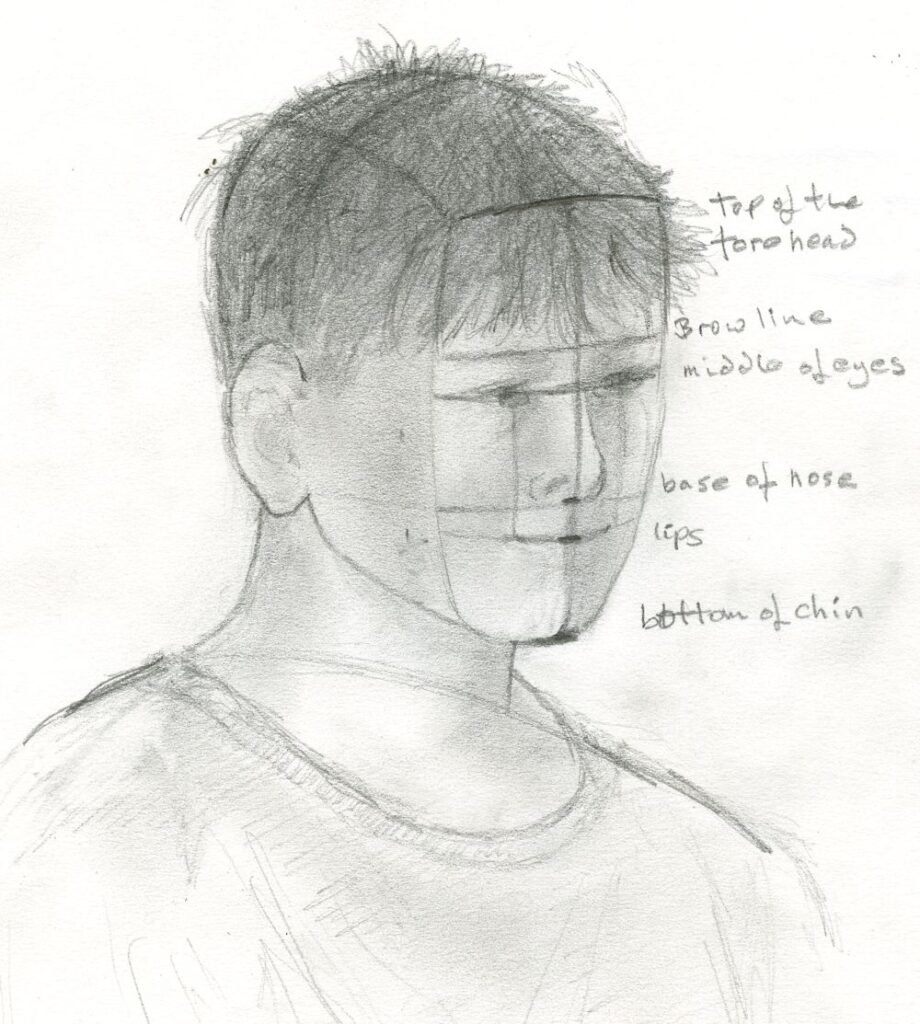
Other useful markers are the base of the nose, the distance between the base of the nose and the upper lip and the distance from the base of the nose to the tip of the chin so measure and mark them. Then mass in the hair and Toby has masses of it! Then go back refine the shapes and show the form by hatching or shading all the toned areas you can see.
Some people like to think of the face as divided into three (approximately) equal parts; chin to base of nose, base of nose to brow line and brow line to the top of the forehead. Always remember to look though, as it is the small differences that make us unique!
Really looking is the most important way, but your looking should always be questioning; widths; angles; relative sizes; tones and of course colour. Have fun with the drawing and then enjoy the painting!
Your drawings and paintings:
Portraits of Older Children: Week 3
June 30, 2022
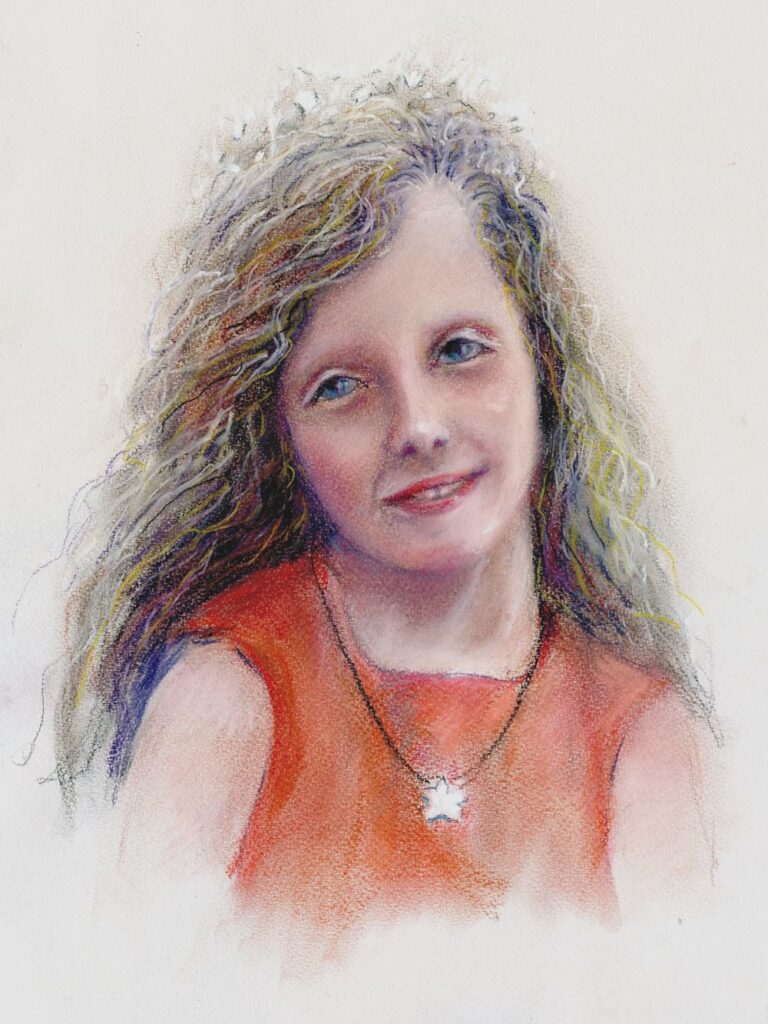
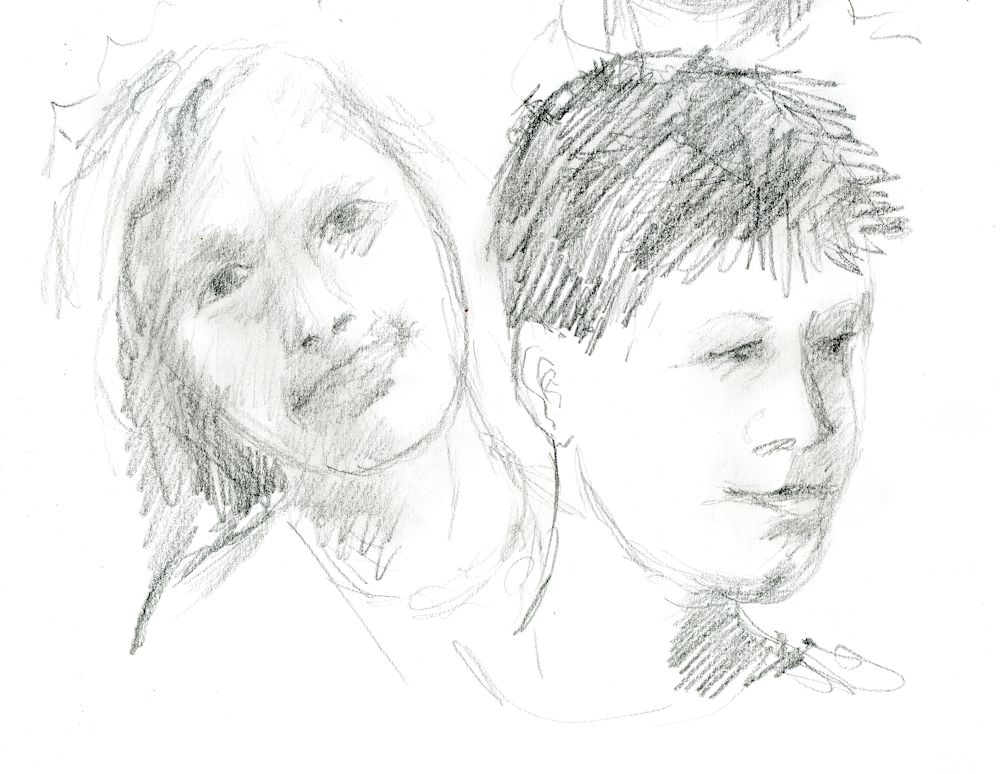
This week’s challenge is to start a portrait painting in colour. The notes below suggest ways of starting a portrait study in pastel and also in acrylic.
1. Pastel
If your chosen medium is pastel you may like to start by drawing in the main shapes quite loosely with charcoal or a pastel stick. Remember to draw the axis of symmetry of the face if working a front view and also a line through the eyes from which you can measure the positions of the other features.
When seen in three quarter view the axis of symmetry through the face will be on a curve. If looking at a profile view look carefully at the position of the ear and take note of the shape of the whole head. Then look at the forehead in relation to the nose and the jawline and chin in relation to the nose. Ask yourself questions like does the chin recede slightly?
As a general principle work the large shapes first before homing in on the smaller ones.
When you are happy with the main shapes start to work in colour. Block in the main areas of shadow with a light touch using the stick on its side for these larger areas. You will define these as the work progresses so don’t apply the pastel too densely at first. Then draw in the mid tones and finally the palest tones and details.
I have talked about tone but your work will be in colour and working out flesh tones in pastel can be challenging. One reason I used conte crayon in white, black and sanguine on toned paper last week is that it is a half way house between working totally in tone and working in colour. With small additions of blue, red and ochre these drawings can depict flesh tones quite convincingly. Experiment with the colours in your box, cross hatching, overlaying (layering) and blending to find suitable colours for your portrait.
You may like to fix the work after the main areas have been drawn and again when the mid-tone colours have been established. When working on the brightest and lightest colours as the portrait nears completion either fix very sparingly or not at all especially if working on a dark toned support.
2. Acrylic
There are several ways of starting to paint a portrait, three of which are outlined below..
1.Under drawing in charcoal developed with transparent and opaque paint.
This is described in a previous post; link below. The example is of a young woman rather than a child but a similar method and palette could be used. I like to work with a relatively limited palette and this will give your work unity.
https://www.jo-hall.co.uk/2021/03/03/painting-portraits-from-photographs-week-2-colours/
The following palette makes a good starting point and some mixes made with the colours below is illustrated in the blog post referred to above..
White, Crimson Alizarin, Cadmium Yellow pale, Ultramarine Blue, Burnt Sienna and Burnt Umber. (or similar)
Other primary colours, plus white and a couple of earth colours will also work well. The Burnt Umber was included as it gives excellent darks when combined with ultramarine. With portraits of young people you will need to keep the colours fresh and make smooth transitions of tone and colour over the face.
2. Tone the background then use paint and a brush to draw the basic shape of the head and place the features. Then develop the painting with transparent and opaque paint working from light to dark and on the large shapes first before tackling the smaller areas and detail..
3. Make a detailed monochrome under painting making all the tones a little lighter than as seen. Develop the painting by adding colour as layers of transparent glazes. The palest and brightest areas should be left till last and if necessary executed in opaque paint. This can be knocked back a bit with further glazes where necessary.
For this session we will concentrate on the first way of working. So have at the ready, a board or canvas support, charcoal, some acrylic medium and of course paints, palette, brushes and water pots.
Your paintings;
Portraits of Older Children Week 2
June 24, 2022
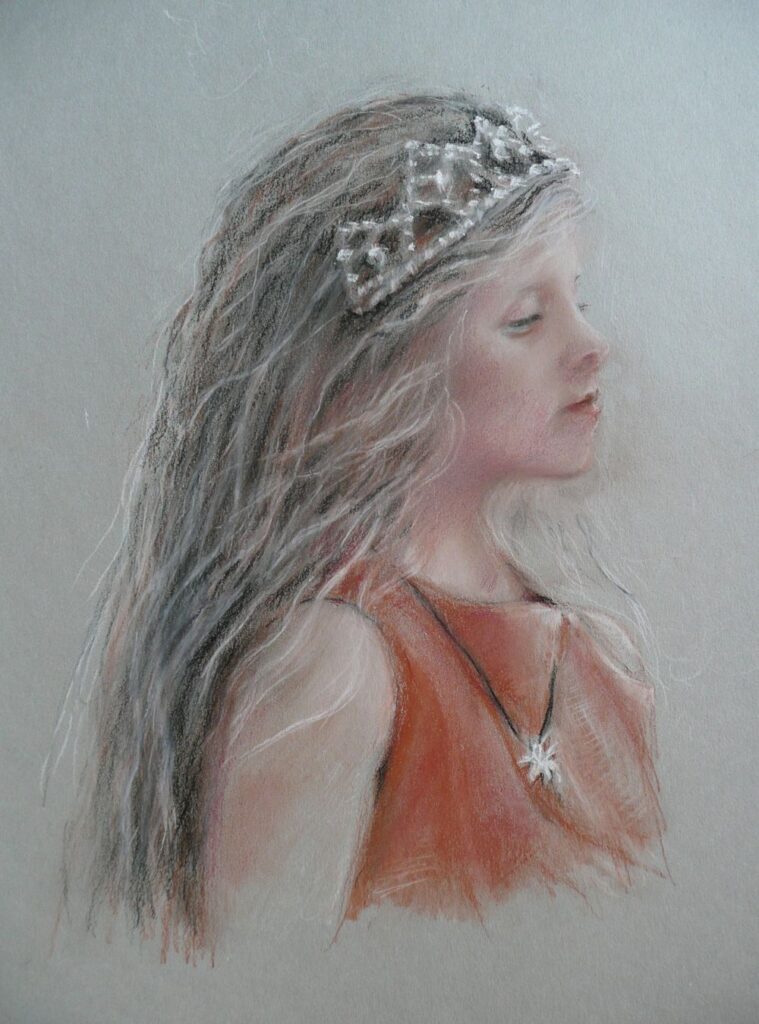
Conte crayon: black, sanguine, white
Plus small additions of blue and crimson pastel pencil
on Rembrandt toned paper; Industrial grey
This week is another drawing session.
To start with this week I’ll screen share some references and we’ll do a few warm up sketches before launching into a more considered drawing for the rest of the morning.Maximum time 5 minutes for each. I will share my screen with you so we can work from the same image.
Probably best to work in soft pencil or charcoal for this and do all four studies on the same sheet (A3 cartridge would be ideal).
For the more considered drawing perhaps try drawing a boy if you chose a girl last week and vice versa. Girls may seem easier because the ear is often hidden by hair. If drawing a profile take time to look at the position of the ear in your reference; it may appear further back than you think.
I mentioned the proportions of the head last week and that in older children these proportions are close to that of an adult. Quite often noses may be slightly shorter and less developed and the only way is to observe the particular reference photo or the sitter closely. Also even in adults these measurements vary a lot between individuals.
Just to recap;
When looking at the full face;
1. look at the over all proportion of the head; i.e. how wide is it compared to its height then draw the head shape, tilted if the head is tilted.
2. draw in the vertical axis of the head and note how this axis changes direction for the neck if the head is on the tilt.
3. Show how the head connects to the body looking carefully at the width of the neck
4. Draw a line through the eyes; this will help with proportions as about half the head will be above and half below when the sitter is looking straight at you and you are at the same height.
5. For the fast sketches place the features roughly then use tone to reveal the form of the head and features. This will be greatly influenced by the lighting.
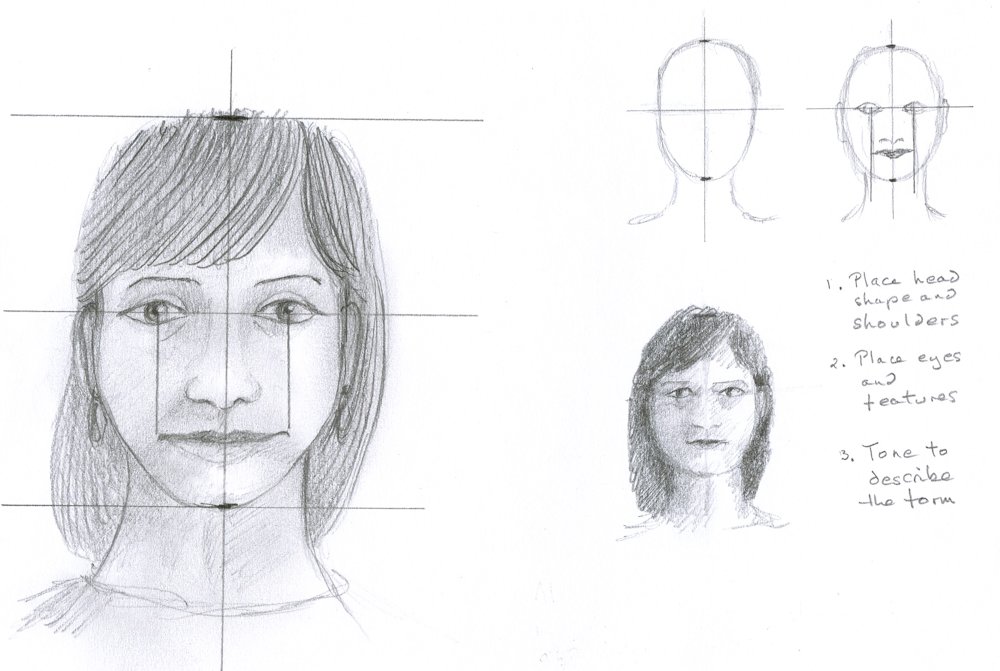
With the profile face the vertical proportions will be the same but do look at the overall shapes you are presented with first, and then place the ear correctly with noting far back it appears and its relation to the hinge point of the jaw which is just below the lower point of the attachment of the ear.
The three quarter view is beloved by portrait artists as it gives some idea of both profile and full face views. The amount of information on the full face is miniscule if the view is almost profile and likewise information on the profile is short if the face is viewed almost from the front. the axis for three quarter views is best drawn as a curve which we will discuss. If you think of portraiture as another kind of still life you will understand that perspective is every bit as important in portraiture, unless you are going for a cubist style but that is a different course!
For the more considered drawing you may continue with pencil, three crayons on a toned paper or work in colour. Working in monochrome or a with very limited range of colour will help you depict the structures of the head and tonal studies will form the basis for colour work in the following weeks.
Your Drawings;

by Norma

Black conte crayon on pale grey paper by Vivienne

Conte crayon and pastel by Vivienne

Tonal study by Liz

Pastel by Liz

by Virginia

by Virginia
Portraits of Older Children: Week 1
June 13, 2022
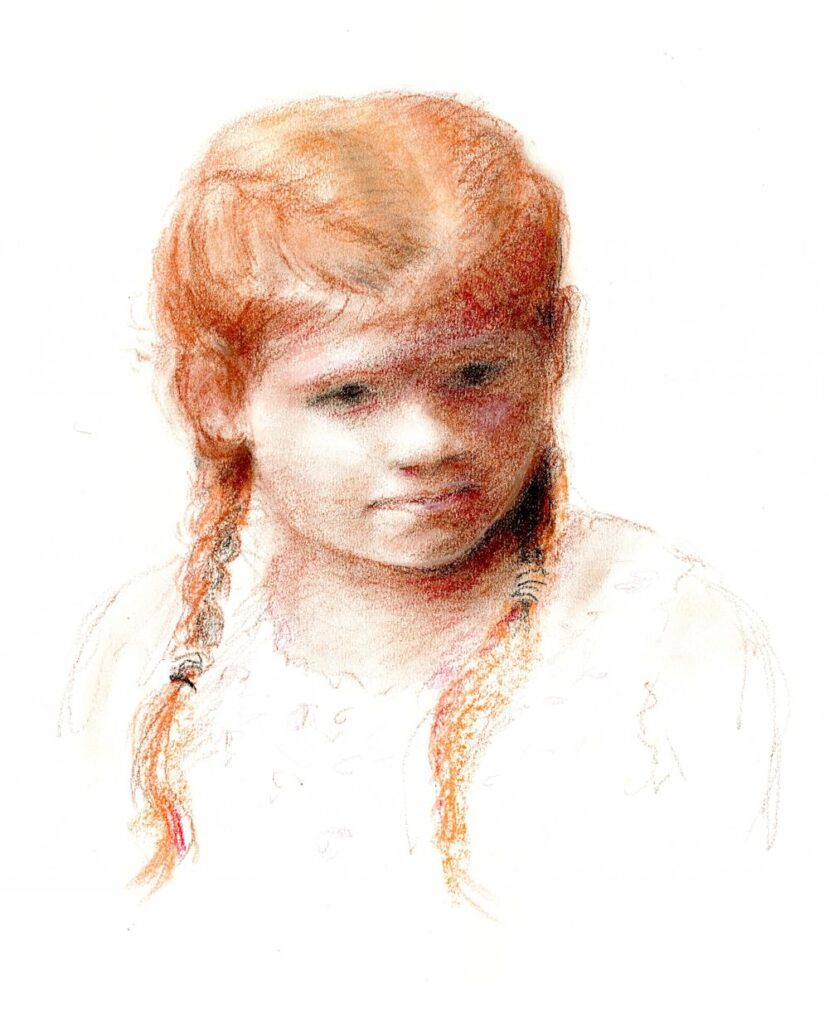
Sanguine and Sepia Conte Crayon
by Jo
I find the age group between about eight and thirteen or fourteen is incredibly interesting. Facial features develop so that the adult in waiting can be glimpsed. All the facial features become larger and take up a greater proportion of the head. Baby noses begin to take on their adult form and facial expressions become more subtle, whether of wonder and delight or perhaps moody, dreamy or slightly rebellious!
In this first session we’ll remind ourselves of the proportions of the head, using conte crayon, pastel pencil or charcoal for some initial sketches before moving on to a more considered drawing. I would strongly advise drawing from a reference of someone you know and meet often. Even when working from a photograph your mind will fill in remembering the forms you have observed in real life that the photographic image may flatten. Try to work as if the subject is really with you as you draw.
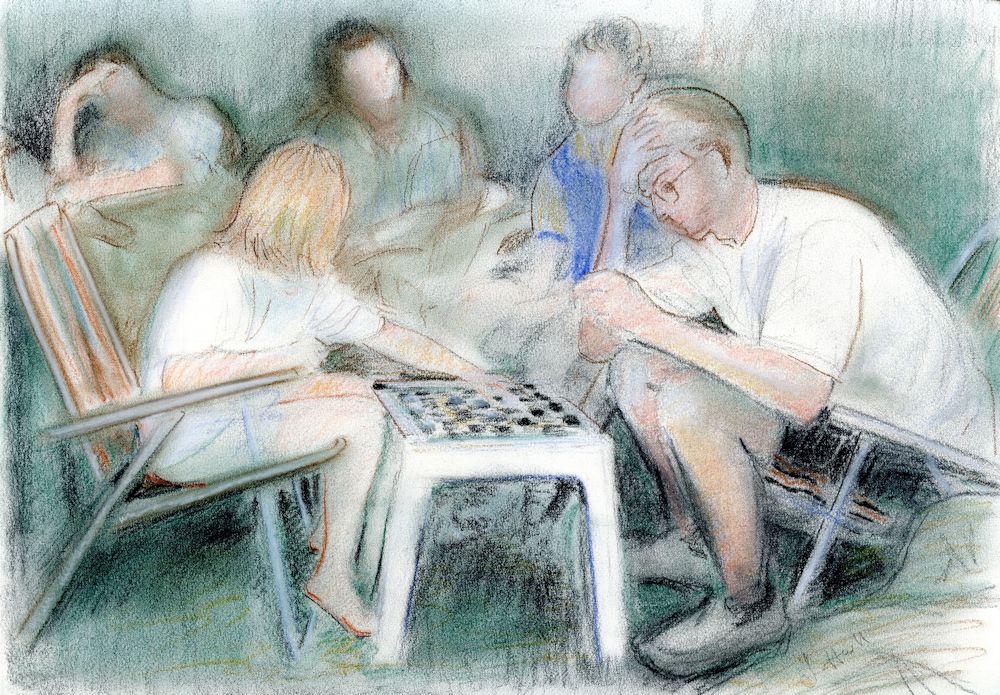
in my Mother’s Garden
(and nine is winning!)
Conte crayon and pastel
by Jo
I give the same advice to anyone working on a landscape from photographic reference; try to draw as if you are immersed in the landscape again!
For this first week we’ll draw a head and shoulders portrait that is three quarter view or almost full face as in the drawing heading this post. It will also be useful to have a reference that is strongly lit from one side revealing the forms of the head and facial features.
If you would also like to make a profile view drawing of the same young person, that will really help you understand the form of the head. And what about the view of the back of the head? In a live portrait session I would encourage you to make several warm up drawings looking at the sitter from different viewpoints, so that literally all round knowledge of the head is gained.
I have prepared a Pinterest board of portraits of older children. The link is
https://www.pinterest.co.uk/jhall1282/portraits/older-children/
Look at some of these examples in detail and imagine an axis running through the centre of the head and whether this is tilted. Note the position of the eyes relative to the top of the head and the chin. Also look at how the artist has shown how the light falls across the head. There are a couple of photographic works among the paintings and drawings. Observe these in the same way. In addition a few profile views are included. Again observe the lighting and the tonal values as well as the proportions and placement of the features. Measure the width of the head in front and behind the ear. This will vary significantly with even a slight turn of the head. Getting the ear placement right will help you make a convincing drawing.
As the first session will be drawing, observing the major areas of tone in your reference will be essential and should be roughly indicated at the earliest opportunity working from the large shapes before homing in on the detail. Indicate the masses of hair in a similar way before indicating a few strands of hair.
Learn to enjoy looking and assessing as much as drawing!
Make sure you have; cartridge paper, some toned paper like a warm fairly pale grey, some conte crayon, pastel pencils or pastel in white, black and sanguine, table easel and drawing board and lastly a good photo reference of your subject.
Your Drawings:
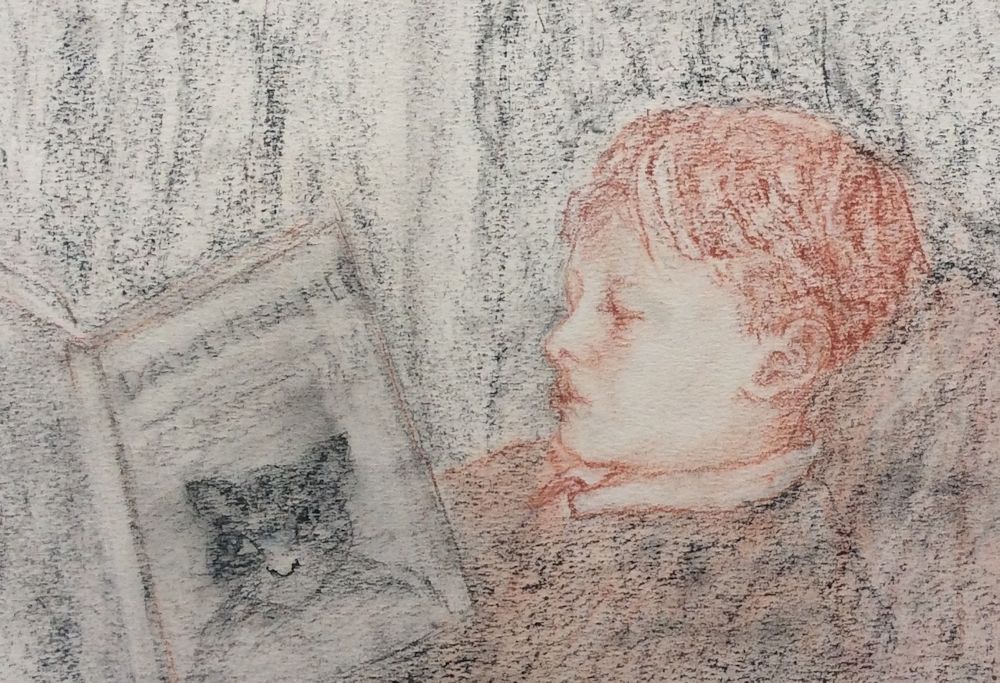
Pastel drawing by Virginia
This is a sensitive portrait showing us Tom’s complete involvement with the book he is reading. Virginia made two subsequent studies one of which was a better likeness, but I didn’t feel the connection between the boy and the book in the same way. A very hard choice to decide which of the two good drawings to include!
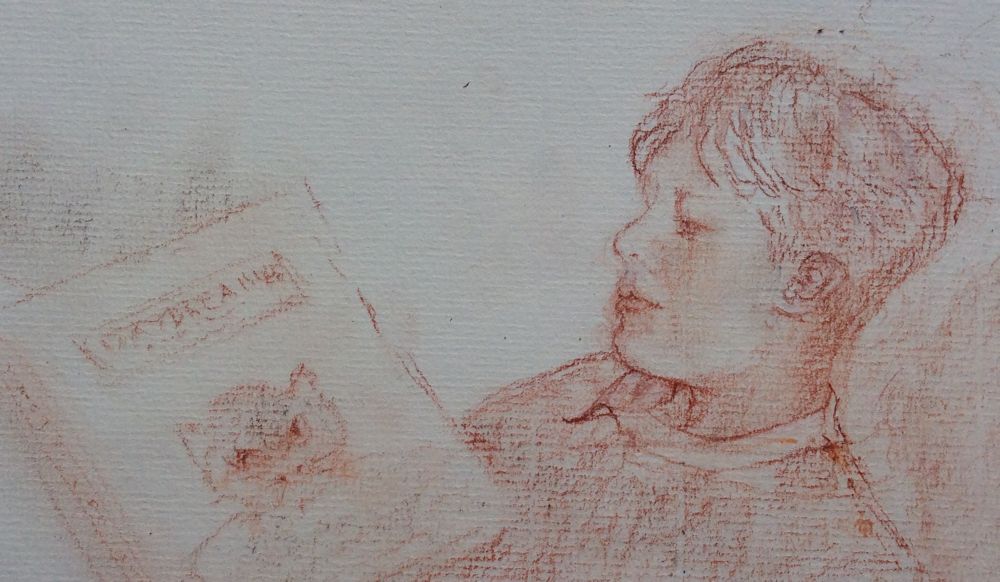
Conte crayon drawing by Virginia
So I decided to include both!
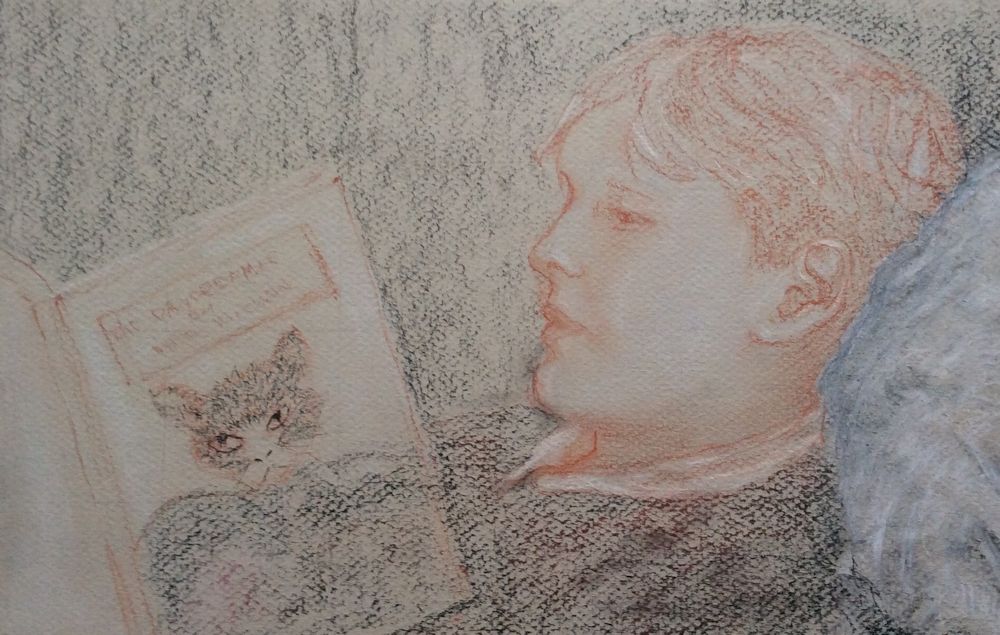
Pastel drawing by Virginia
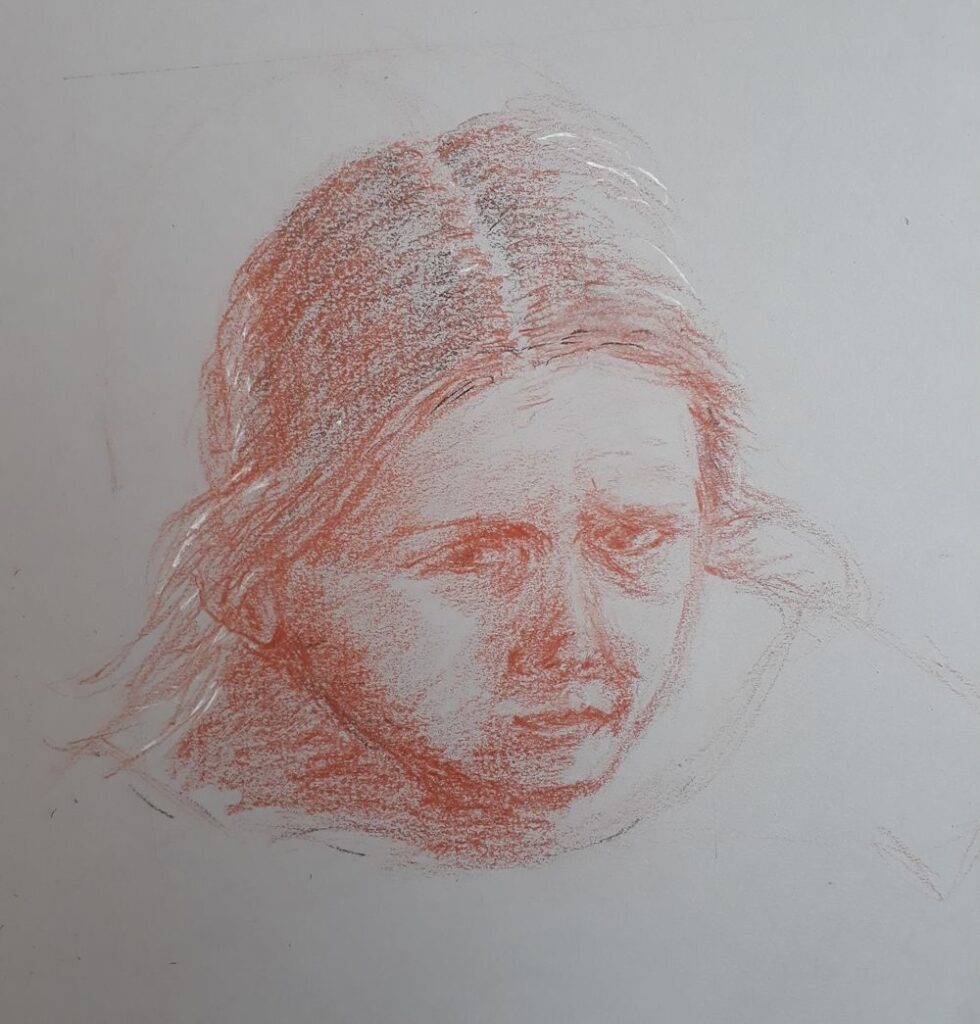
Conte crayon on grey paper by Vivienne
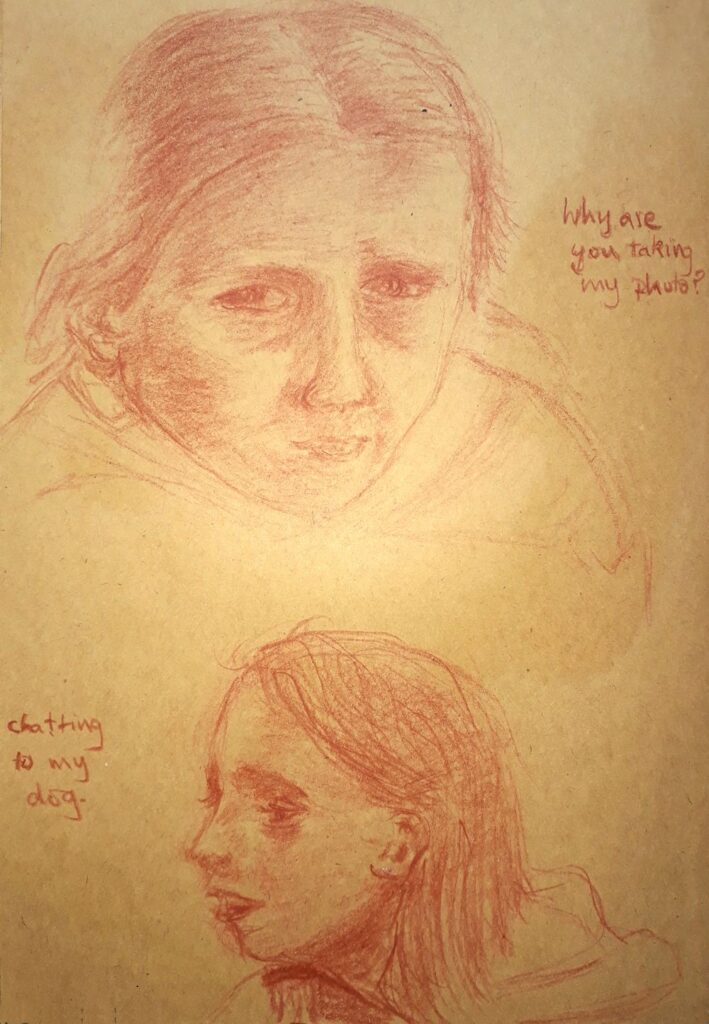
by Vivienne
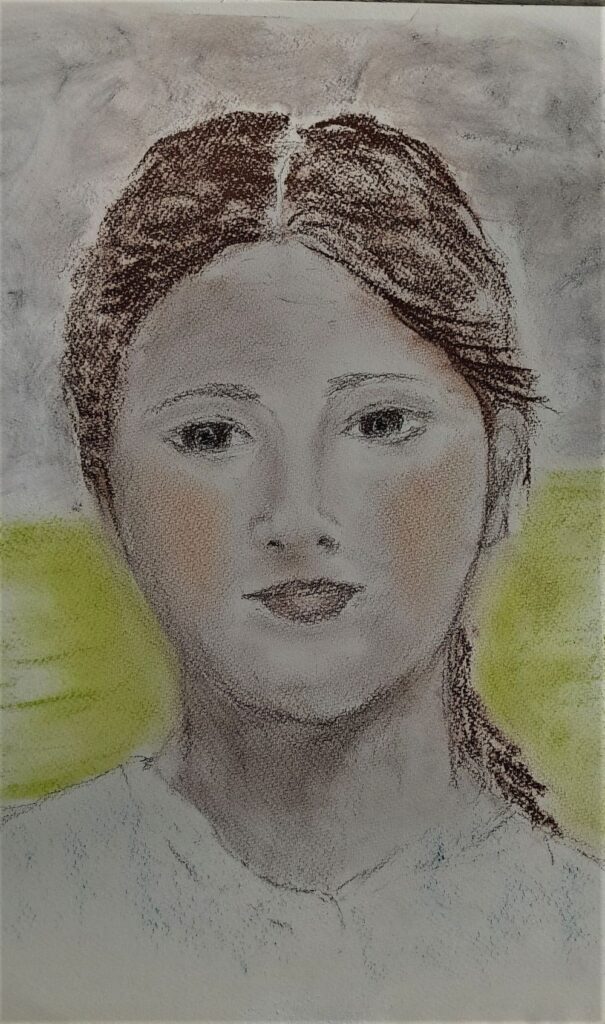
Charcoal and pastel by liz
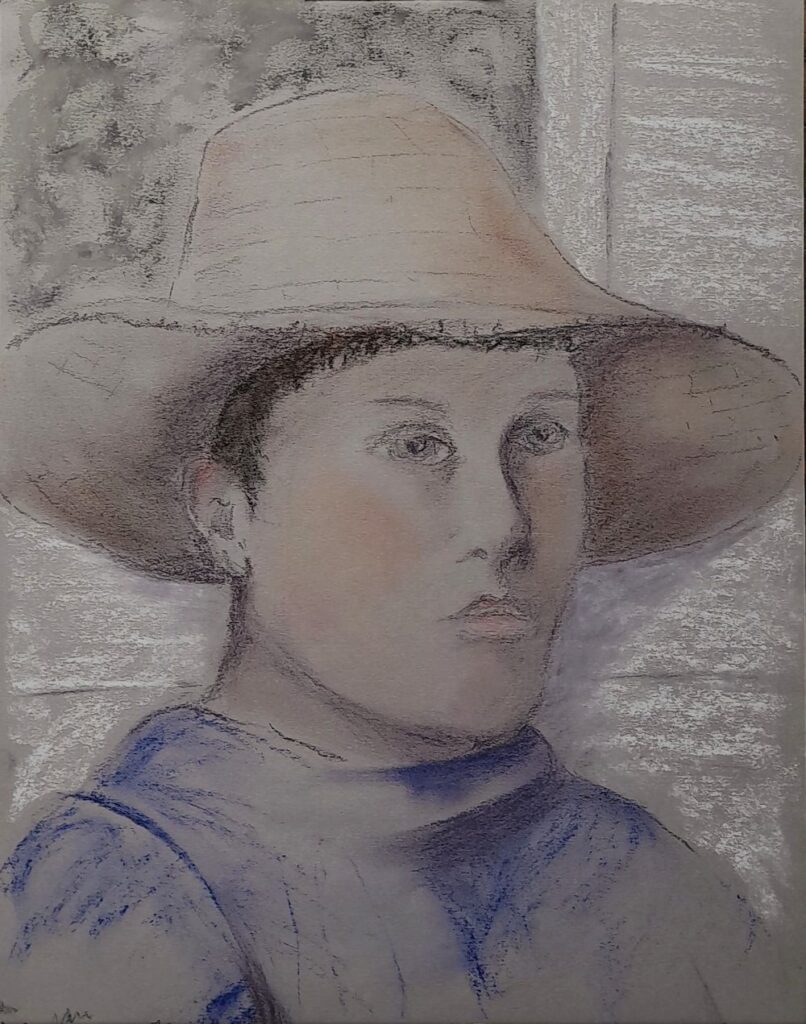
Charcoal and pastel
by Liz
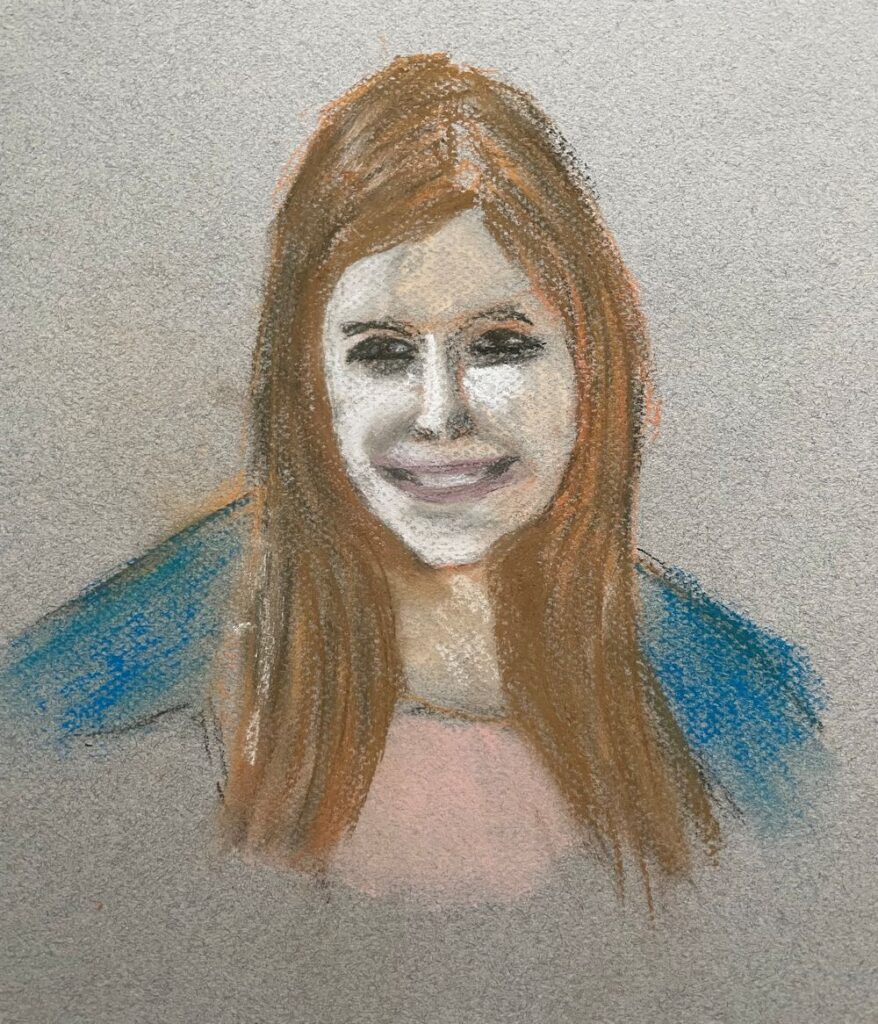
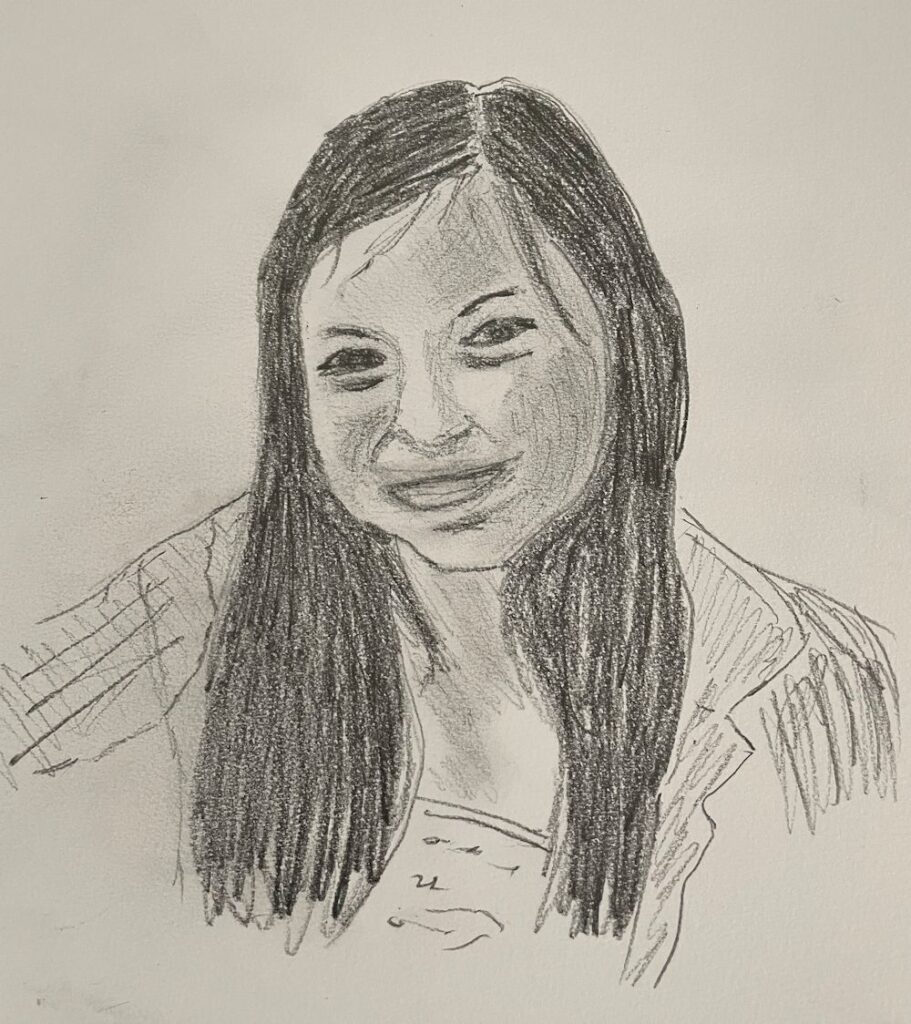
Watercolour Flowers Week 6: Growing like Weeds
June 1, 2022
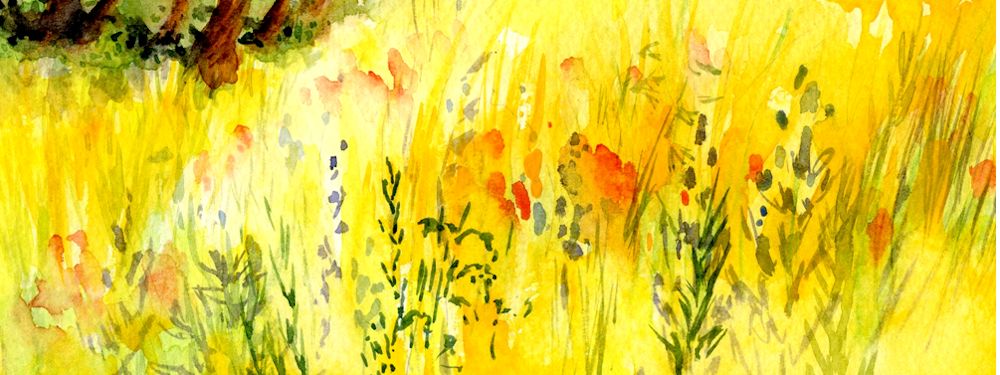
a very free sketch!
This week’s challenge is to paint flowers that either spread like weeds or are arrivals from the wild, generally known as weeds! It’s very much your choice whether you paint them in situ; perhaps a sprinkling of buttercups and daisies in a patch of grass, rather like the poppies spangling the cornfield above, or at the other extreme make a delicate arrangement of your favourite visitors or freely spreading plants on one sheet of paper.
Either way, try to keep the colours clear and work some passages by wetting the water first before adding the colour and/or some wet in wet areas.
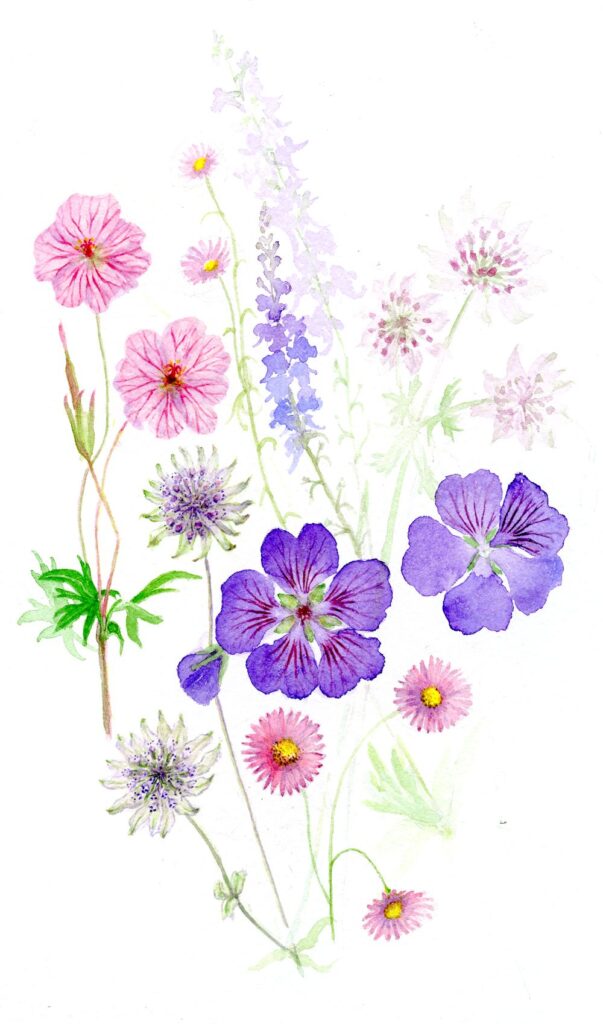
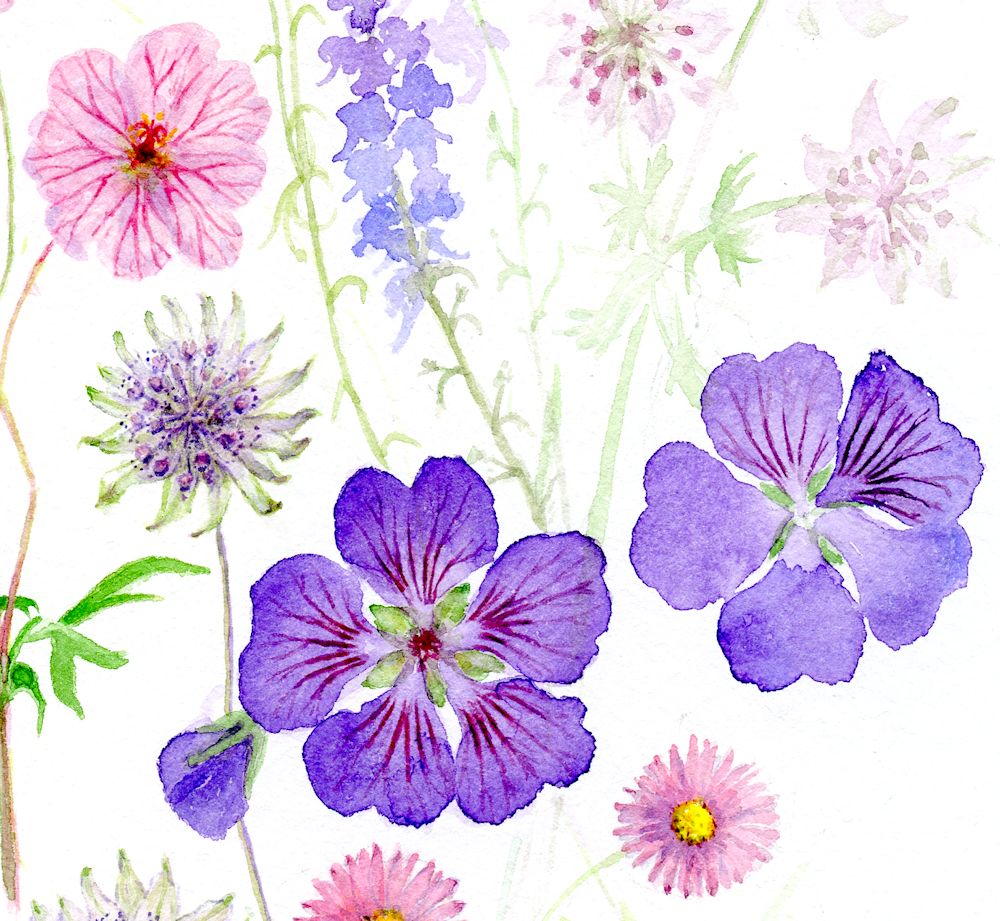
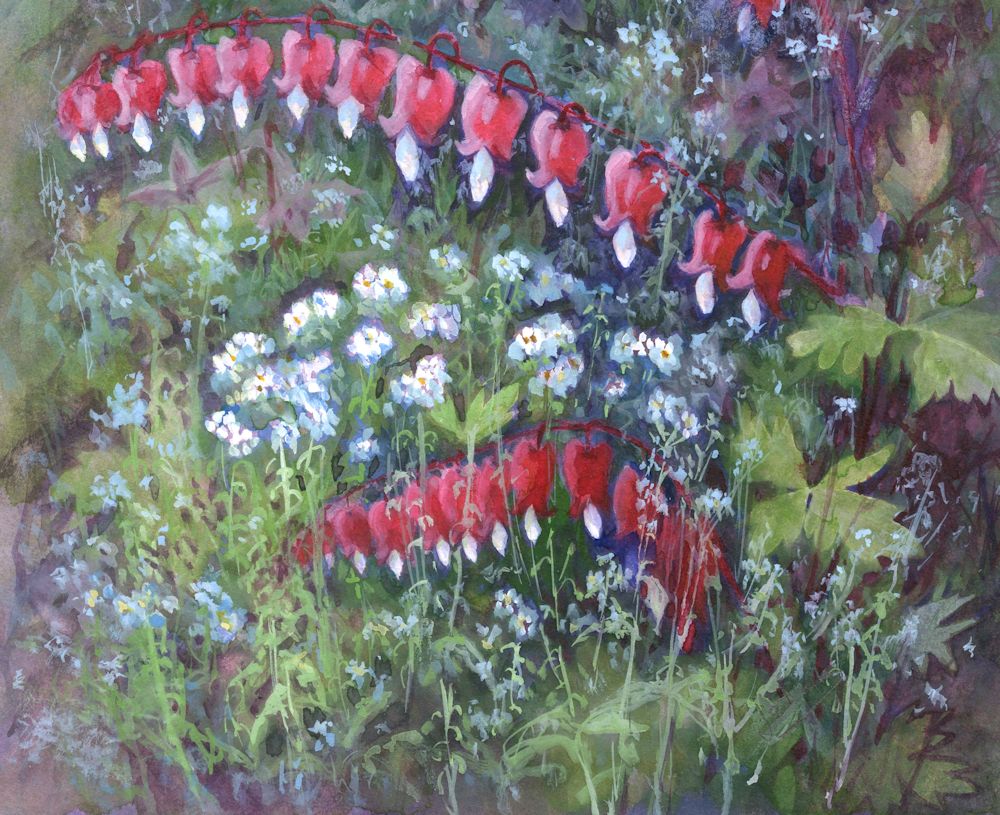
Forget-me-nots grow everywhere and at most times of year in my garden. Here they were against a dark ground so were painted in gouache by adding Permanent white in varying amounts to Cerulean Blue and in some places to Cobalt Blue. The pale stems were painted in a similar way with mixed greens and white.
As ever the first background washes will be important for determining how you proceed. The Forget-me-nots above were painted in gouache over a dark ground. Do experiment with the strength of washes for the situation in your painting. For a lawn, blades of grass with a soft focus can be suggested with darker greens by deft brushstrokes into a wash while it is drying as in the right hand side of the image below. When the wash is dry more definite grasses and stems can be added wet on dry.

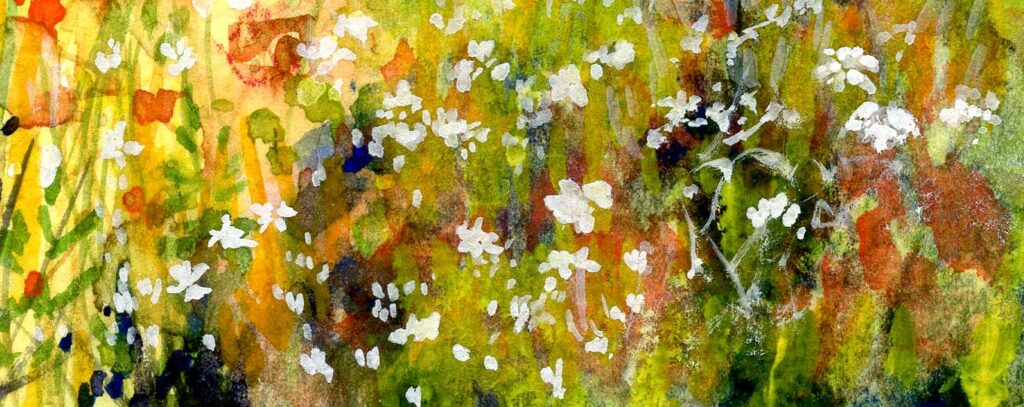
If you have buttercups, daisies, clover and other delights in your lawn you could paint them in a similar way to the meadow flowers above. After choosing your subject think about how you wish to represent any pale flowers against darker tones. If by lifting out, test how well the pigments selected for the painting work when lifting while still damp and also when dry. Staining pigments do not lift well when dry!
Painting around many small flowers often looks very laboured so it may be useful to reserve the white or pale areas with masking fluid.
If painting the white flowers with gouache, this is usually best applied when the paper is absolutely dry if crisp edges are required.
Lastly remember that Permanent White can be mixed with other watercolour paints to make them opaque so can be mixed with yellow for a scattering of buttercups or blues for Forget-me-nots against a dark ground. Again test the strength of the gouache mixes over a swatch of the colours they will be painted over in the final painting.
This should give some ideas for how to set about this week’s challenge. No one recipe will solve all the different challenges met in the freer kind of flower painting. The best way is just to experiment and explore the colours, mixing, layering, brushing and spattering etc. enjoying the journey and deciding on the best place to stop.
Your Paintings:
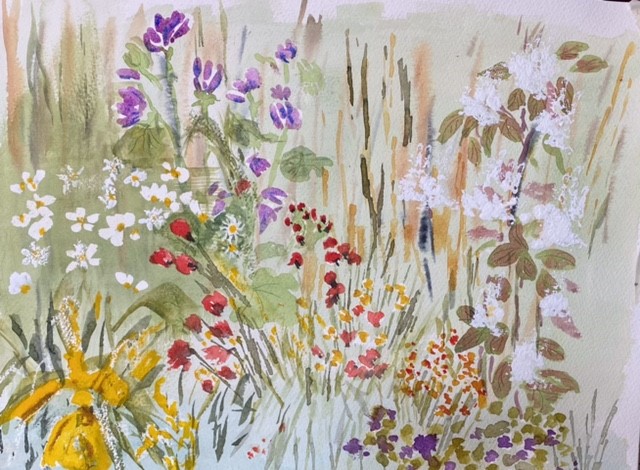
by Sandra
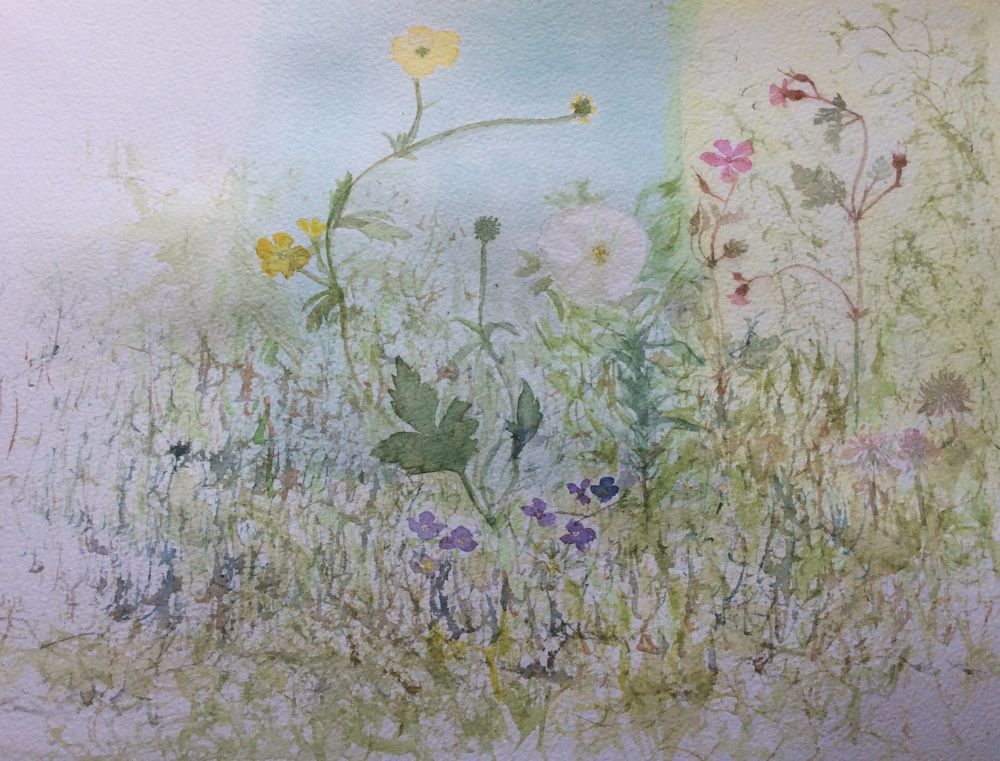
by Virginia
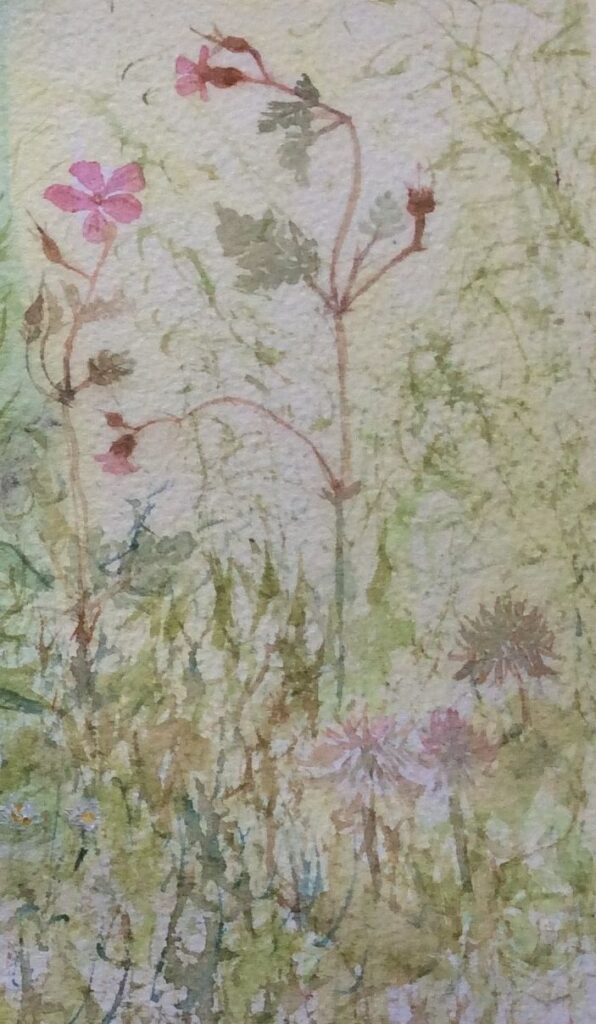
Herb Robert and Pink Clover
Watercolour Flowers Week 5: Rose
May 27, 2022
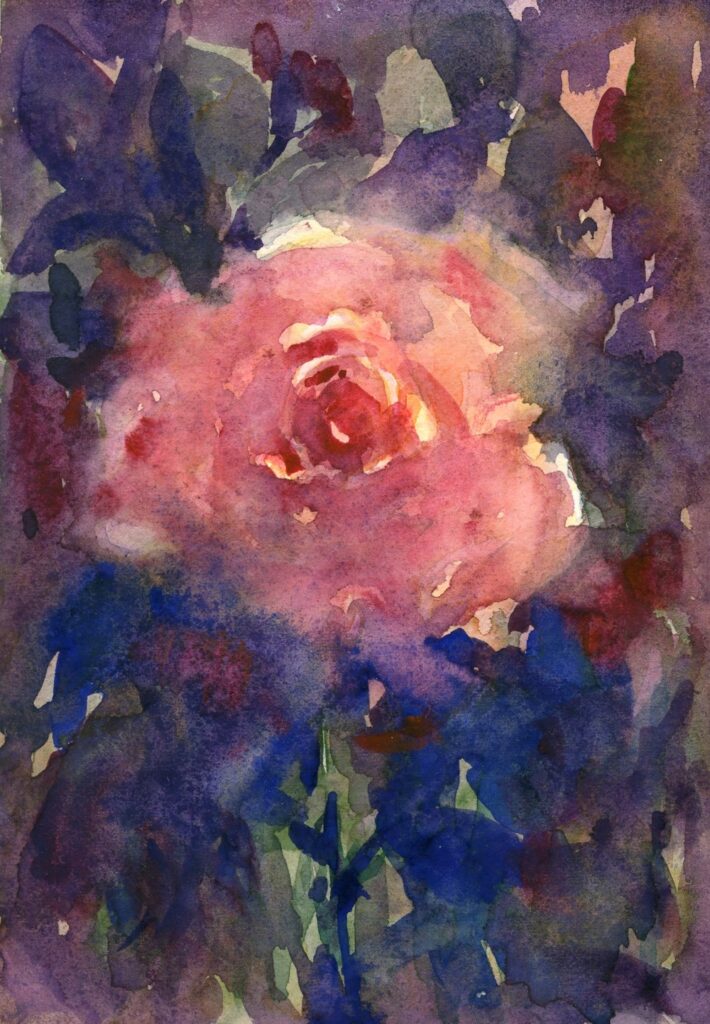
Painted mainly wet in wet
This week’s challenge is to paint a single rose or small group up to two and a bud. We’ll try two ways of working one largely wet in wet and also perhaps look at the use of masking tape in addition to the masking fluid used last week to make some interesting textures and compositions.
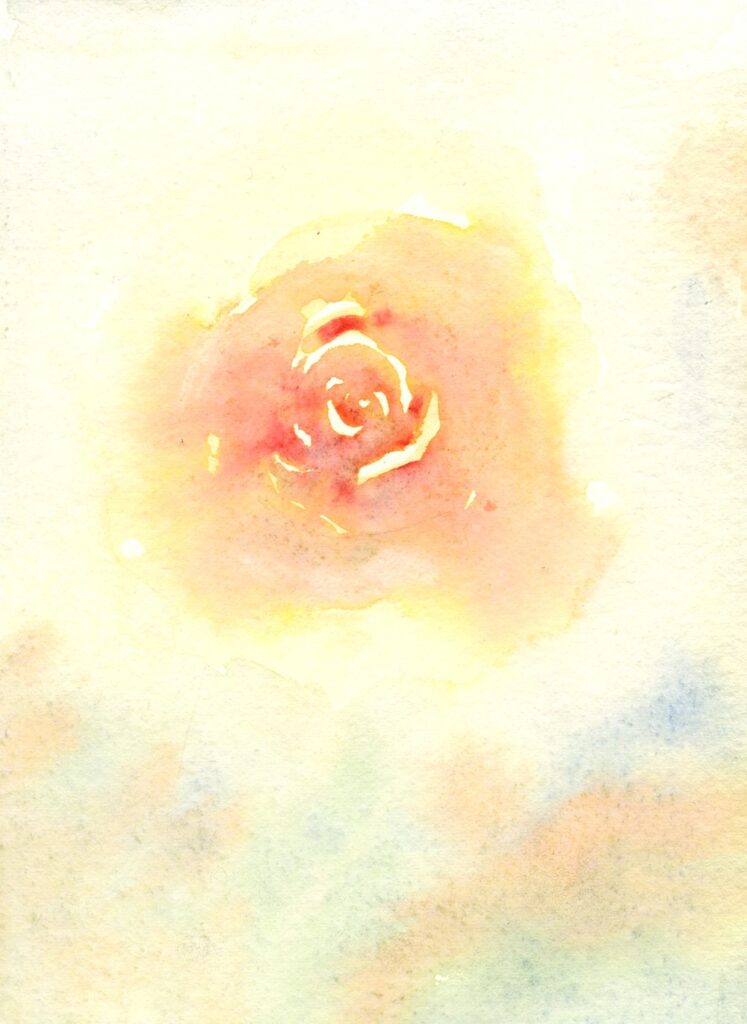
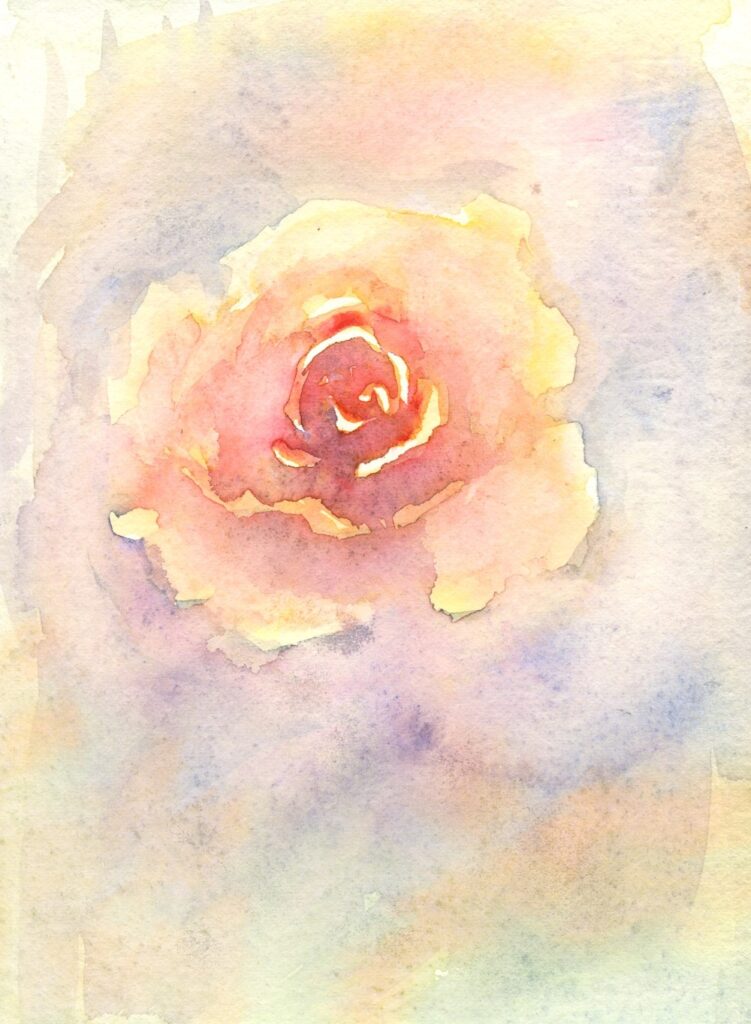
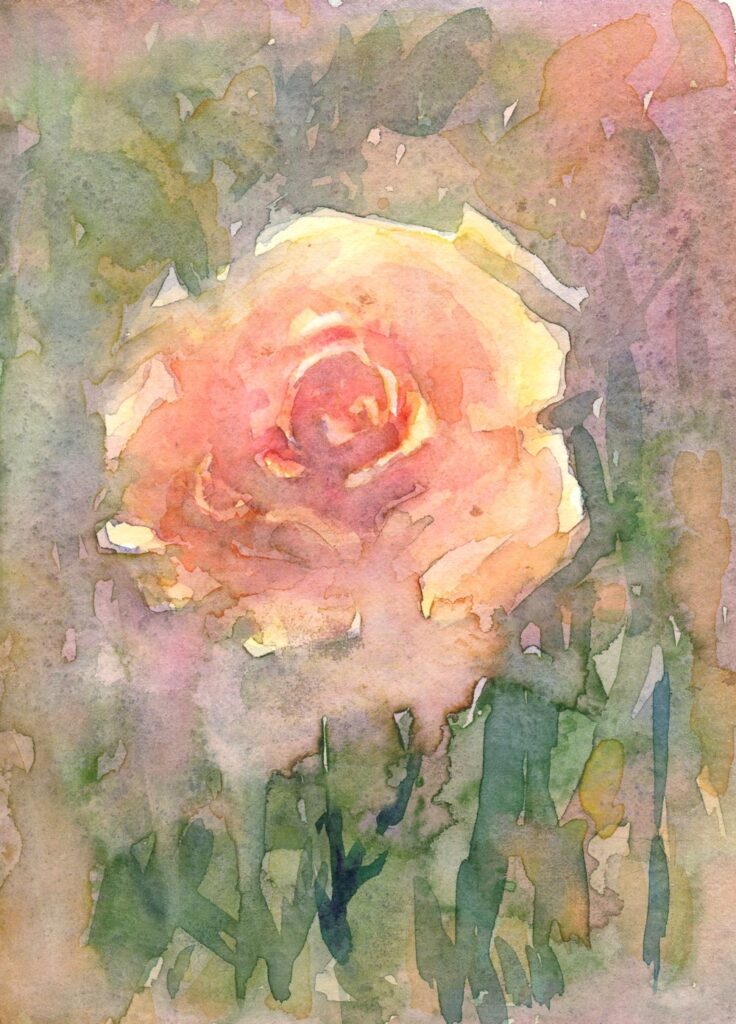
I could have stopped there.

Much of the time will be spent looking and choosing the pigments best suited to your particular rose, thinking in terms of using no more than three pigments.
1. Look at tone;
Thinking tonally becomes even more important when painting single flowers so it is important to take note of how light falls on the bloom. In strongly directional light the darker side of even the palest rose may appear quite dark. Conversely the better lit side of the deepest rose may appear surprisingly light in colour. Observe how the light affects each individual petal revealing their spiral arrangement. If a flower is seen against the light as when placed in a window with the light behind it, the whole form may appear dark and almost silhouetted against the incoming light.
2. Look at the form and shapes;
Try turning your rose so that you are looking straight down at the flower and take note of the spiral arrangement of its petals. Then turn it slightly away from you and notice how different it looks, finally turn the flower so you are looking at it from the side. It may be helpful to make rapid sketches of your rose at these different angles to familiarise yourself with the shapes.
3. Choose pigments
Decide on the pigments best suited to paint your rose. Try to limit this to three. This will help unify the study and help prevent muddy mixes especially if you are able to use transparent colours for most of the painting. Try out mixing colours in the palette as well as seeing what happens when one colour is dropped into another while it is still wet.
4. Background;
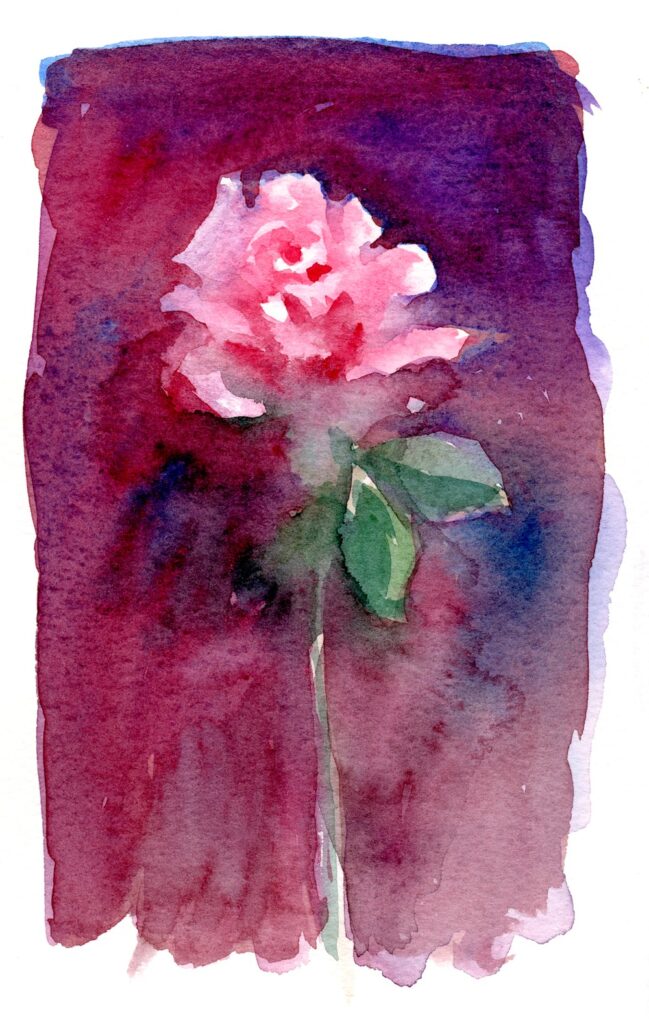
Rich dark background
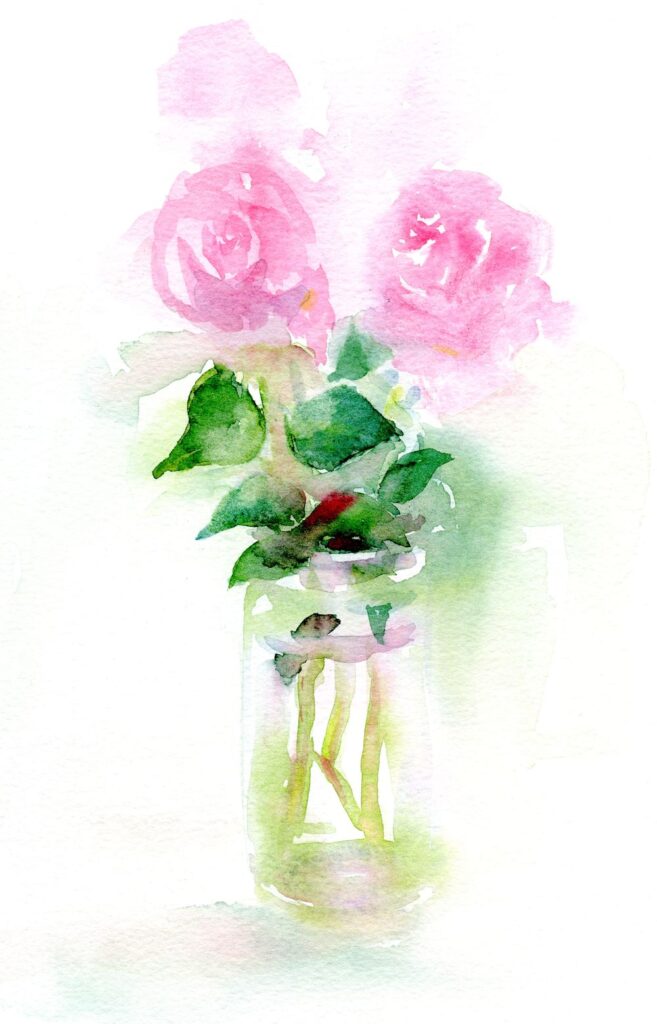
Pale background giving a much cooler look.
The background may be composed of the foliage surrounding the bloom, a colour and tone which is observed or may be your choice. The hue and tone of the background will greatly affect the mood of the study. Another important element will be to decide on the tone and hue of the background which can greatly affect the mood of the painting.
Another interesting approach to have fun with the composition and the background is to apply some initial washes and allow them to dry and then apply low tack masking tape. The demonstration below is how last week’s composition has developed so far. This could easily be done with a much simpler study and can be very useful if your background is a window or edge of a wall.
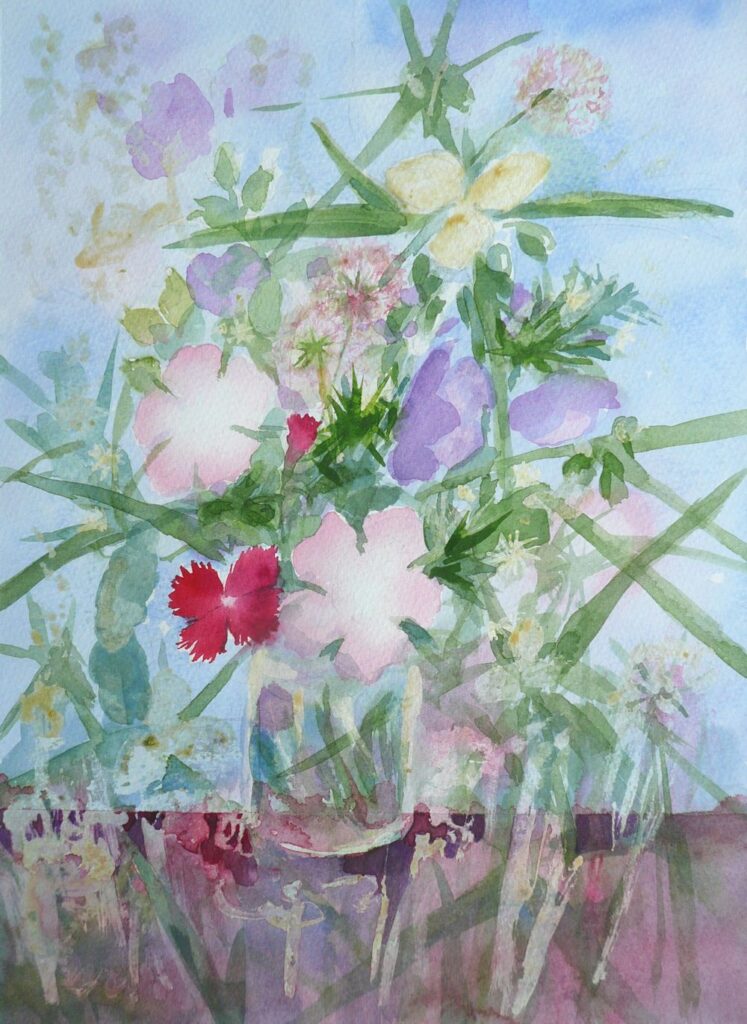
This was painted into in places, allowed to dry thoroughly before carefully removing the tape.
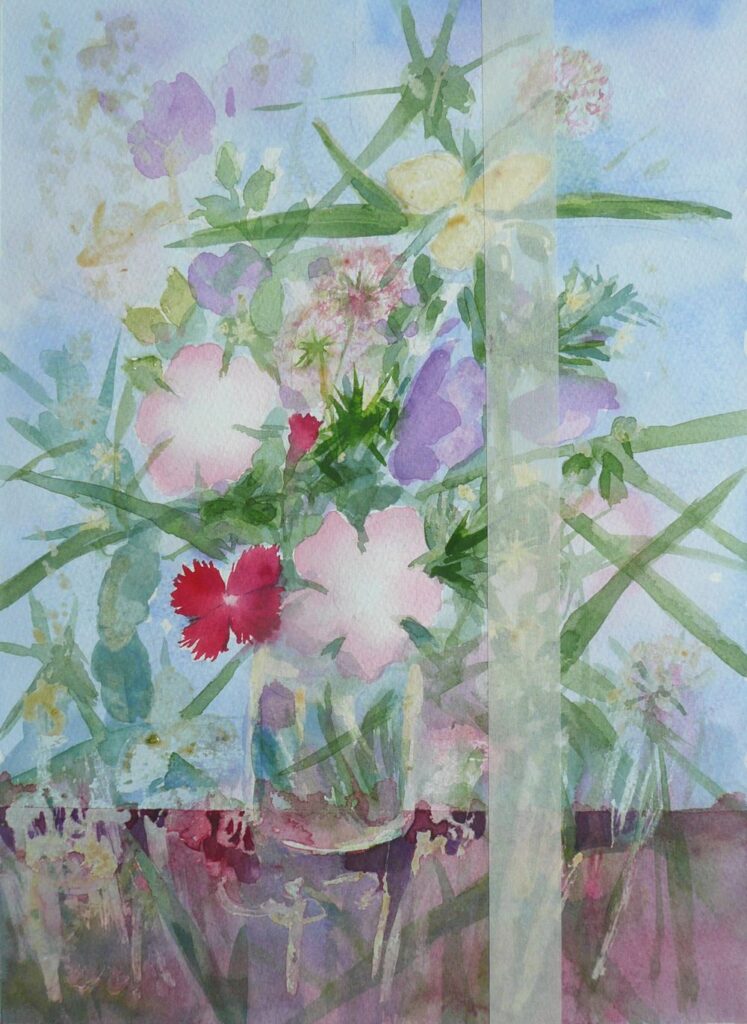
Further washes were then applied.
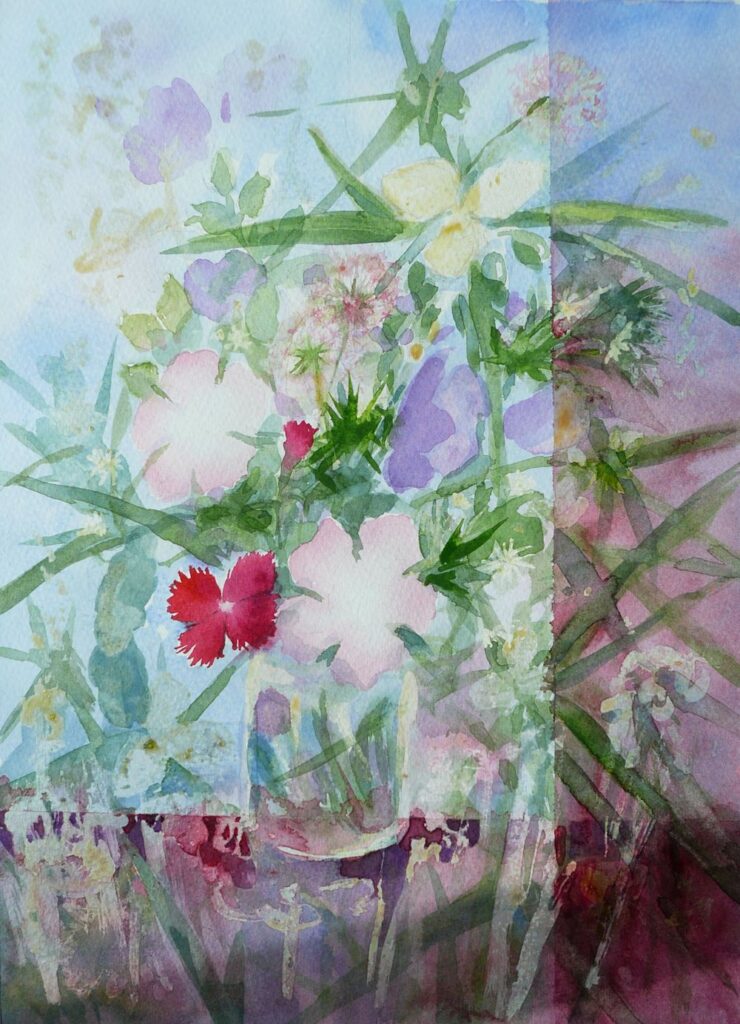
In this week’s session I will start a wet in wet rose and while the first washes dry I’ll progress the posy, adding more washes, a few details and a little gouache. Some of the masking fluid was very free mark making so now it has been removed I have a rather different painting to develop!
Do take a look at Trevor Waugh’s roses, Pinterest link below: https://www.pinterest.co.uk/jhall1282/flower-painting-in-watercolour/trevor-waugh/
and another look at Shirley Trevena’s work at
https://www.pinterest.co.uk/jhall1282/flower-painting-in-watercolour/shirley-trevena/
Have some small pieces of cold pressed watercolour paper at the ready or tape off some areas on a larger sheet for your wet in wet studies of a single rose. There is then scope for allowing washes to dry while another study is started.
A hair dryer greatly speeds the process!
Your Paintings;
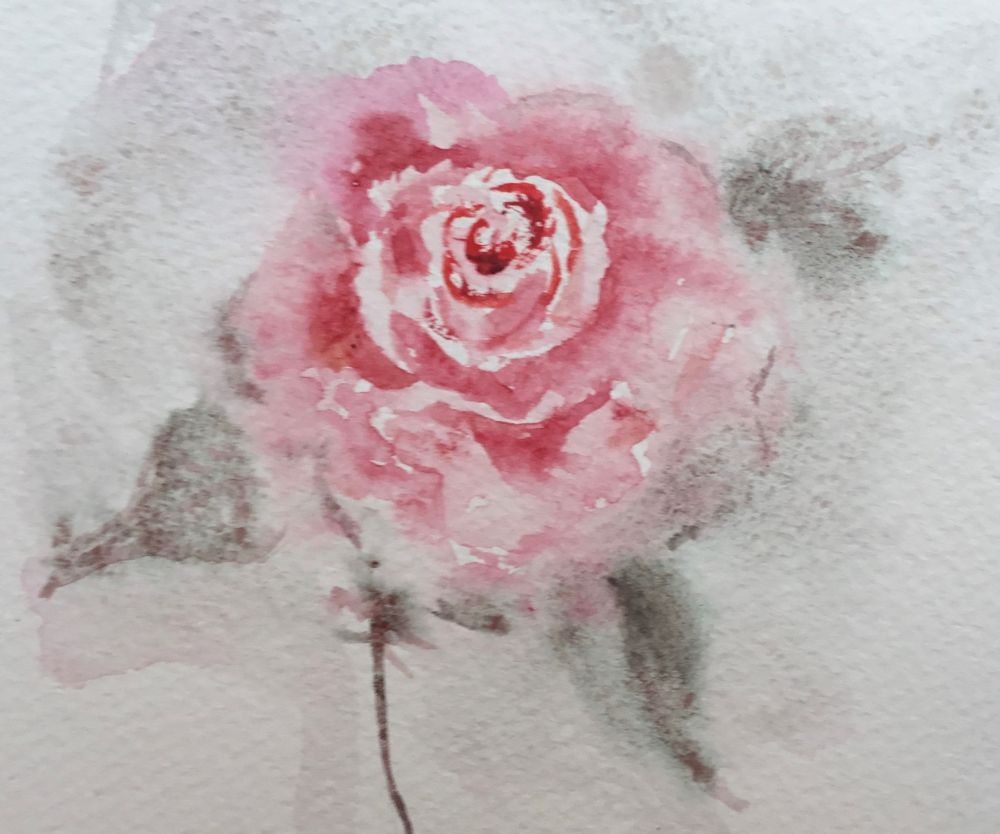
Painted wet in wet by Ann
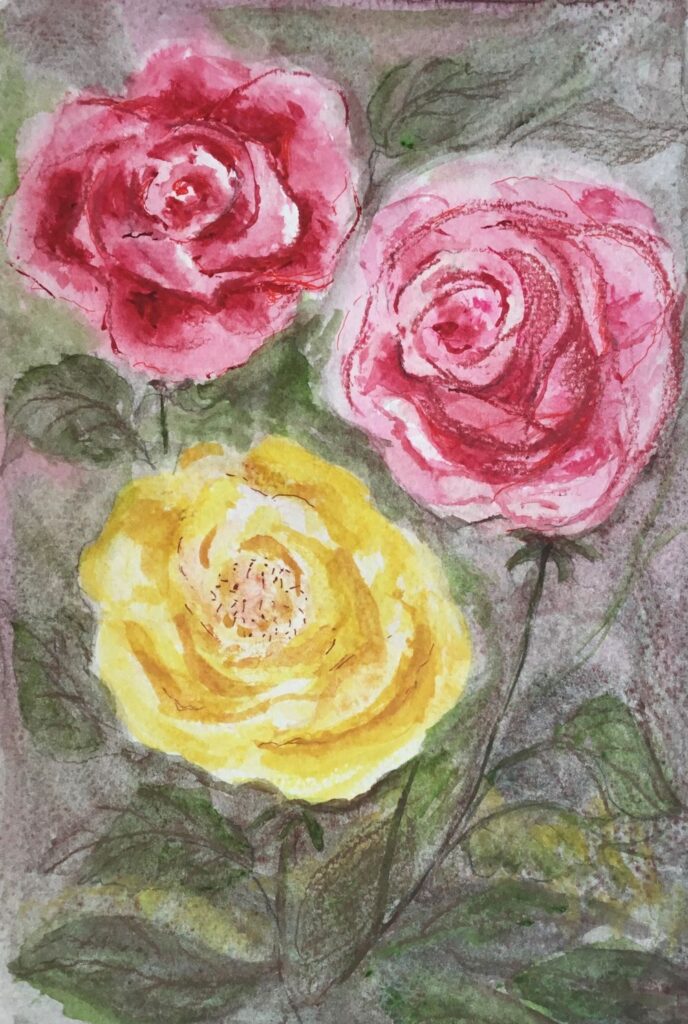
by Ann
Started with wet in wet washes and then developed with drawing media
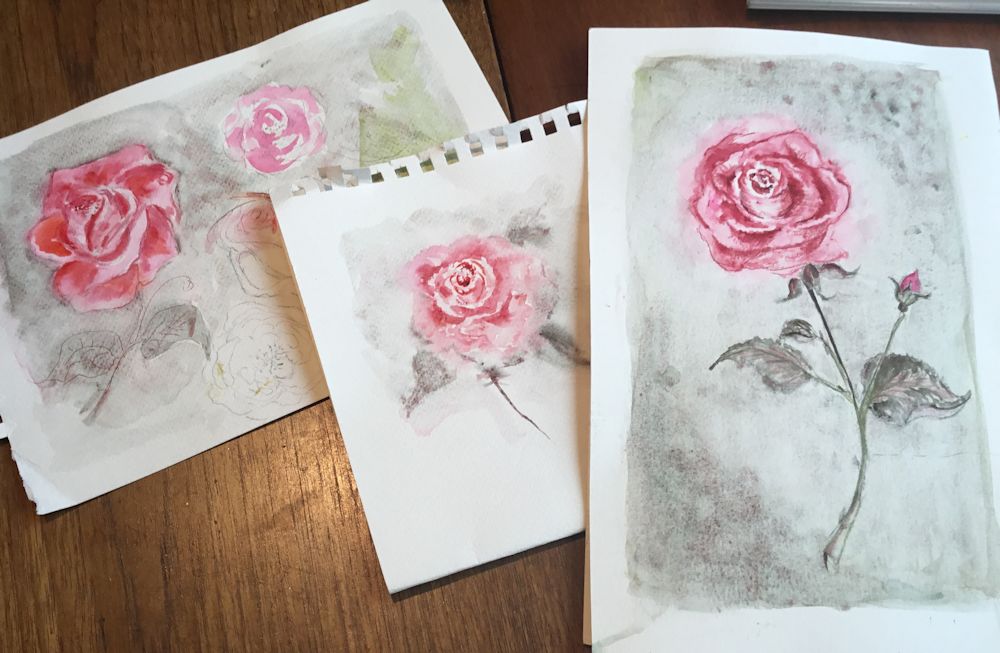
by Ann
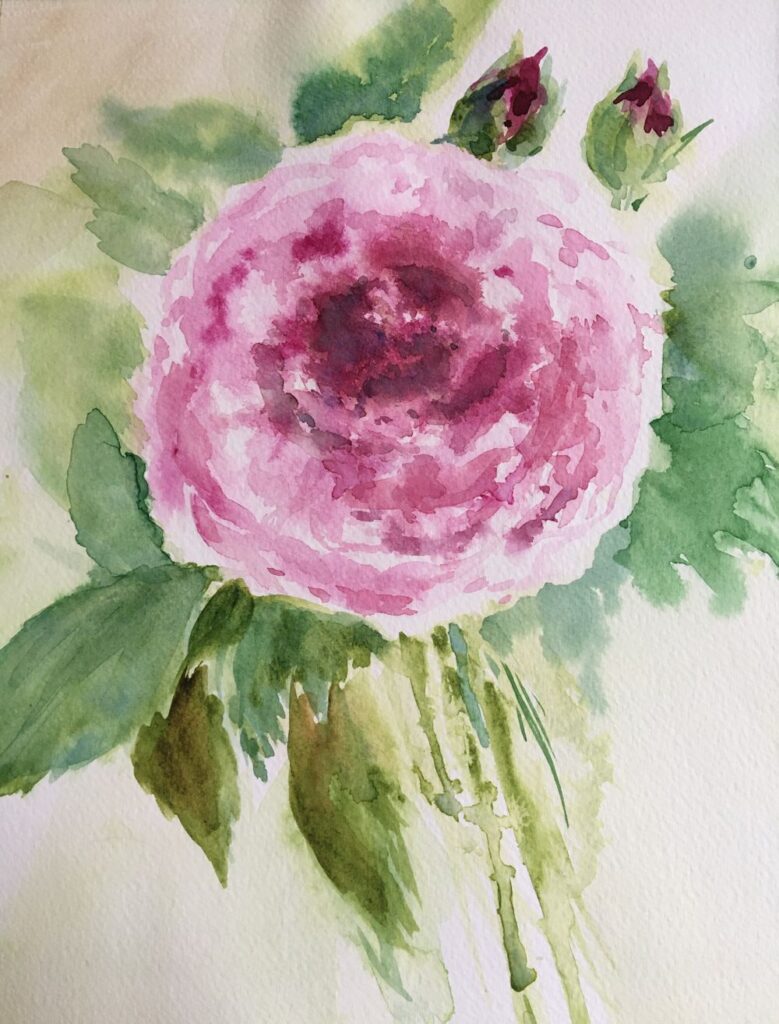
by Maryon
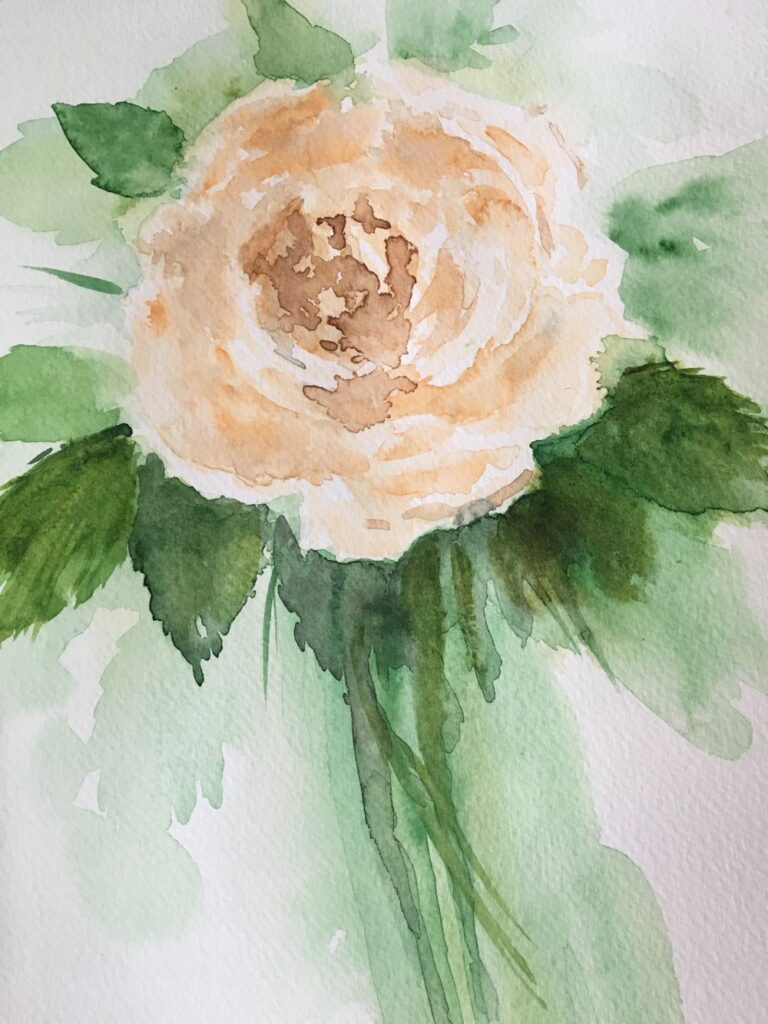
by Maryon
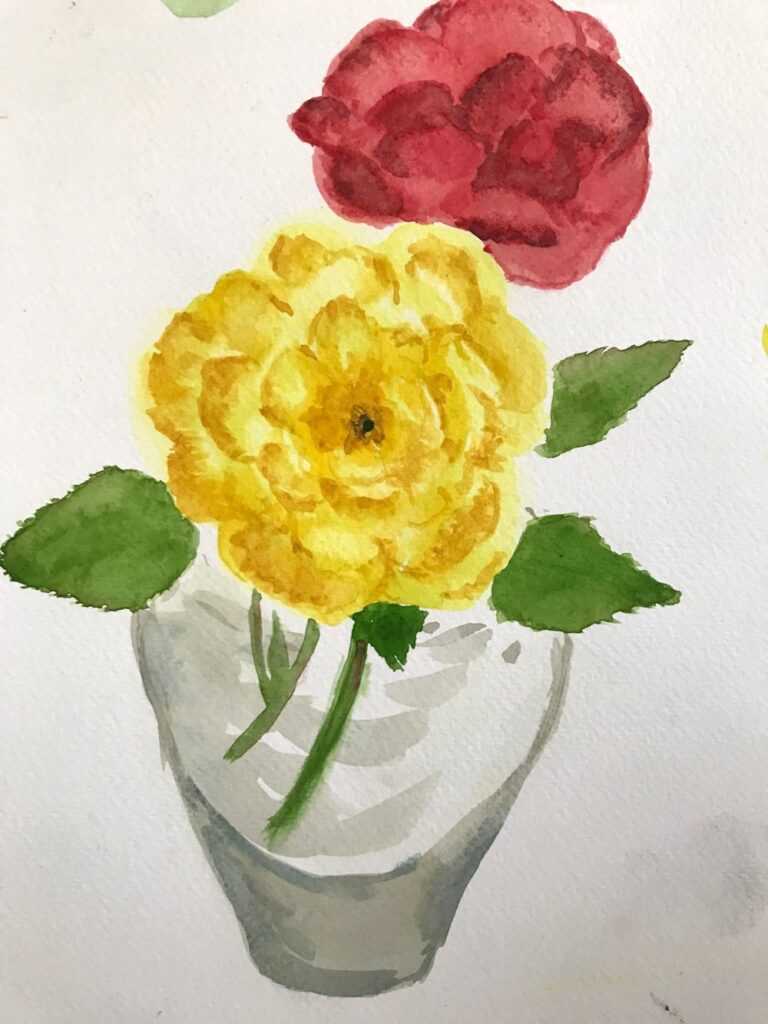
by Mali
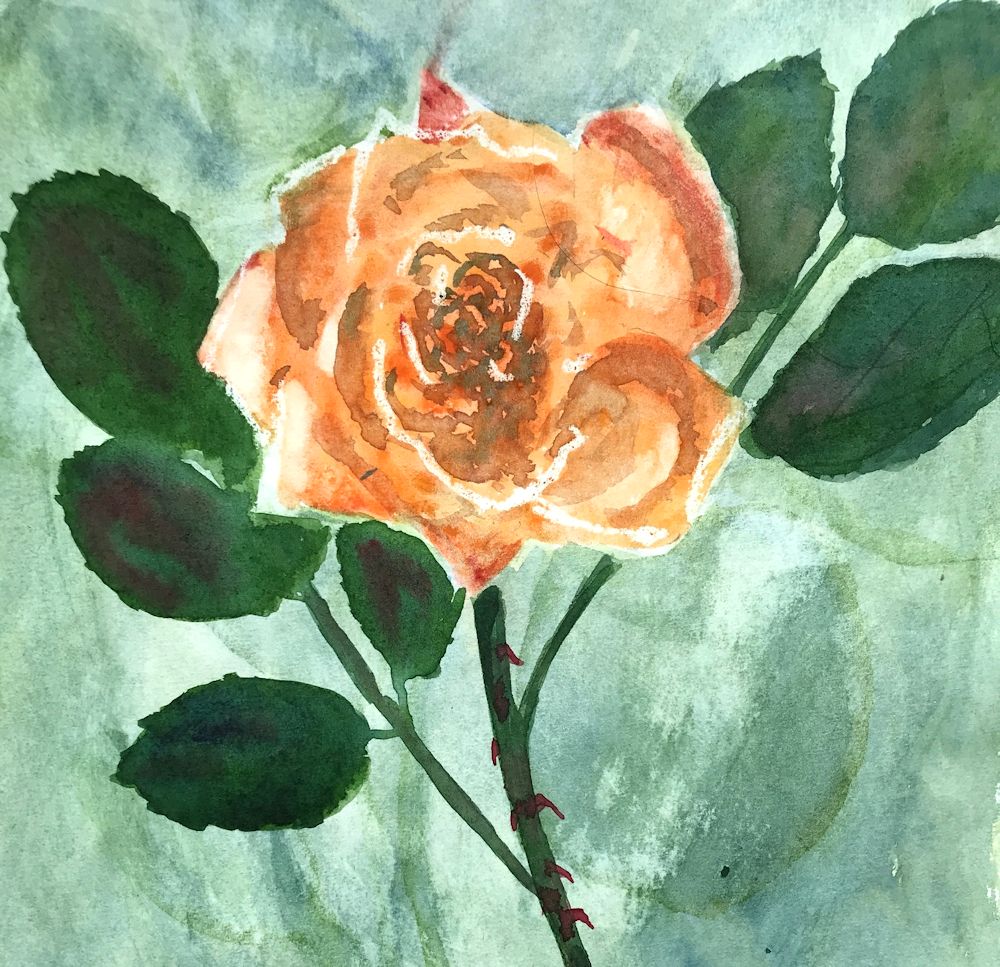
by Mali
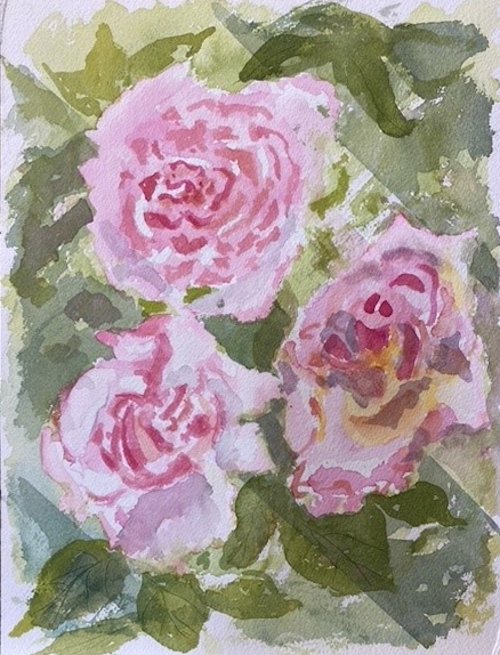
by Sandra
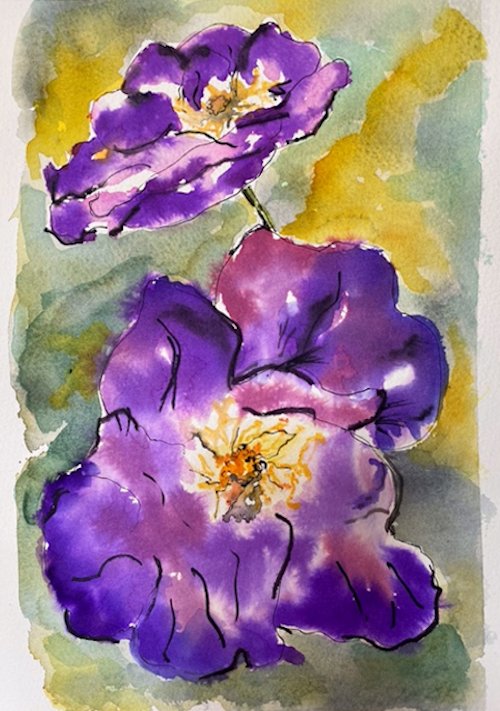
by Sandra
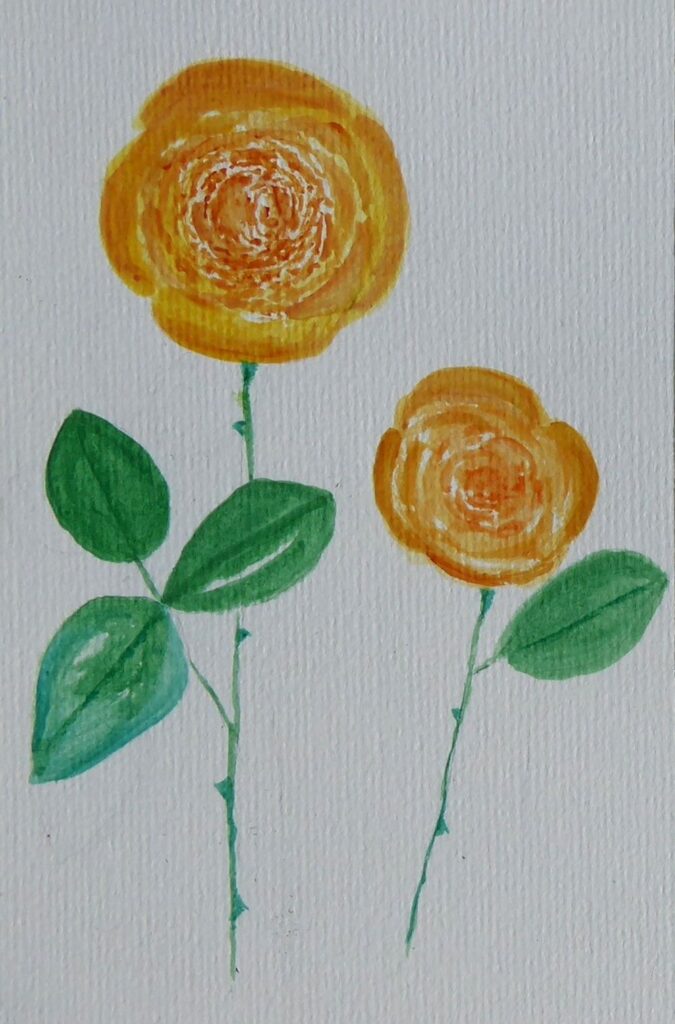
by Anne
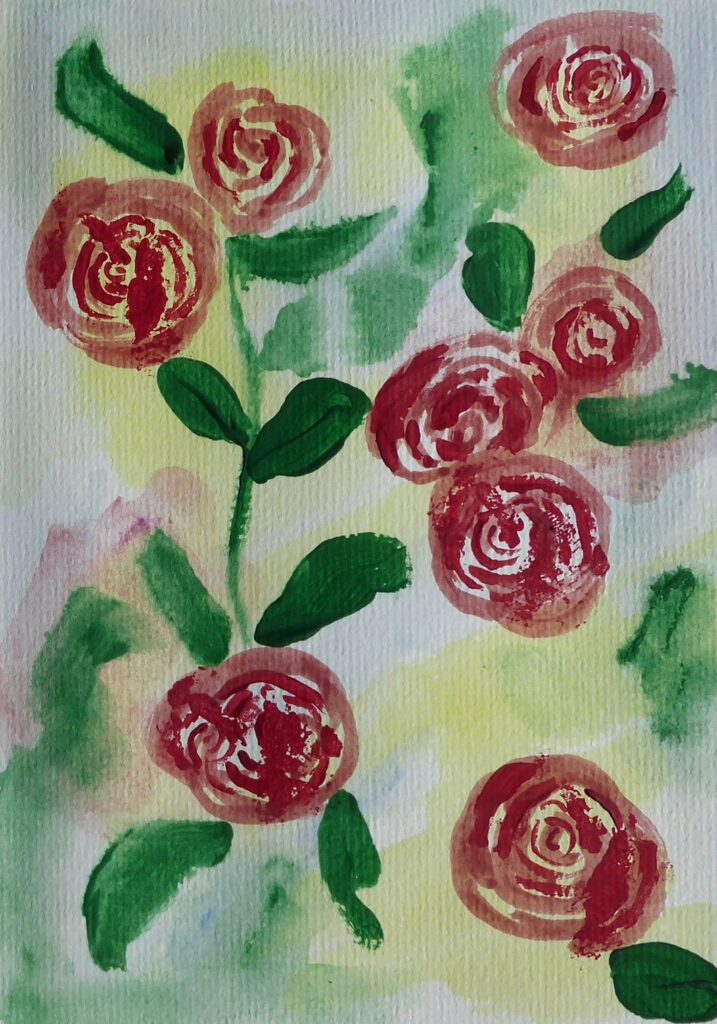
by Anne
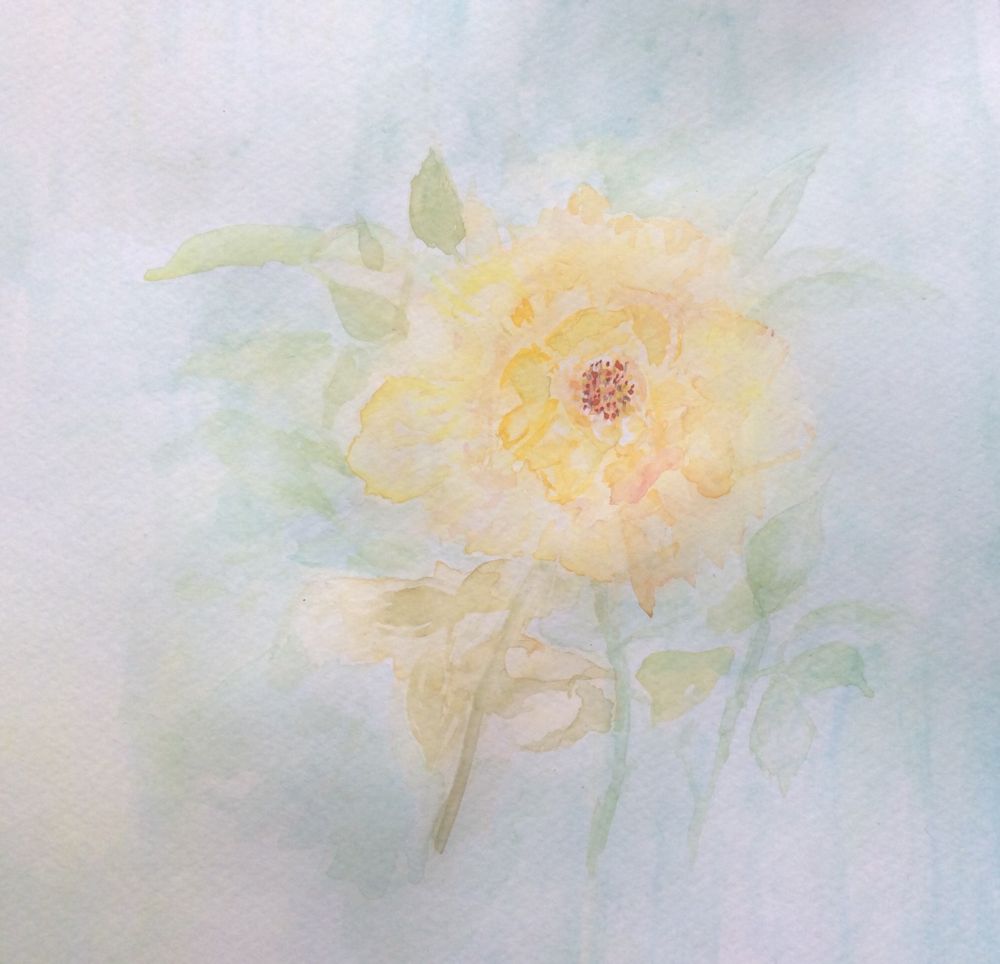
by Virginia
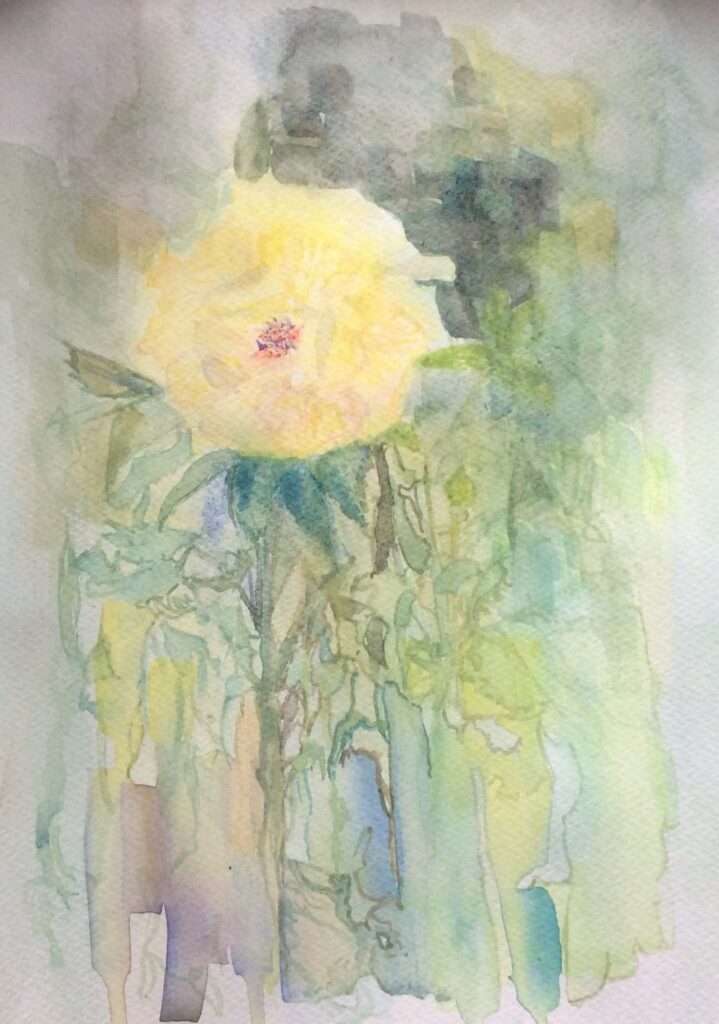
by Virginia
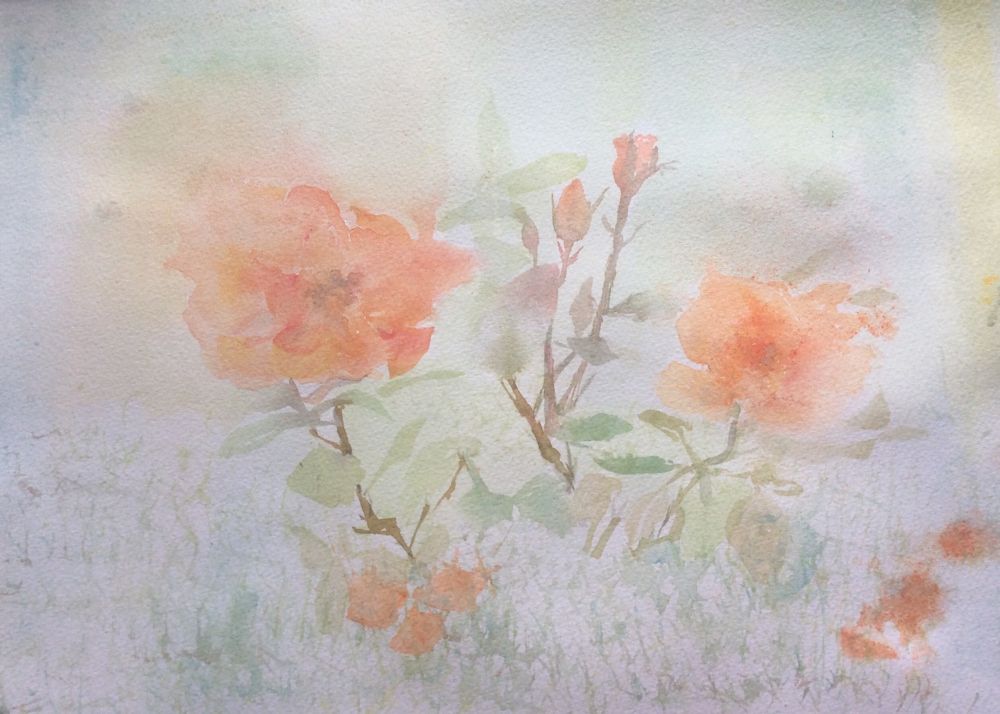
by Virginia
Watercolour Flowers Week 4: Composing with Flowers
May 18, 2022
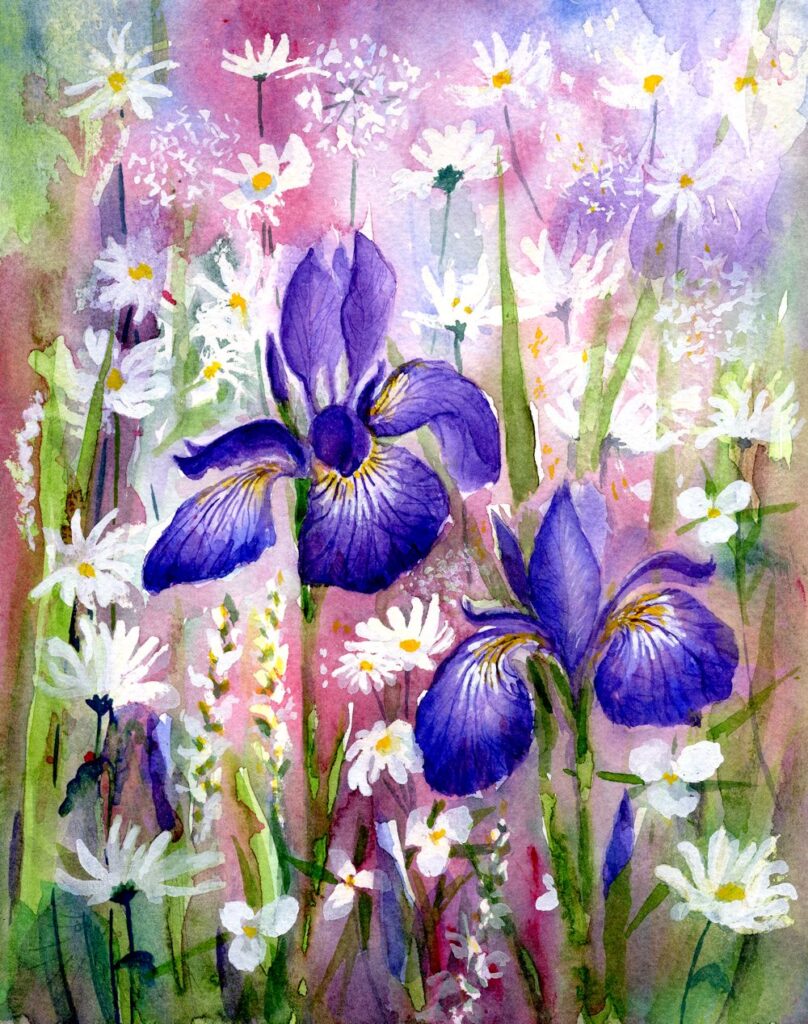
by Jo
This week the challenge will be to make a painting with flowers of different sizes and colours in the garden. Perhaps find two or three large blooms, poppies for example with spikes of blue Veronica and white daisies making a soft focus backdrop. The colours in your garden may be more harmonious like foxgloves withe pale pink and purple Aquilegia.
In week 2 we looked at dark backgrounds for pale blooms but in the real world you will find flowers against backgrounds that are similar or paler in colour and you may also find flowers like pale Rhodedendrons and Azaleas where the leaves form a dark green backdrop for the blooms.
This challenge should result in a fairly free painting of the flowers but with close attention as to how various background shapes, tones and colours work harmoniously or discordantly with some large flowers seen close to. Do look at the works of Shirley Trevena: Pinterest Board link below
https://www.pinterest.co.uk/jhall1282/flower-painting-in-watercolour/shirley-trevena/
These works on one level are quite free but are also highly organised. See how she arranges the little painting of spray carnations where half the painting is dark against light and this is reversed in the top half. Your painting may not be this extreme but be very aware of how the flowers appear against different colours and tones.
Below is the iris demonstration given last week and how it developed into the painting heading this post.
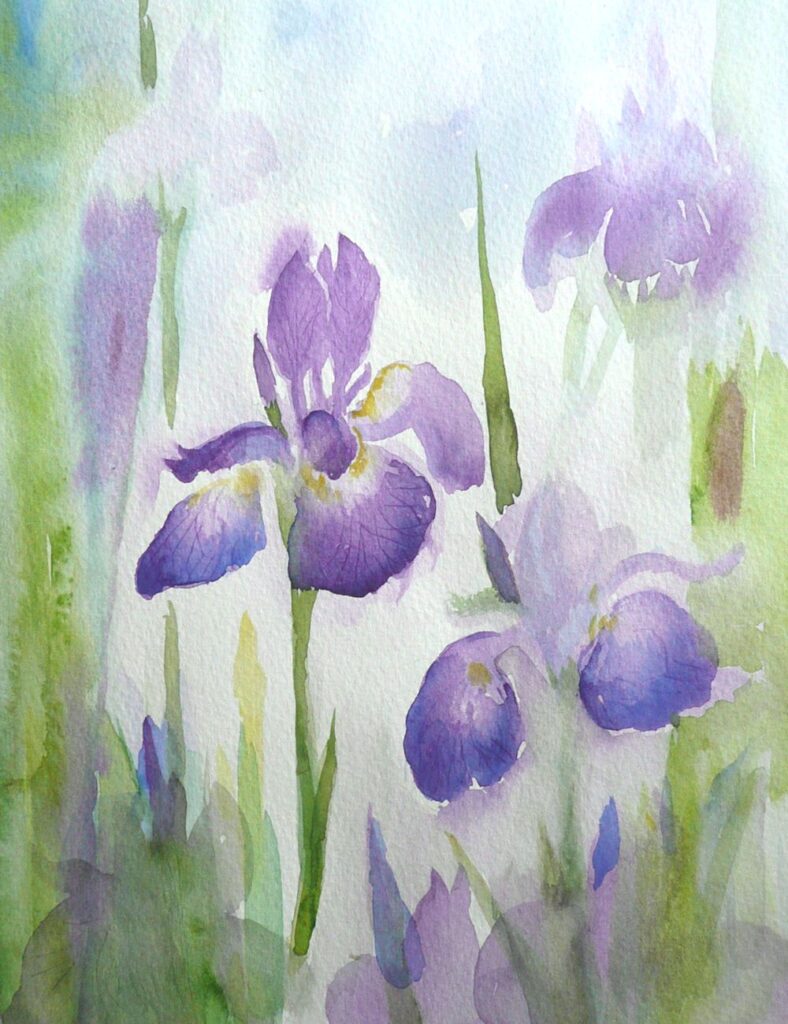
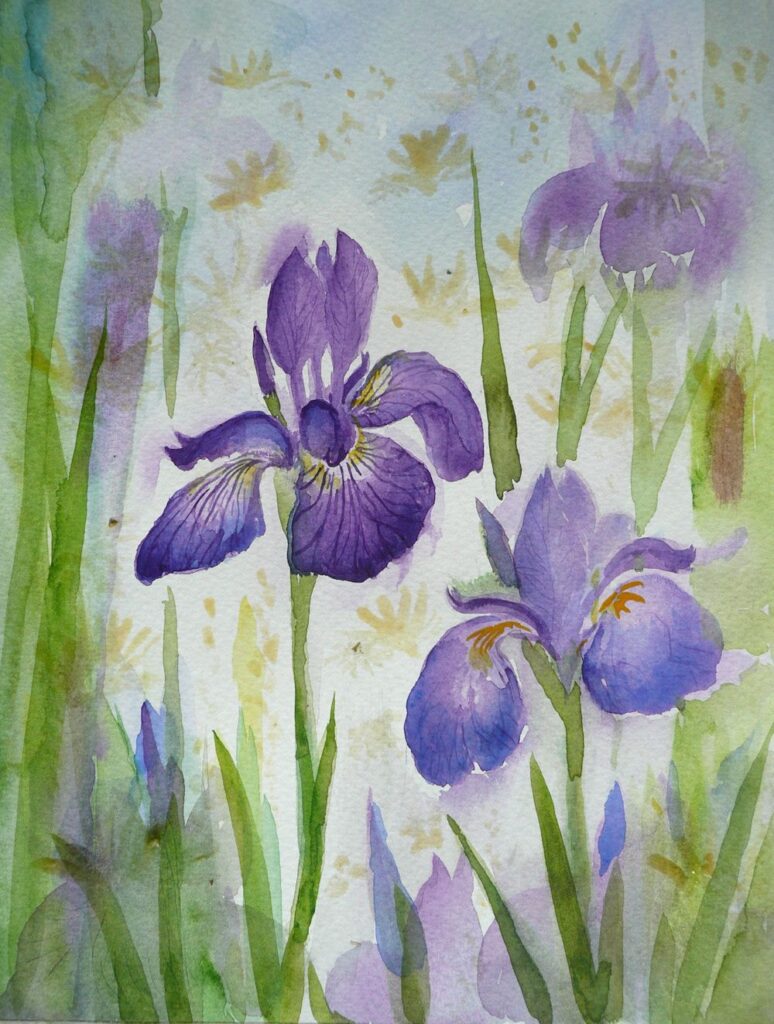
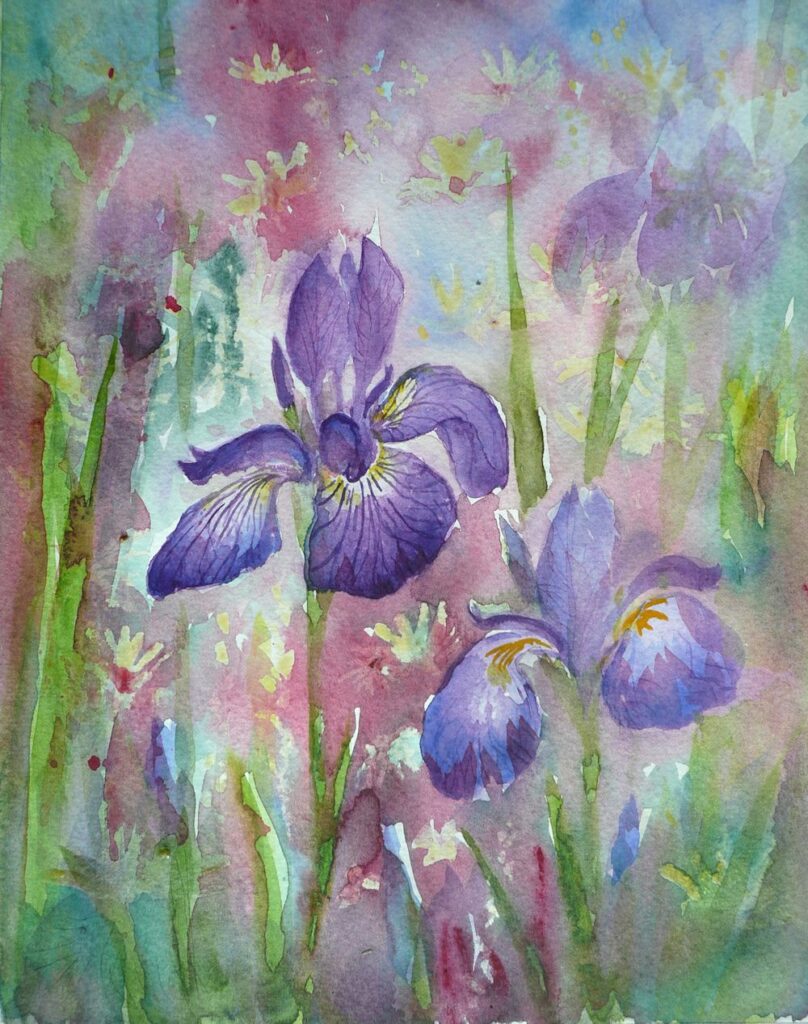
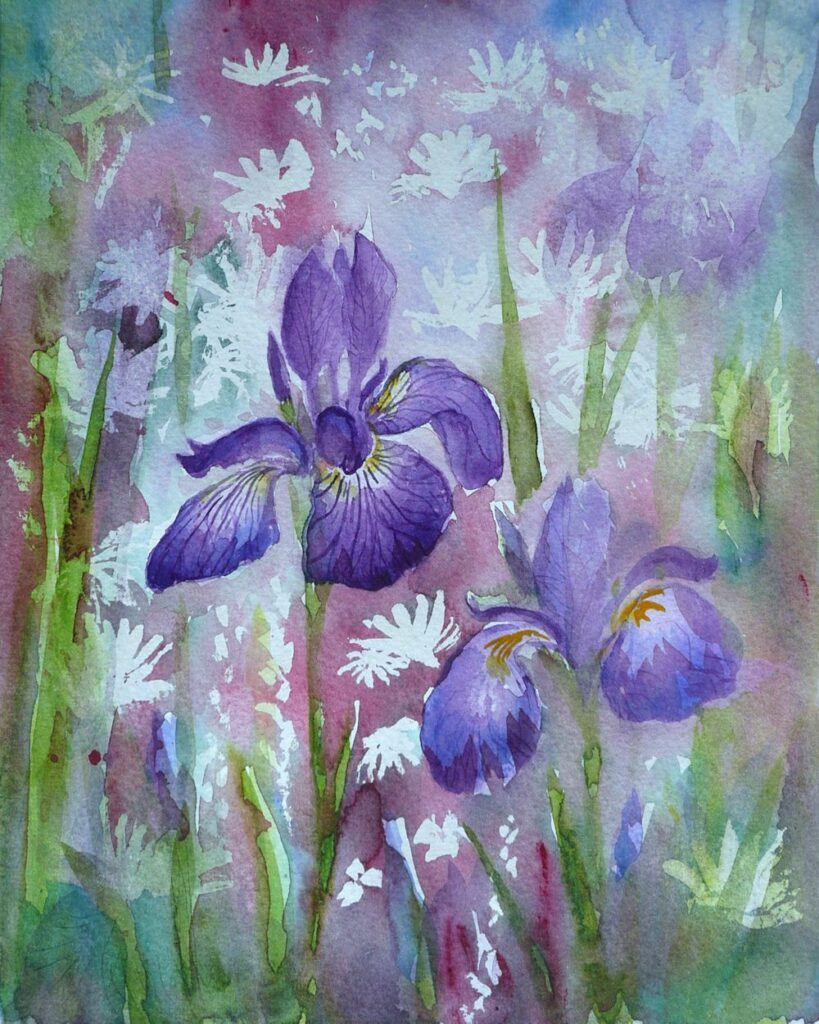
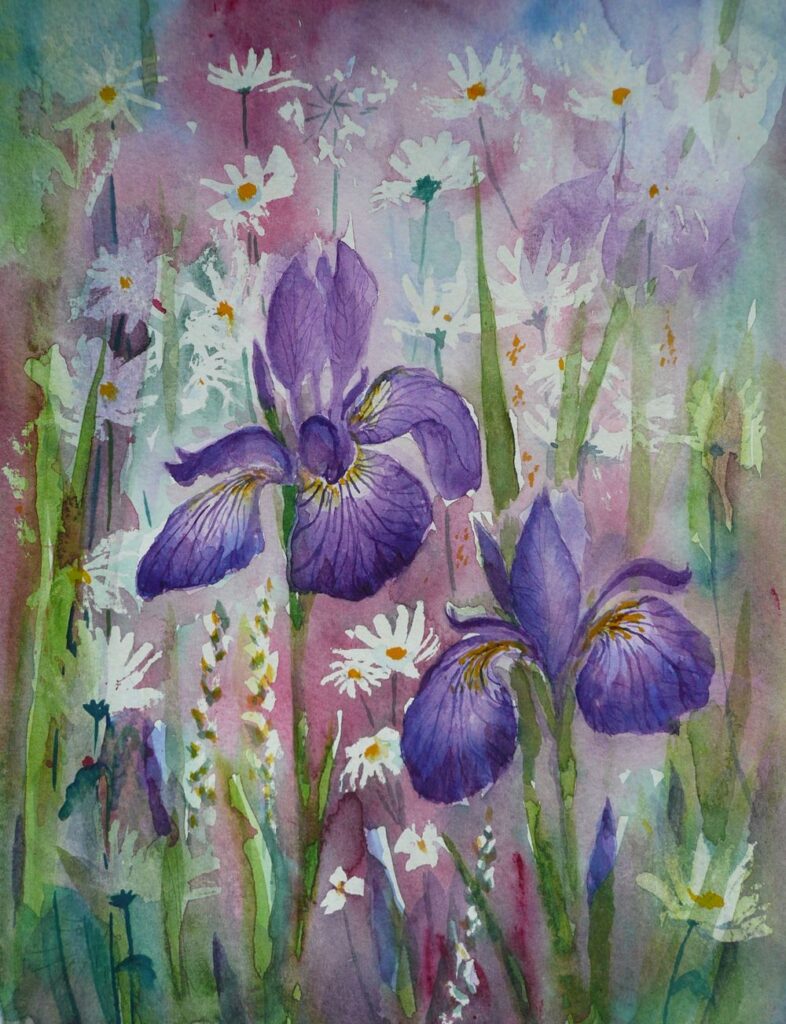

The colours of the Iris buds and and the fall petals were strengthened with further washes of Dioxazine Purple (Winsor Purple) with a dash of Ultramarine Blue.
Apart from the two iris blooms this was composing as I went along. One change in some sort dictated the next till I felt some sort of balance was achieved.
So far we have used very little in the way of a guideline drawn with pencil to map out the shapes so have gained a lot of experience in handling the paint with a brush. It’s now time for a slightly different approach.
This is the week where a tonal sketch before setting off on the final painting will help enormously in organising the composition with regard to the light and dark areas. It would also be a good idea to make another small study juxtaposing some of the colours you are going to use in the foreground with the smaller shapes and colours in the distance and play with the hues surrounding each flower.
When the sheet of of watercolour paper for the final piece is in front of you, make sure to mark the paper so that it is in the same proportion as the composition sketch or photo-reference chosen to work from. Do map out all the main areas and challenging shapes with pencil. Think about whether and where to apply masking fluid or a wax resist for the white/palest areas. It may be that it would be better to reserve the white of the paper by painting around the shapes to be left untouched and to used pigments that can be lifted out while the paint is still damp or after the first washes are dry. Note that “staining” pigments do precisely that and will sink into the paper so that when dry they are very hard or impossible to lift out.
As the painting progresses it may be that elements of the flowers and the background are worked at the same time. It can be great to leave some hard edges but there will be other places where it may be good to let wet paint bleed from one area into another. Make sure a damp sponge, “dry brush” (brush dipped in water then squeezed gently in some paper tissue) or just the paper tissue is to hand in case the flow gets out of hand.
Don’t worry about the end result, to some extent you will have to go with the flow, enjoy the process and have fun. Not sure whether this post will get illustrated but if not there is plenty of food for thought here and plenty to look at on the Pinterest Board.
Your Paintings;
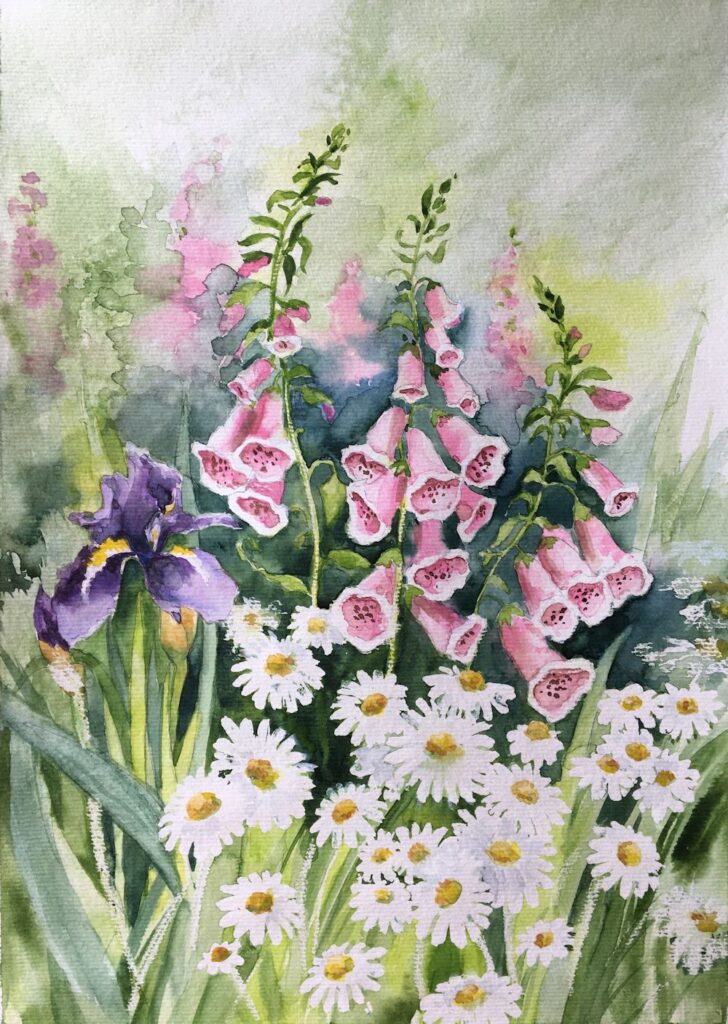
by Maryon
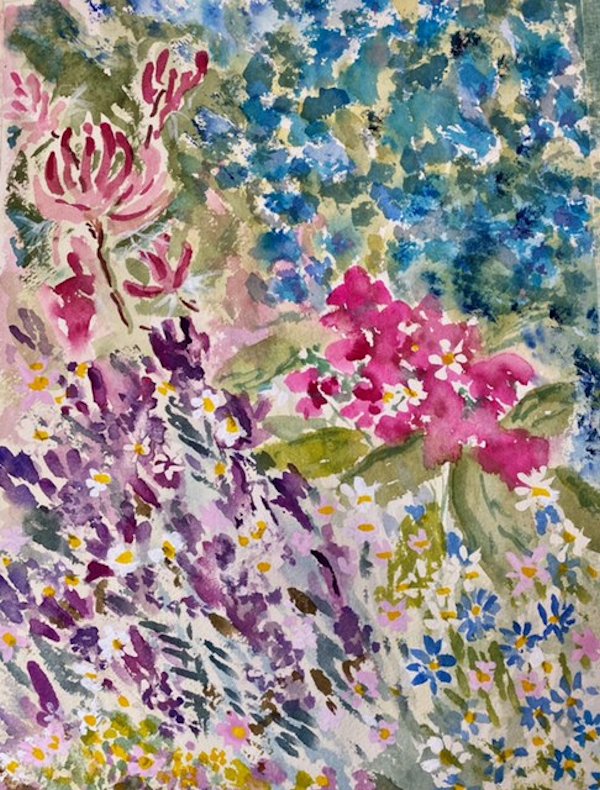
by Sandra
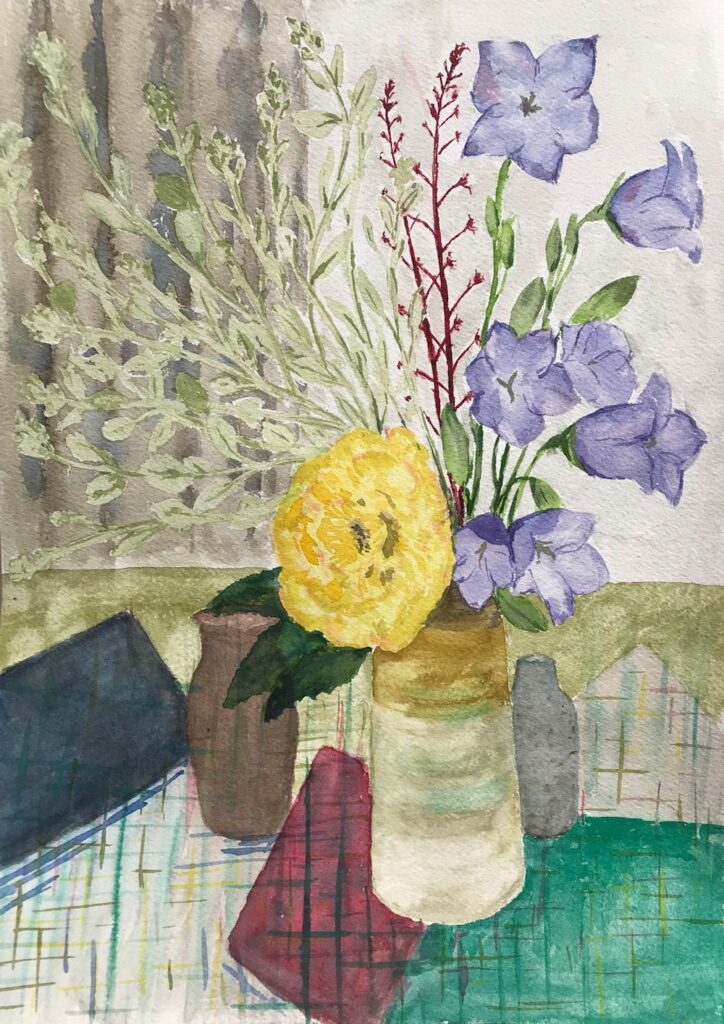
by Mali
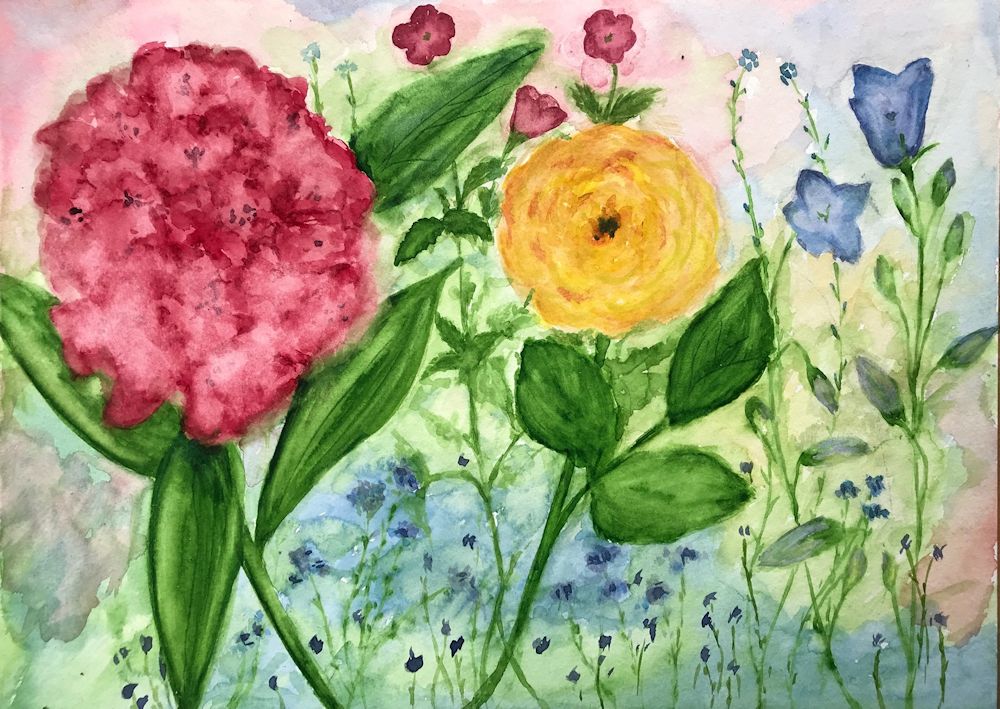
by Mali
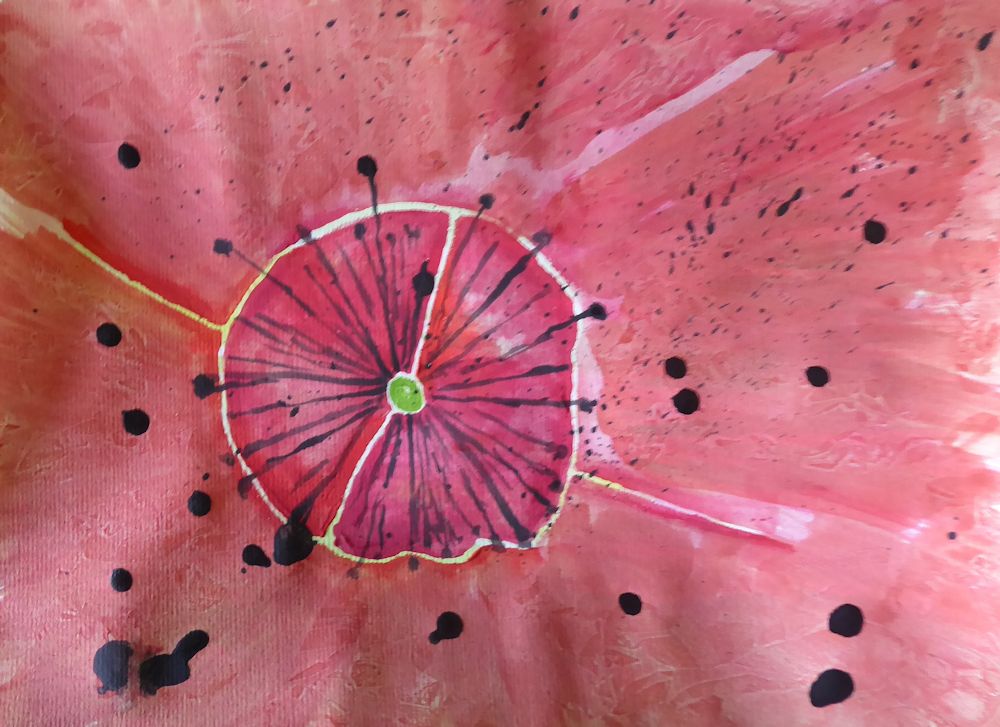
by Anne
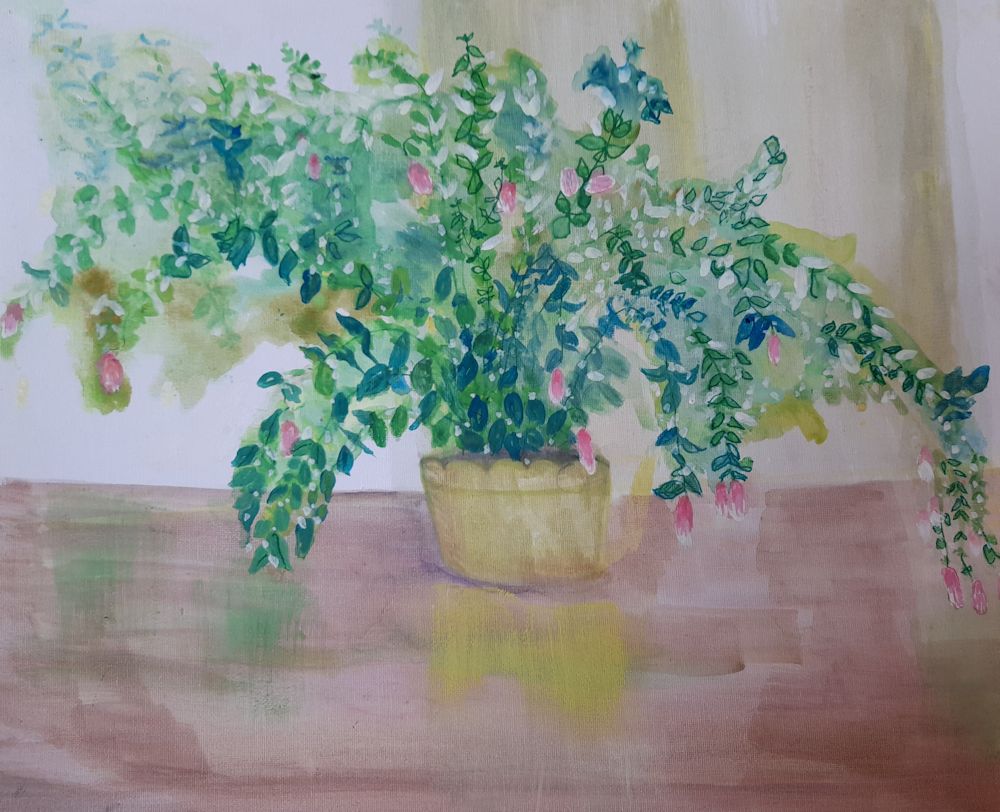
by Kate
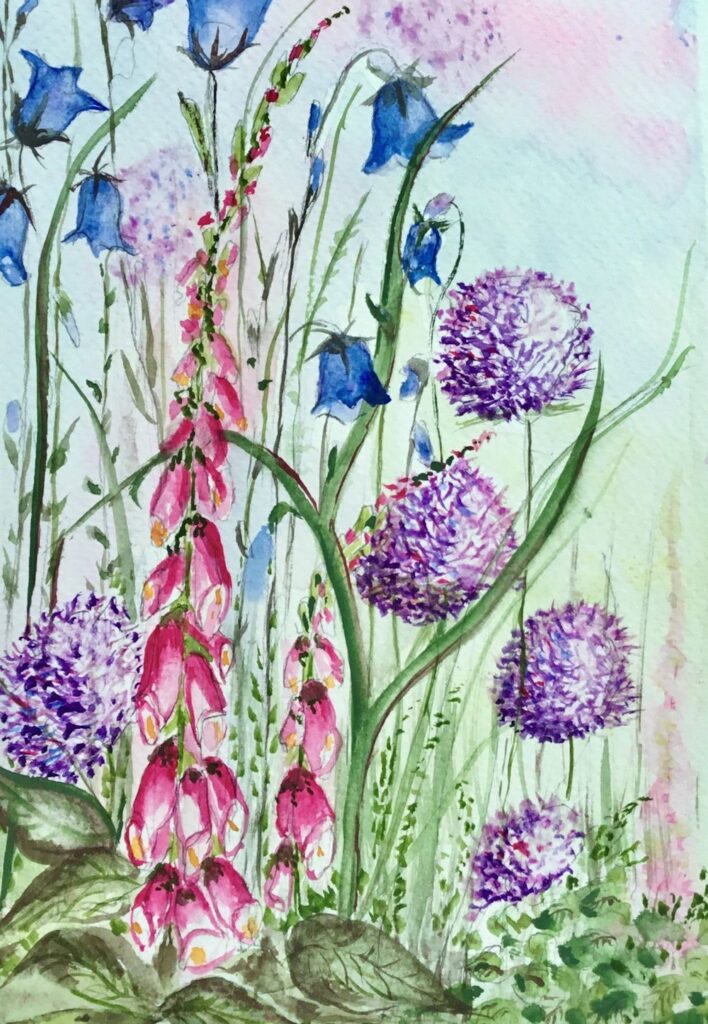
by Ann
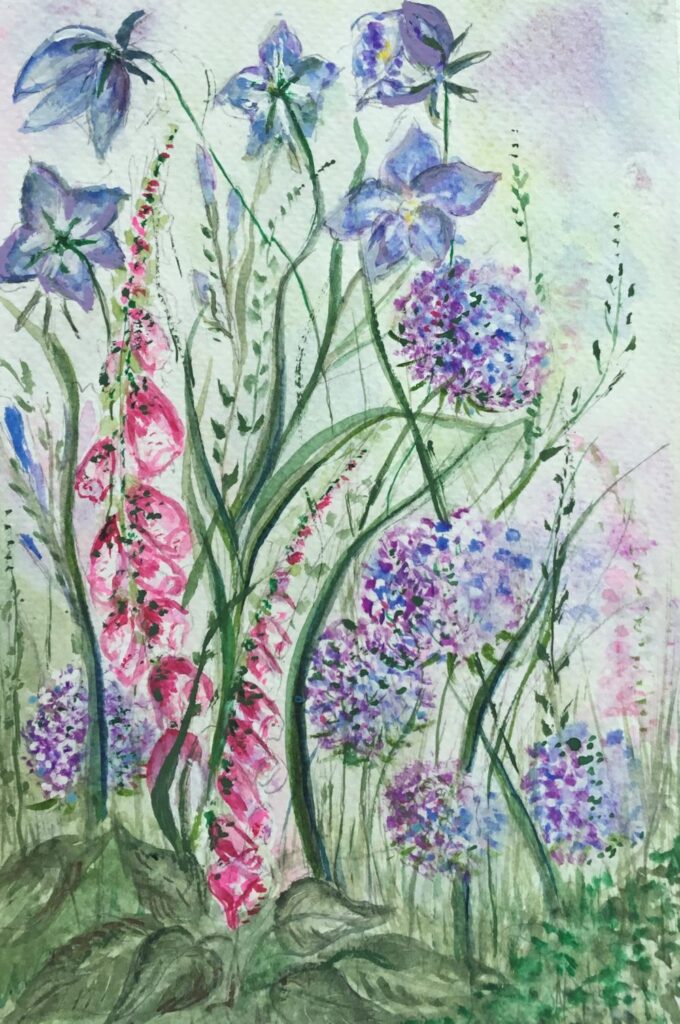
by Ann
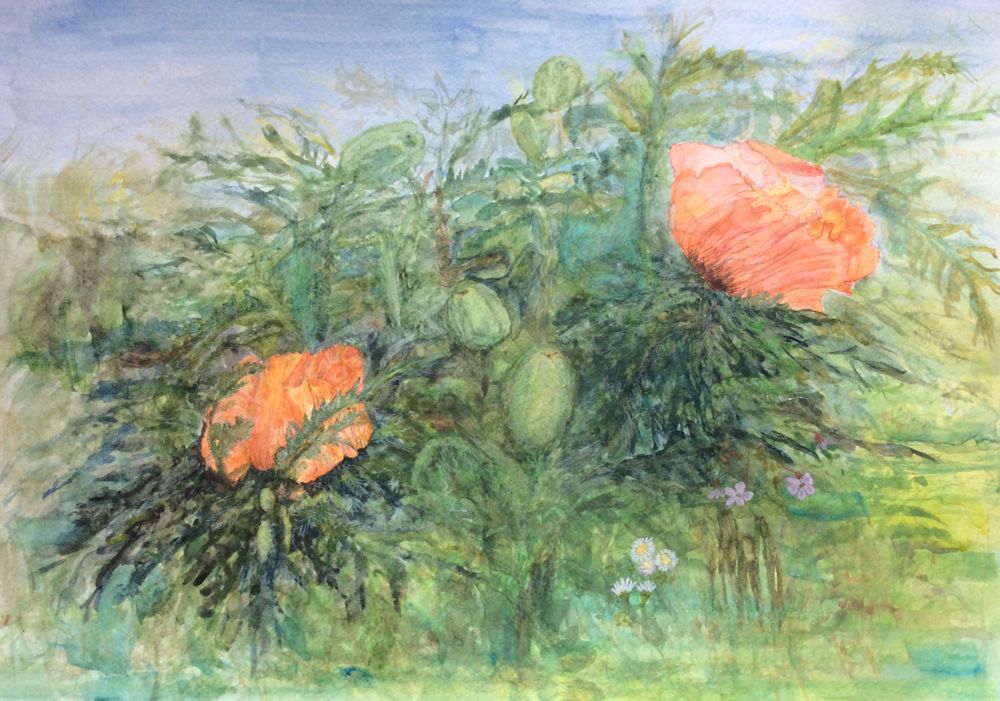
by Virginia
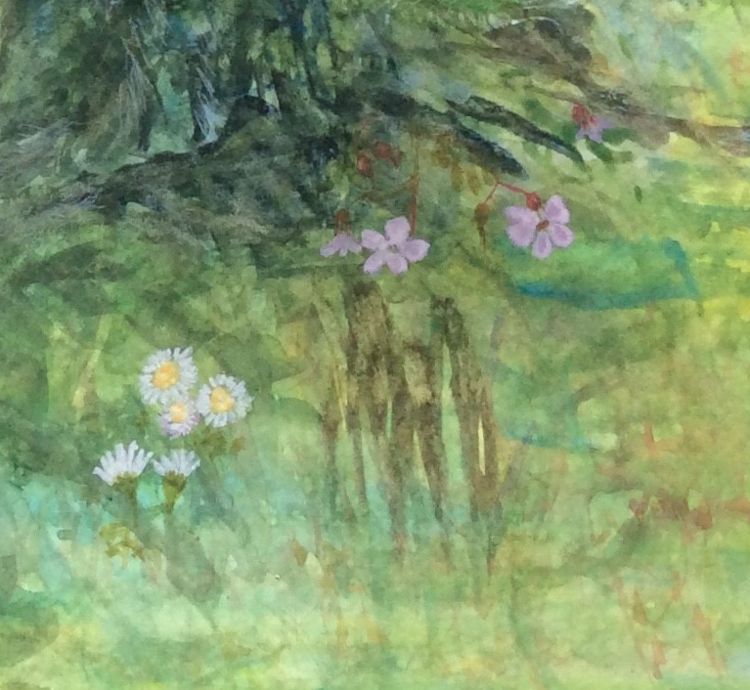
by Virginia
This beautifully painted detail from Virginia’s painting above could be easily overlooked when seeing the whole painting at a small scale as above.
Just delightful!
Flowers in Watercolour Week 3: From dark Backgrounds to Colourful Blooms
May 13, 2022
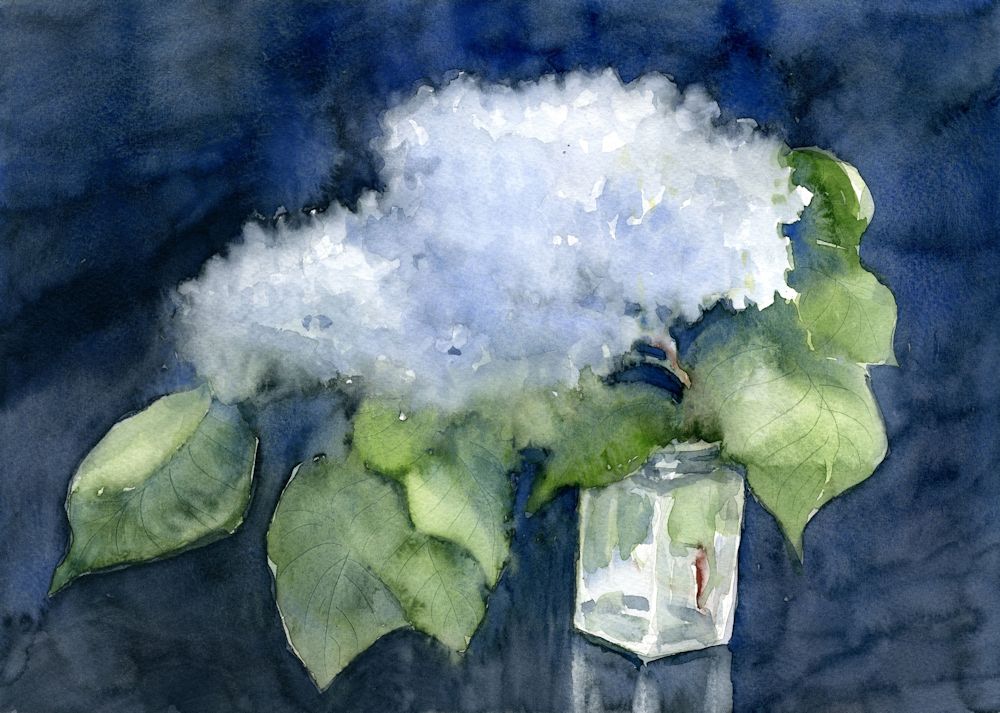
As the lilacs are pretty much ended I was delighted to find a couple of headily perfumed blooms left to paint. The painting above was on a quarter sheet of Bockingford cold pressed watercolour paper which stood up to very wet washes, indenting wet paint to make veins in the leaves and lifting out areas to soften them and give and indication of petals.
The white of untouched paper shines through in the glass jar. This time I decided against masking fluid as I hoped for a soft look to the painting.
The three images below show how a smaller study was made on very damp paper working wet in wet then leaving the paper to dry before re-wetting the paper and adding further washes. Some lifting out was done while the paint was wet but the petal shapes were lifted out when the paper was dry.
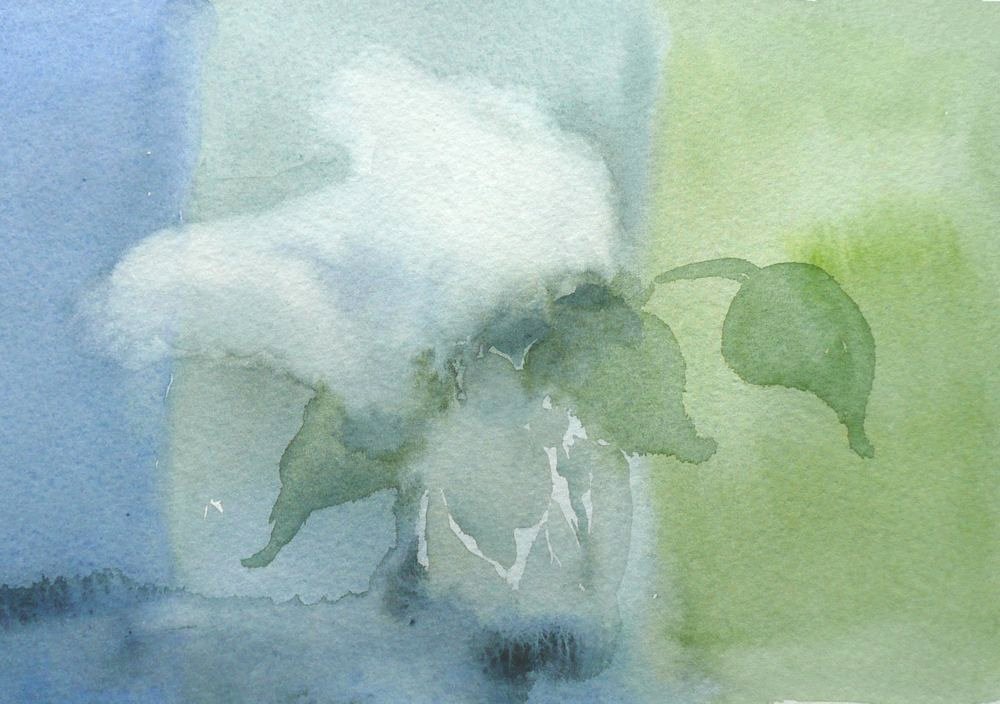
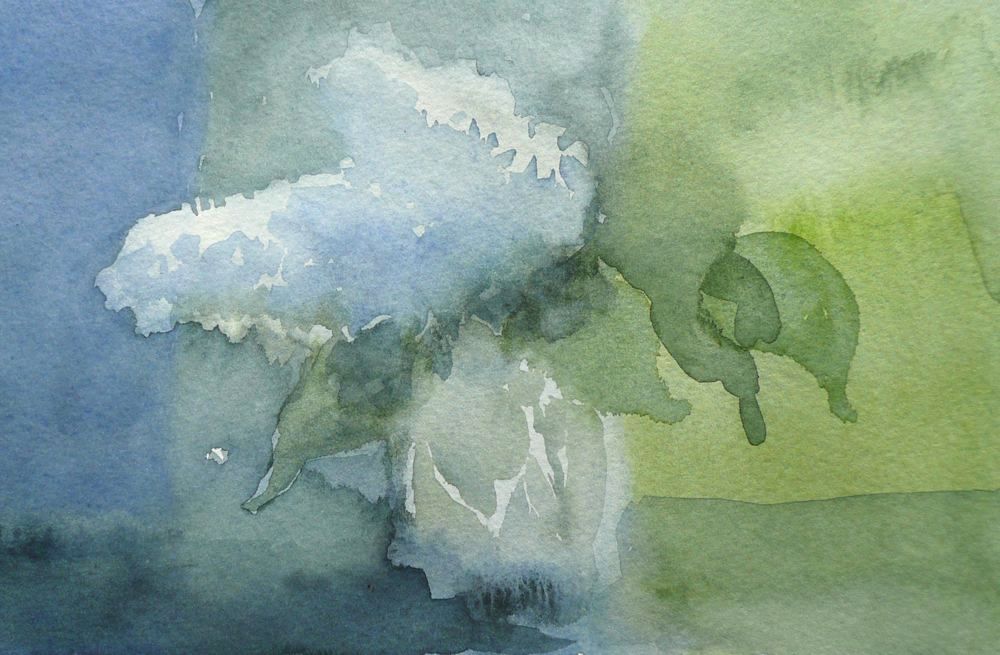
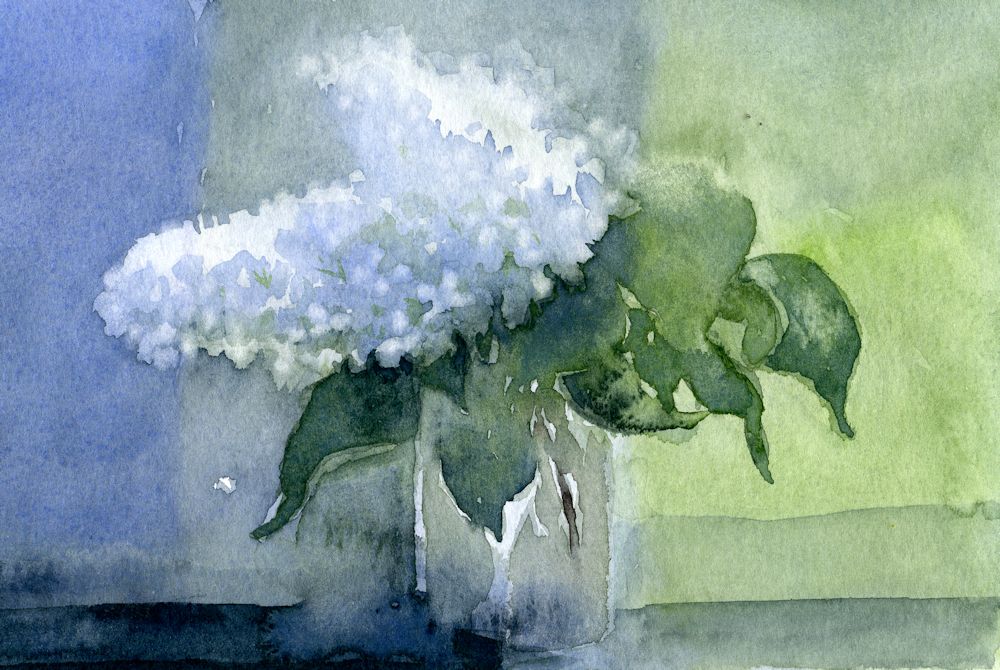
This week’s challenge is to paint flowers as they grow in the garden using any of the watercolour techniques used so far and with the aim of capturing an impression of their character; how they look up at you as the pansies and little pink geraniums or how they point toward the sky like the iris in the photo below..
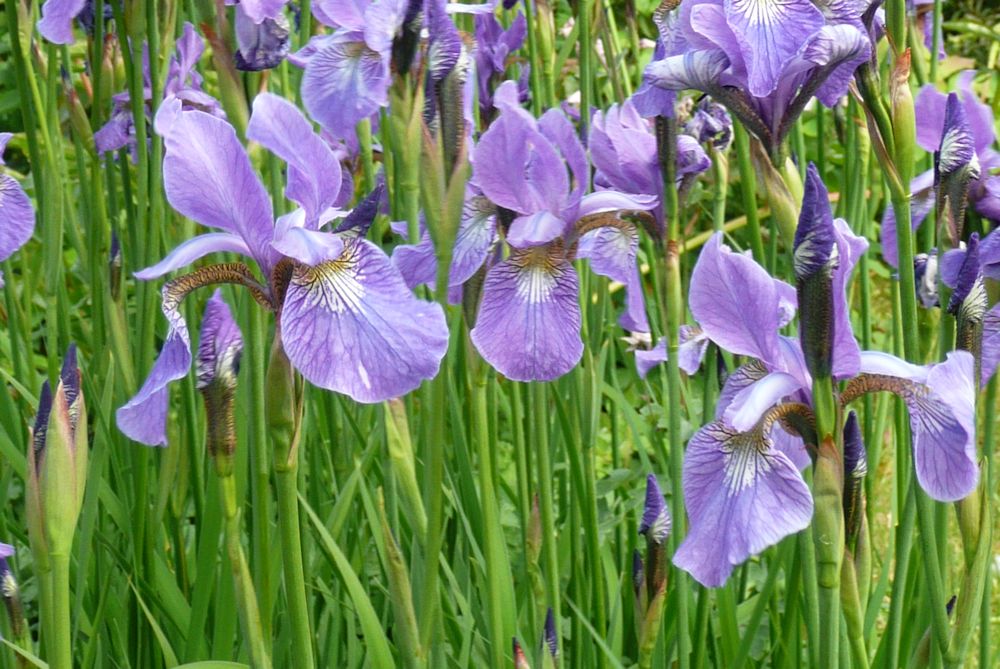
Photo by Jo
If you have time try to get out into the garden and sketch and photograph your favourite flowers. Make sketches of individual blooms, buds, stems and leaves to familiarise yourself with the shapes, and small composition sketches to explore the arrangement you may choose to paint. Iris and Weigela are blooming as are geraniums and Aquilegia so there should be plenty of colour around.
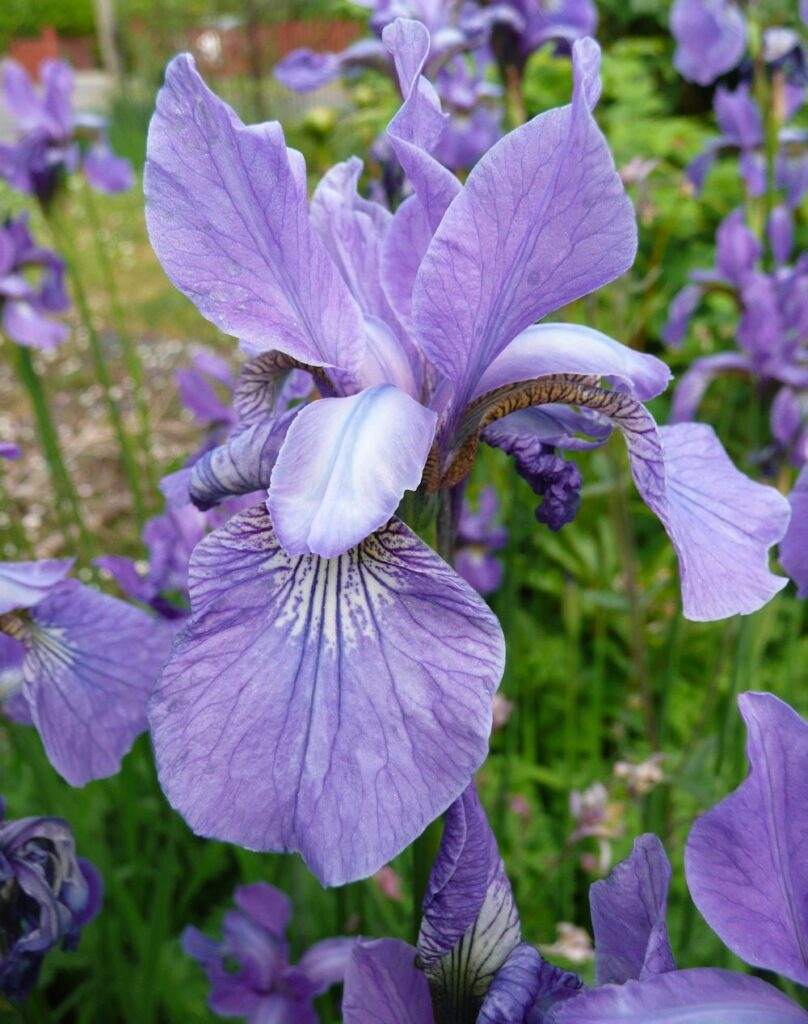
Photo by Jo
Before starting to paint explore the colours and brush strokes which will help depict the plant’s character and then review the composition sketchesmade outside and home in on one idea for the final painting. This may include just one or two plant stems relatively close up or with a backdrop of the same flowers or different plants giving an impression of a massed planting.
Experiment with colours and how they interact when mixed to find the hues and strength of washes you will need, erring on the side of making more wash and stronger washes than you think you may need. It is easy and quick to add water, not so easy to “drop in ” strong colour if it isn’t already mixed.
You may like to look at the following Pinterest board for some ideas on painting iris, link below:
https://www.pinterest.co.uk/jhall1282/flower-painting-in-watercolour/iris/
Your paintings:
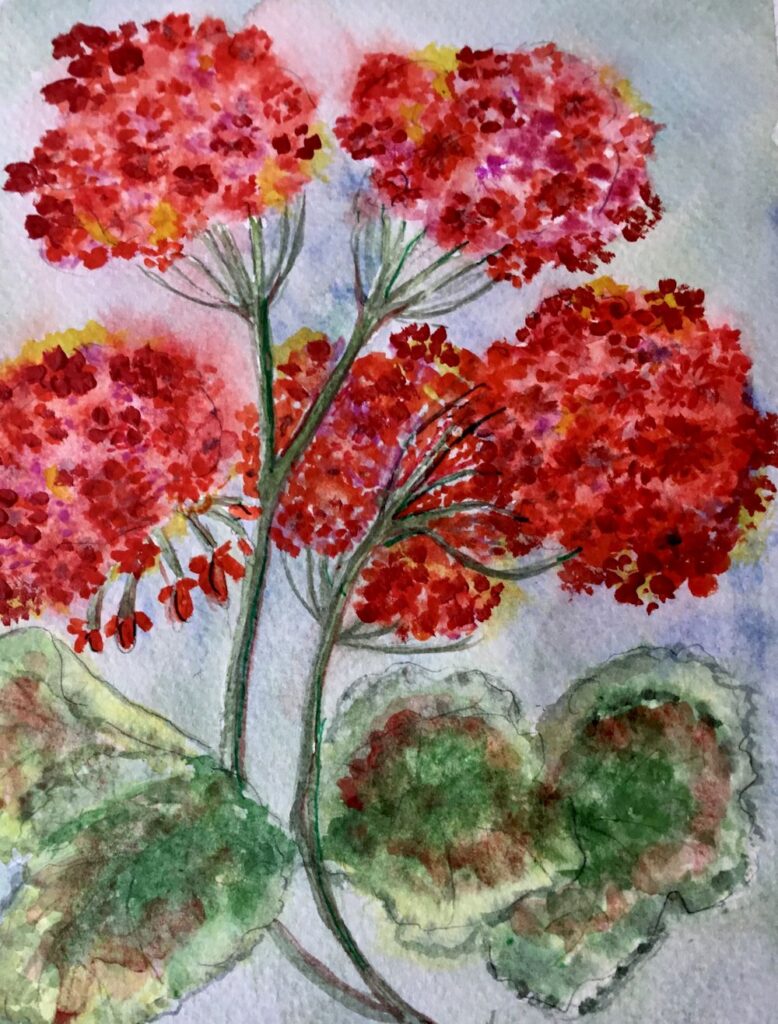
by Ann
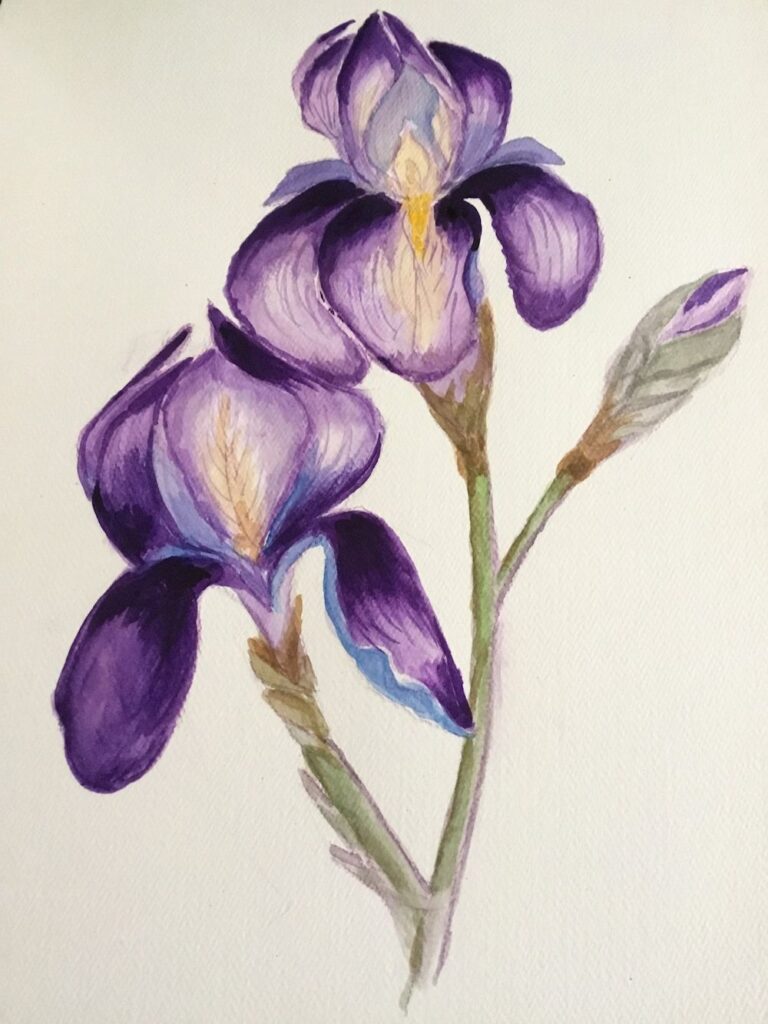
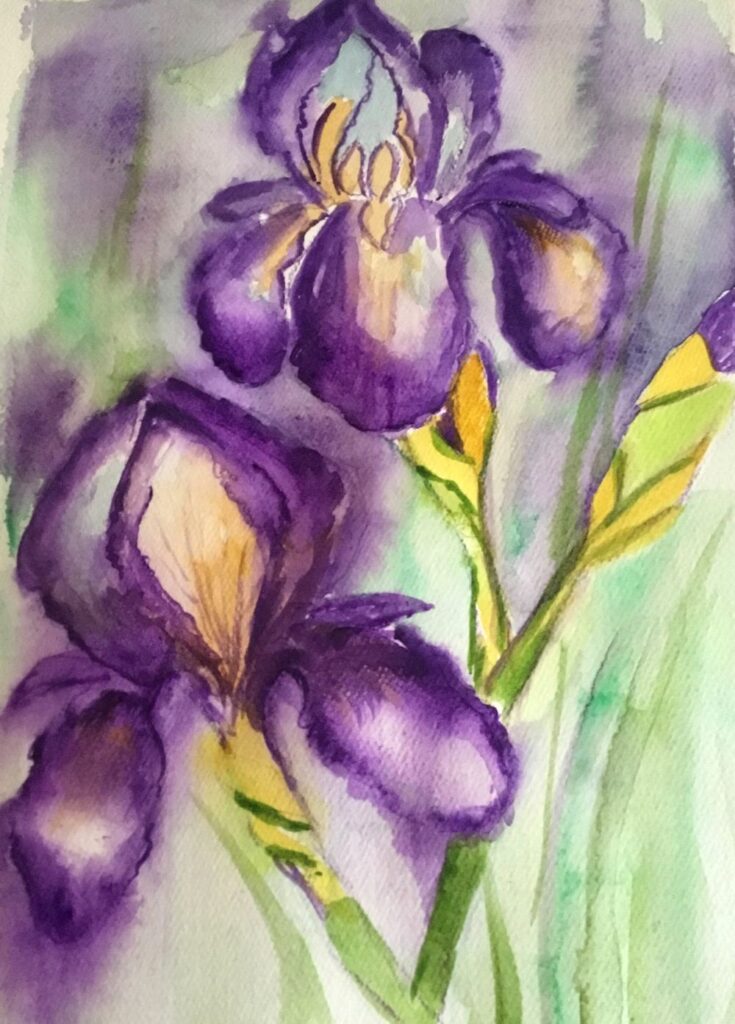
by Ann
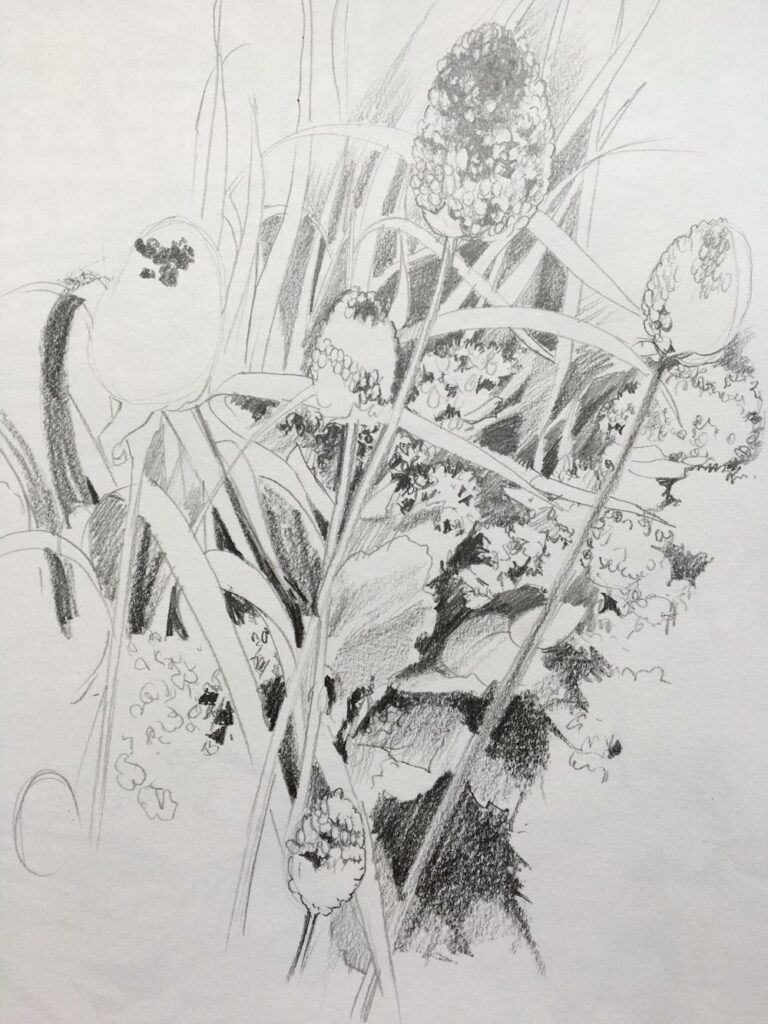
by Maryon
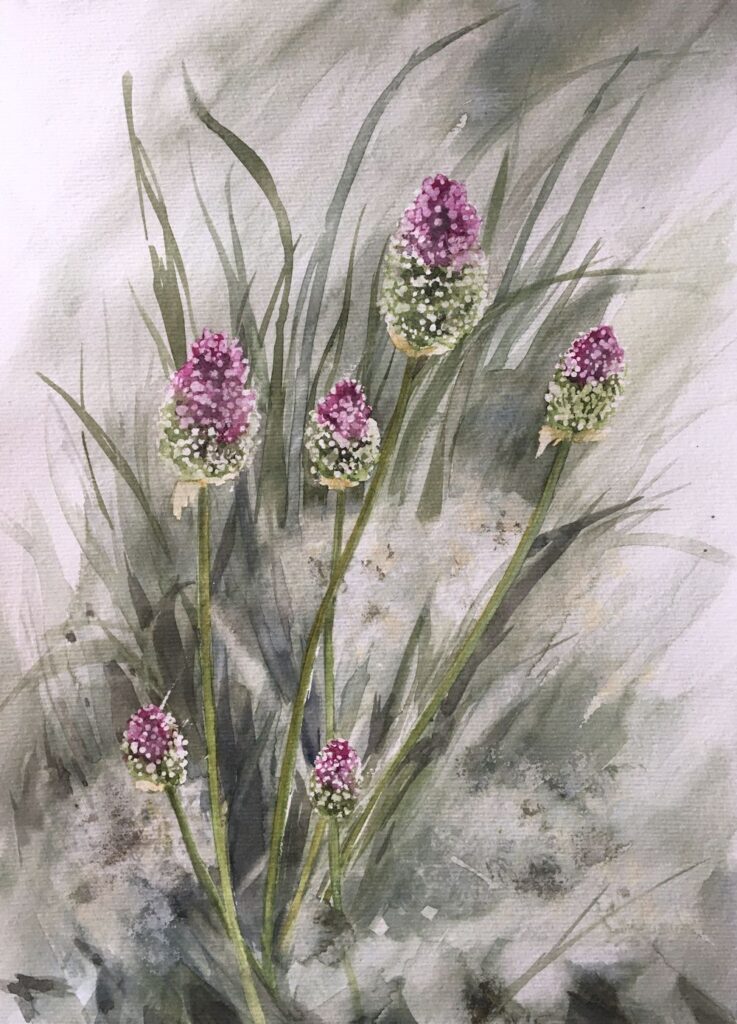
by Maryon
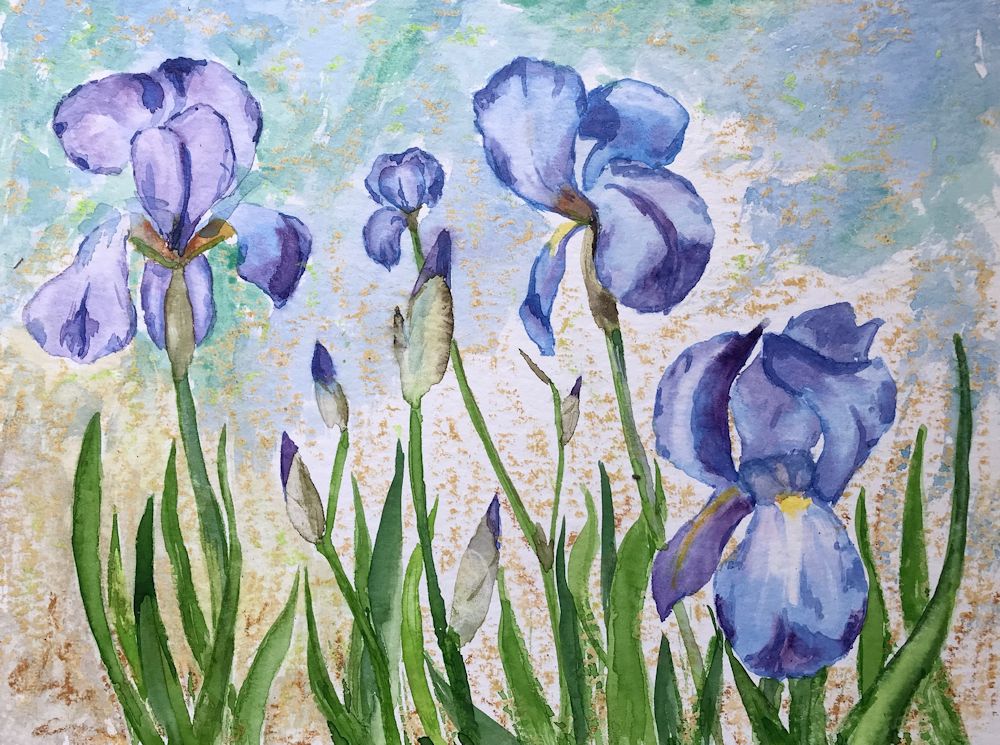
Watercolour and Oil Pastel by Mali
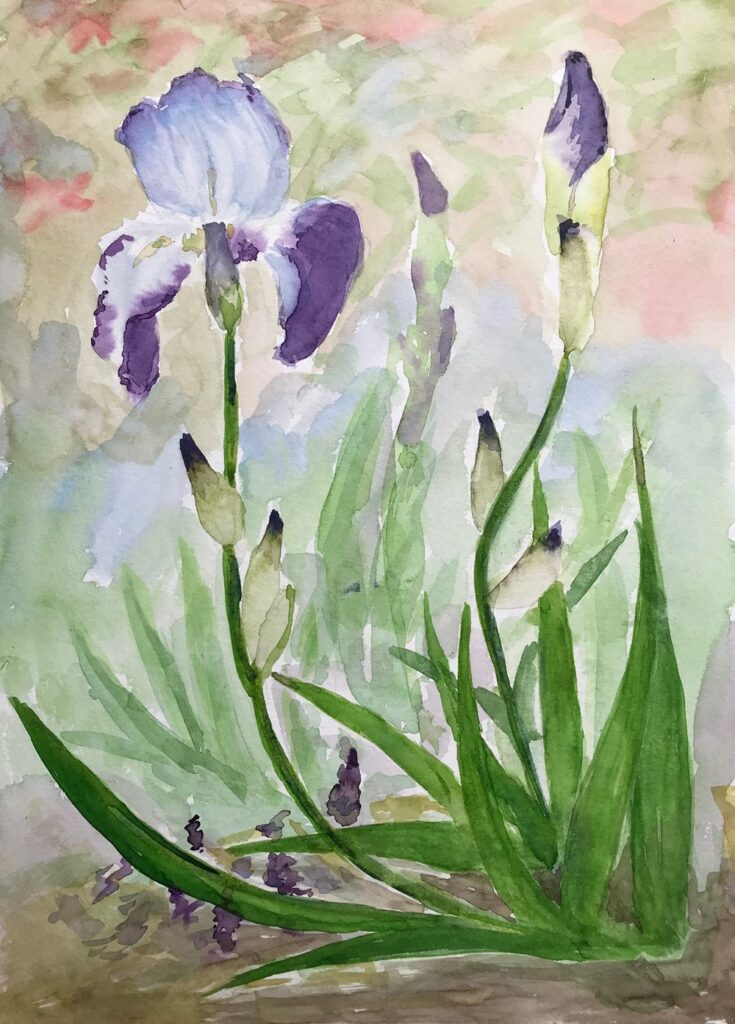
by Mali

by Sandra
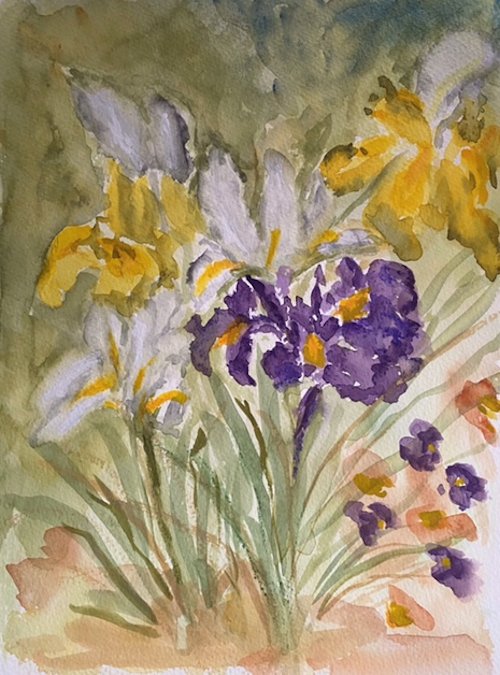
Watercolour by Sandra
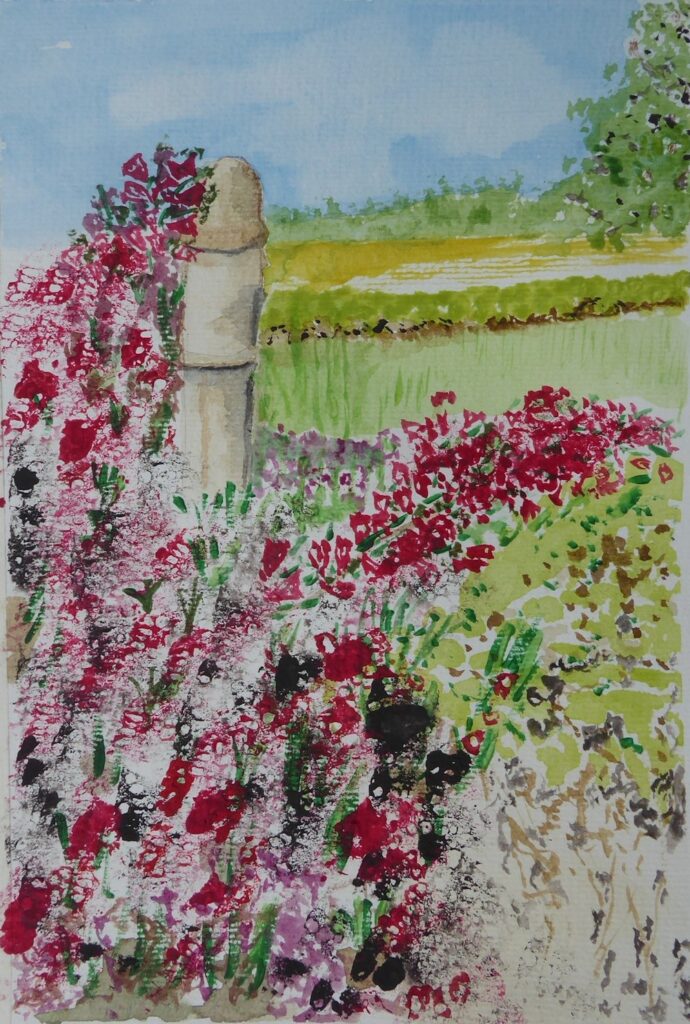
by Anne
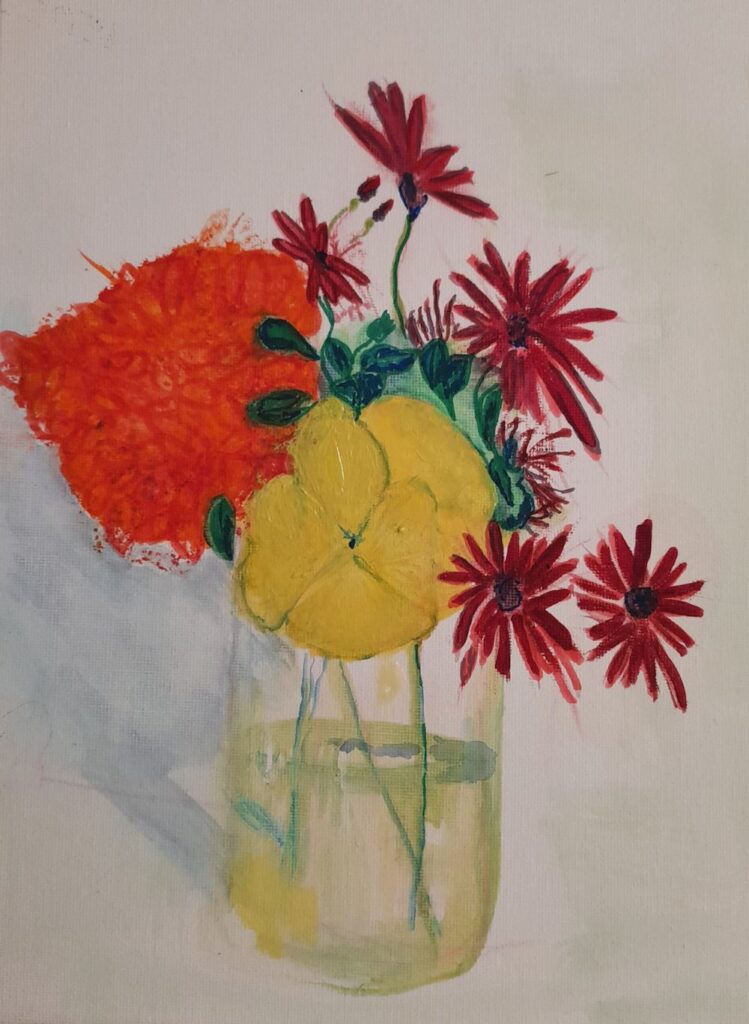
by Kate
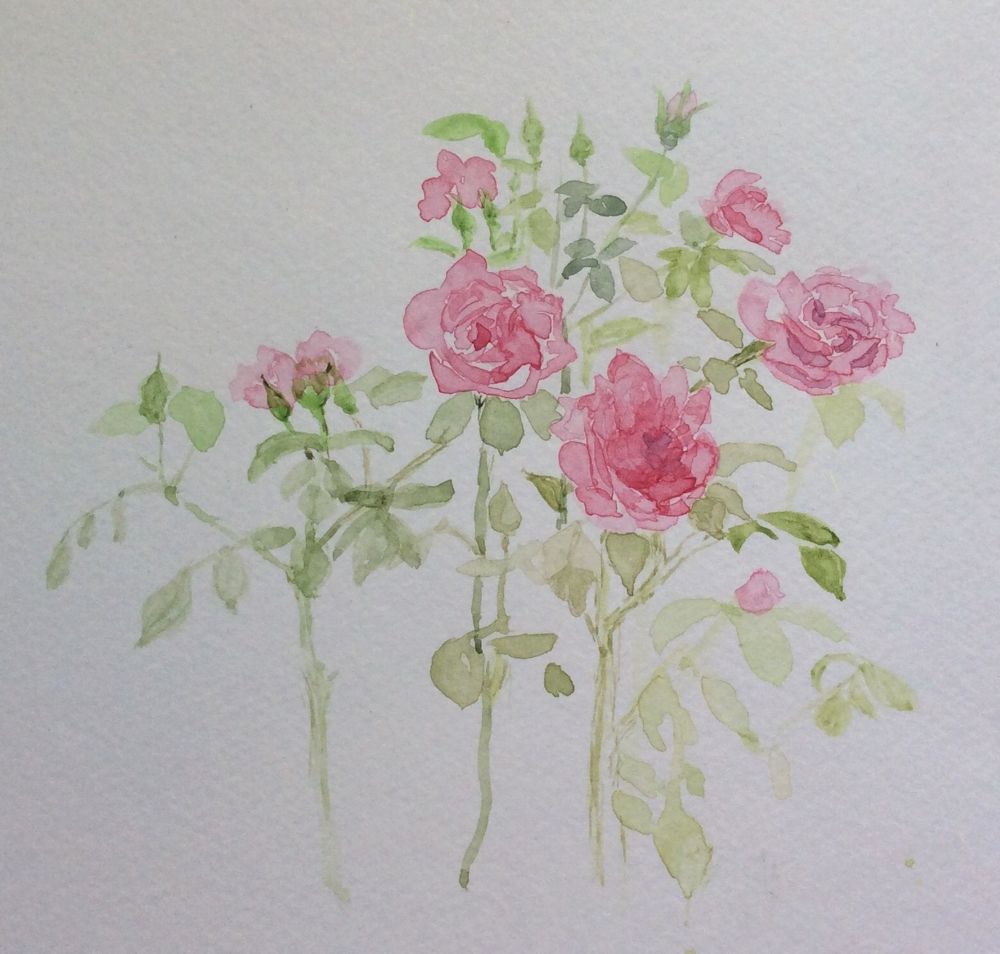
by Vitginia
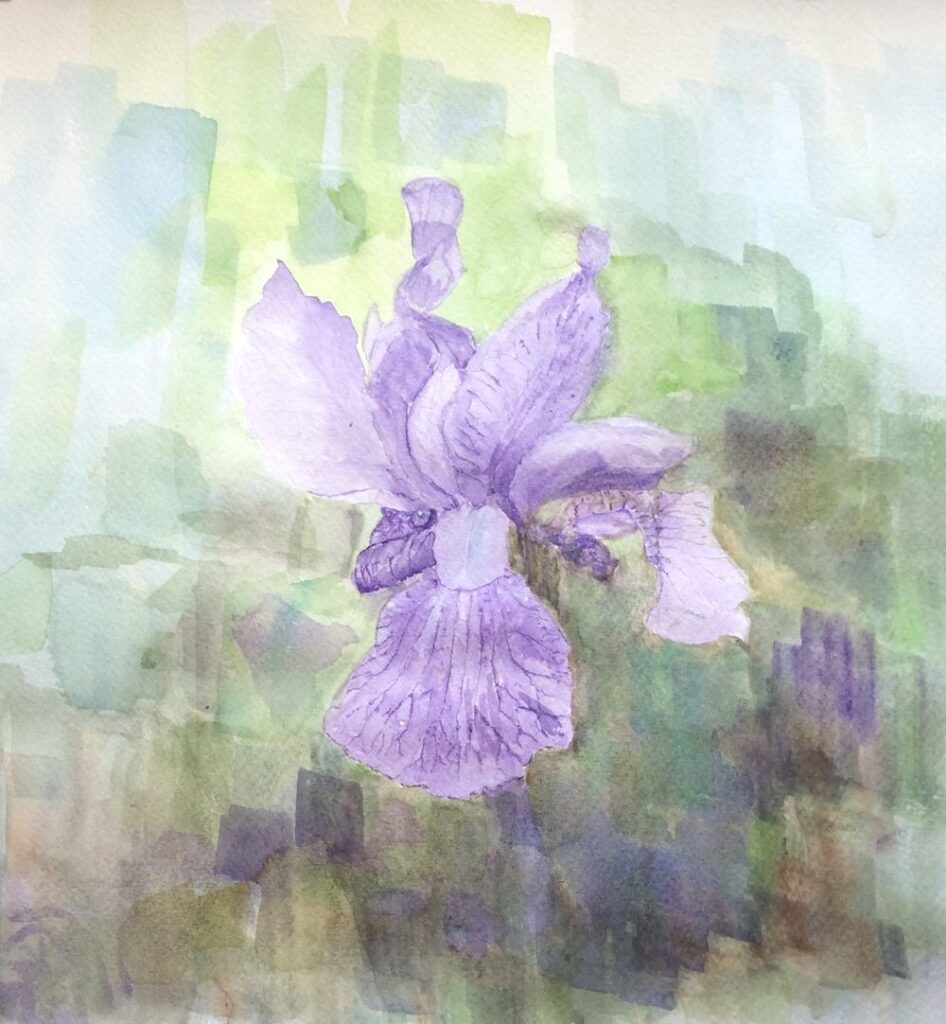
by Virginia
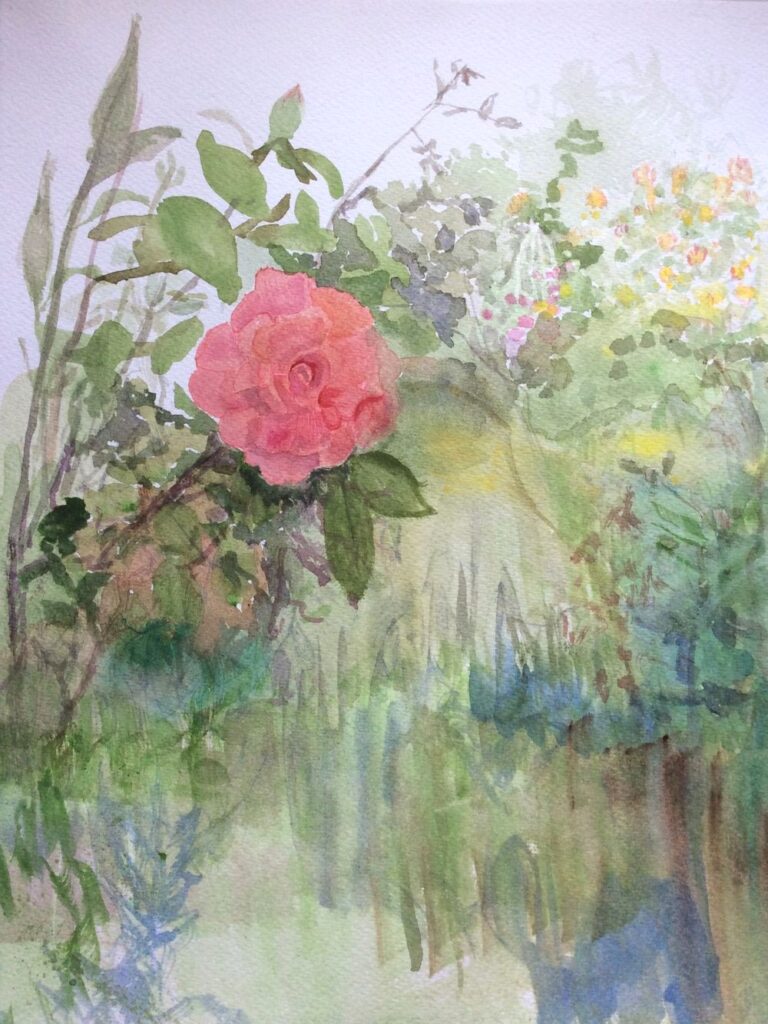
by Virginia
Watercolour Flowers, a Free Approach: Week 2
May 6, 2022
The first part of this post is a recap of what we did in the last session. The second part explores painting pale flowers and backgrounds.
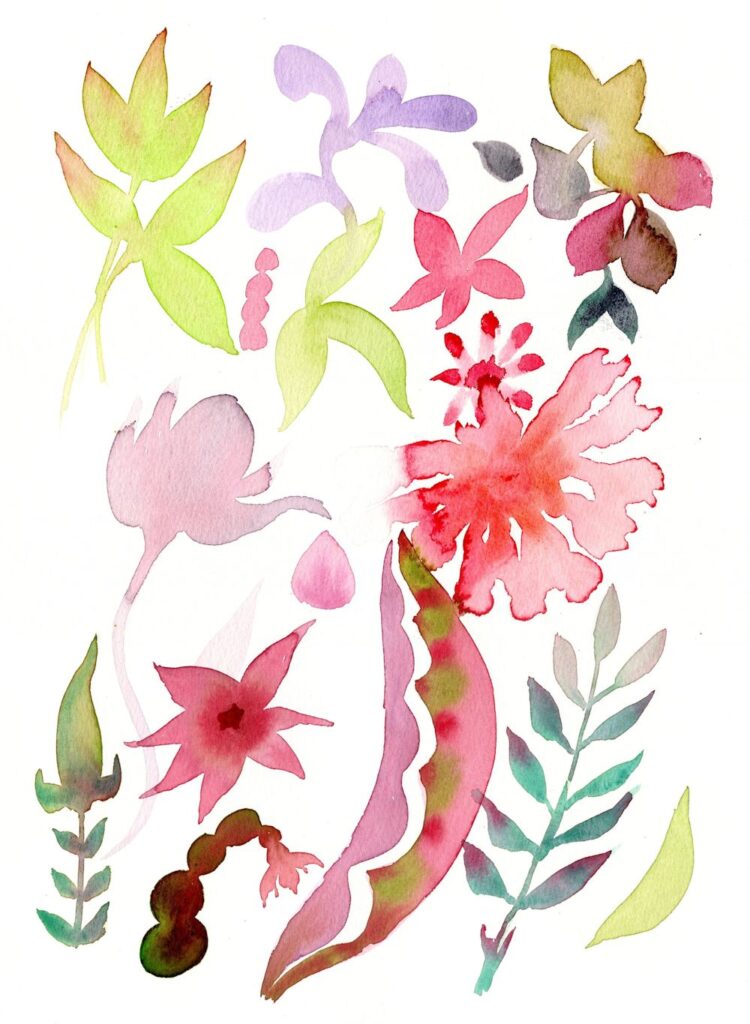
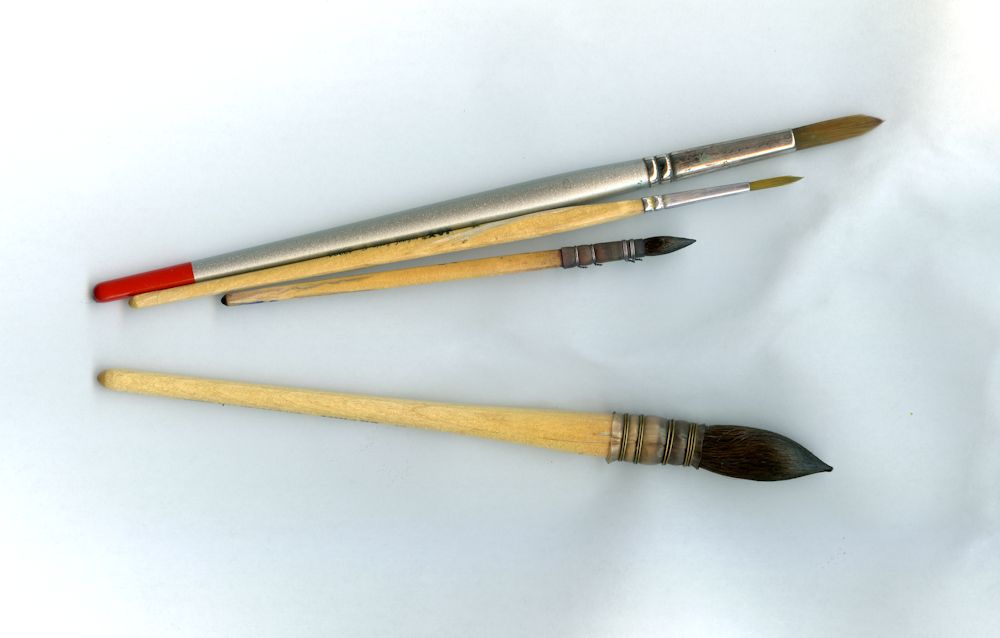
The much larger squirrel mop below these brushes has an excellent point so although I usually use it when when working at a larger scale it is a versatile brush capable of making fine lines and adding small marks for detail.
By increasing the pressure as the stroke is made and then decreasing the pressure as the stroke is ended and the brush lifted from the paper leaf shapes both thin and broader can be made with round brushes. We also used flat brushes to make a variety of marks resembling leaf shapes by twisting the brush as the stroke is made. Depending on whether the broad or thin edge of the brush is presented to the paper a variety of line widths can be made with flat brushes. Some of the best fun can be had by loading a brush; any variety and using it sideways as a printer on to dry or damp paper.
Below is a demonstration of a cornflower where flat and round brushes were used on wet and dry paper.
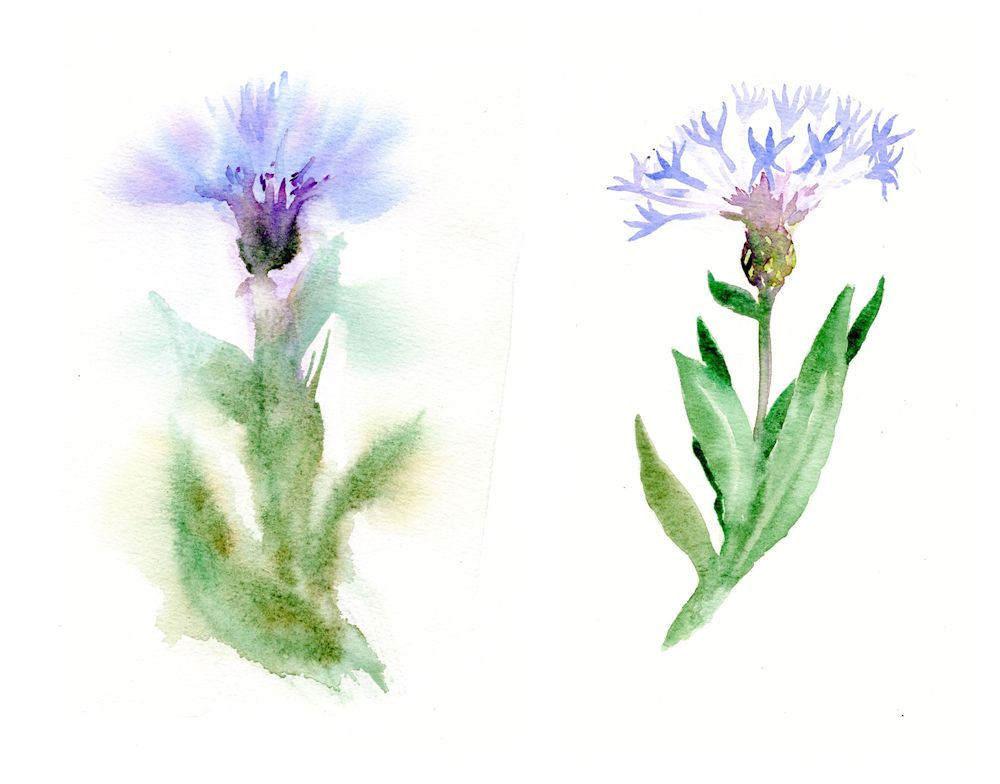
Painted on damp paper on the left and on dry paper on the right.
A wash of water was applied to half the sheet with a large brush and allowed to dry just a little. Colour was added as the paper slowly dried. Defined shapes occurred where the wash has been mopped with a “dry brush”, tissue or sponge.
When working in watercolour, especially when working on wet paper it is essential to have your colour washes mixed and at the ready, together with a sponge, tissue paper or to pick up excess paint as you proceed or to remove moisture from your brush so that the brush can be used to control very wet washes.
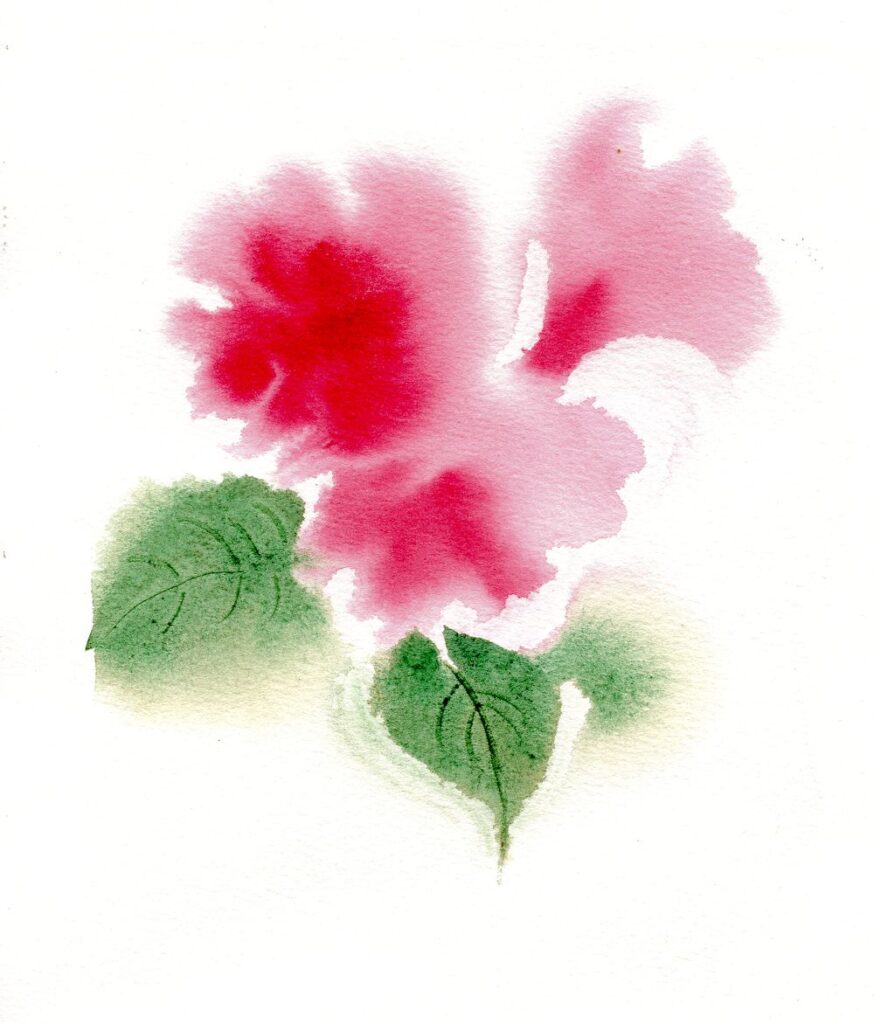
While the paint was wet a blunt tool was used to score the paper so that paint filled the troughs to indicate veins on the leaves.
Now it is time to consider backgrounds both for dark and especially for pale paintings of pale flowers.
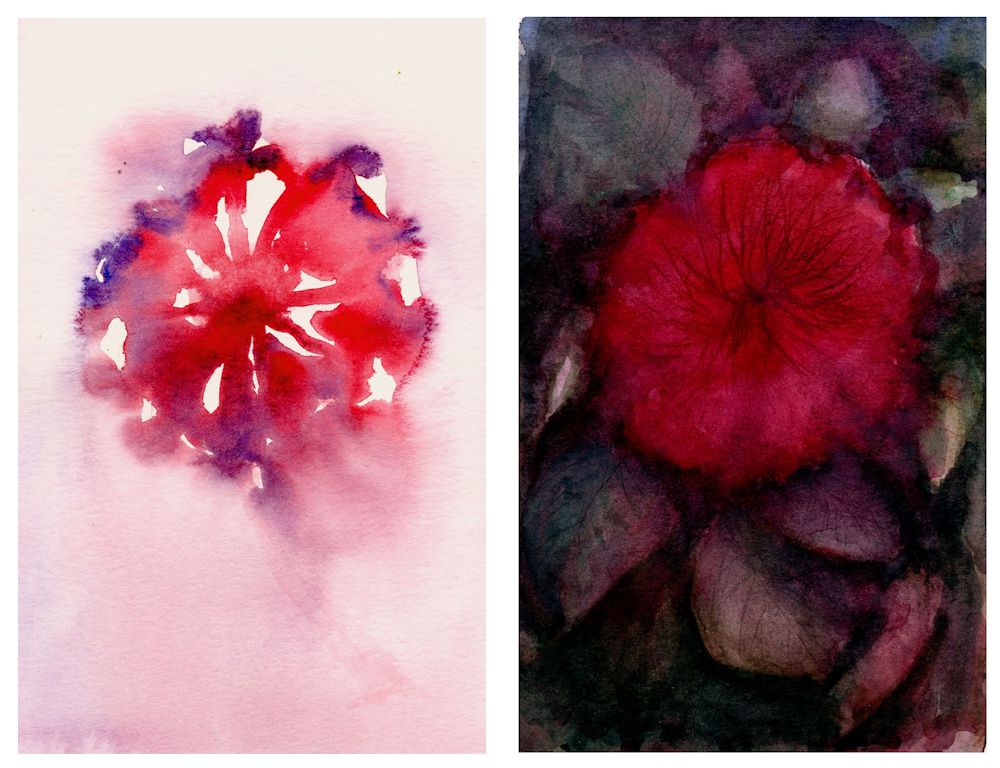
It was then allowed to dry. Dark washes were added mostly wet in wet and with indenting to suggest marks on the flower as well as leaf veins. The dark leaf mixes were made using Viridian mixes with Alizarin and Purple and also Viridian with Burnt Sienna. The result of perhaps too many layers is a very dark painting of an azalea like flower.
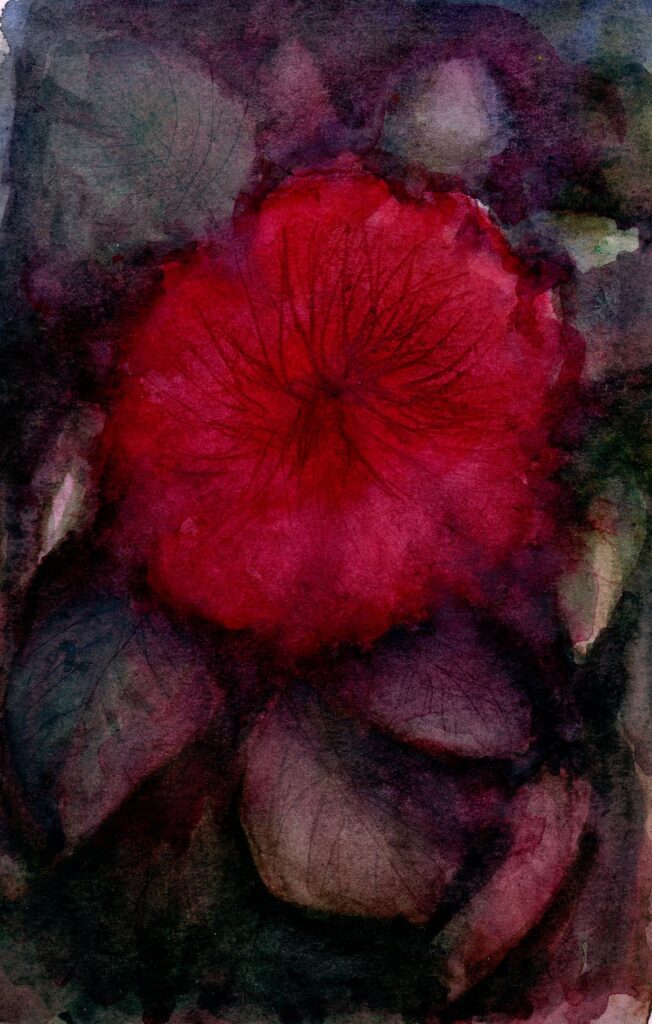
With a lighter touch a dark background to pale flowers can preserve a feeling of freshness as in the watercolour sketch of some apple blossom below. Here I did have a model in front of me and applied some colours using a round brush and very fluid washes on dry paper.
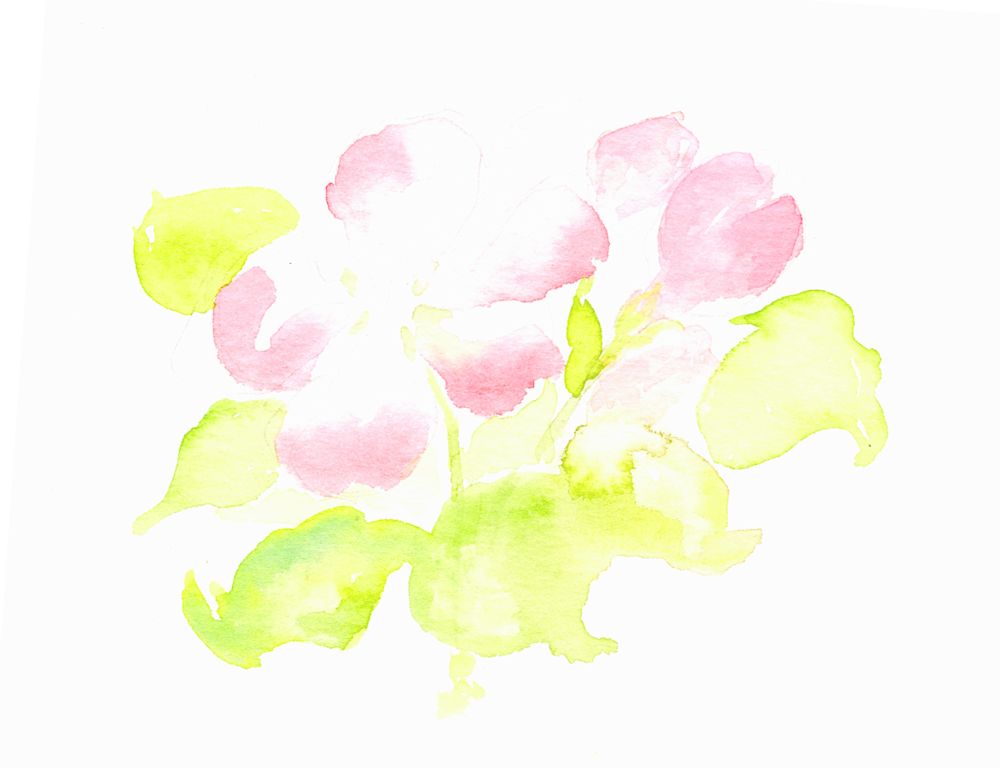
This was allowed to dry before dampening large areas of the sketch and dropping in colour. the shapes were refined using a small brush while the paint was still wet. Washes were allowed over the leaves in places refining their shapes. This time I stopped before the whole thing got too heavy and finally added some very pale yellow at the flower centre and a couple of pencil marks to indicate stamens. The result was lively and playful rather than accurate reflecting the joy apple blossom brings.
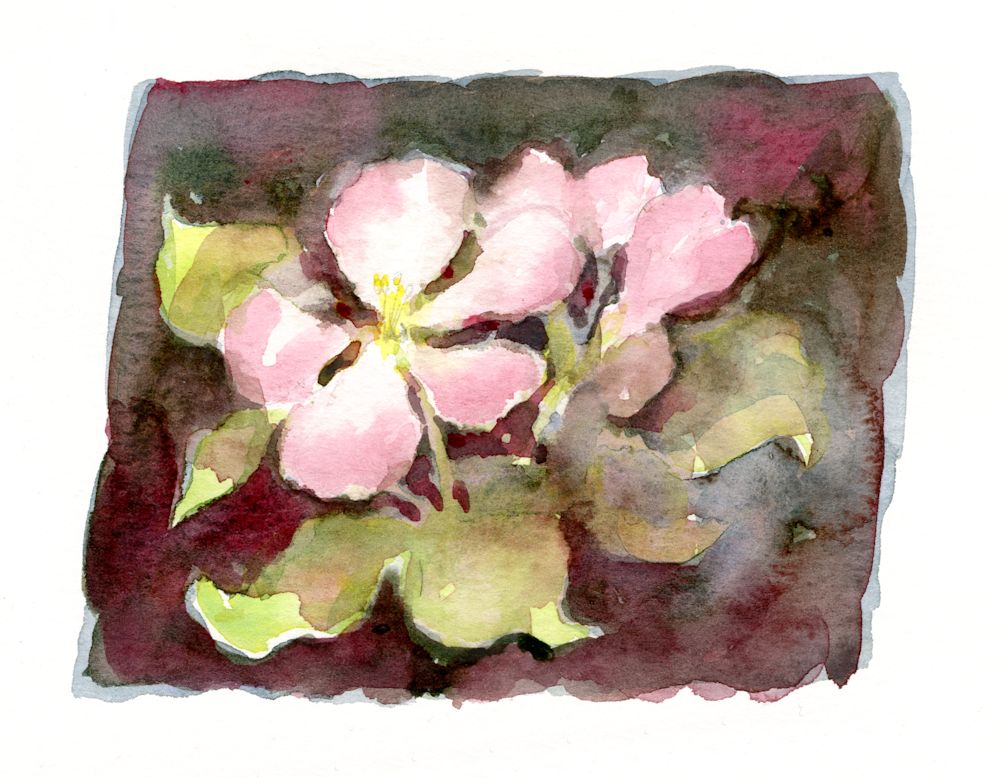
The point is that the background can often determine the mood of the painting and it is important that the way the subject is treated should be complemented by its background.
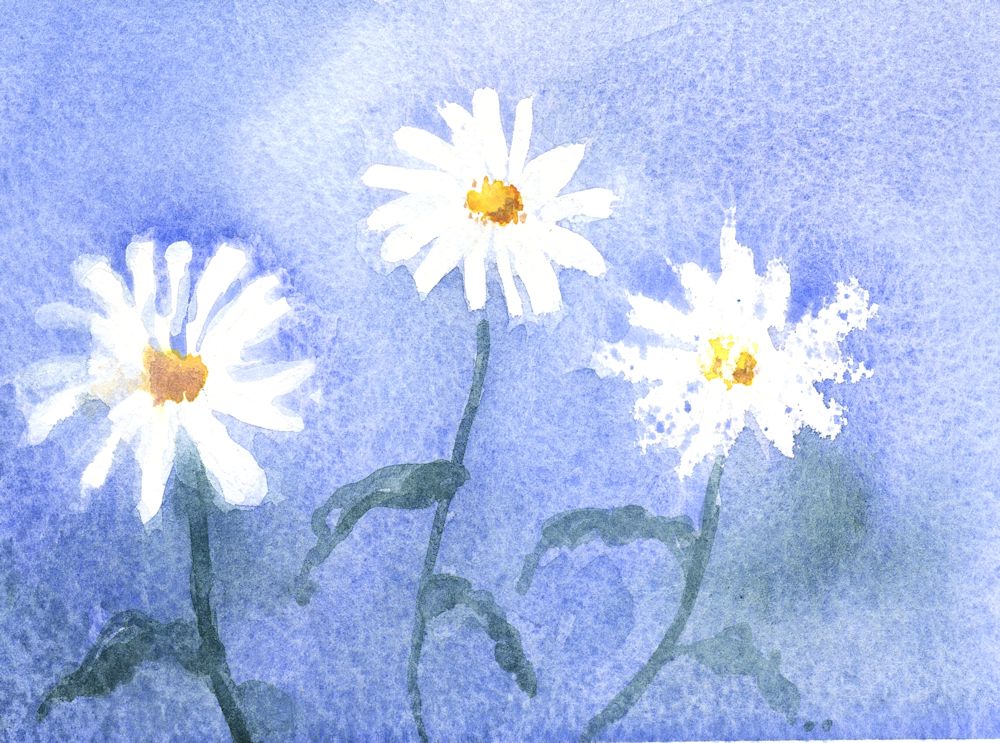
Left: painted around
Centre: masked
Right: wax resist
This week’s challenge is to paint pale or white flowers. Painting a background reveals the shapes of white flowers and is easier than painting pale blooms with no background. Colour, tone and how much to simplify backgrounds are all important factors to consider as well as deciding how free and loose you approach should be.
Inevitably you may question whether to mask or not to mask parts of the composition. Masking fluid can free you up to be more adventurous with the background but may make your flowers appear more graphic and less painterly. Painting around the subject may make you simplify more than was the original intention but that is not always a bad thing.
At the end of the day the only way is to experiment.
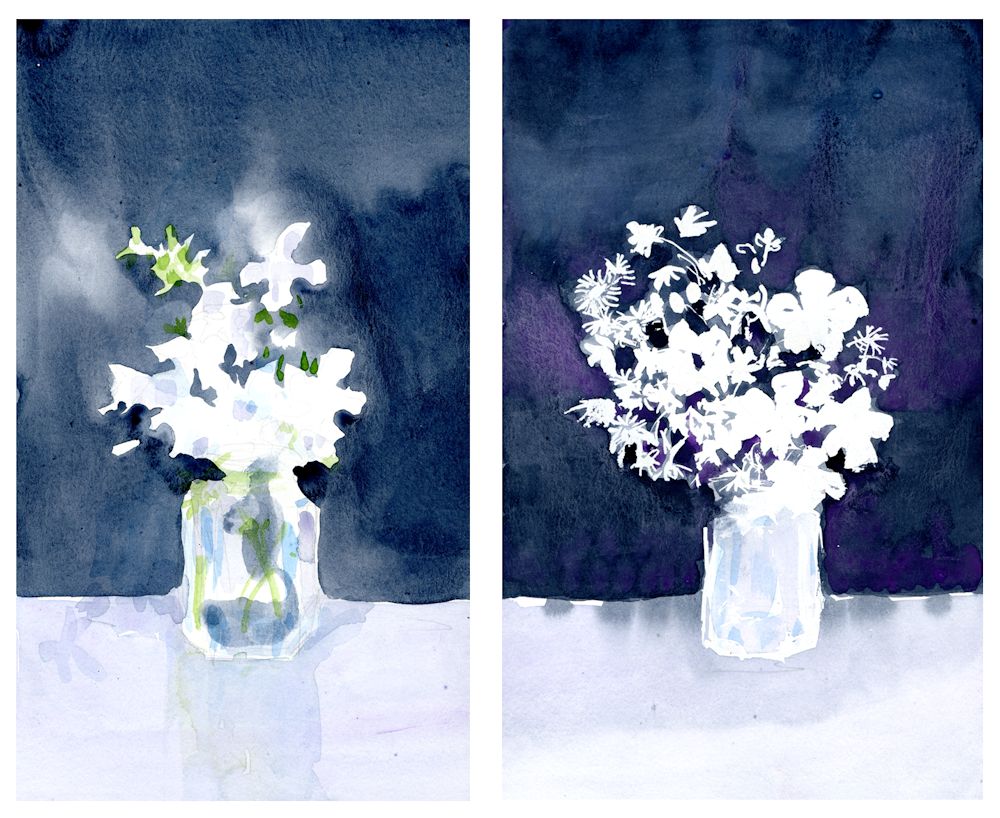
Left: background painted around the flowers
Right: masking fluid used on the flowers and the jar
The study on the left was of the same jam jar of flowers as on the right. The objects are more simplified and less accurate. Hints of colour have already been added.
The study on the right was carefully masked with masking fluid and washes applied when the masking had dried. Because the background was applied more uniformly and quite dark every detail of the marks made with the masking fluid are visible giving it a much more graphic quality. I was quite pleased with both and had I developed them further would have ended up with two paintings of the same subject but with a very different feel to to them.
Some more ideas for painting white or pale flowers can be found on my Pinterest Board, Link below:
https://www.pinterest.co.uk/jhall1282/flower-painting-in-watercolour/white-and-pale-flowers/
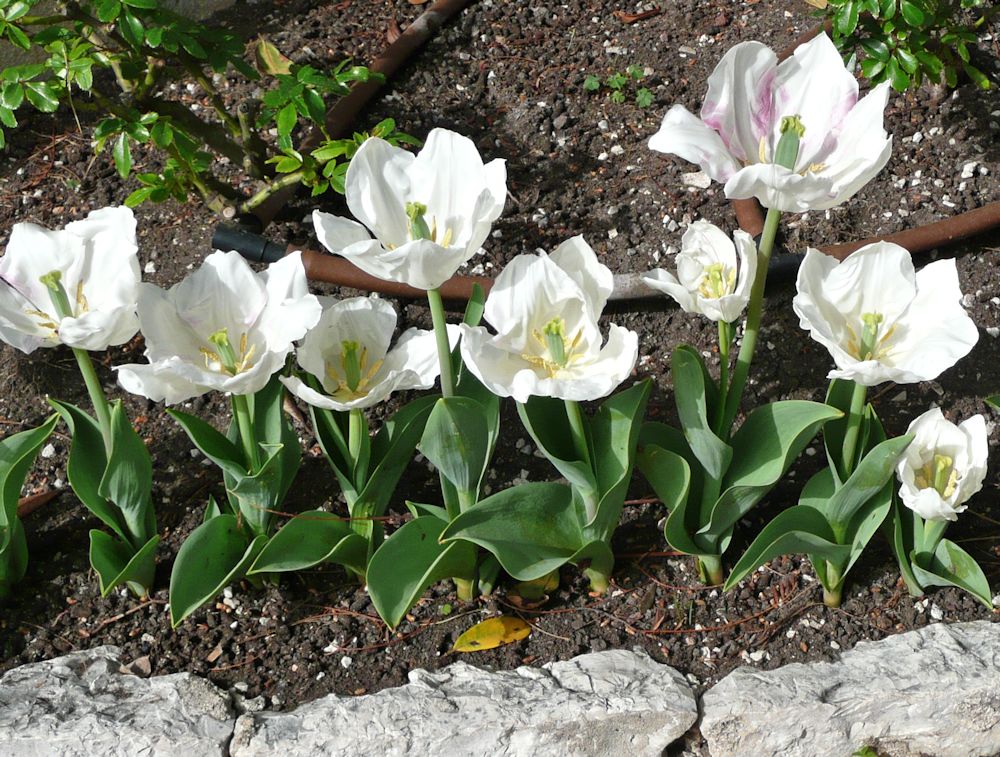
Photo by Jo
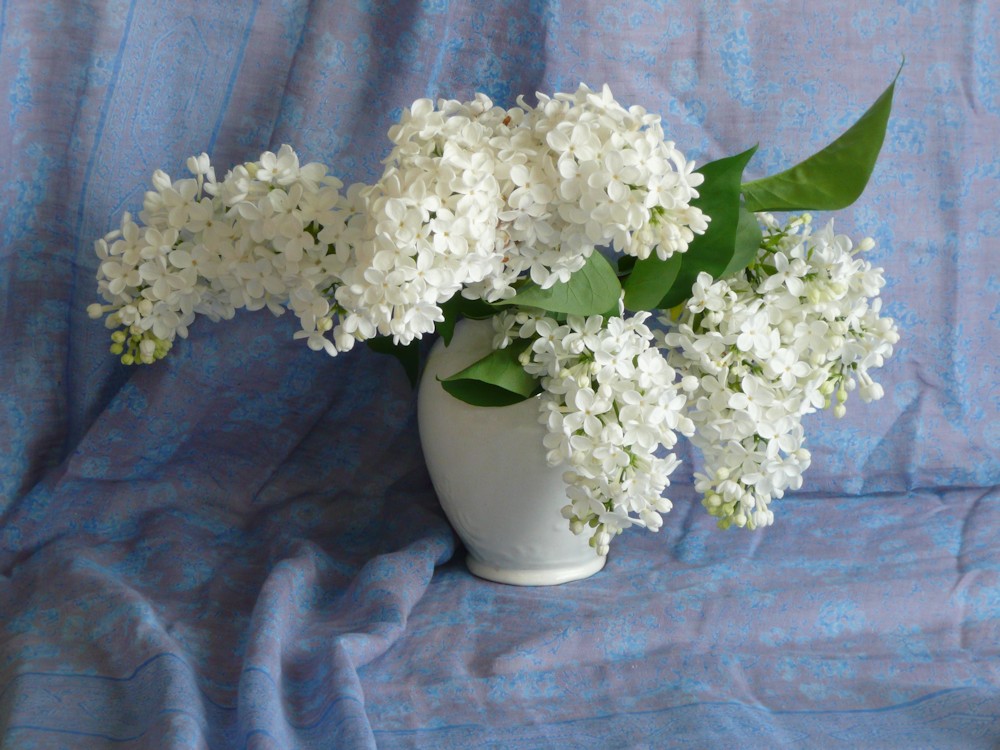
Photo by Jo
So first find some white flowers for the session and we’ll investigate ways to paint them in a way that has enough structure but still feels free and lively.
Your Paintings;
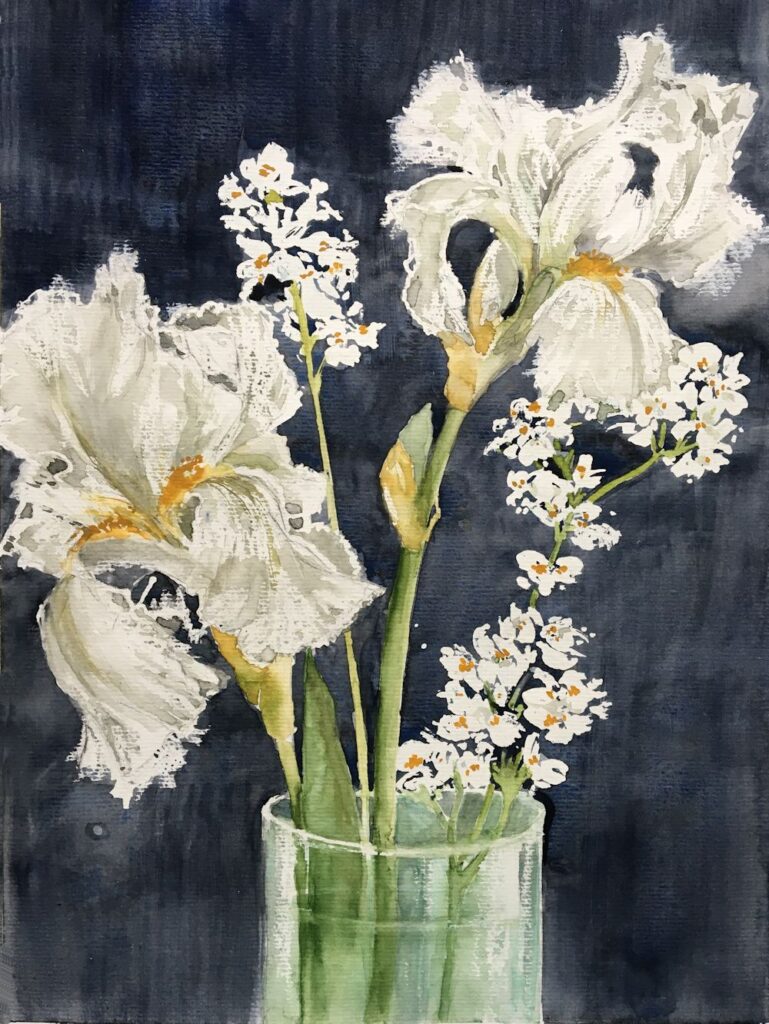
by Maryon
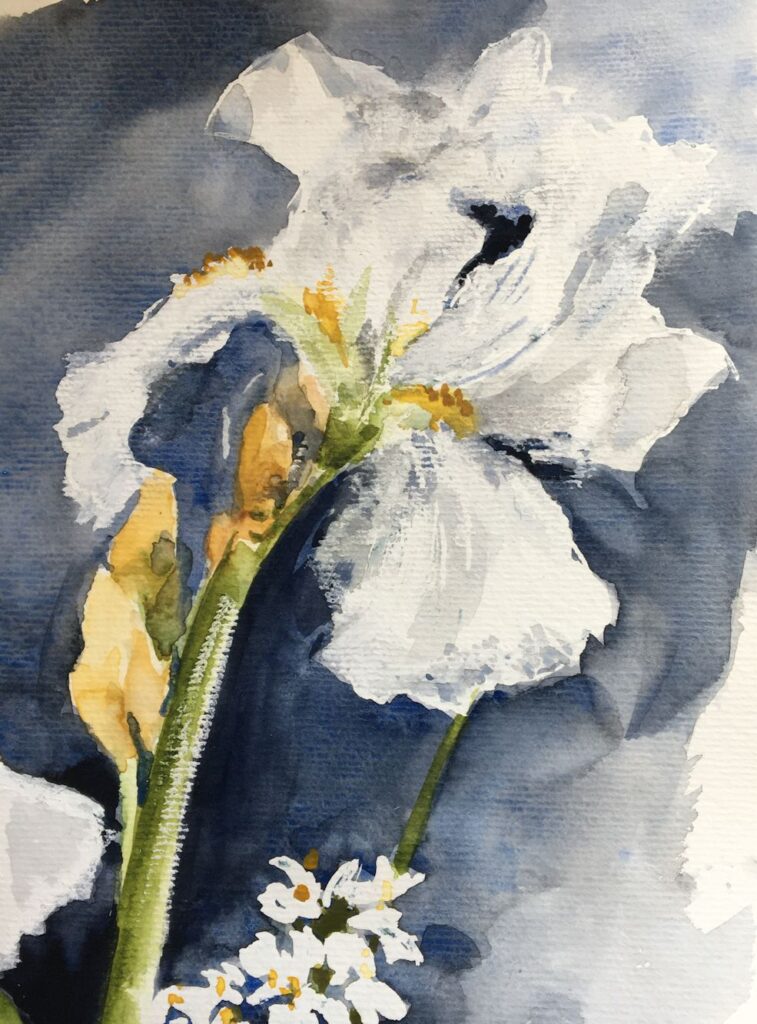
by Maryon
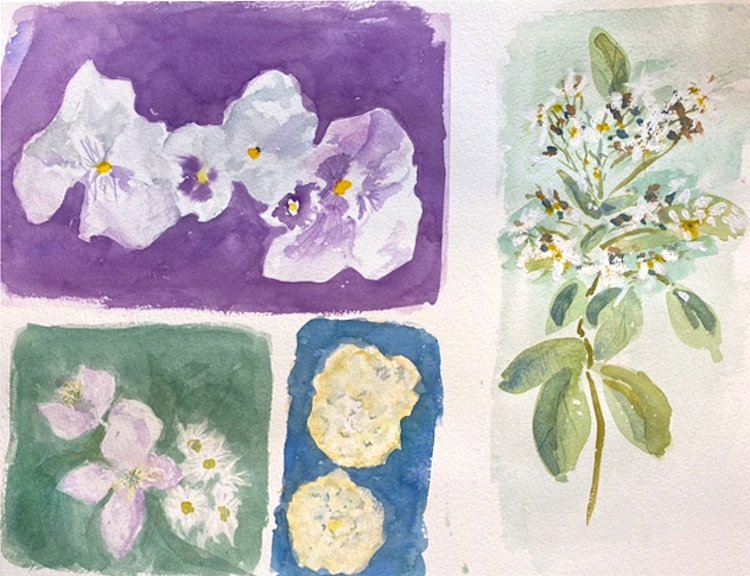
by Sandra
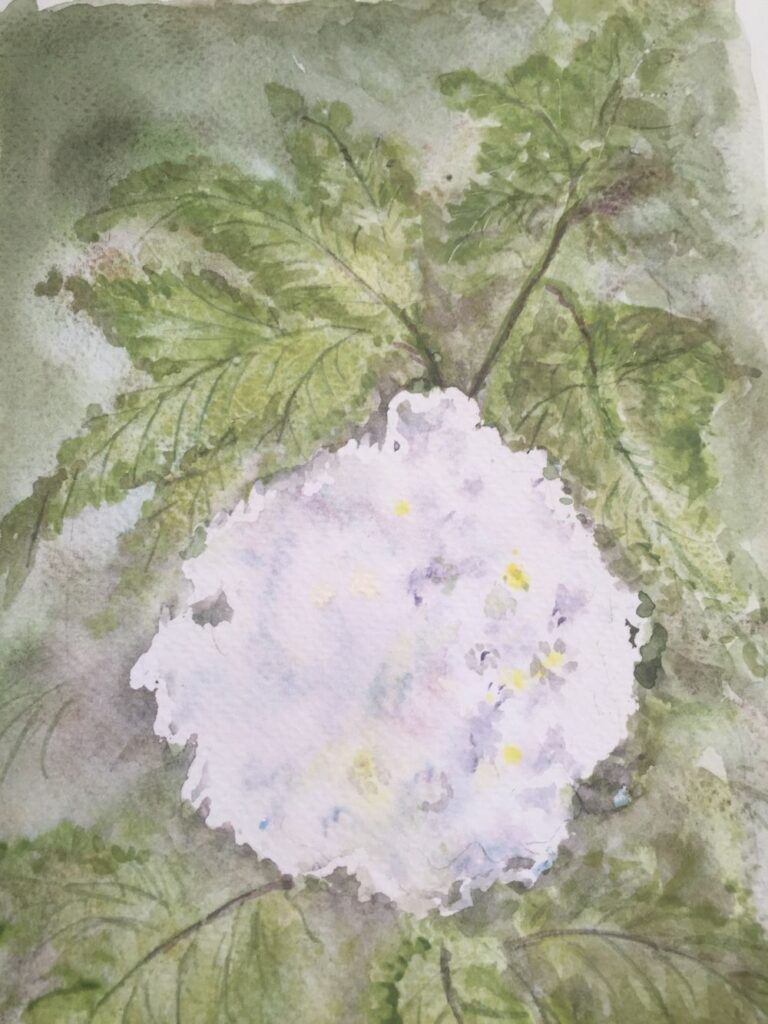
by Ann
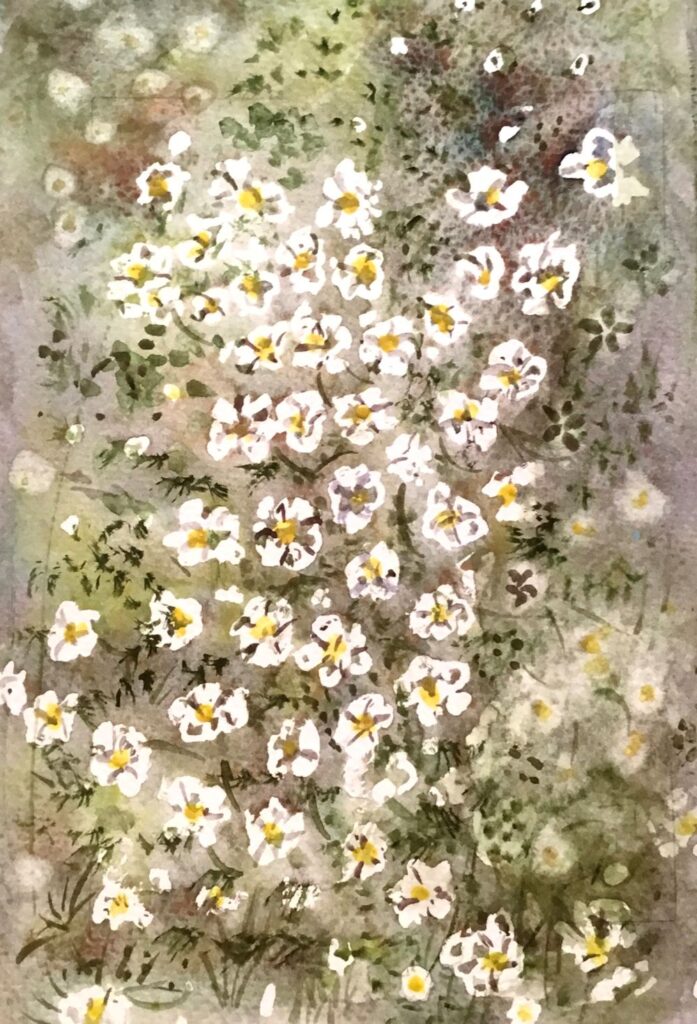
by Ann
Flowers masked before painting the wet in wet background
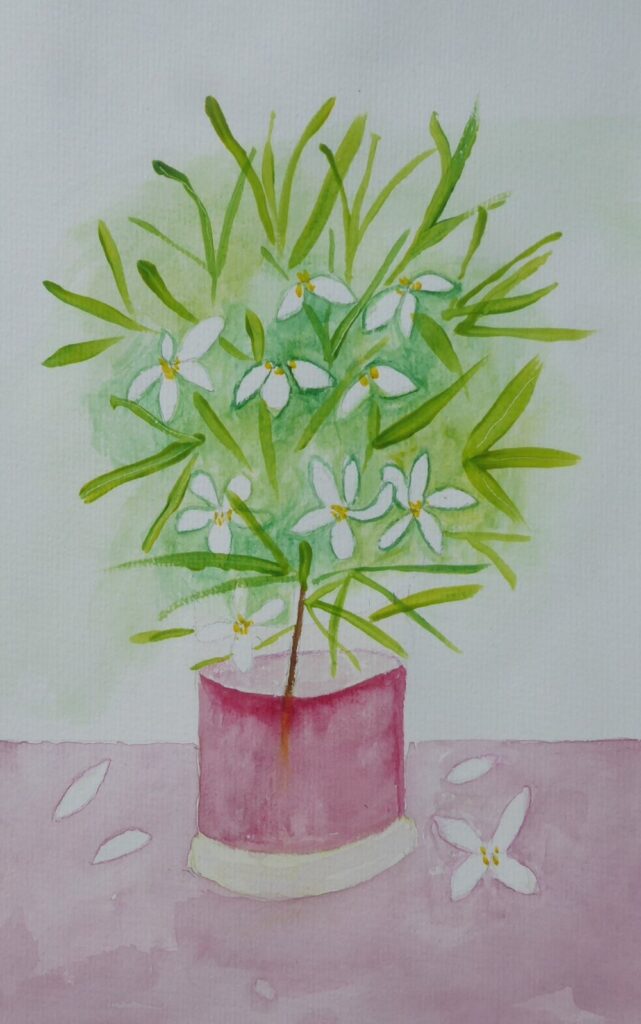
by Anne
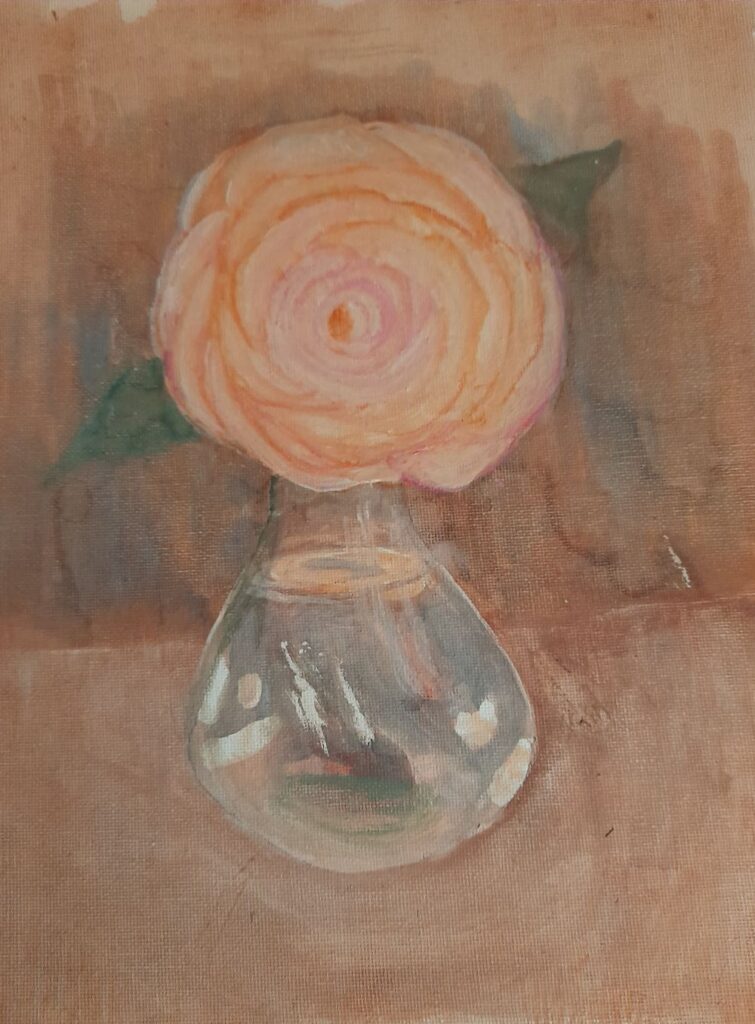
by Kate
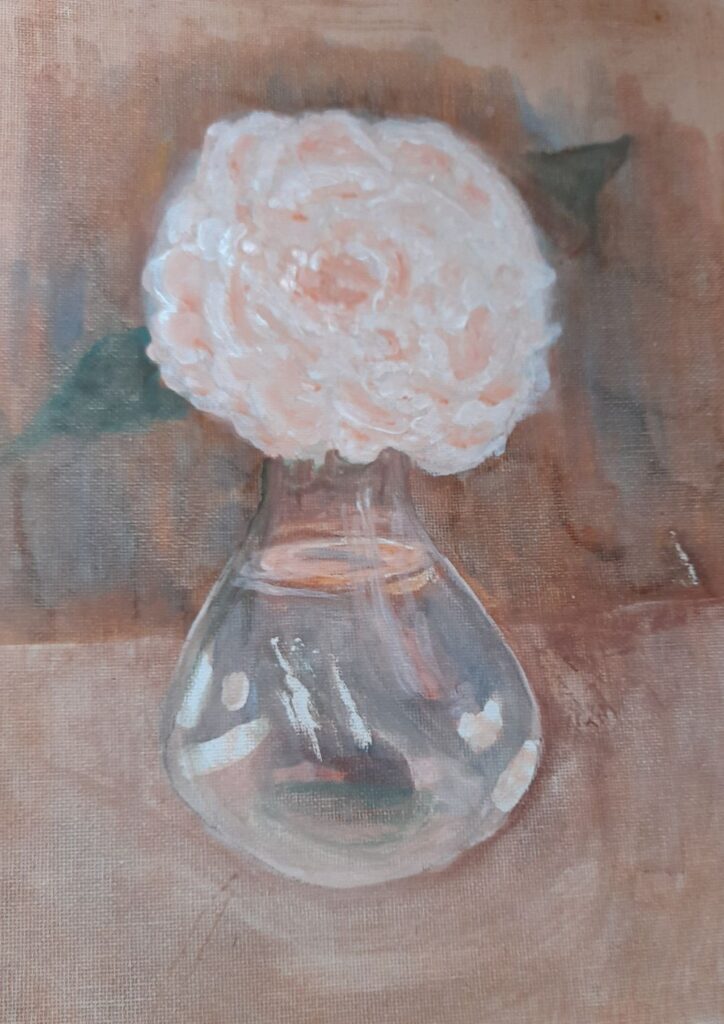
by Kate
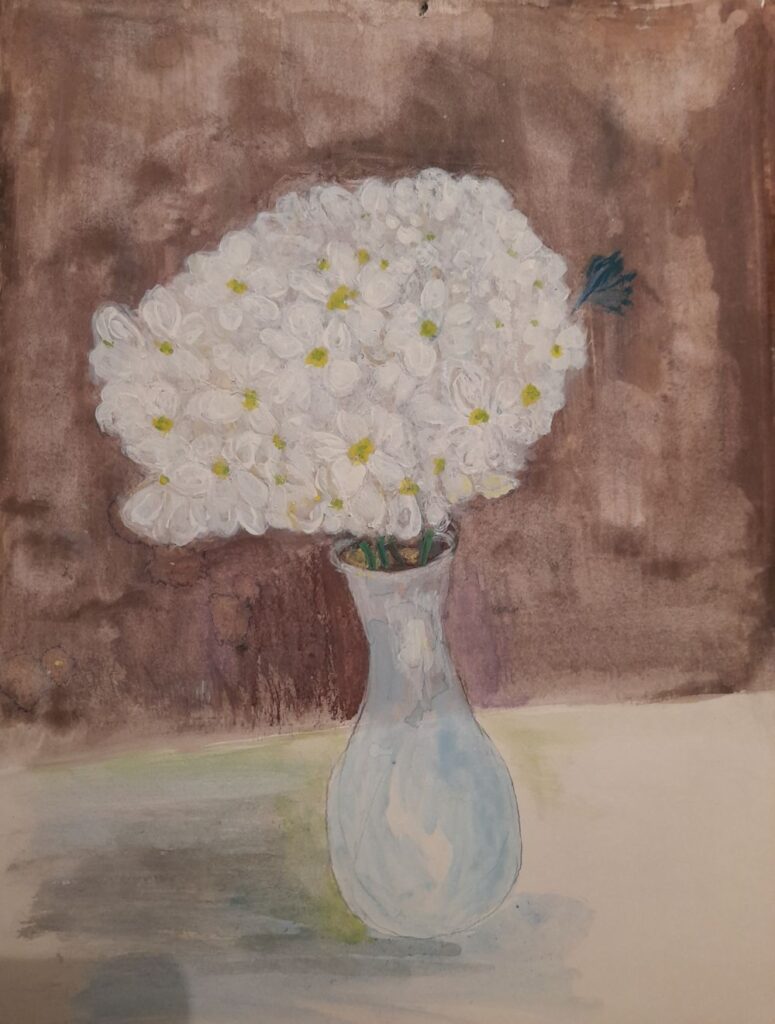
by Kate
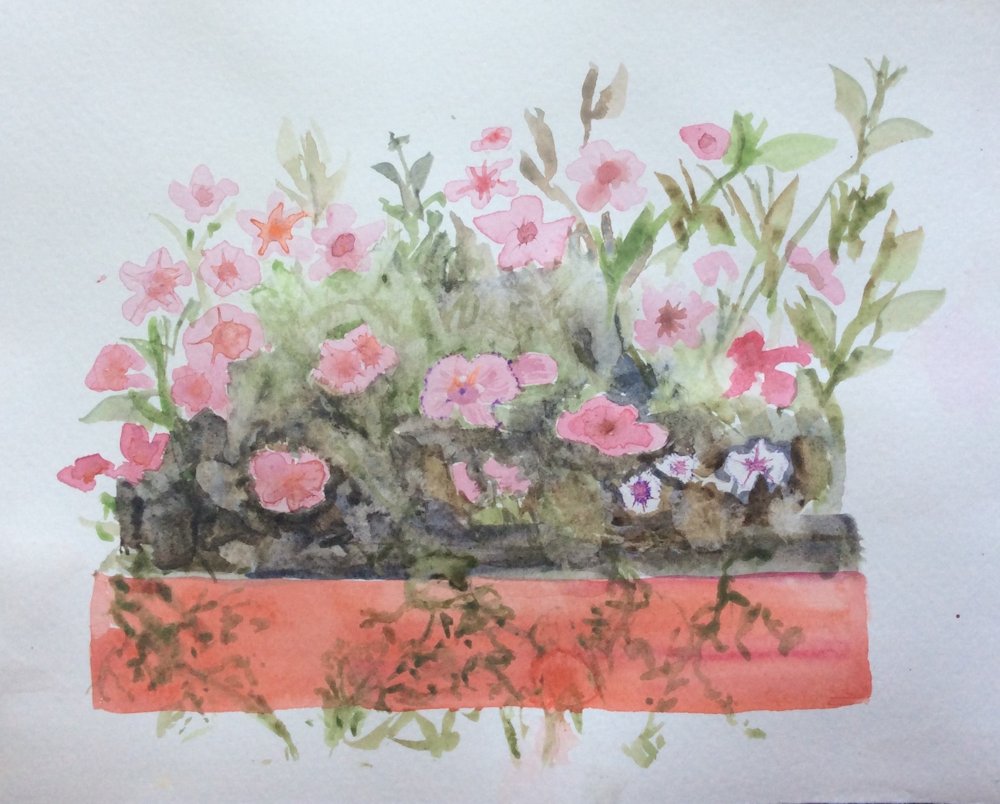
by Virginia
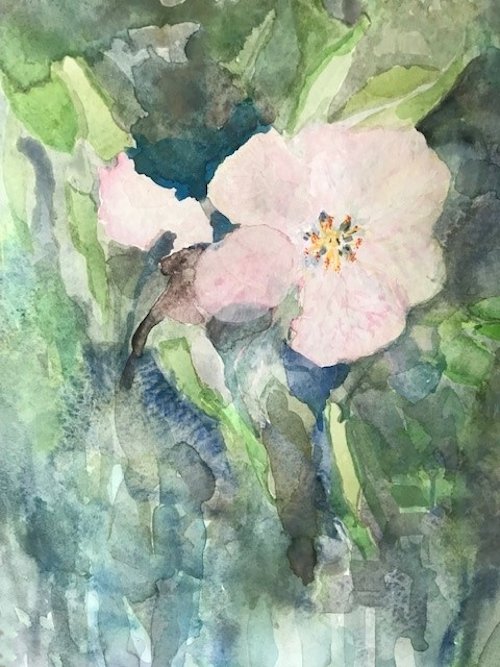
by Virginia
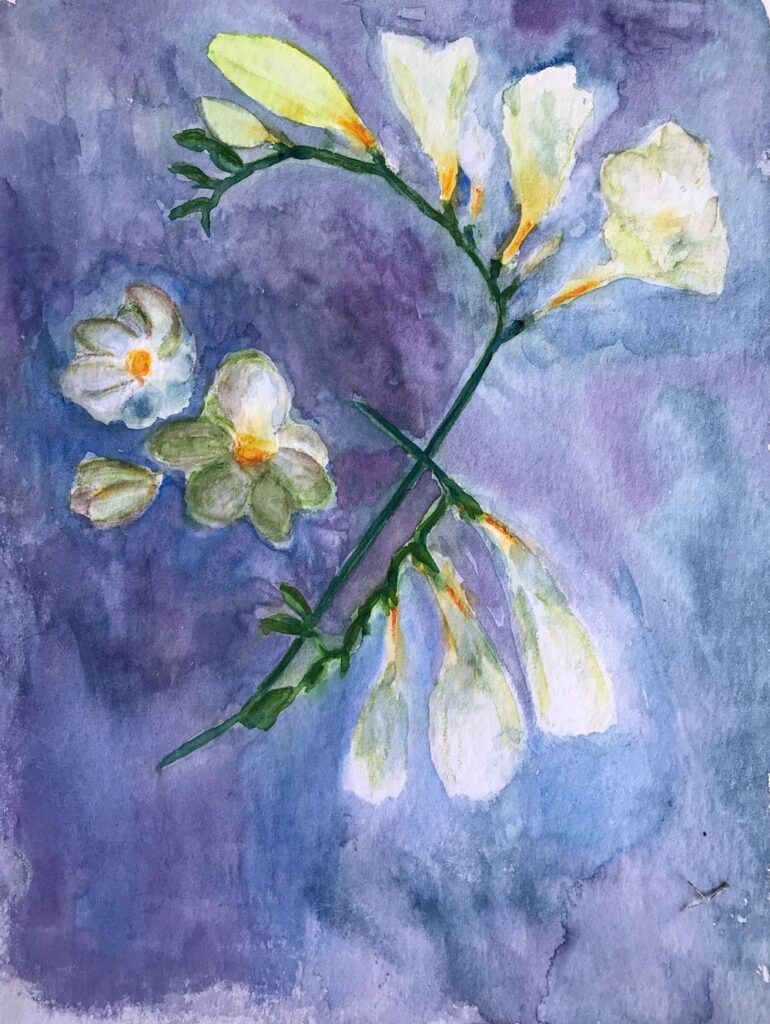
by Mali
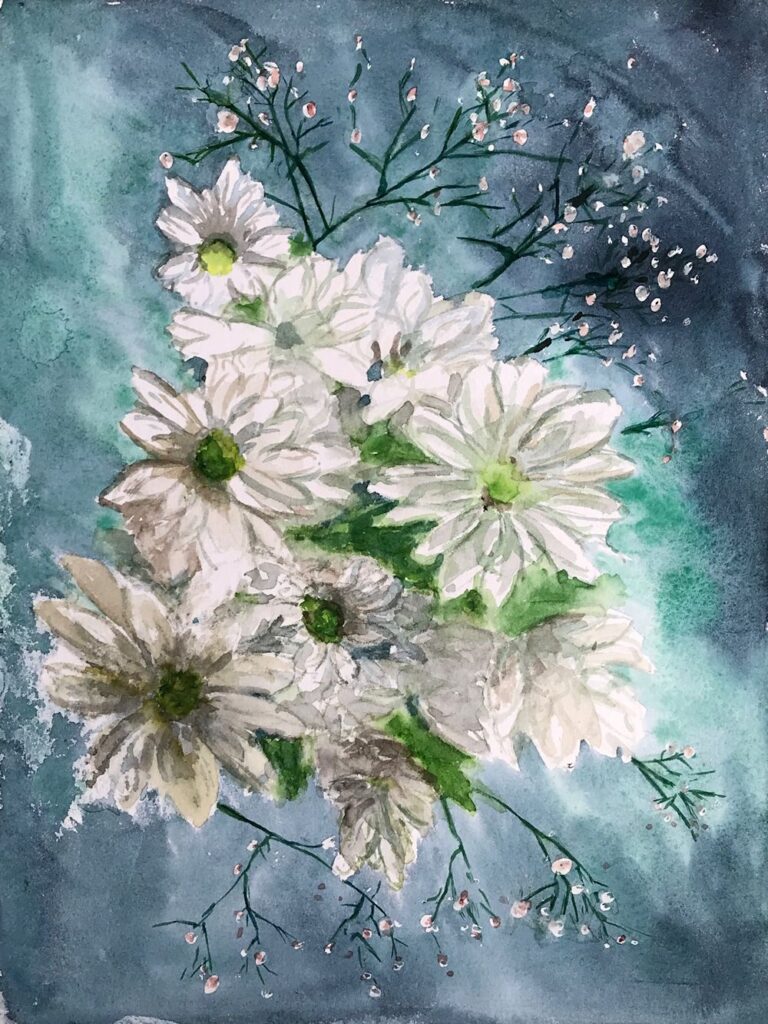
by Mali
Watercolour Flowers a Free Approach: Week 1
April 27, 2022
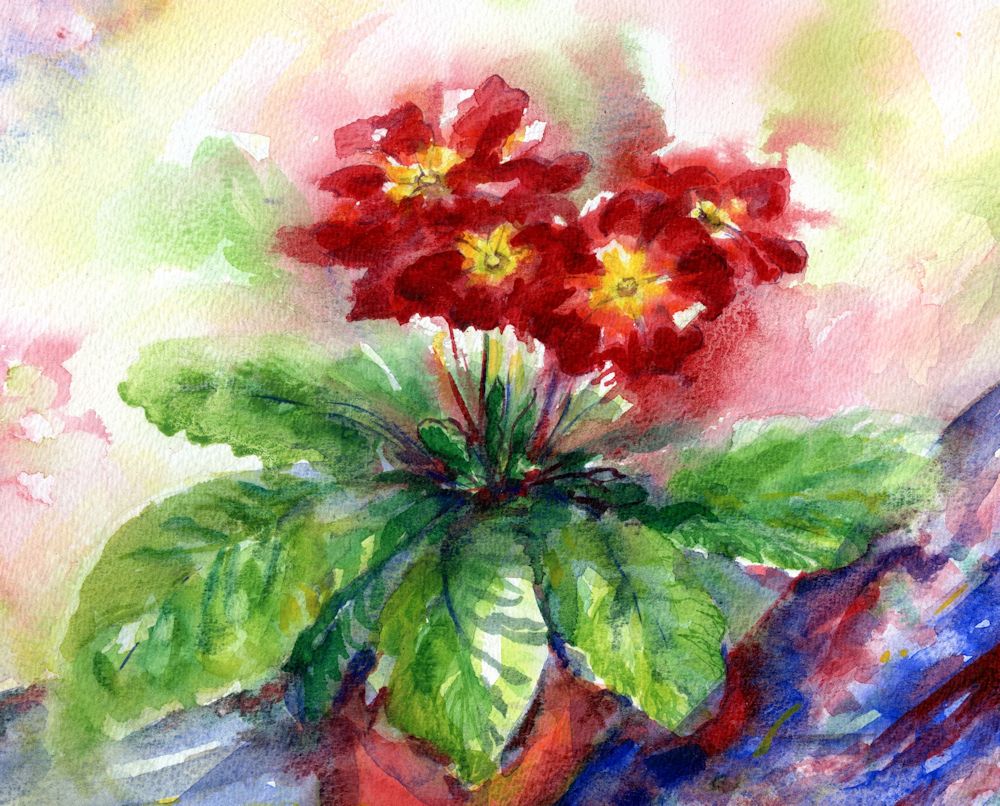
Wet in wet followed by dropping in more colour as the paint slowly dried. Final brush strokes applied when dry.
In this course the challenge will be to paint flowers freely in watercolour, using the brush for shapes and some really wet washes. Any under drawing in pencil will be kept to a minimum and the aim is to create some very expressive flower paintings rather than botanical illustrations.
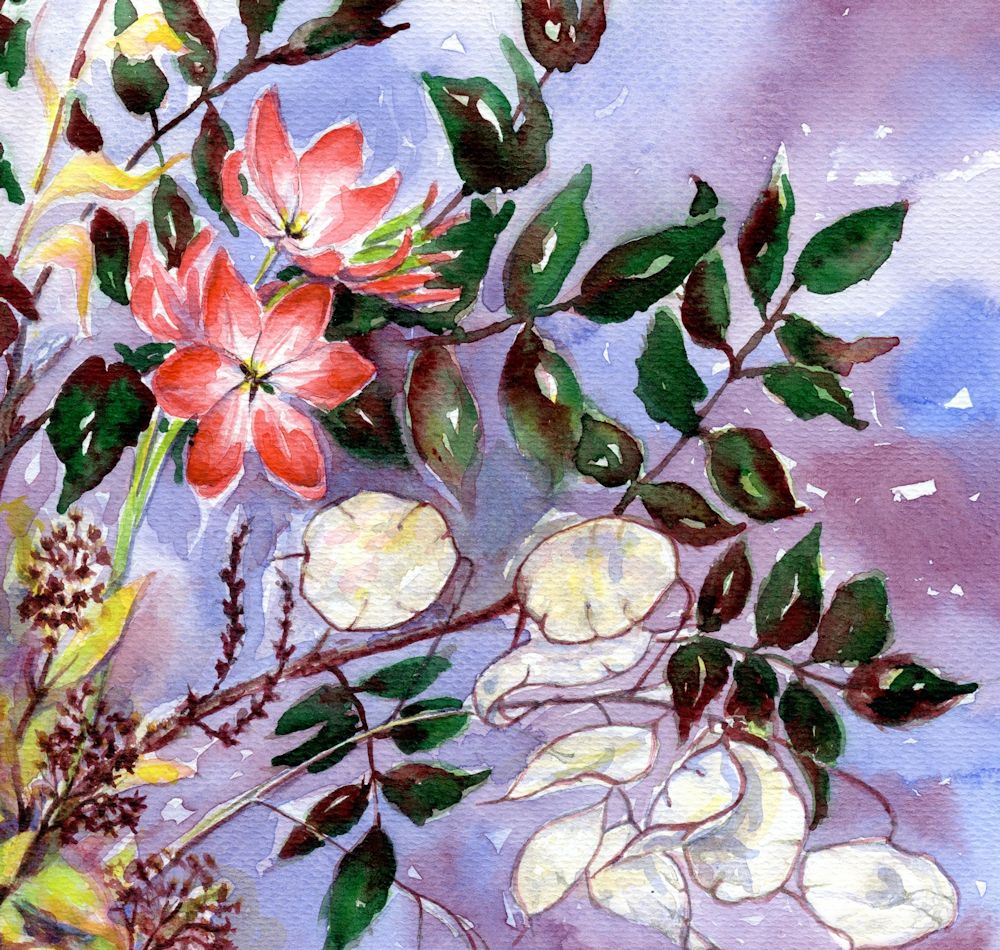
The first two weeks will be spent on gaining confidence in drawing with the brush, suggesting plant structures with different brush strokes, applying washes either to to fill shapes or to paint around shapes. There will be a lot of dropping colours into wet paint or water and finding ways of controlling very wet washes and/or coping with and taking advantage of some of the happy accidents that occur on the way.
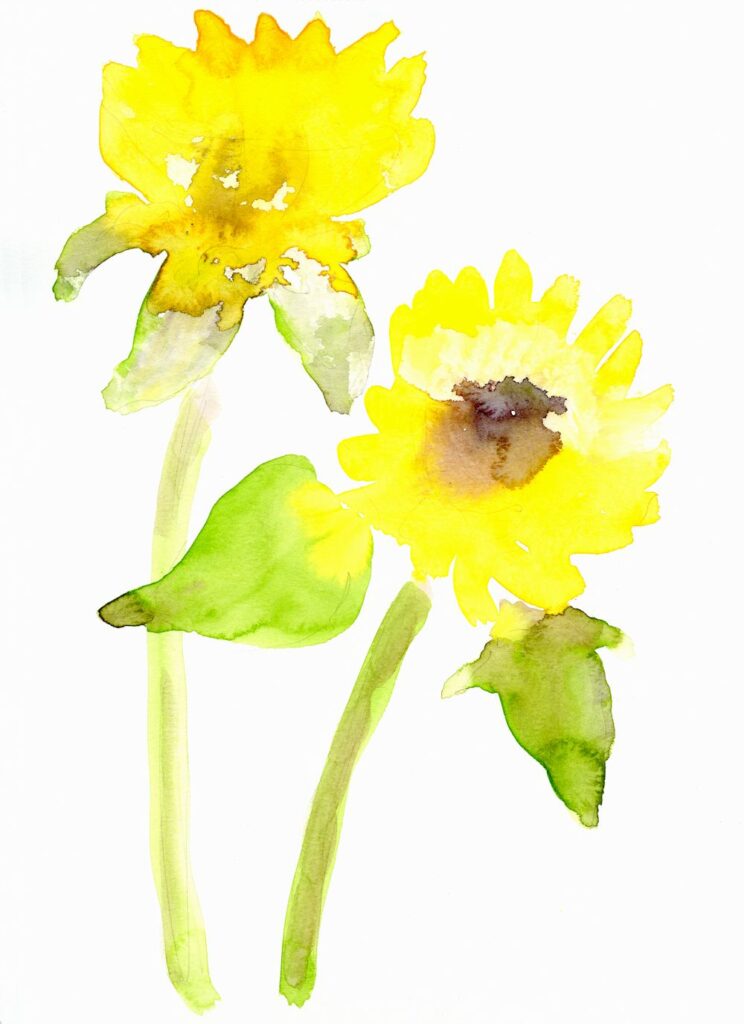
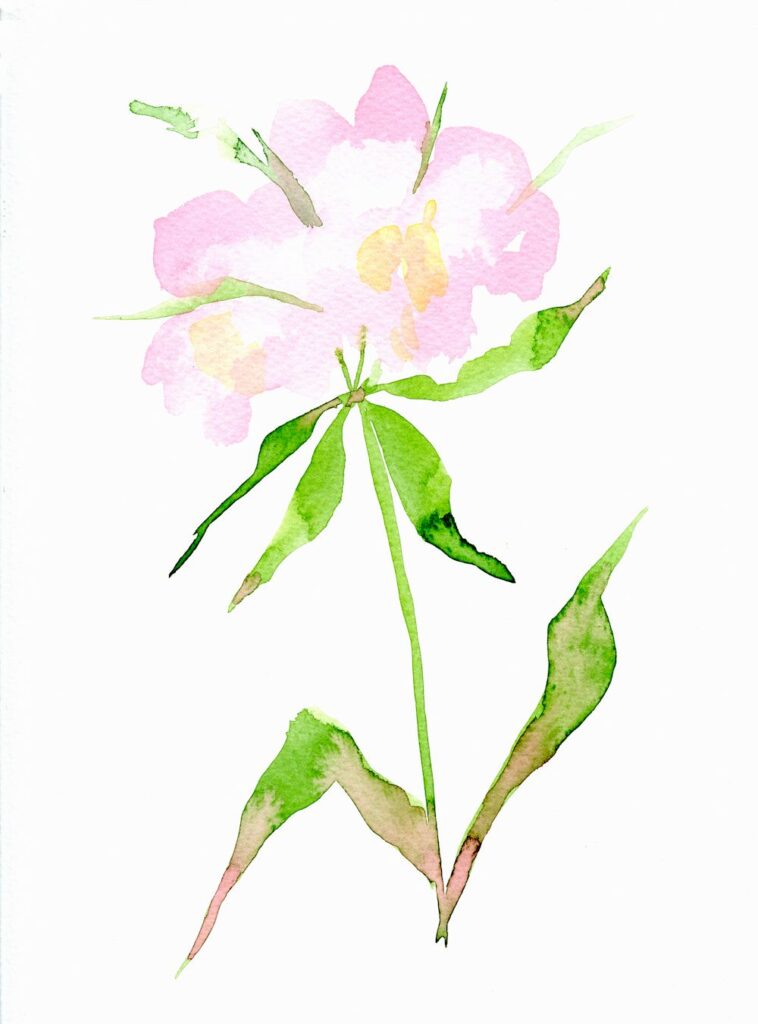
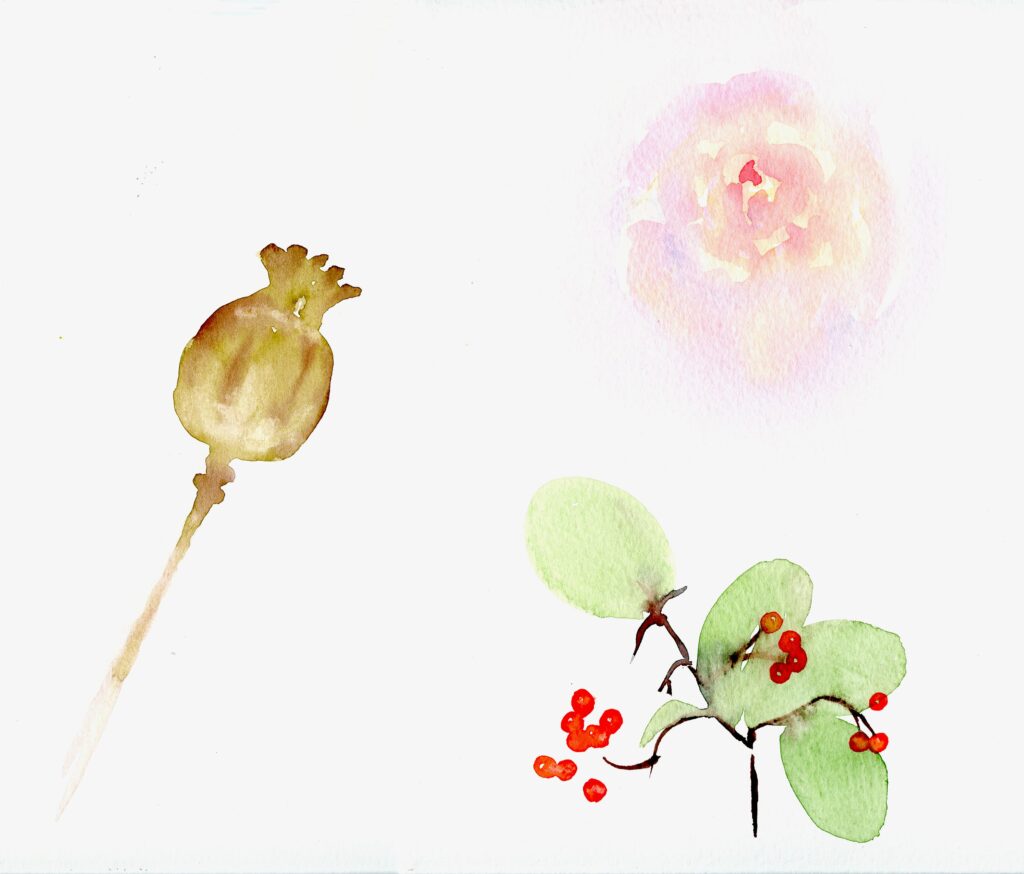
Bottom: leaves “printed on with a large round brush, brown stem/twig painted while the leaves were a little damp; berries added with the same small round brush when all was dry
Left: poppy seed head shape wetted with clear water, pale olive green added; brown dropped in when a little drier and pale parts lifted before all was completely dry
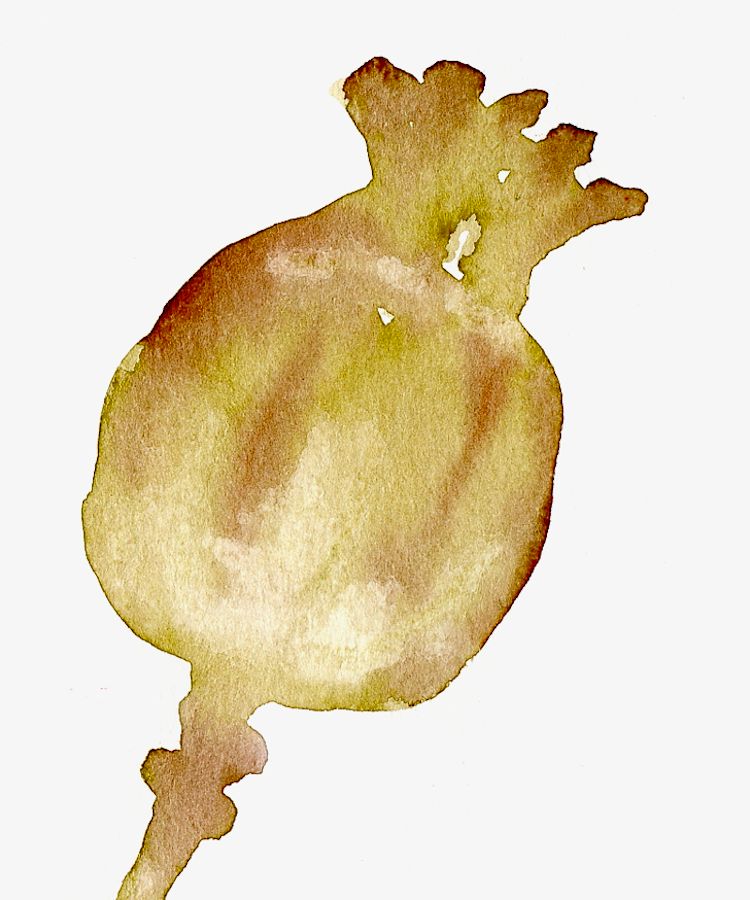
Complicated shapes may need a pencil guideline and we’ll practise filling shapes with water before flooding them with colour and also painting around shapes and making wet in wet backgrounds. This means it’s a good idea to think in advance about the overall composition, the colours you need and the tonal range. Keep the number of pigments you use low and experiment to find which mixes will suit the work best.
Your washes should be ready in sufficient quantity and in the concentration needed for the painting, before the first wash is delivered to the paper. Always mix stronger than you think you will need as the colours will often be added to wet paper and they dry paler than they appear when wet.
The execution may be quite fast and spontaneous but a bit of thought and planning ahead will be invaluable.
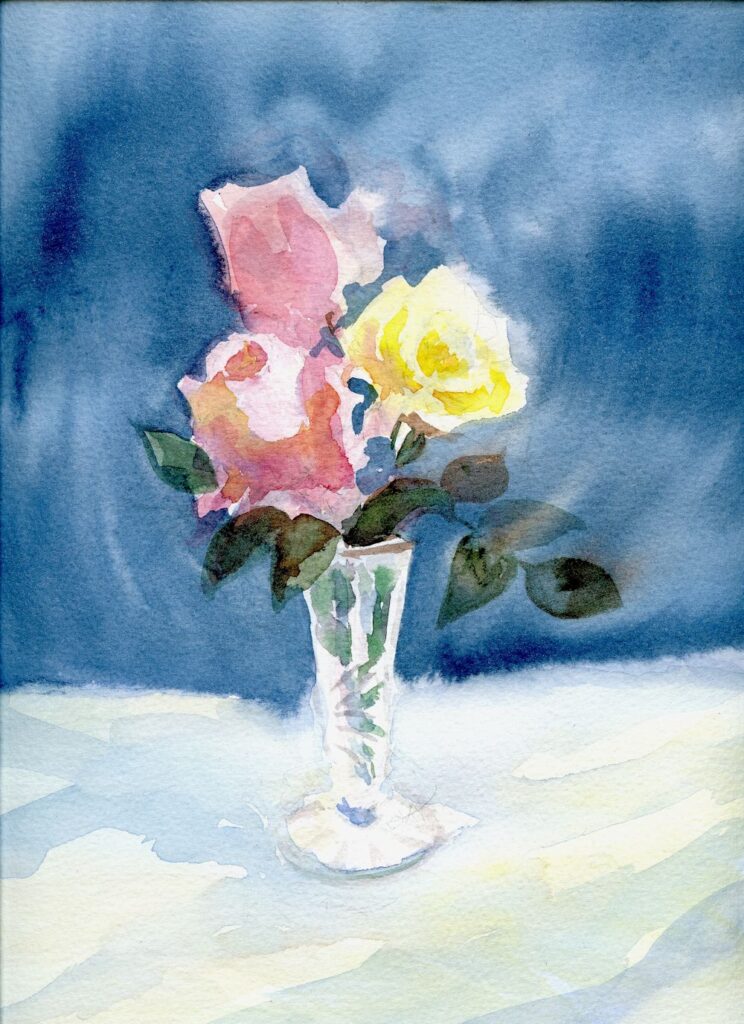
Think it’s finished?
The three artists chosen for inspiration have different styles and by no means limit themselves to flower painting. One can learn a lot from studying their work so I have put together a Pinterest Board, link below referencing their work and techniques so do have a look. Each artist has a section within this board.
https://www.pinterest.co.uk/jhall1282/flower-painting-techniques/
Trevor Waugh has a magical way of working with washes and has produced books on watercolour roses in conjunction with the RHS at Kew Gardens. Paul Riley‘s compositions of floral still life subjects are sometimes quite complicated, but a lot the techniques can be used in much simpler studies and one can learn a lot about drawing with the brush as well as working in broader wetter passages from his works. He enjoys using oriental brushes for linear work and mark making. I am sure many of you will know Shirley Trevena‘s imaginative compositions, rooted in observation but often with an unreal and exciting twist.
For this course it will be useful to have;
Brushes: One large round, one small round brush, a rigger brush and a flat (half inch or larger). If you have other kinds of brushes, great! They will all be useful.
Watercolour paper 300gsm or heavier: 300gsm will cockle a little when very wet so may be a good idea to stretch your paper or use a block for the more considered paintings but this is not necessary for the exercises.
A block to tilt your drawing board. This will be better than a table easel and we will be working flat some of the time and/or turning the paper round so this is much easier to arrange if a block of wood about six inches long and about 2 1/2 inches in cross section.
Watercolour paints and a palette with deep wells. If you intend to work large a daisy palette or a plastic bun tin palette will be useful, although for most purposes and up to A3 size I find my usual folding palette adequate. Tubes are easier than pans to work at a large scale and if using pans remember to flood your paintbox with water so the pans are moist and the colours can be lifted easily without scrubbing the pan with the brush. Some artists use a different hardy brush like an acrylic brush for lifting paint from pan to palette to lessen the wear on their watercolour brushes.
Also: water pots, paper towel, small natural sponge
A couple of flowers to inspire your brush marks and washes.
This first session we’ll make a lot of brush marks on to dry paper and on to paper that is damp or randomly spattered with water. When making these marks we will have flower structures in mind but the purpose will be to find ways of making marks and controlling washes that will give a lively and free way of expressing these forms in watercolour.
After the exercises an expressive study of your chosen flowers should be attempted. The exercises will be done in real time as they are demonstrated at the class session. Hope the illustrations will give you a few ideas for the session.
Your Paintings;
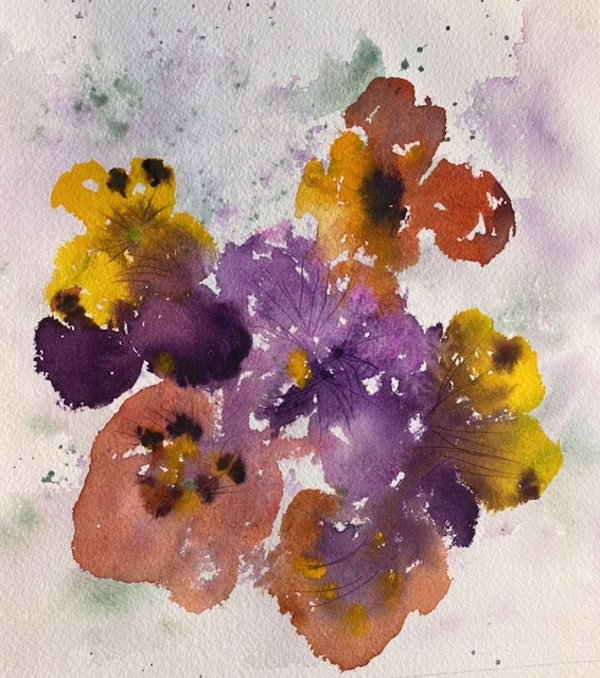
by Sandra
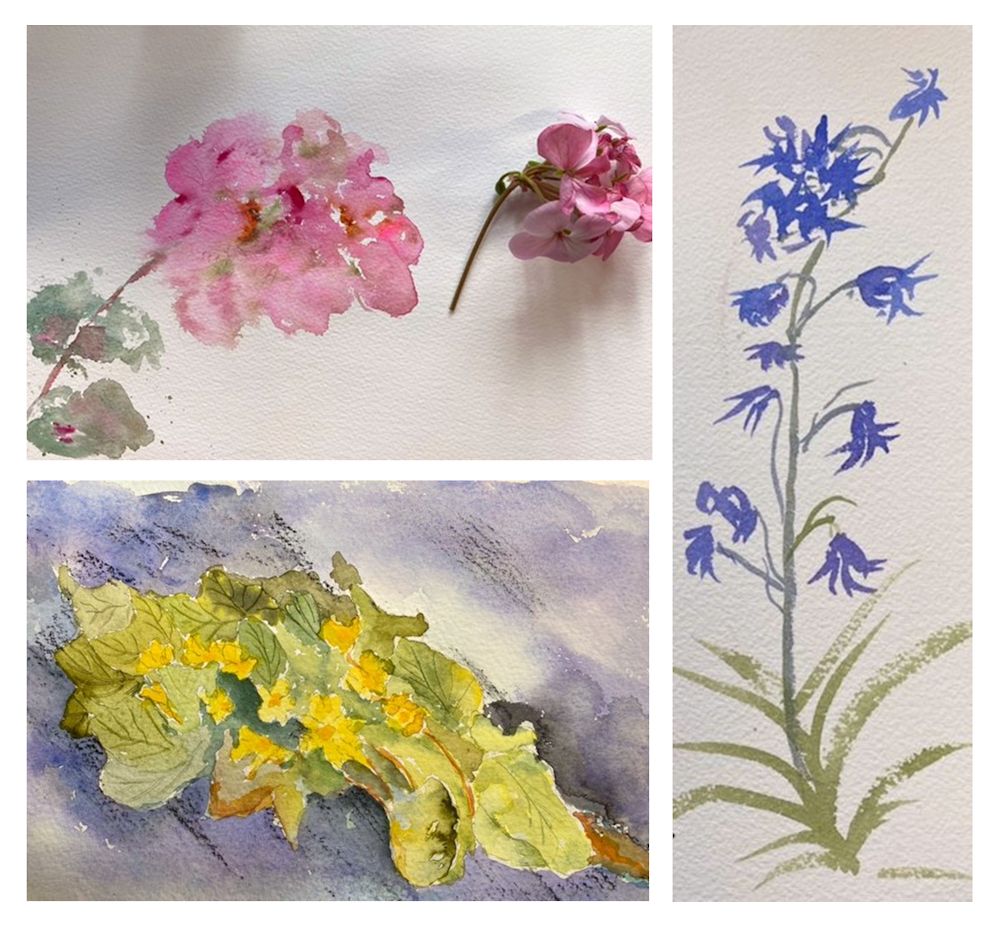
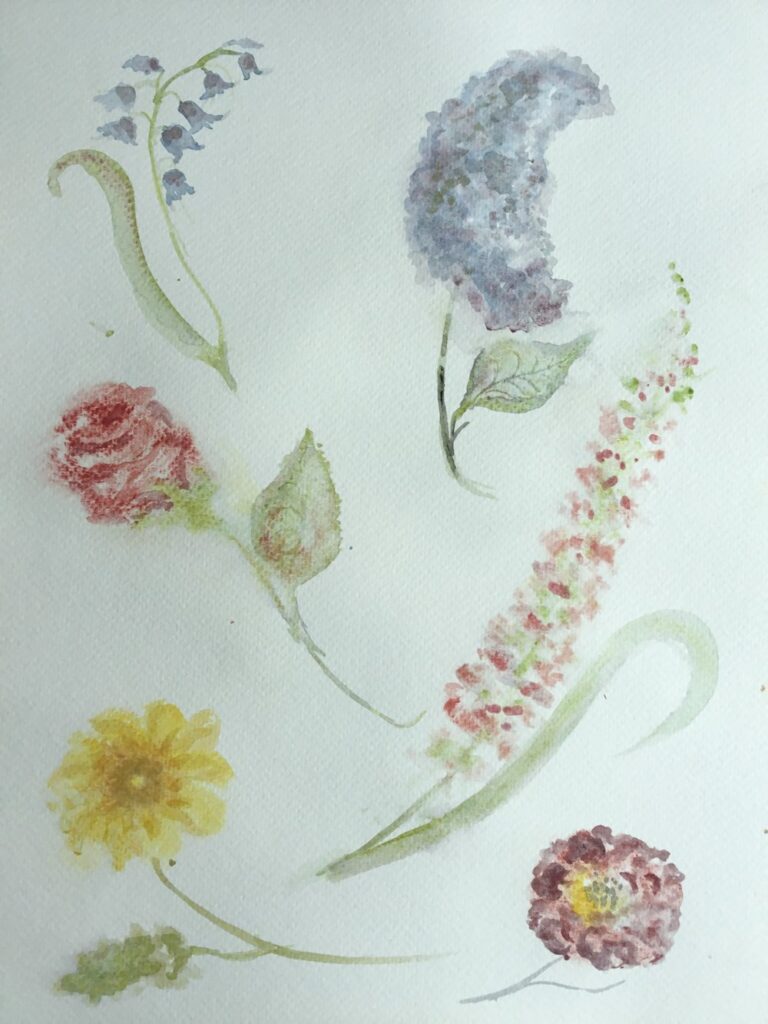
by Ann
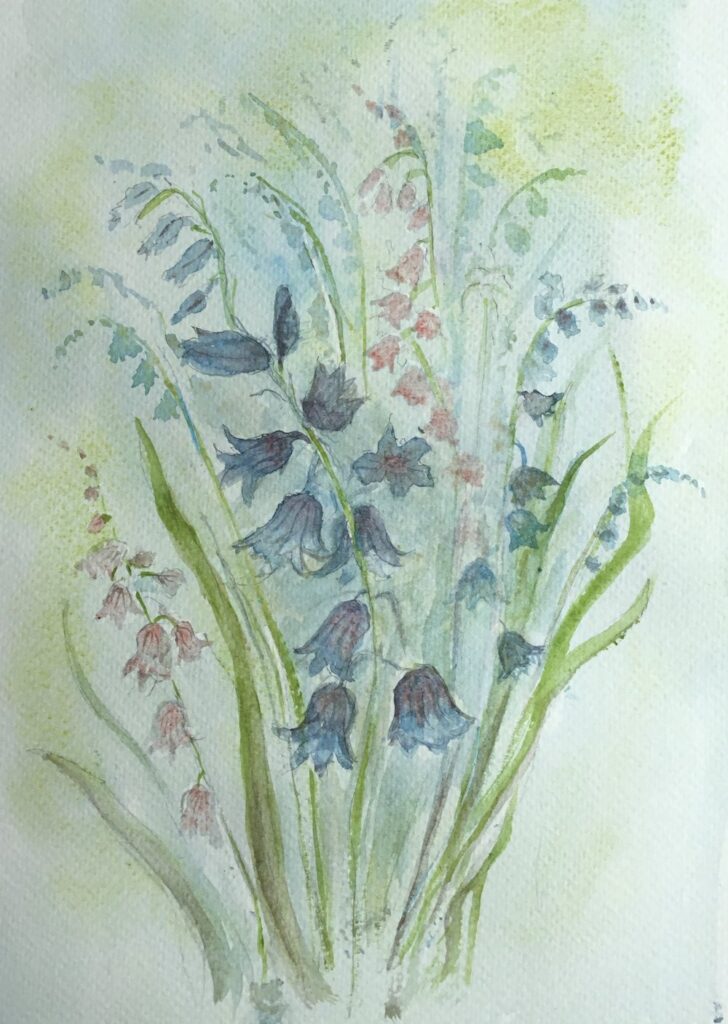
by Ann
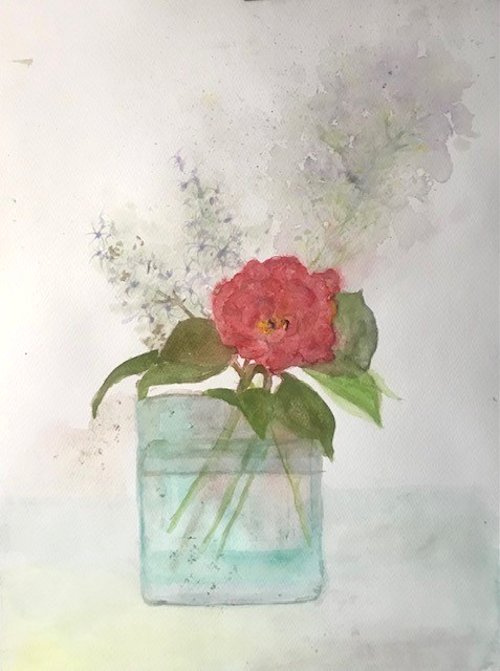
Watercolour painted wet on dry by Virginia
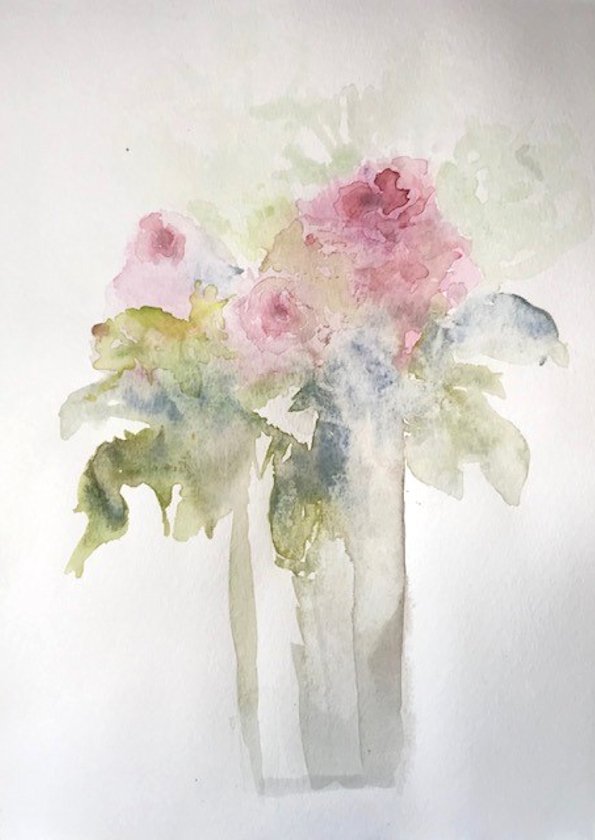
Watercolour painted wet in wet by Virginia
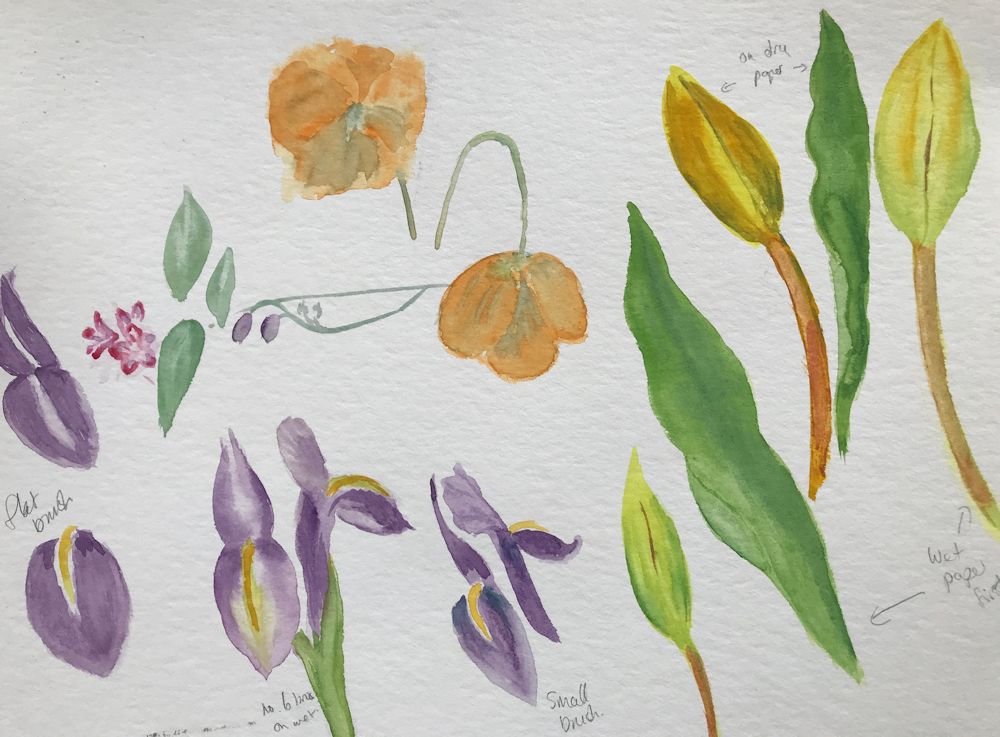
by Mali
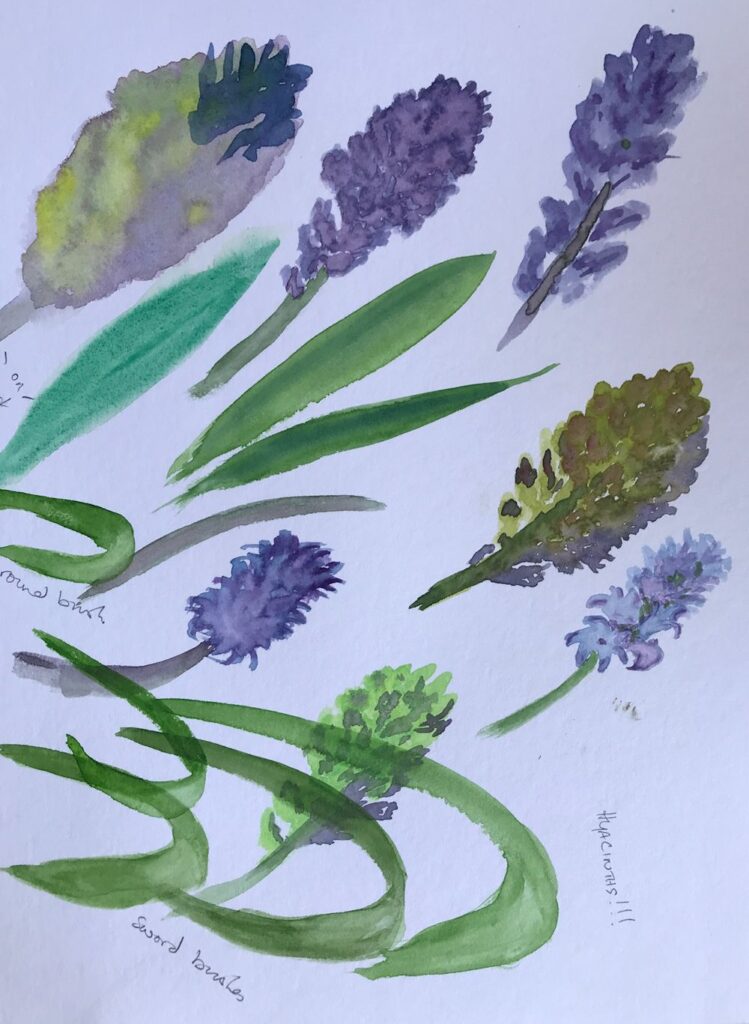
by Mali
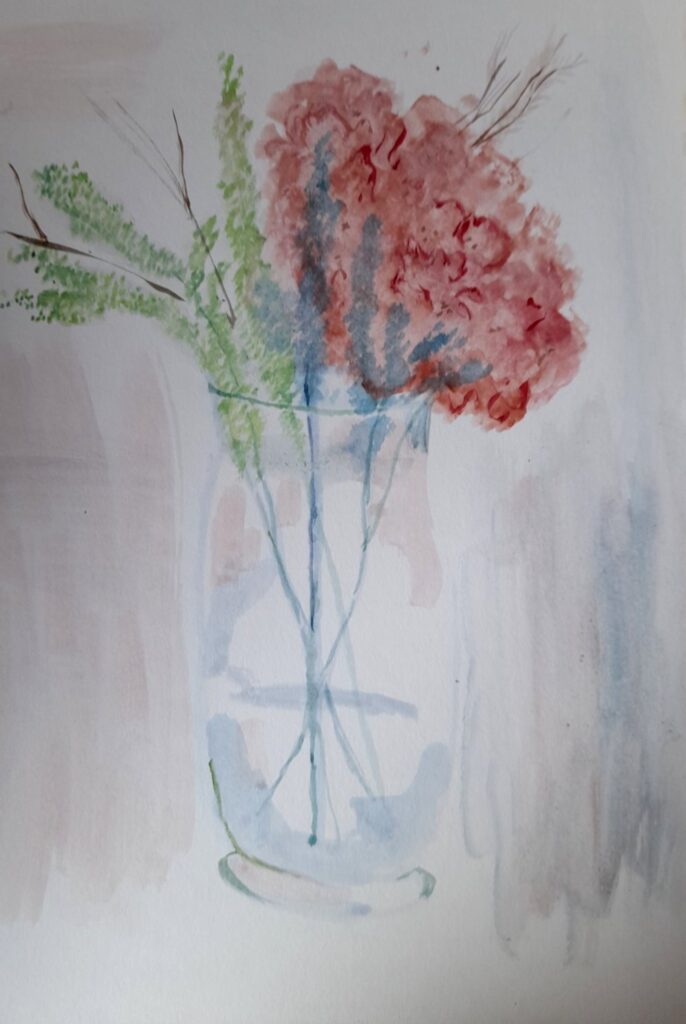
Watercolour by Kate
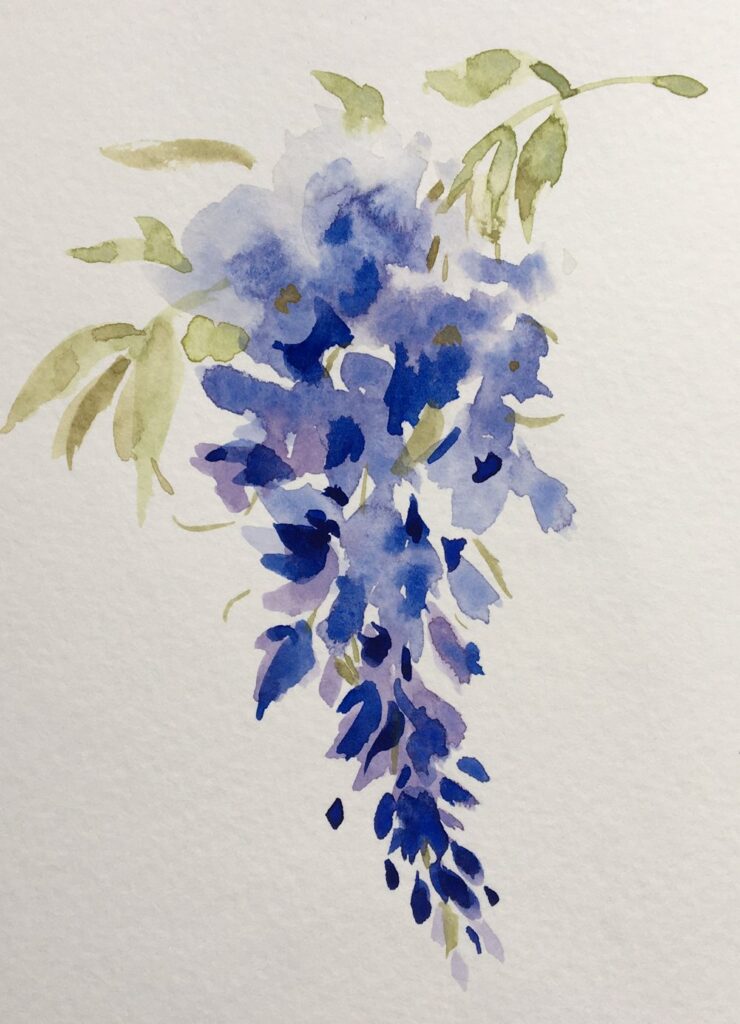
by Maryon
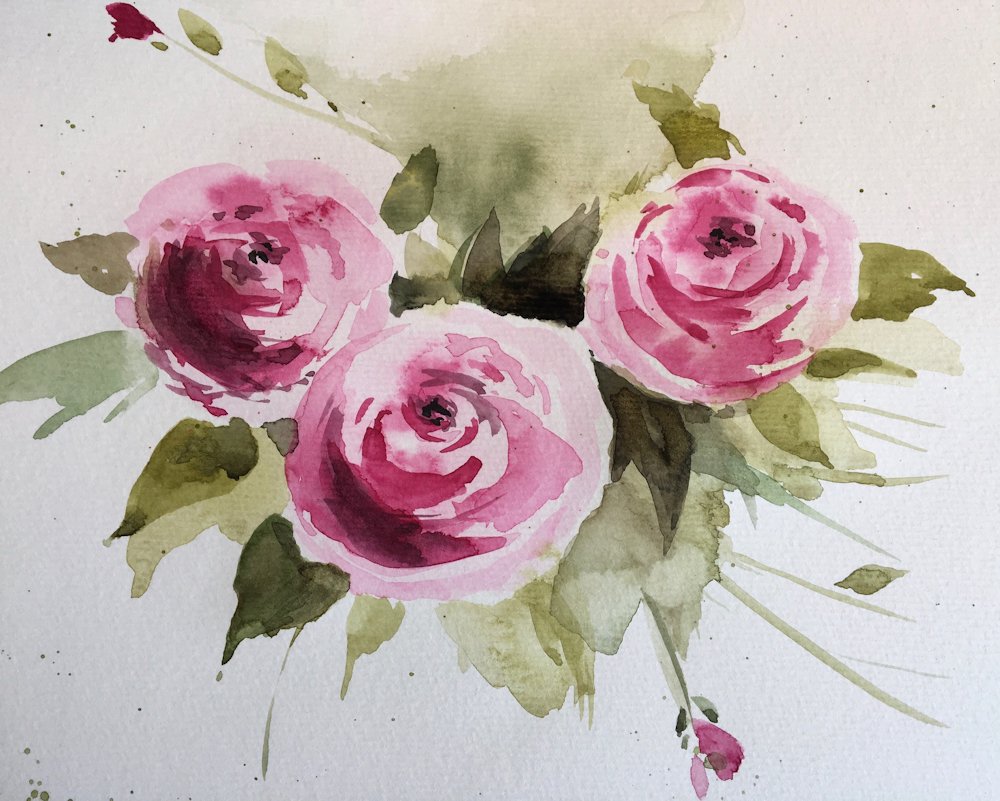
by Maryon
Drawing Trees Week 6: In Open Countryside
March 30, 2022
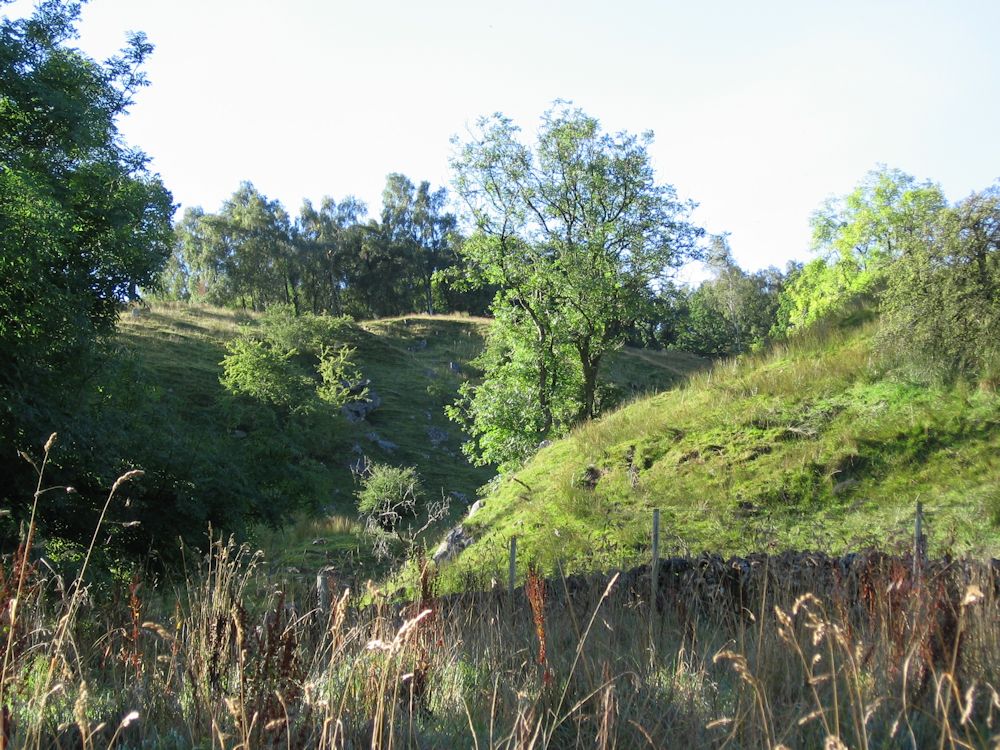
Photo by Jo
This week we are painting trees from a distance, perhaps a view from a window or from the ridge of a hill looking down on a wooded valley. Instead of being in a wood we are out in the open, looking down or up, to a wooded area or group of trees. The sides of the hills in the photo above are well grazed by sheep and the group of tall ash trees takes centre stage.
The challenge this week is to make a painting of trees in the landscape. Although the word is land-scape I prefer to split it rather differently to labour an important point. I like to think of the vegetation including trees becoming the cape or mantle clothing the lands, hence it is a good idea to establish the topography of the land before clothing it with forests or groups of trees.
It is also essential to make a note of the light conditions. In the example above light is falling very strongly from the left lighting up the slope on the right. The steep sided slopes would look entirely different if the light were from a different direction or on a dull day when the light is more diffuse. The most challenging weather, especially when painting outside, is a bright breezy day when clouds are scudding across the sky casting fast moving shadows as they pass.
Below are a few more of Jo’s photos giving examples of the sort of reference you may like to work from.
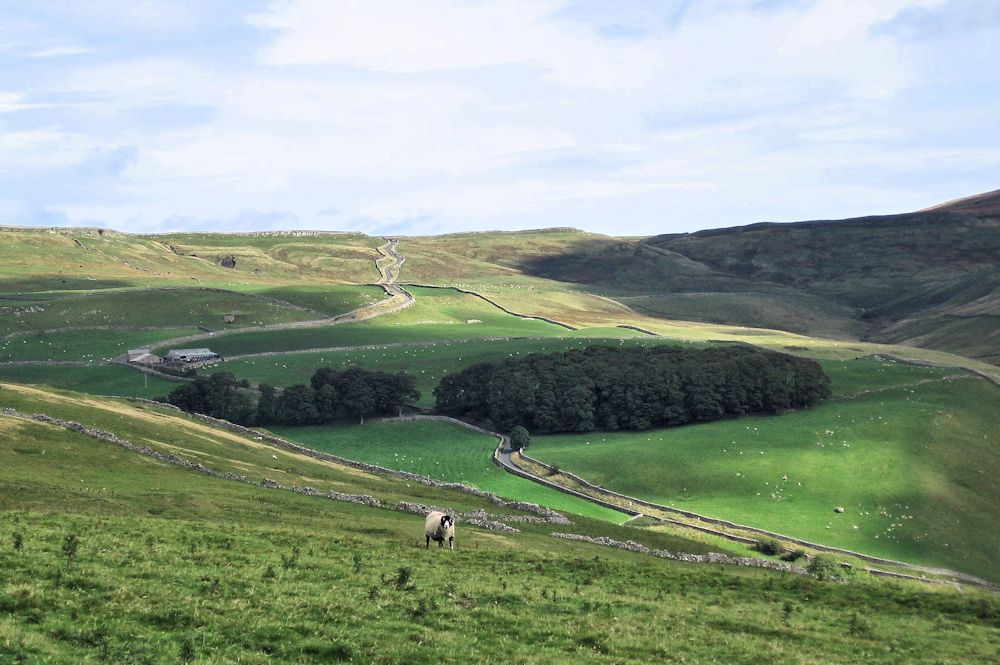
See how the cloud shadows are falling on the land, and how dark in tone the area of woodland appears.
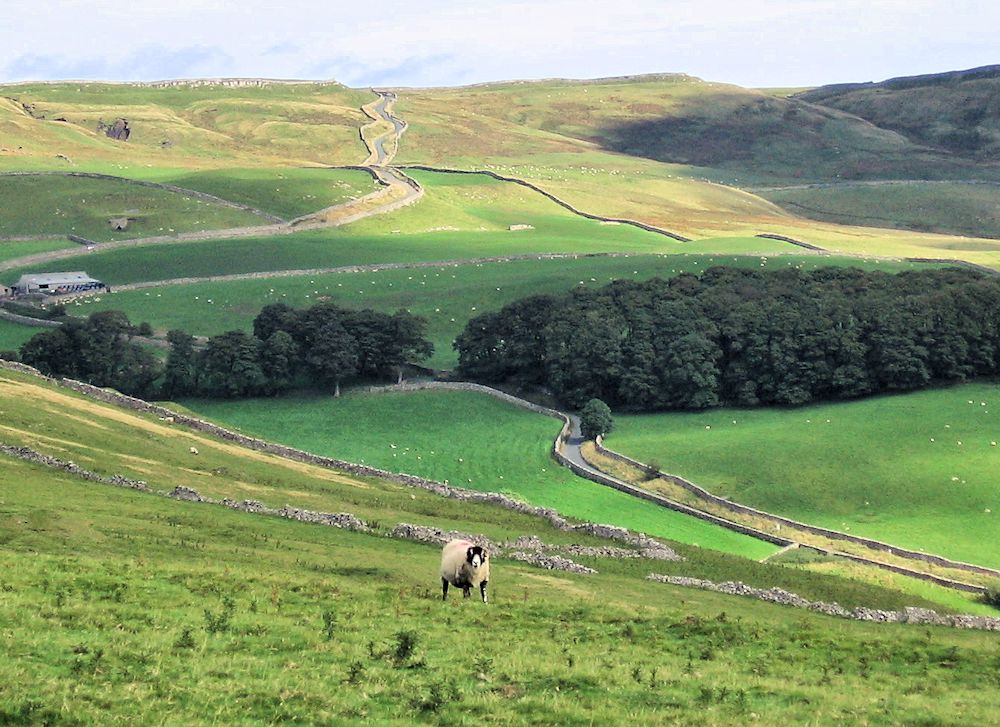
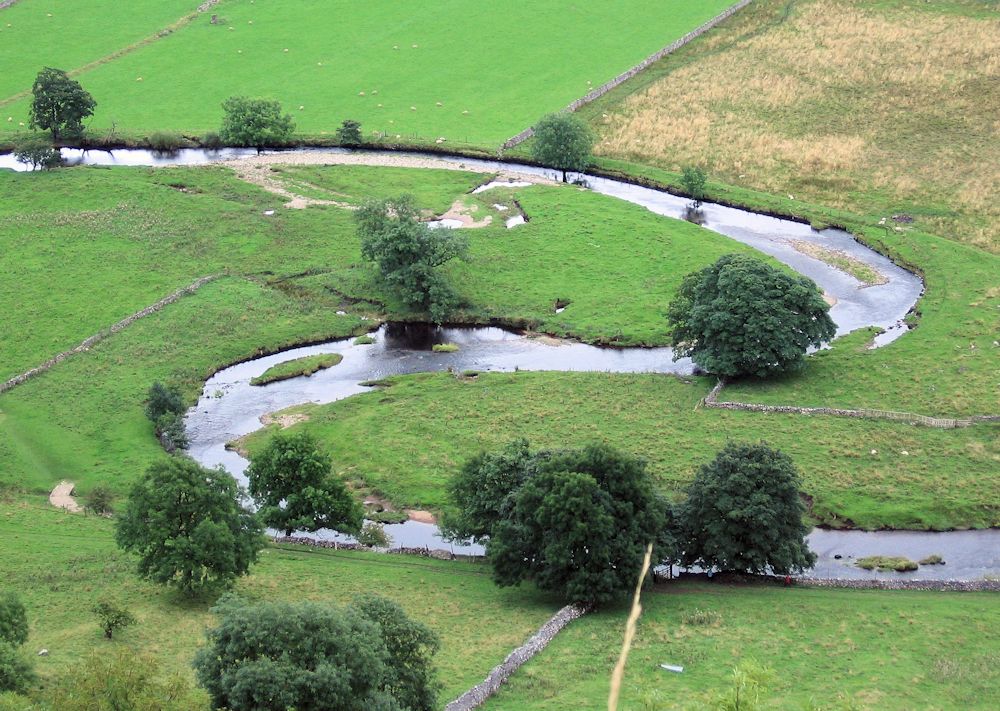
Note the diffuse light and soft shadows under the trees.

See how individual trees can be seen in the foreground and those in the distance become more of a texture. Here it is very clear to see the importance of establishing the land forms first before working on the groups of trees in the foreground.
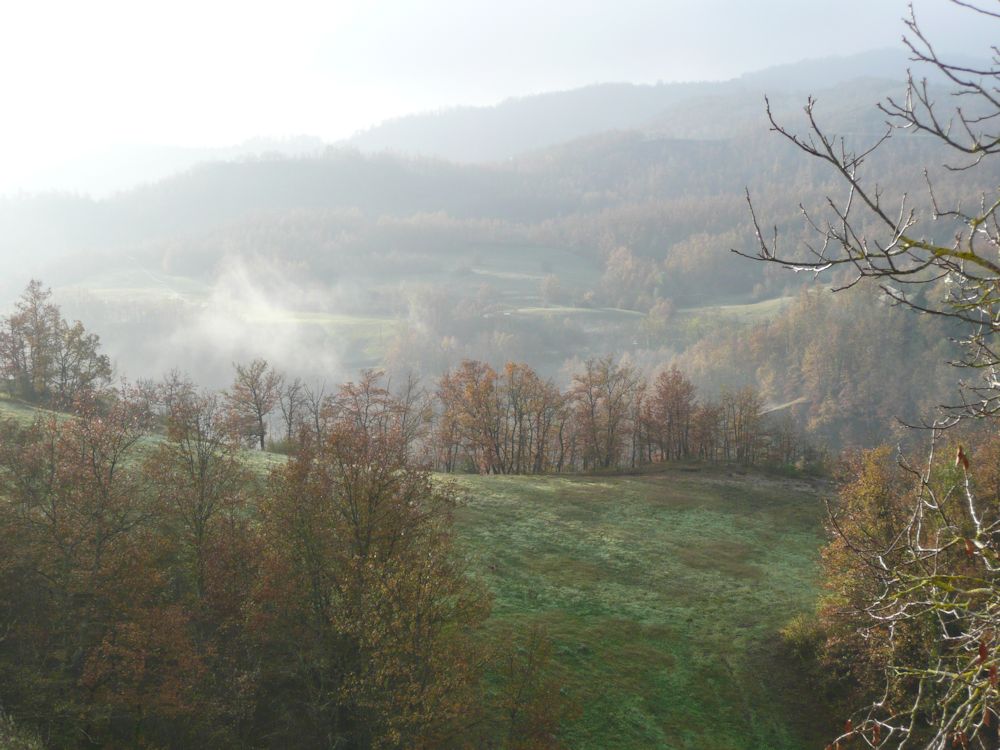
Seen early morning from my window.
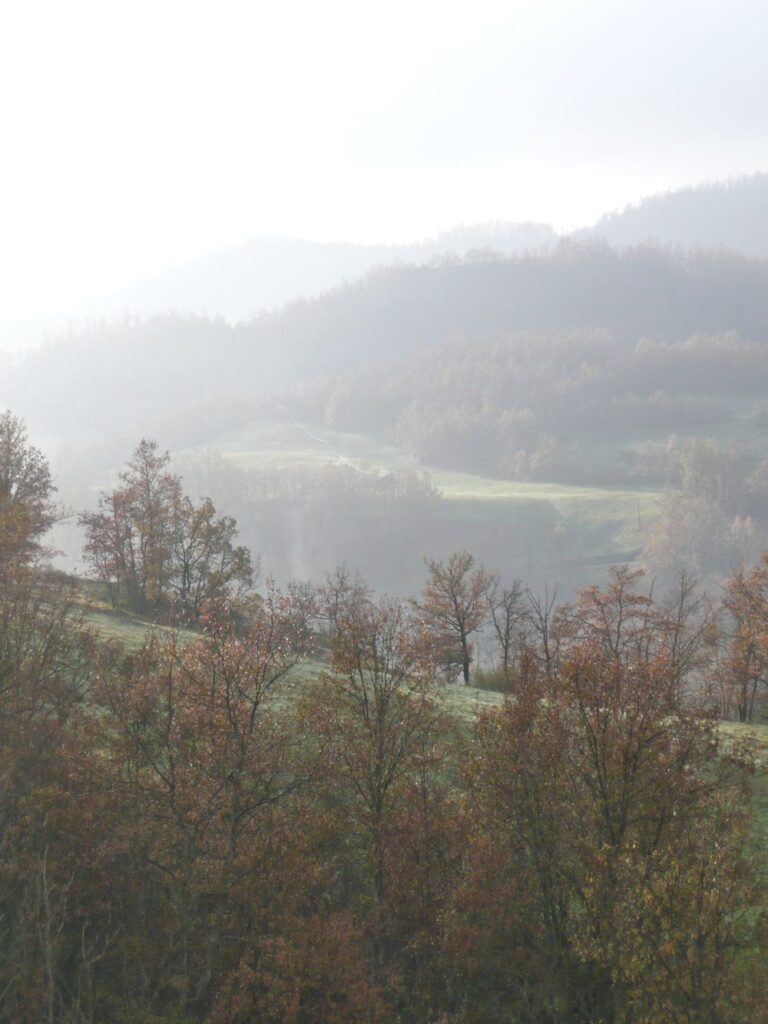
A slightly different view; the misty effects in both could be achieved by gentle washes and lifting out in watercolour.
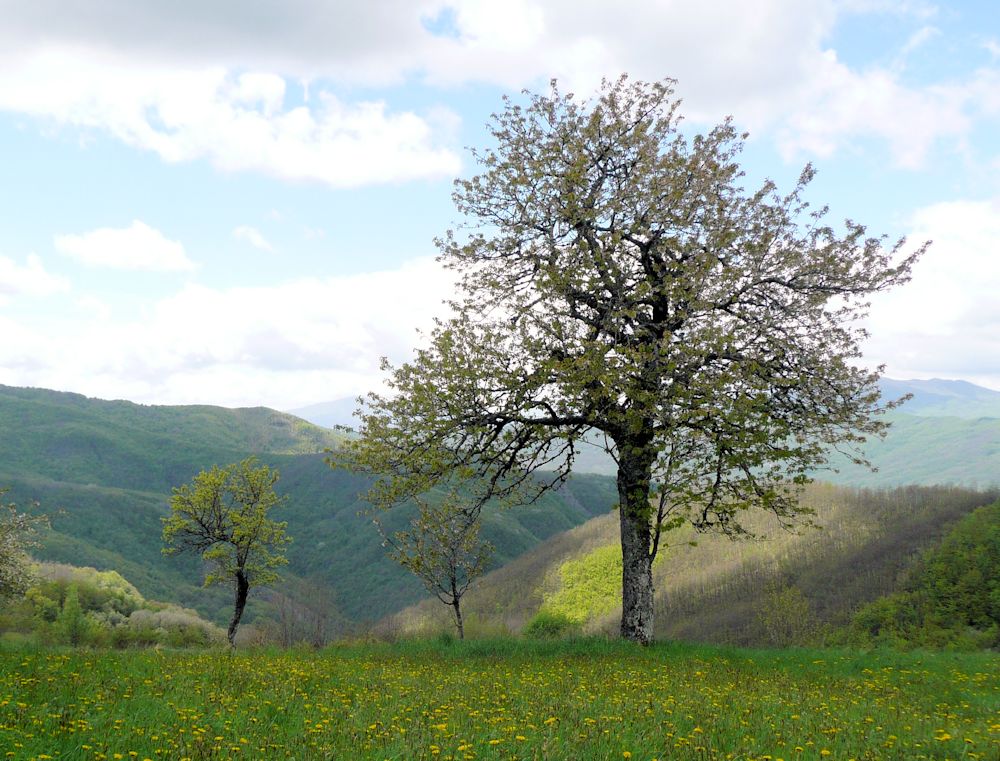
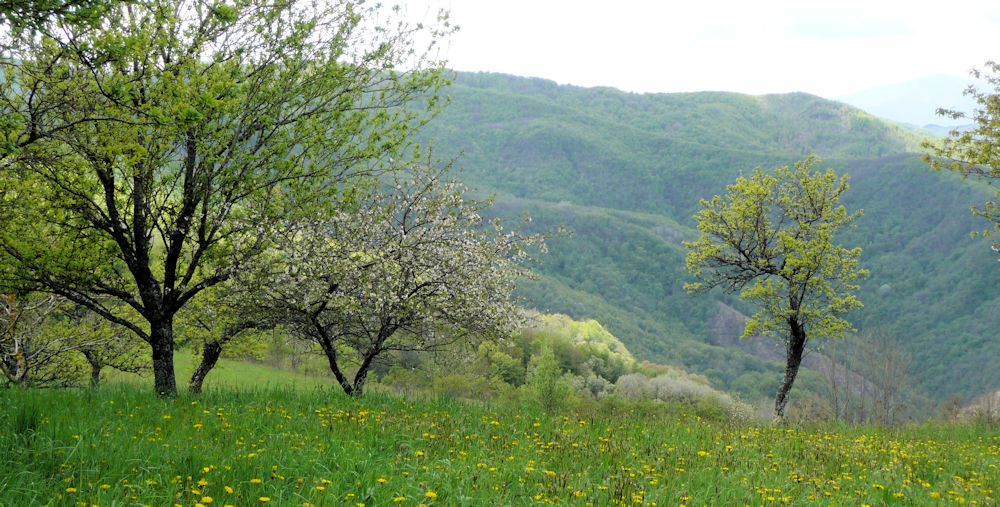
Fresh greens and the last of the cherry blossom
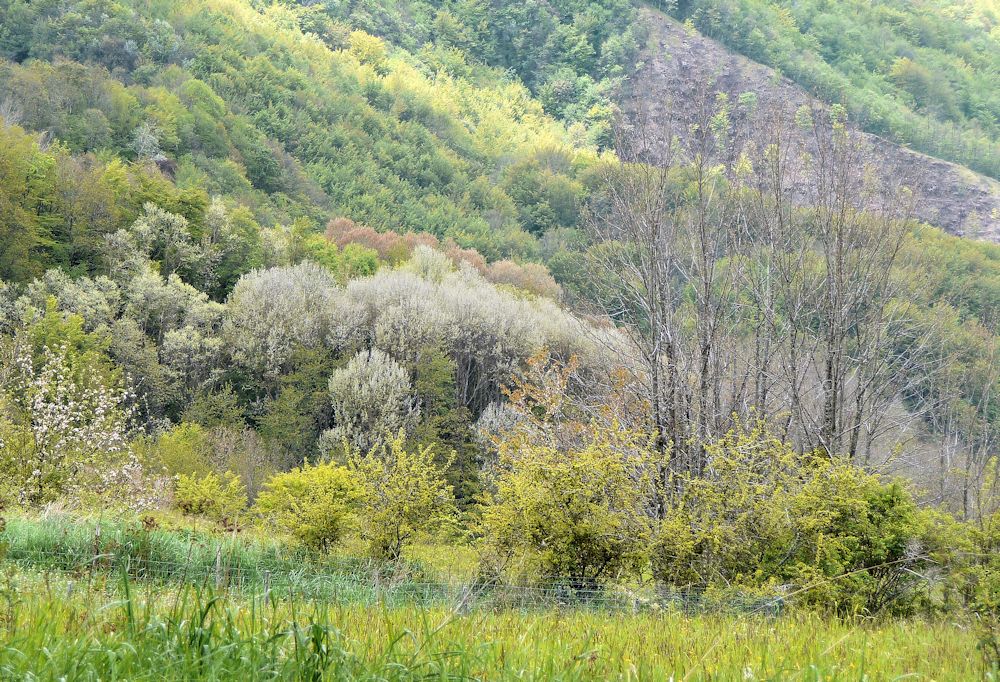
Coming to grips with the underlying slope into the valley here is more difficult so here I would concentrate on the rich textures and different hues and tones of this wonderfully mixed woodland. Greens dominate, but there is also yellow, russet, silvery and greenish grays, and slightly lilac tints with deep contrasts of dark trunks and spangled white; another tapestry of vegetation.
The images above should provide ideas for working from your own reference. Best would be from a place you have walked in or visited.
Your paintings;
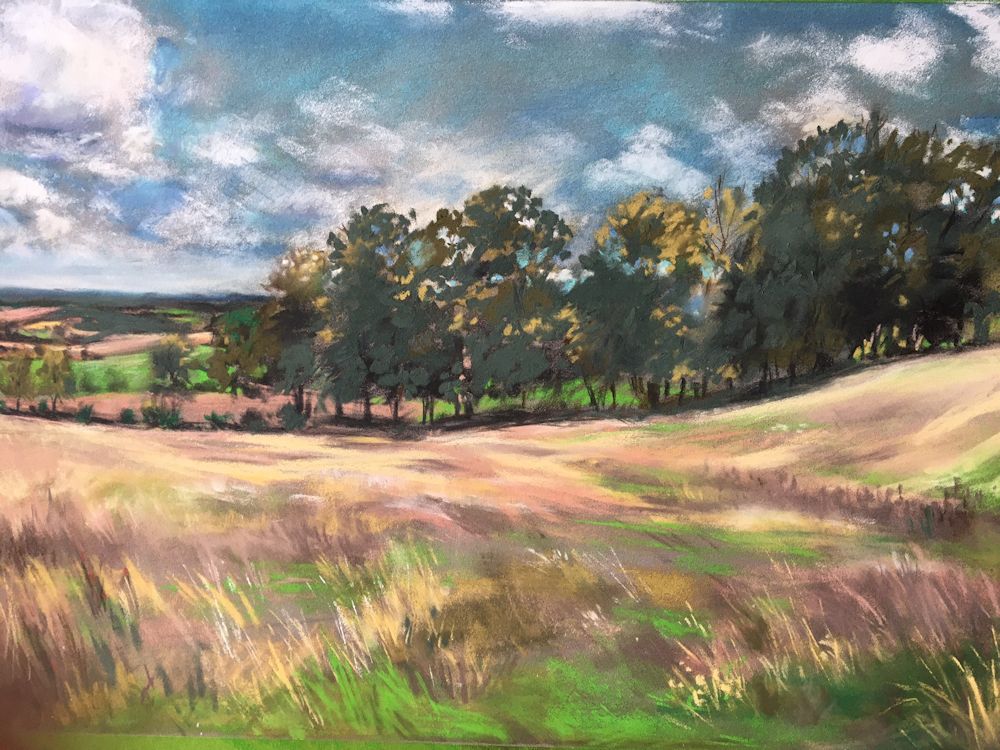
Pastel by Maryon
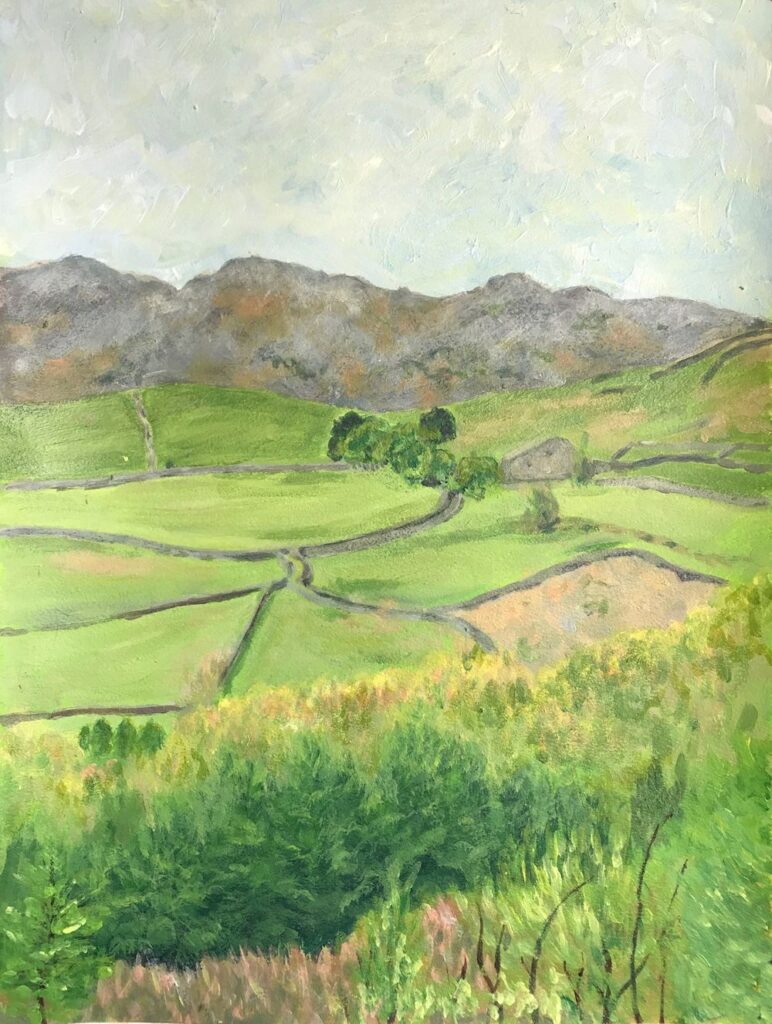
Acrylic by Mali
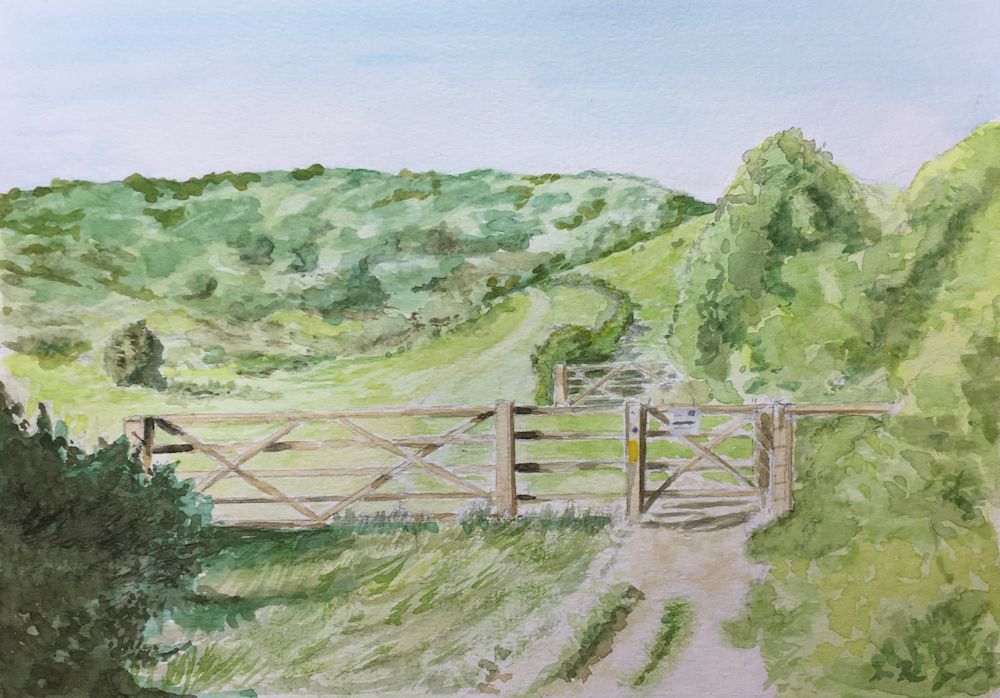
Watercolour by Heather
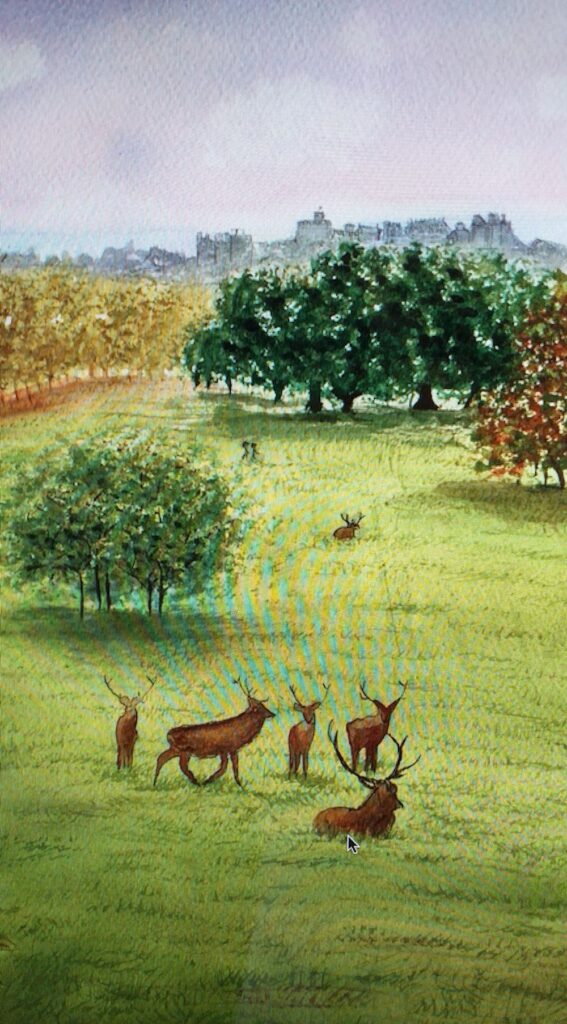
Watercolour by Maricarmen
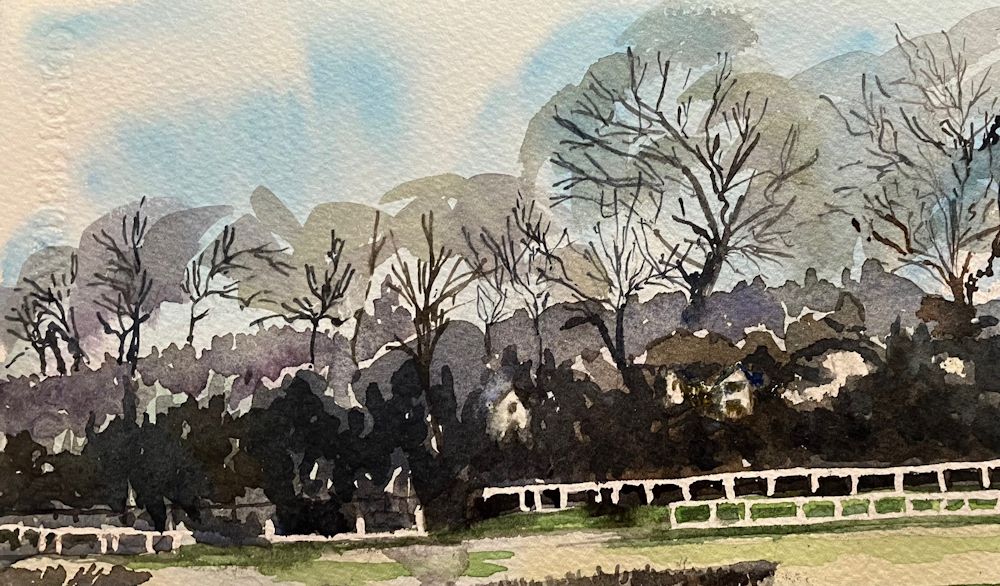
Watercolour by Sarah
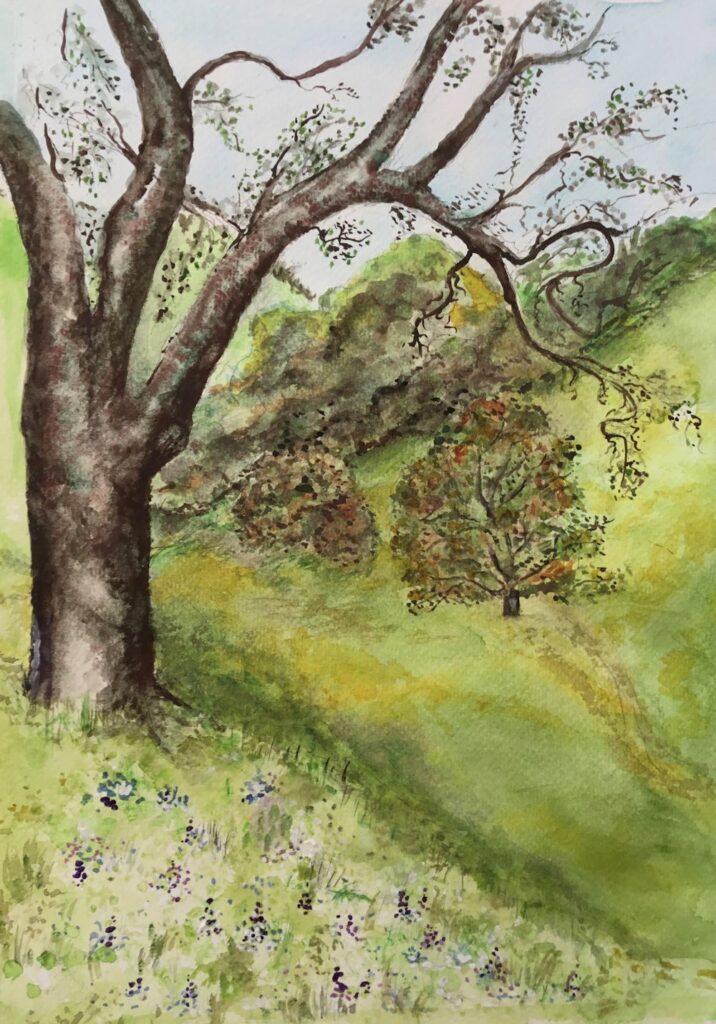
Watercolour by Ann
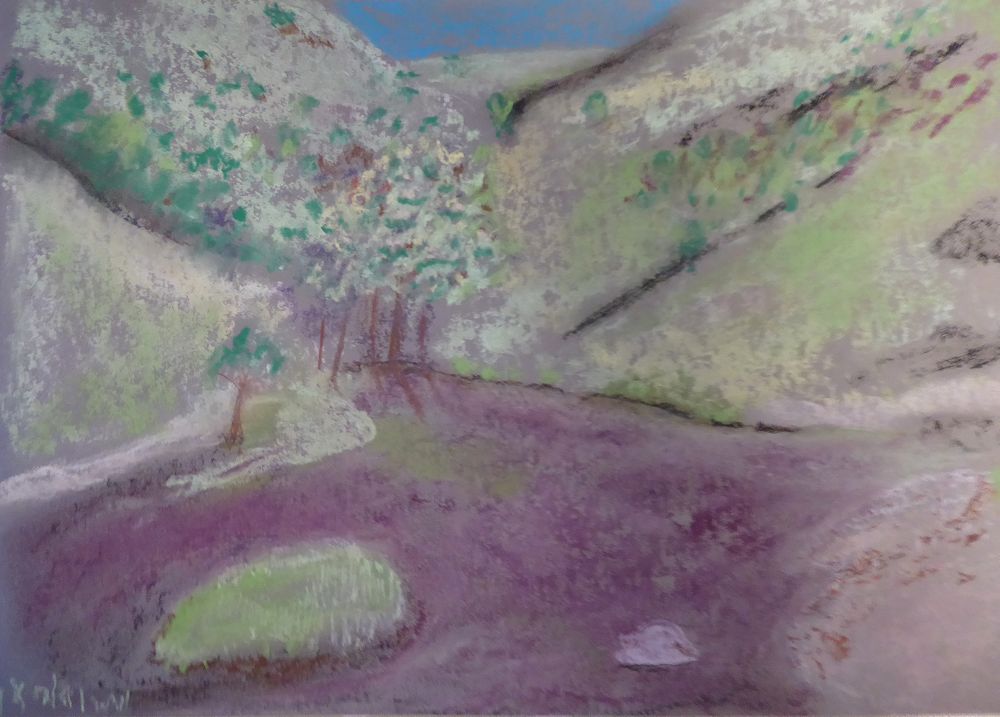
Pastel by Anne C
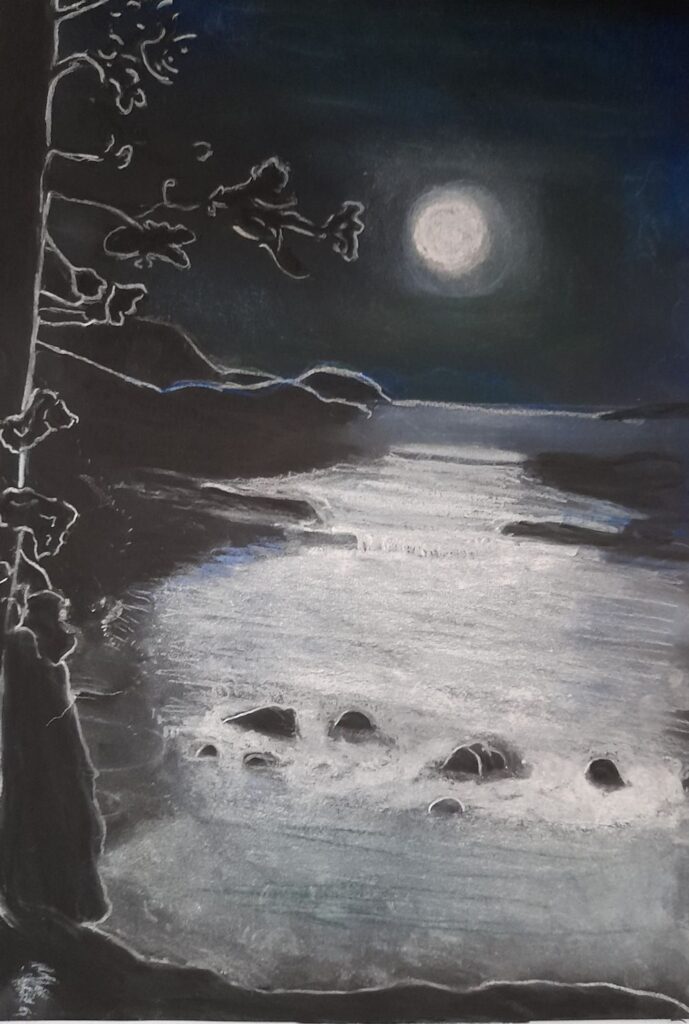
by Kate
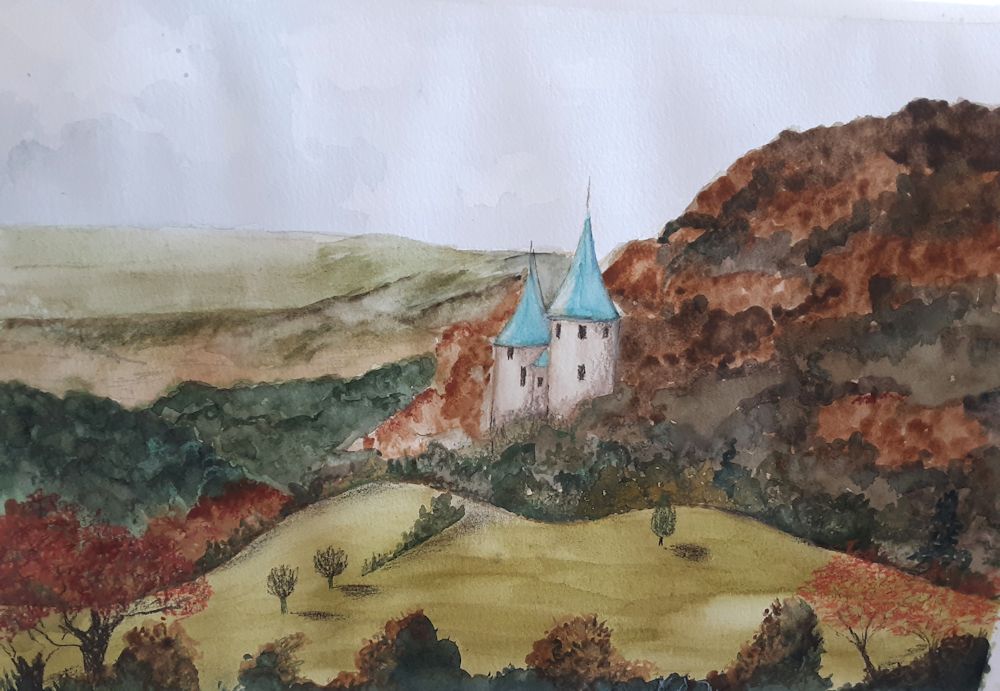
Watercolour by Liz
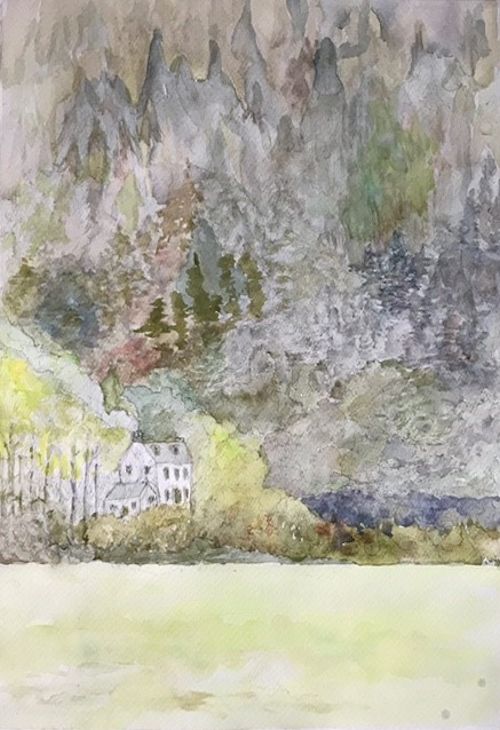
Watercolour by Virginia
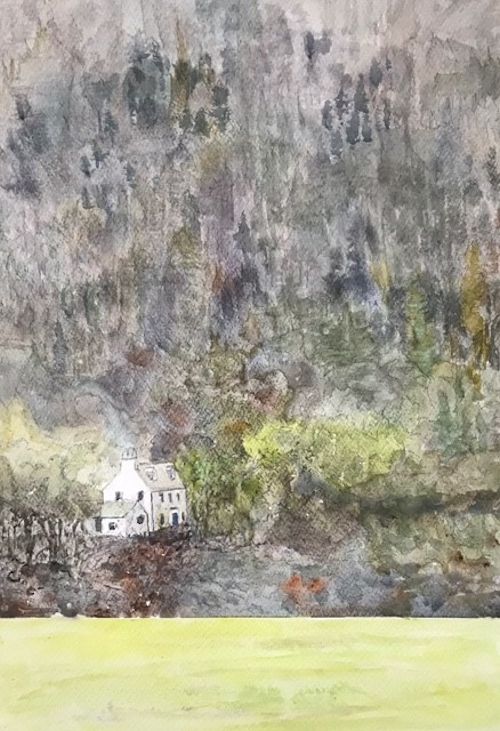
Watercolour by Virginia
Drawing Trees Week 5: At the Water’s Edge
March 23, 2022
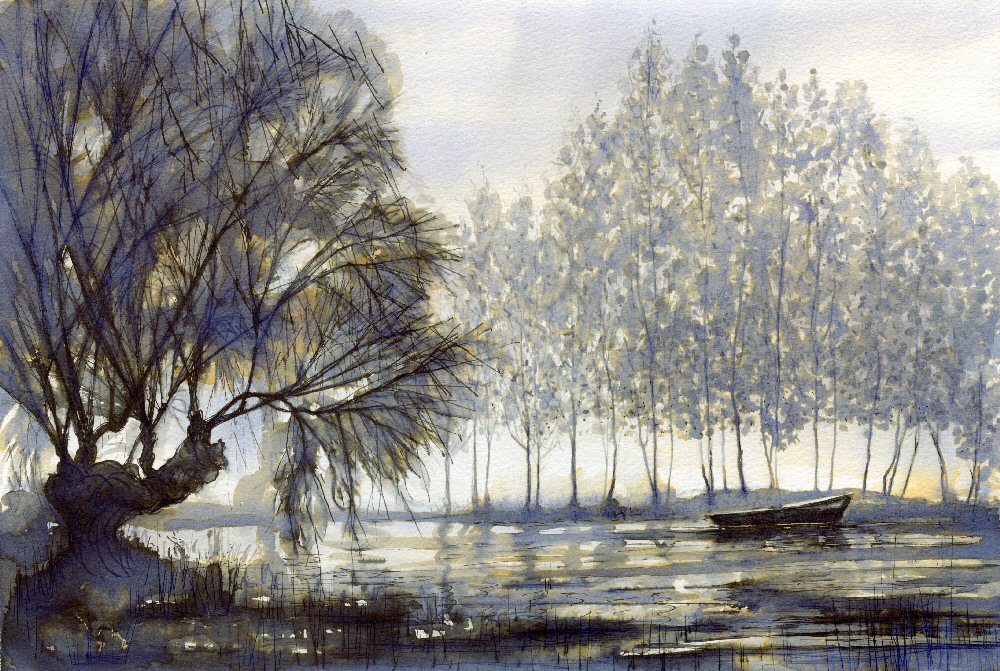
Quink ink by Jo
This week’s challenge is to paint a picture of a tree or trees at the water’s edge or even standing in water. Look for reflections and also how the tree is physically related to the land and the water. Are it’s roots exposed at the shoreline? And is it by a stream, a lake or on the coast?
The ferocity of the current caused by a flash flood may uproot and drag trees downstream, especially in a narrow gorge. Branches or whole trees may remain lodged on the banks. The picture below is of Catrigg Force in North Yorkshire where a tree has been tossed across the stream below the fall. The gorge itself is full of tall beech trees reaching for the light above.
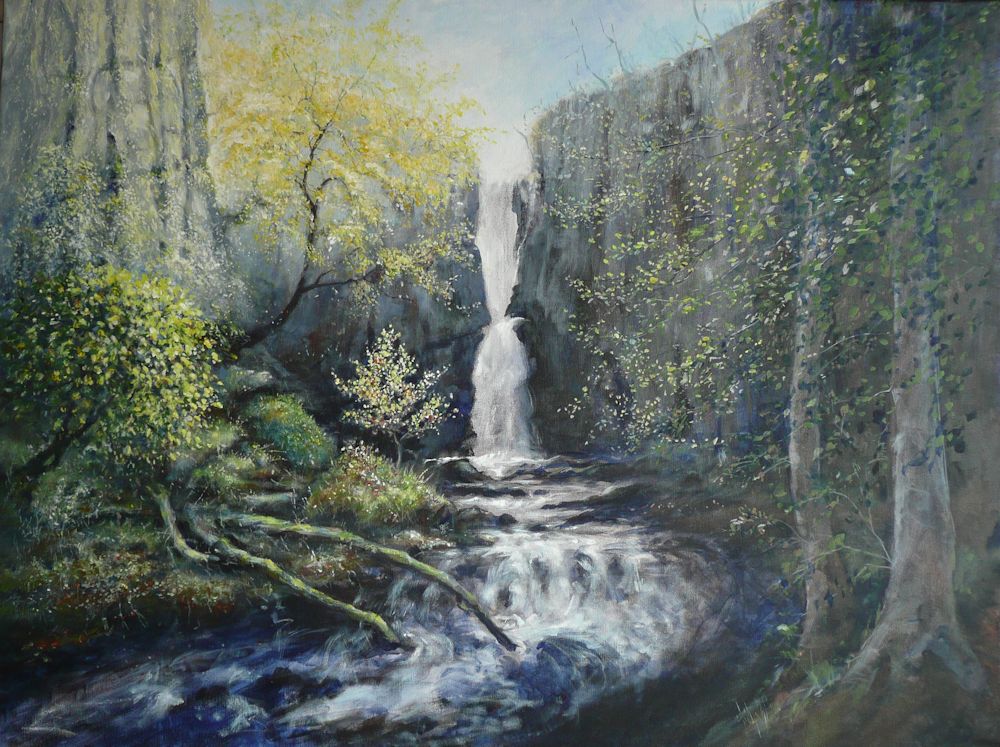
Acrylic by Jo
The drawing below shows the ravages of winter storms on the Suffolk coast. Tree trunks roll around on the beach at Covehythe where whole roads lined with trees have fallen into the sea. The trunks are often sawn off as here and only the lower part and roots remain. Seeing these on a misty February morning was an eerie experience.
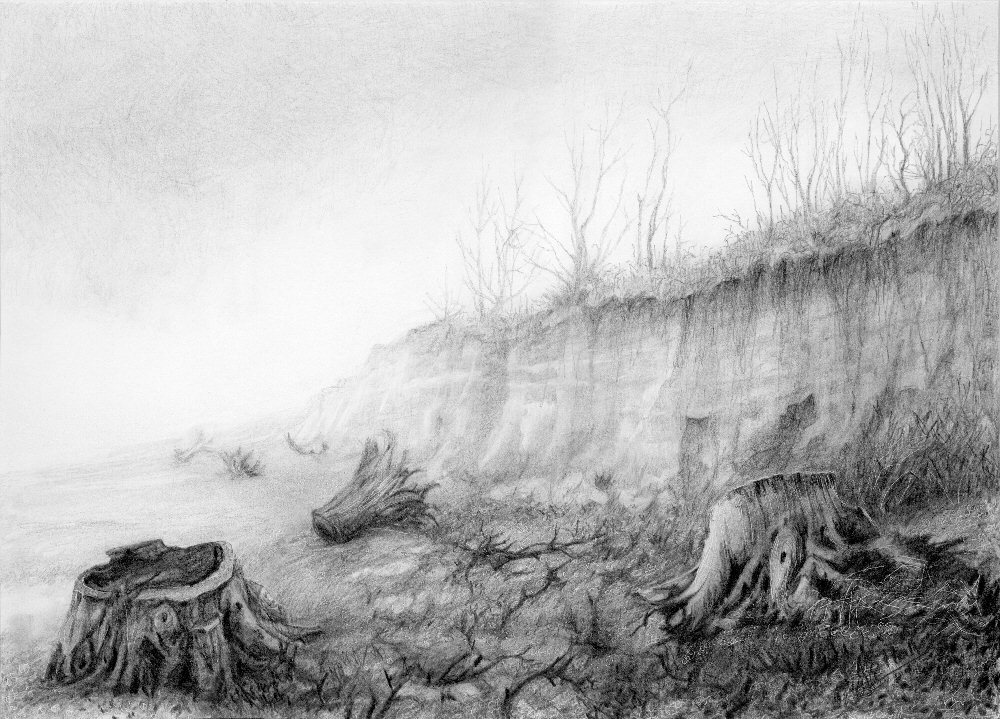
Pencil by Jo
Looking North there were whole trees strewn on the shingles below the cliff and more trees can be seen clinging on before meeting the same watery fate.
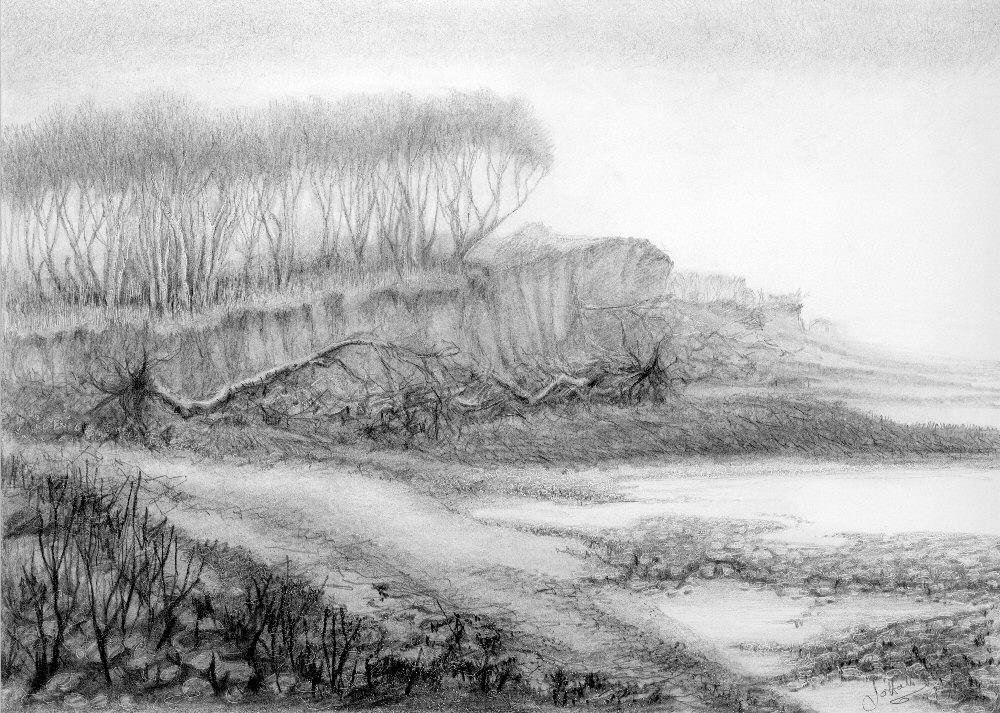
Pencil by Jo
I would like to see your paintings the reflect the mood of the place which will be related to the weather and time of day as well as to the landscape. This may be much more successful if it is a place you know well or have at least visited. A lakeside tree in calm weather may suggest peace, or if their is a breeze and a dancing in the trees perhaps a playful atmosphere. However, if the sky is dark and storms are raging you may be depicting a more dramatic scene.
If you are feeling particularly adventurous don’t be afraid to use your imagination. If you want to depict a storm with a flash flood and branches flying I suspect there will be few references in your photo collection or sketchbook, but you may have recorded the aftermath, so you could think about how it would have been during the storm.
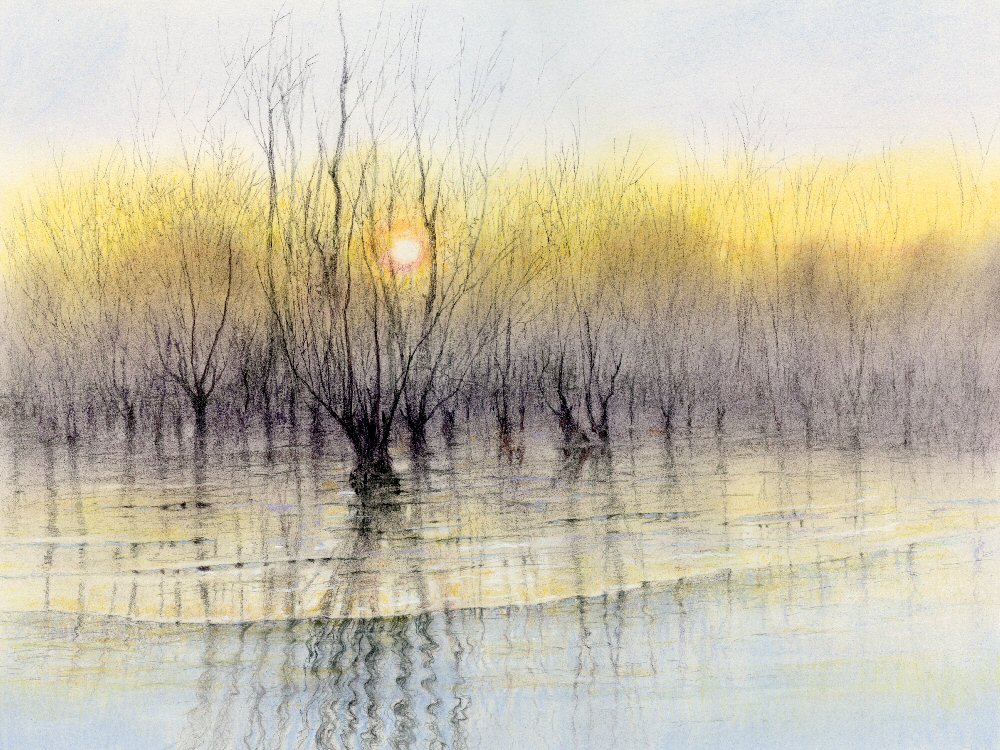
Pastel and graphite pencil by Jo
This was an exceptionally cold first weekend in December a few days after the after the Stour had been in flood. This was the calm after the storm. Areas of thin ice glazed the river surface. Note how different the reflections look on the ice compared with their appearance on the flowing water.
Decide first on your subject and think about the aspect you wish to convey, then try out some rough sketches from your reference pictures before embarking on the final composition.
Your Paintings:
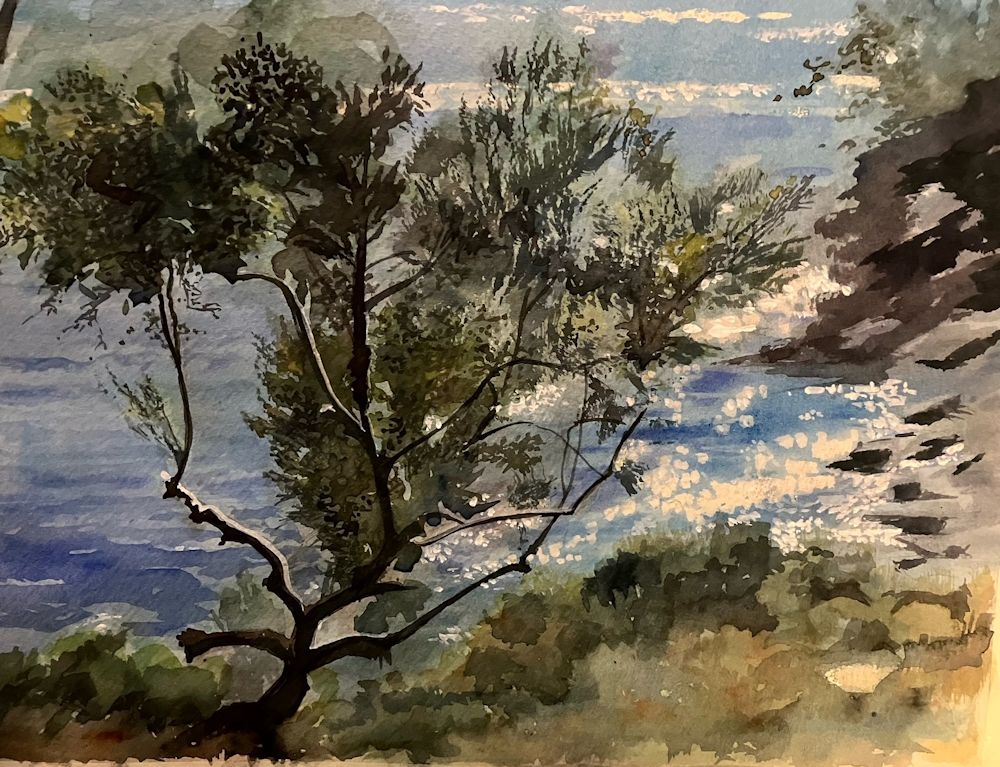
Watercolour by Sarah
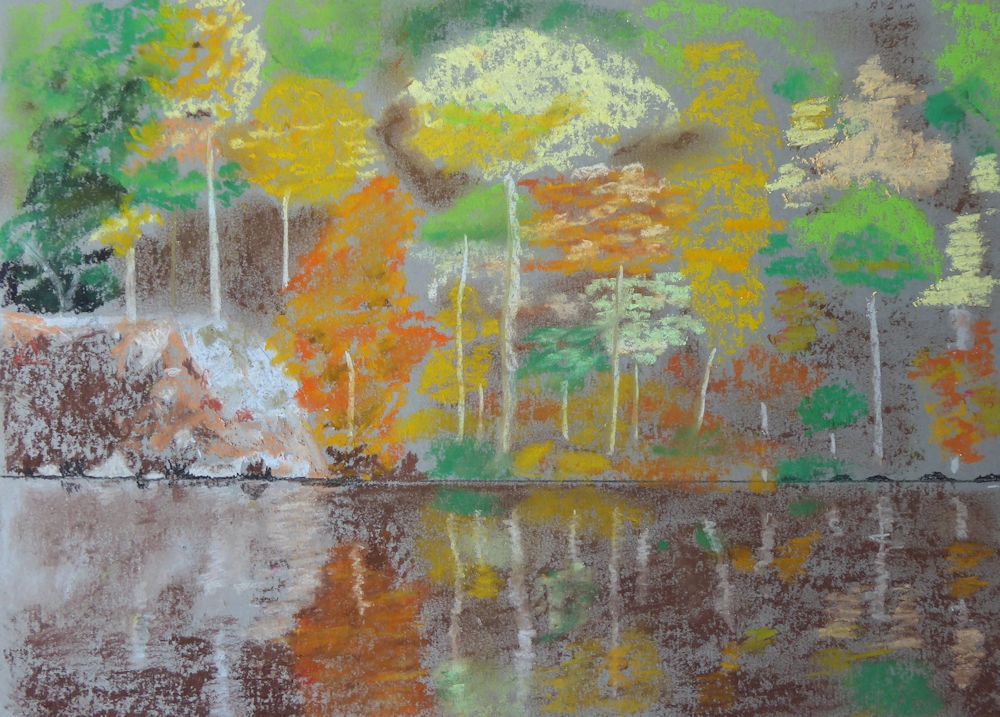
Pastel by Anne C
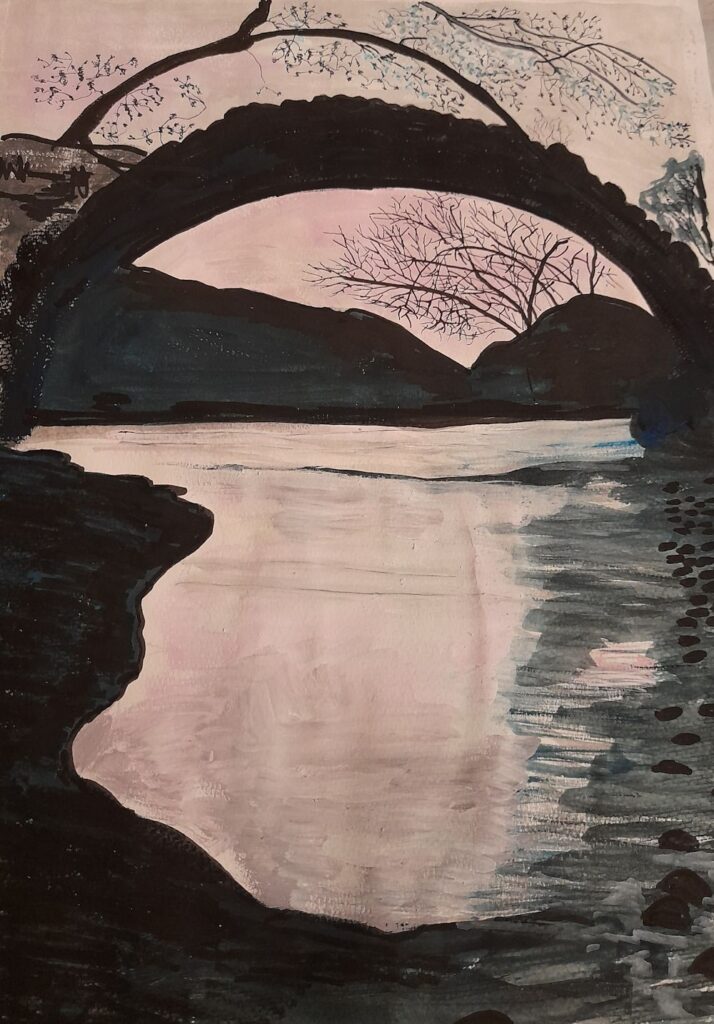
Ink and Watercoloour by Kate
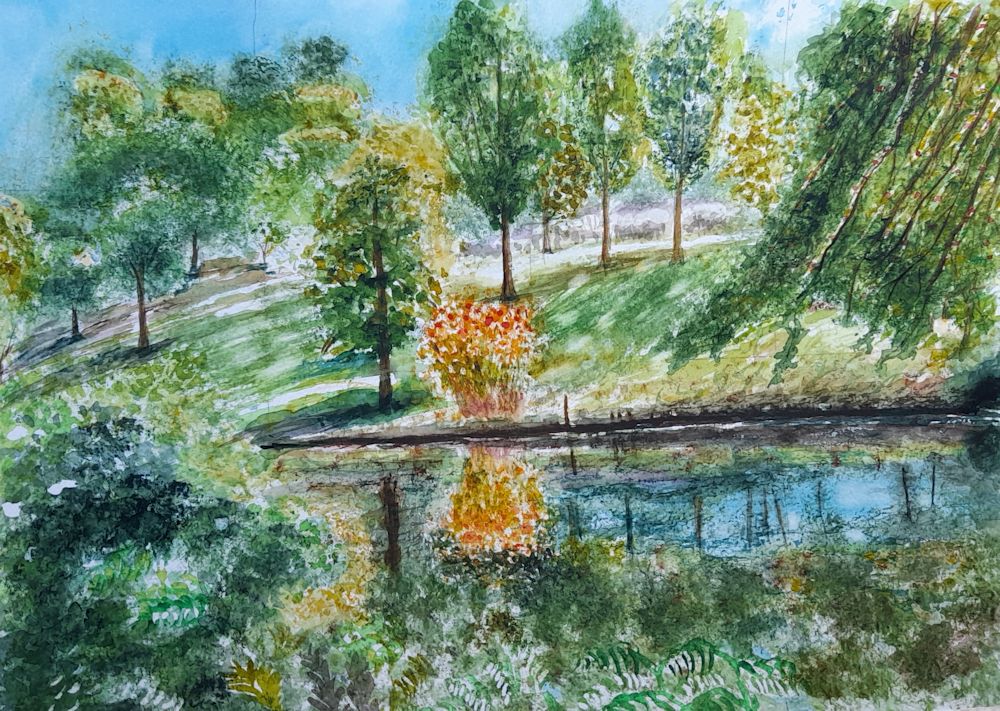
Watercolour by Maricarmen
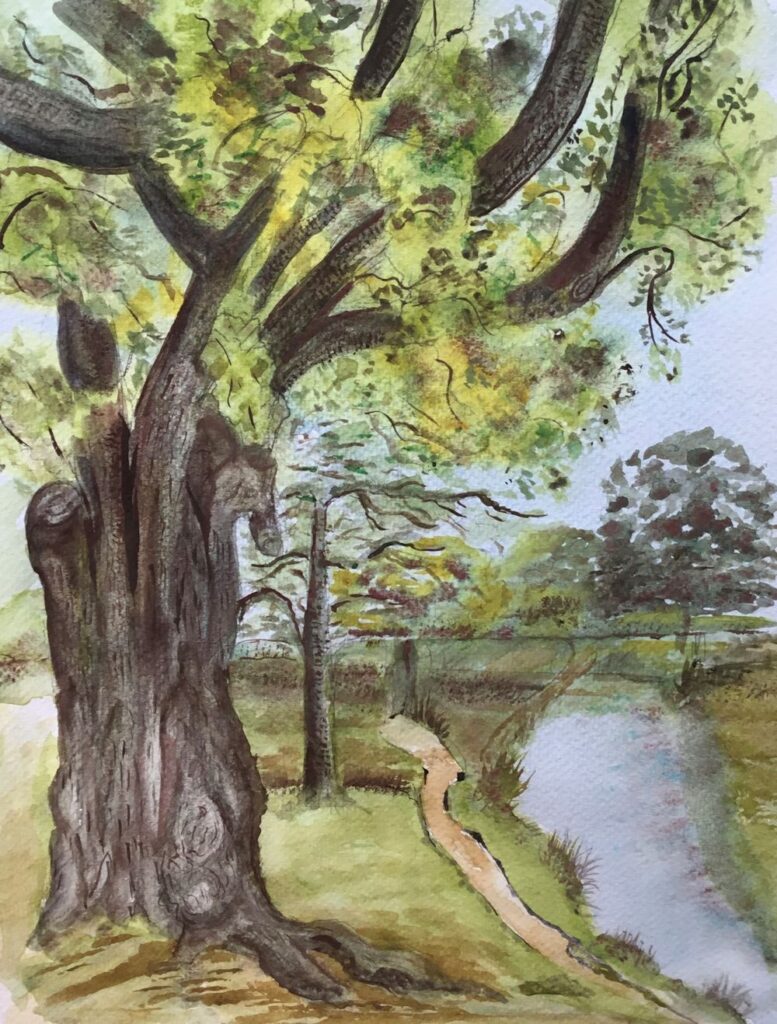
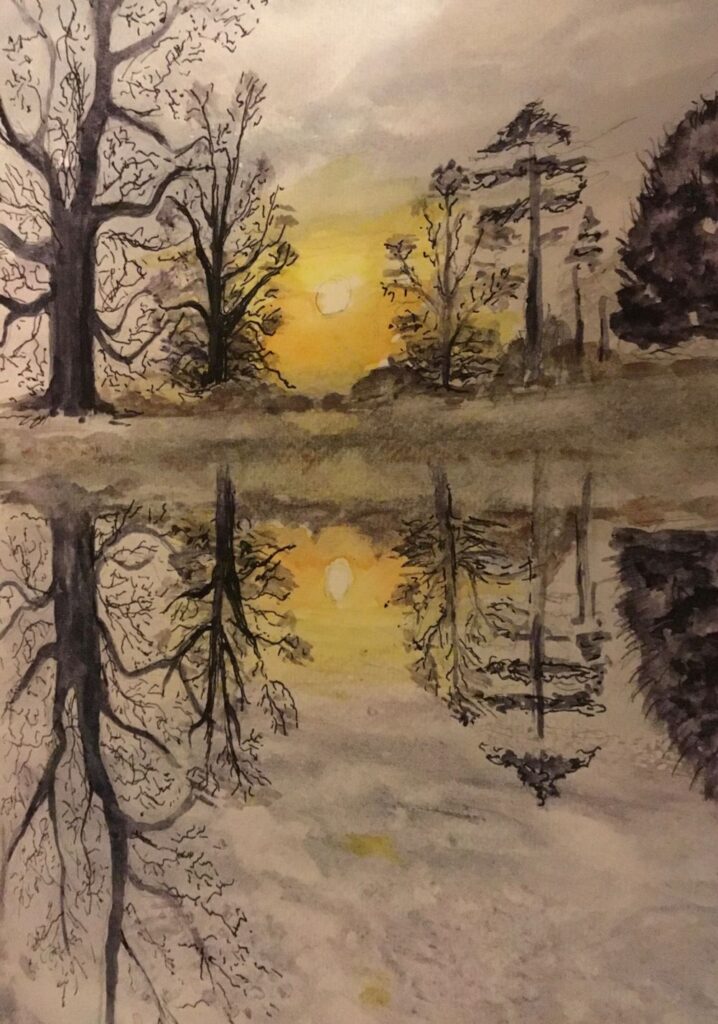
Watercolour by Ann
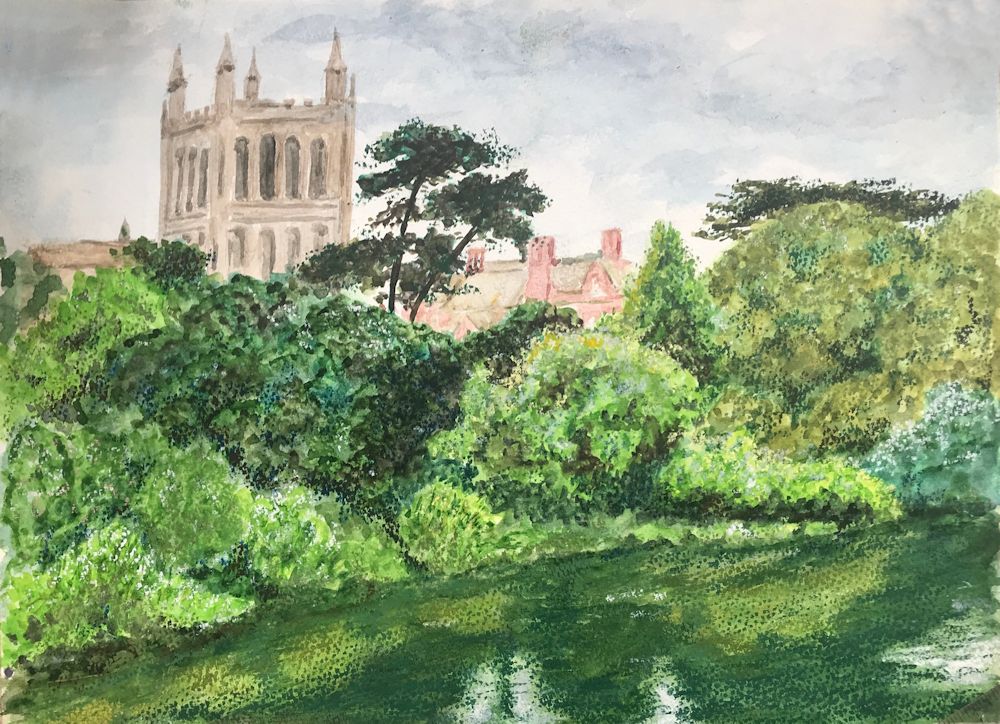
Watercolour and pastel by Mali
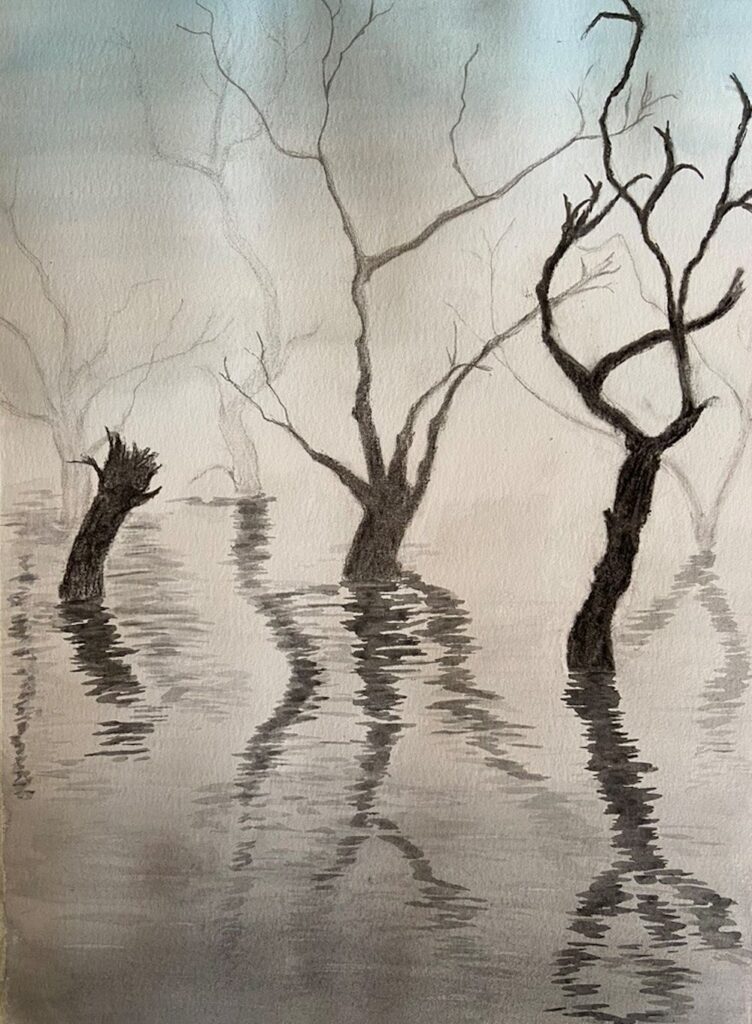
Watecolour by Anne H
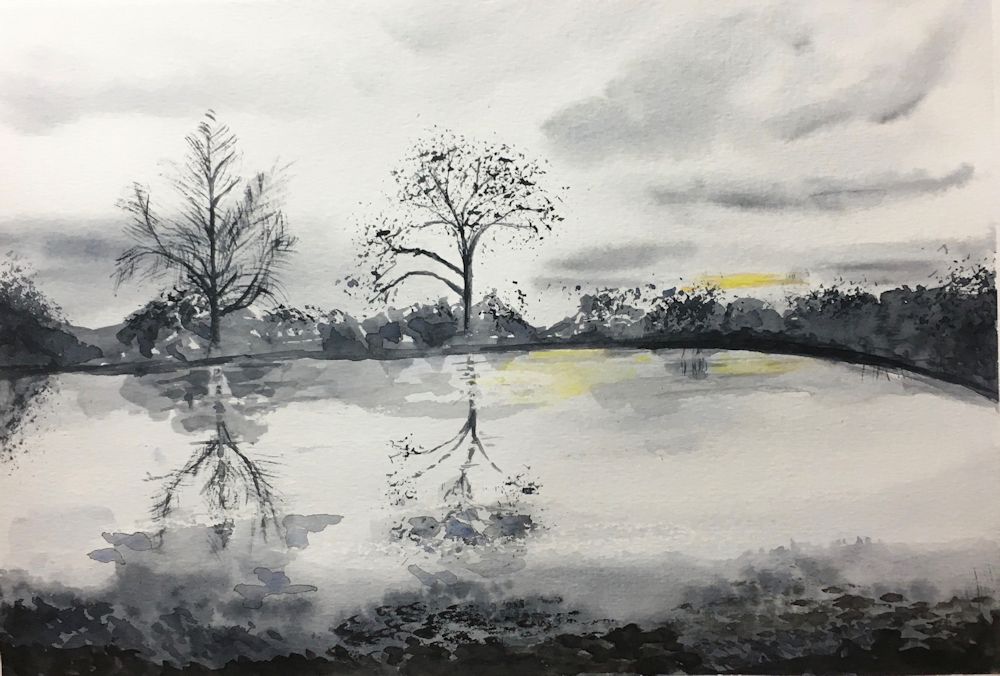
by Heather
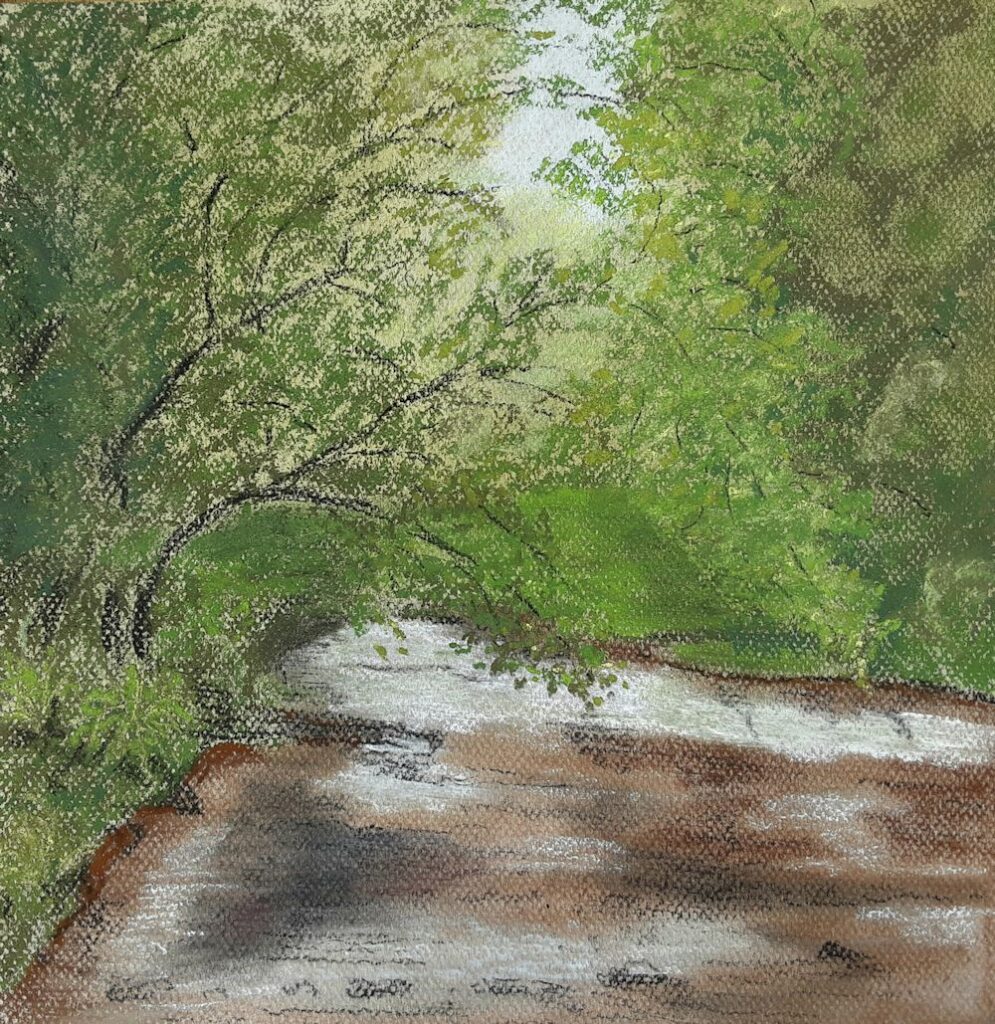
by Liz
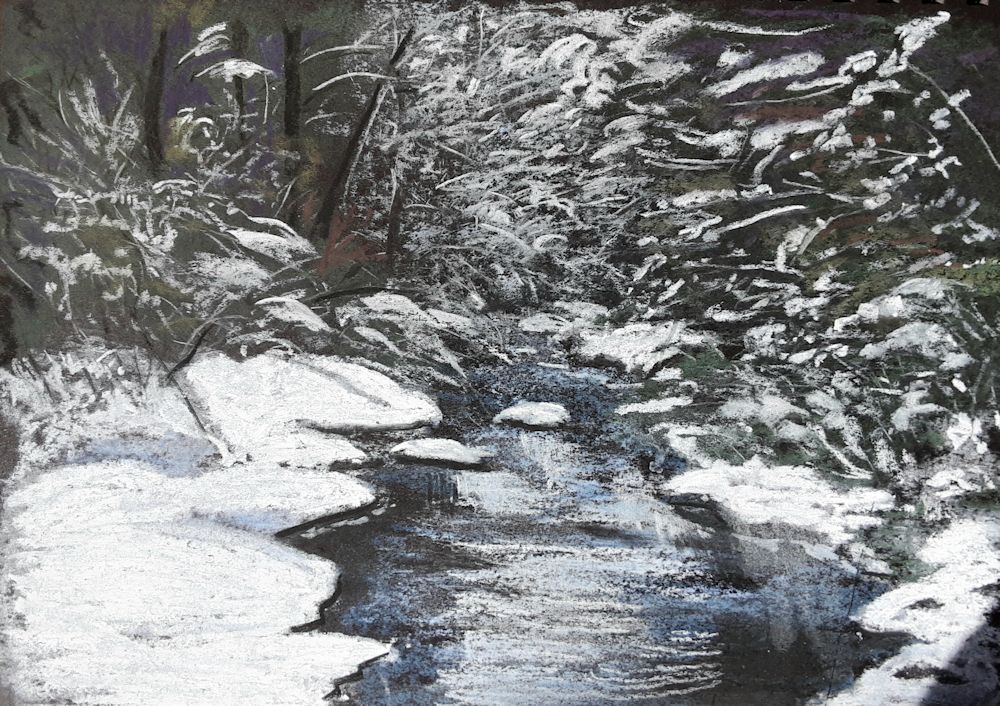
Pastel by Liz
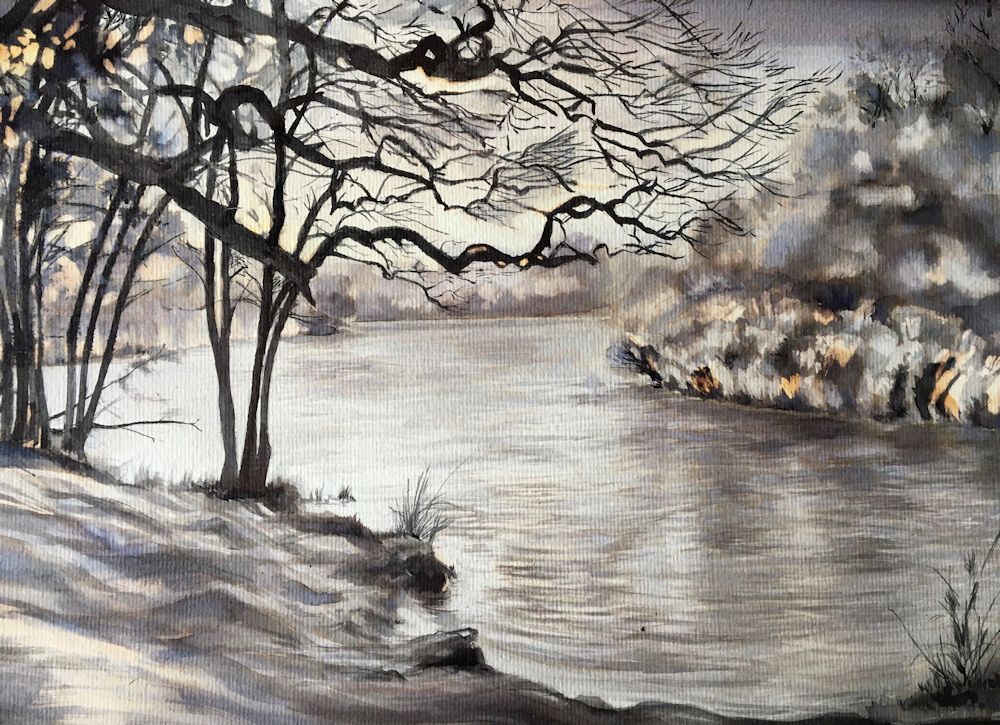
Quink by Maryon
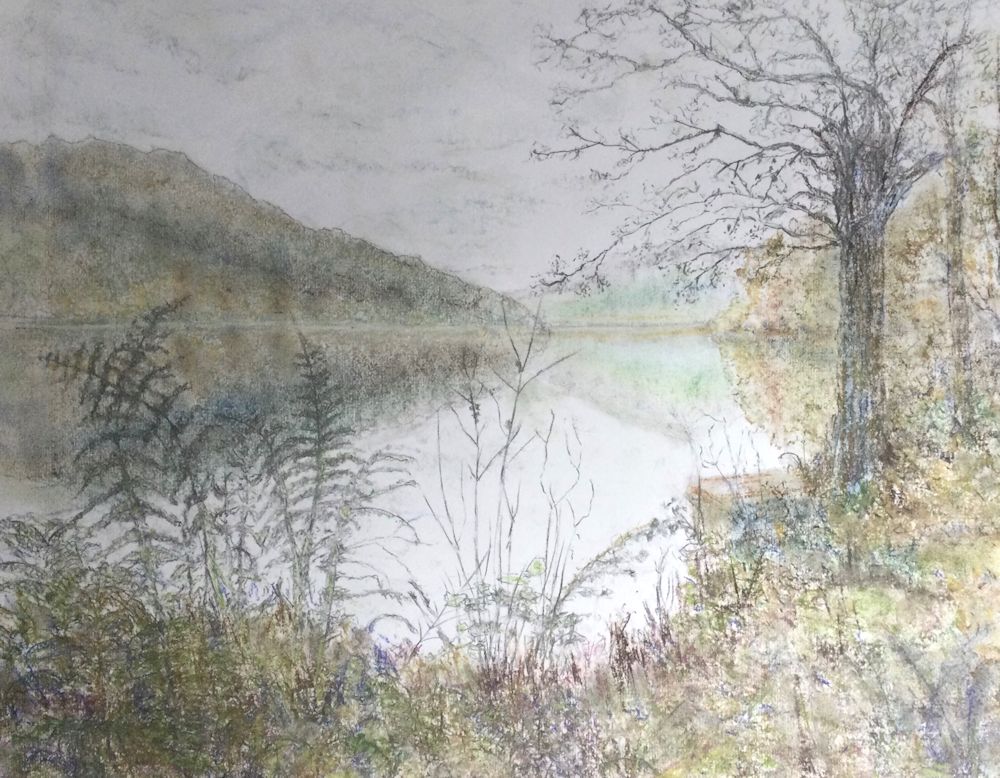
Charcoal and pastel by Virginia
Drawing Trees Week 4: Woodlands
March 16, 2022

Pastel
This week’s challenge is to paint or draw trees in a woodland setting. The woodland floor may be a significant part of the painting as in the pastel painting of Judy Woods above. This is a mainly beech wood on a slope, with many ancient trees with haunting shapes and and exposed roots. It seems to breathe mystery.
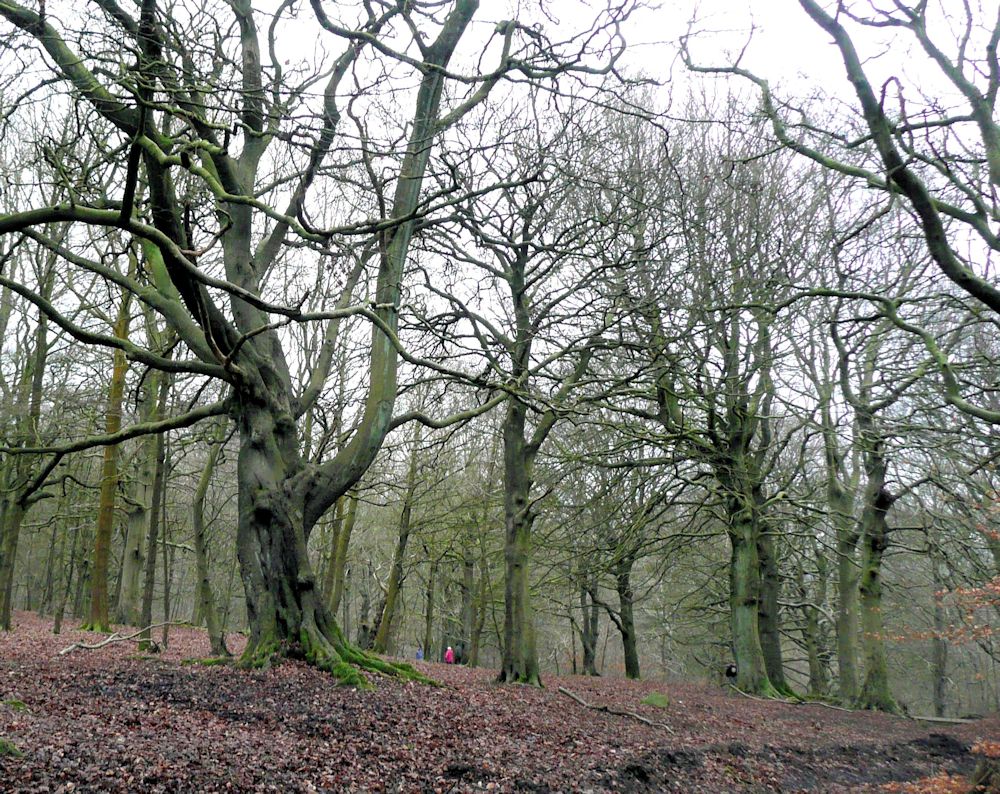
Photo by Jo
Another mysterious wood with an entirely different character is Wistman’s Wood on Dartmoor. Here stunted oaks encrusted with moss and ferns emerge from boulders of granite.
Over the last three weeks we have been exploring the shape and structures associated with a variety of trees. In a woodland there will be other considerations as the background may be full of the myriad twigs and small branches of more distant trees. There may be an under-layer of shrubby plants and the floor of the wood is often far from featureless, so part of this week’s challenge will be finding a way to describe the backdrop for the main trees in the composition.

Pastel on reddish brown paper
This painting spotlights a single tree with a backdrop of the other trees near the Suffolk coast North of Southwold. The most distant trees are almost a texture of overlapping strokes of pastel pencil. This is a small scale work about A4 size.
Your work may have a single tree or a group of trees as it’s main focus or as in the two examples below be a tapestry of the tree shapes and colours.

In the valley of the Nuns outside Funchal, Madeira a tapestry of blackened Pines and fire bleached Eucalyptus was seen against red rocks about a year after the event. Below a green layer of he undergrowth was already returning.
Charcoal and pastel on terracotta coloured paper 50 x 70cm

Another tapestry of trees, this time Pines and Birches
Pastel on brown/grey paper
Perhaps start by coming to grips with the shapes of your chosen woodland, by doing some small preliminary sketches. Think about the composition possibilities at the same time, then plan out your final composition. Think about which medium would suit your purpose and how you are going to use the medium. Also look at the tonal range; is it generally light and airy or dark and mysterious. Then think about the colour. Ask questions; which colours predominate and are there any small areas of colour that add to the composition by their purity, or by their contrast in tone and hue to their surroundings. In the photo of Judy Woods the little speck of a red anorak draws our attention and at the same time gives a sense of scale!
Your paintings;
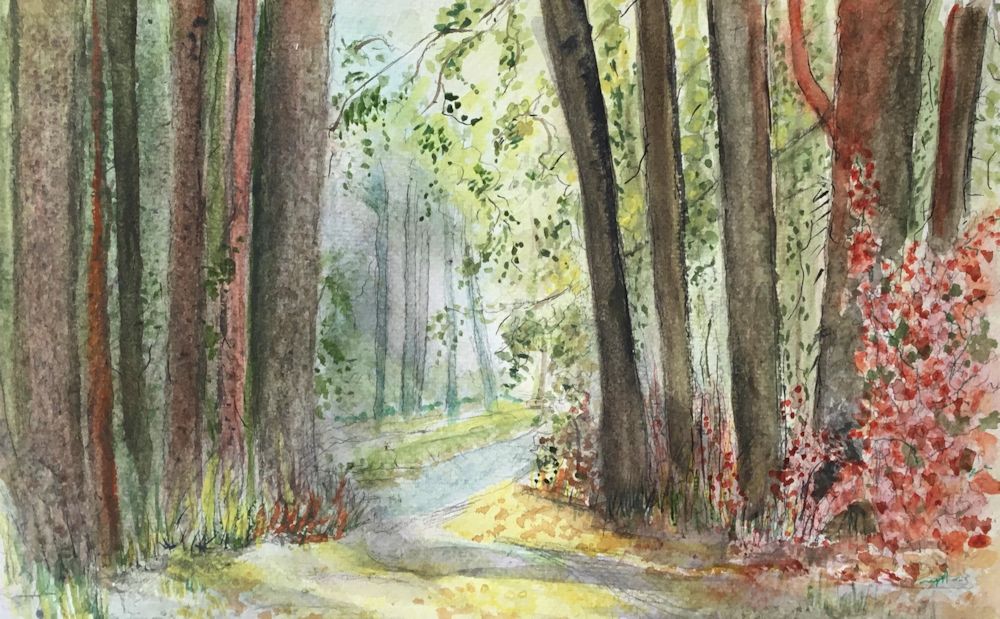
Watercolour by Ann
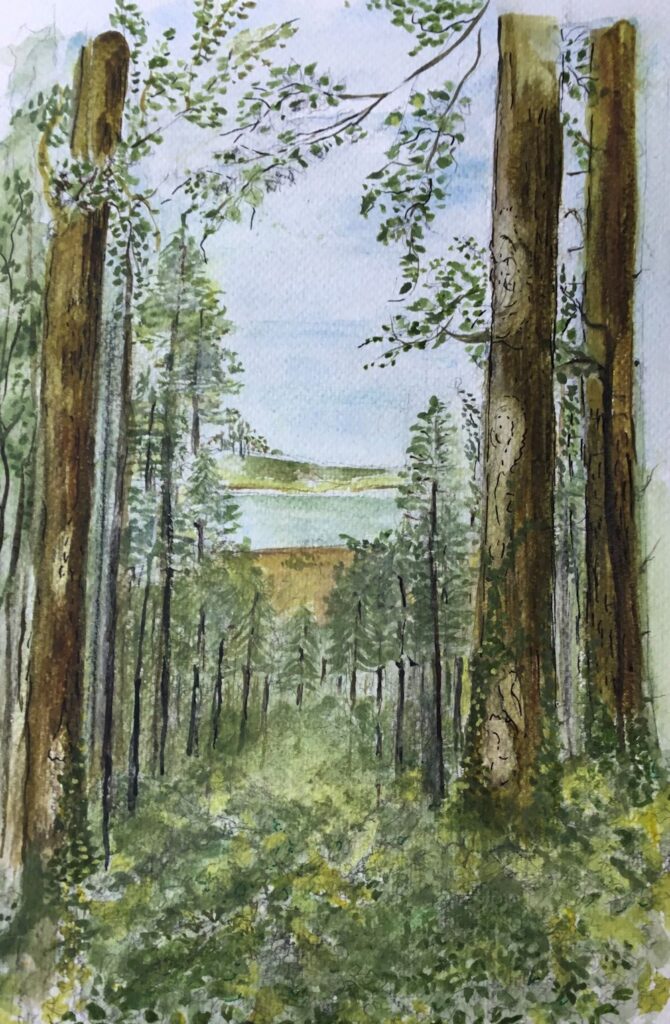
Watercolour by Ann

Watercolour by Anne H
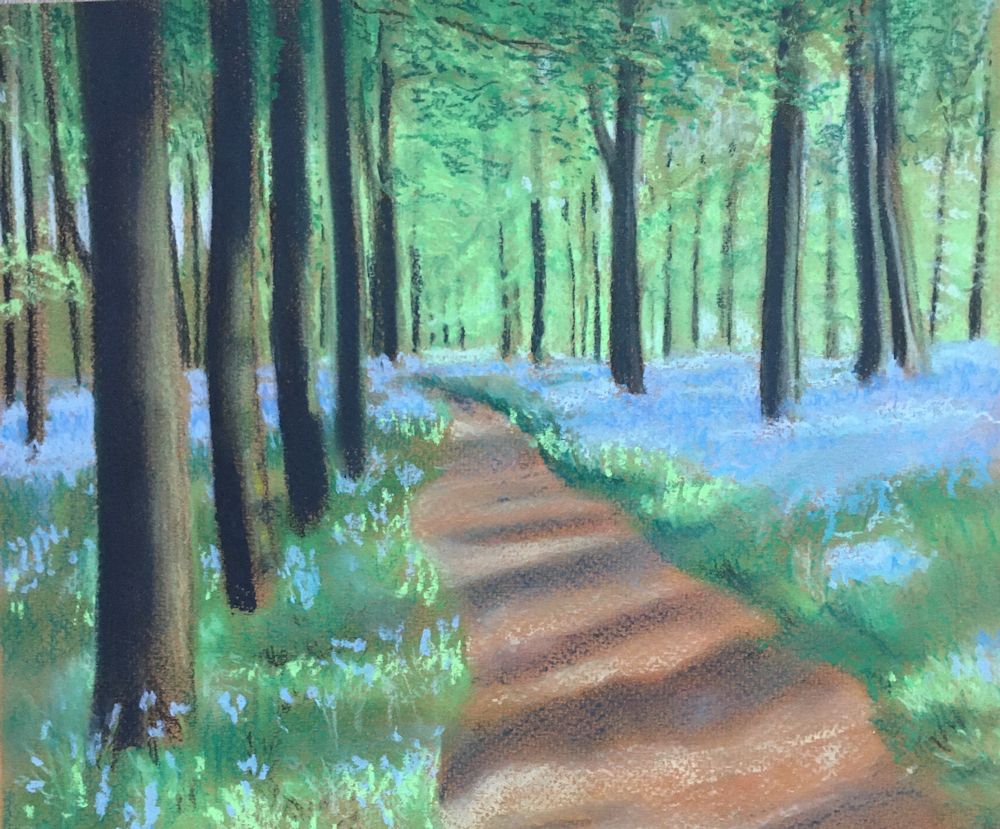
Pastel by Heather

(detail)
Watercolour by Maricarmen
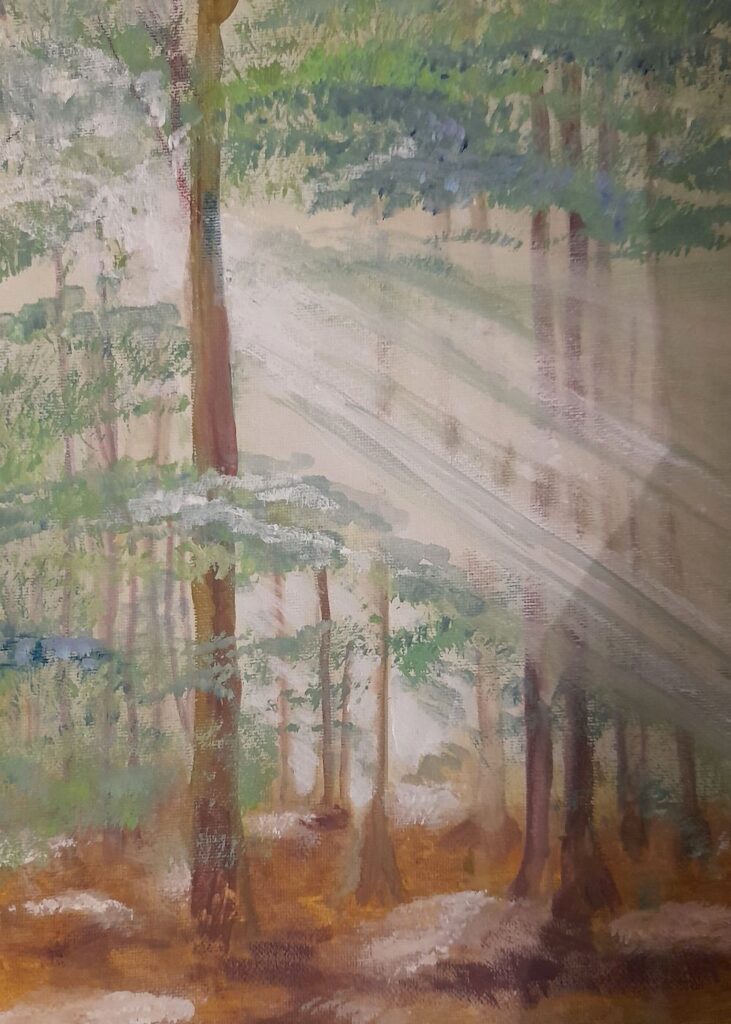
by Kate

by Anne C
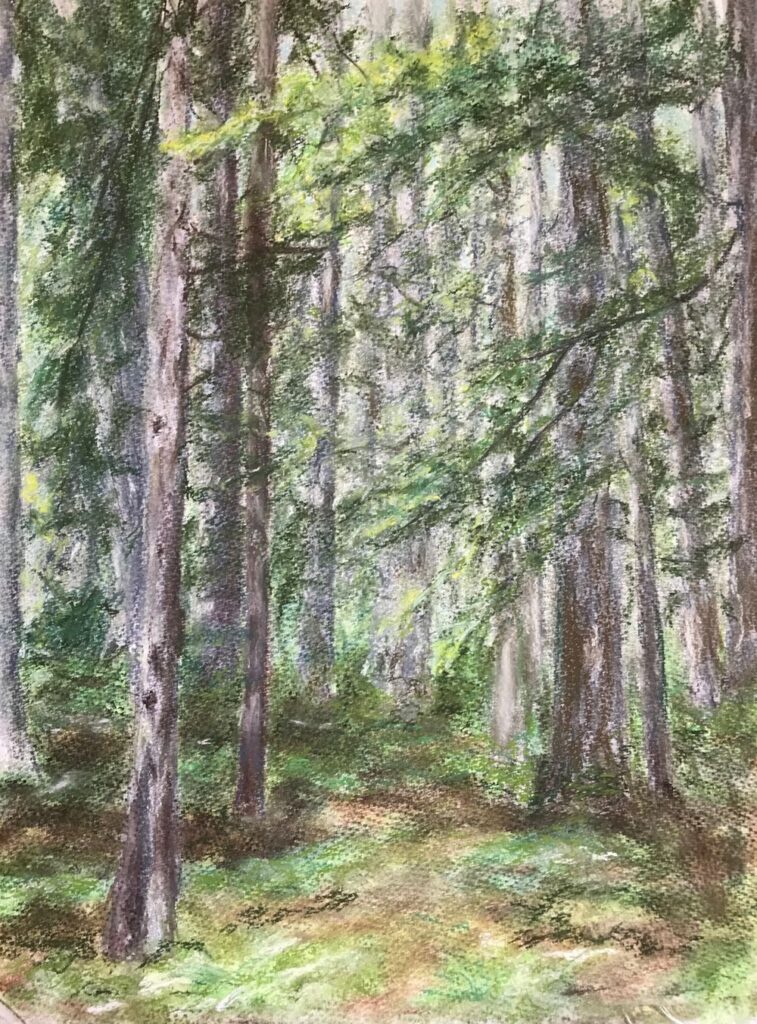
Watercolour and Pastel by Mali

Watercolour and pastel by Mali

Ink drawing by Sarah
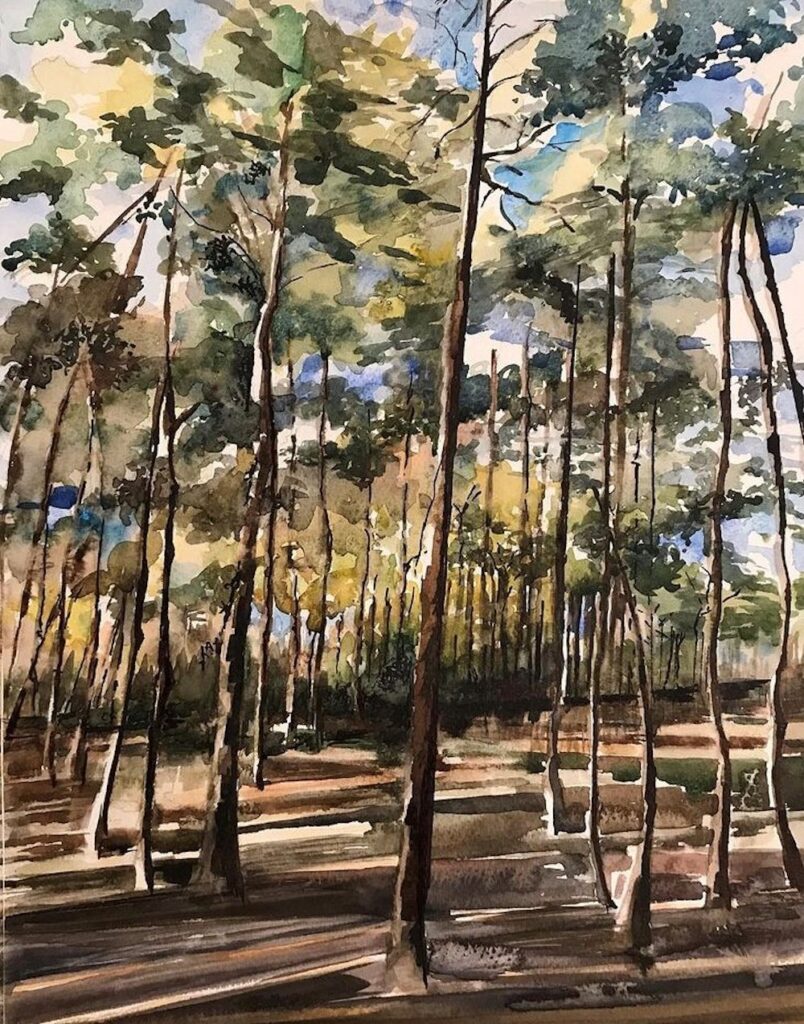
Watercolour by Sarah

Pastel by Liz
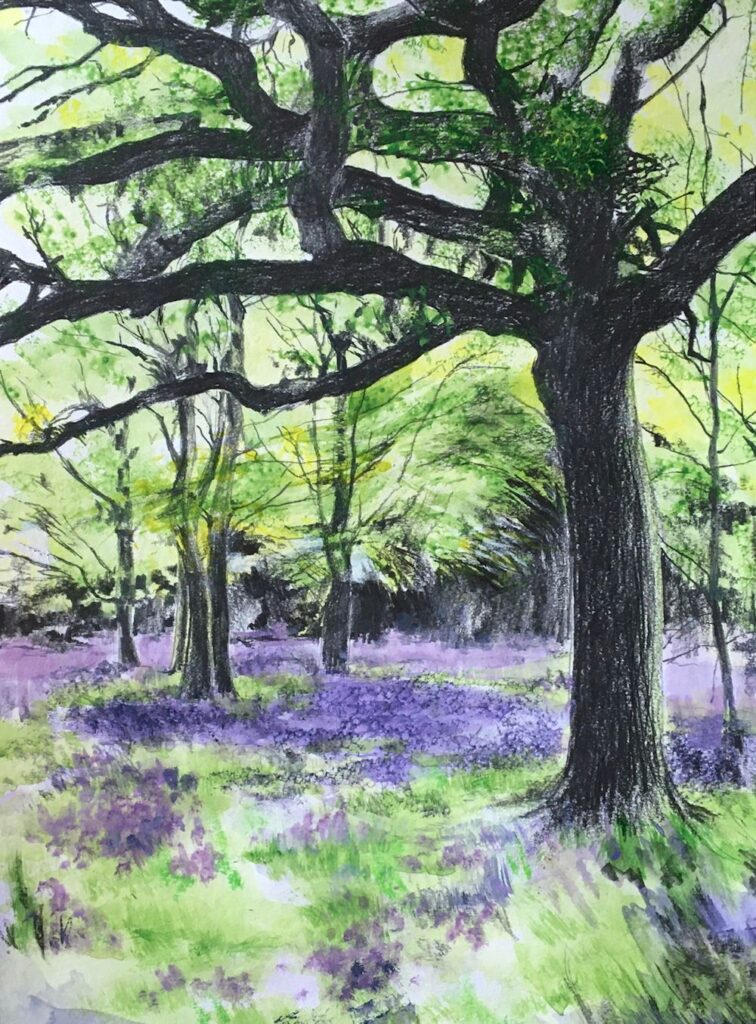
(unfinished)
Mixed media by Maryon
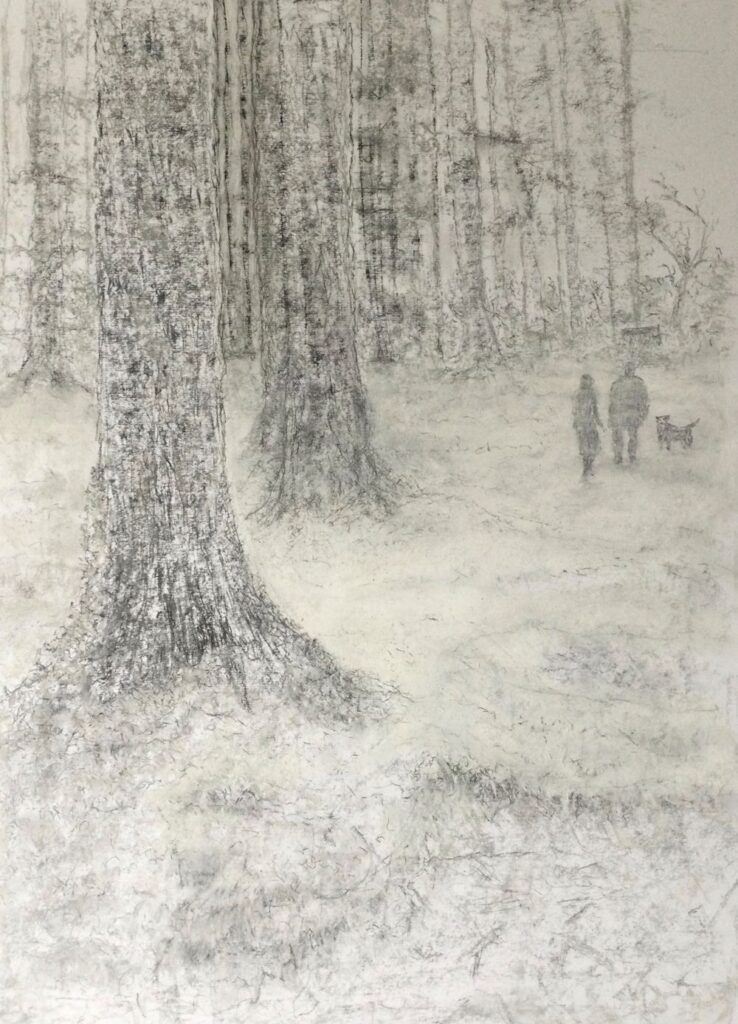
by Virginia
Drawing Trees Week 3: The Struggle for Life
March 9, 2022
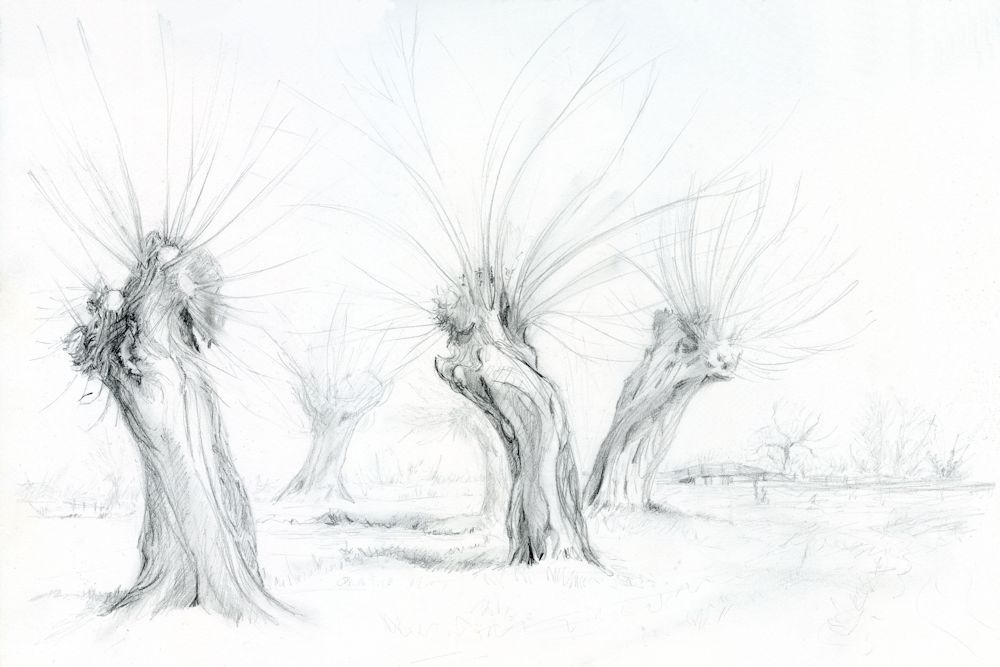
becoming twisted and split as in the photo below.
Note the sense of movement in these forms.
Sketched by Jo near Flatford Mill on the Stour
Storms, Lopping and other Struggles for Survival
Very few trees reach their perfect natural form. They are either hemmed in by others, damaged by storms and animals and of course, lopped, pruned, and coppiced by people.
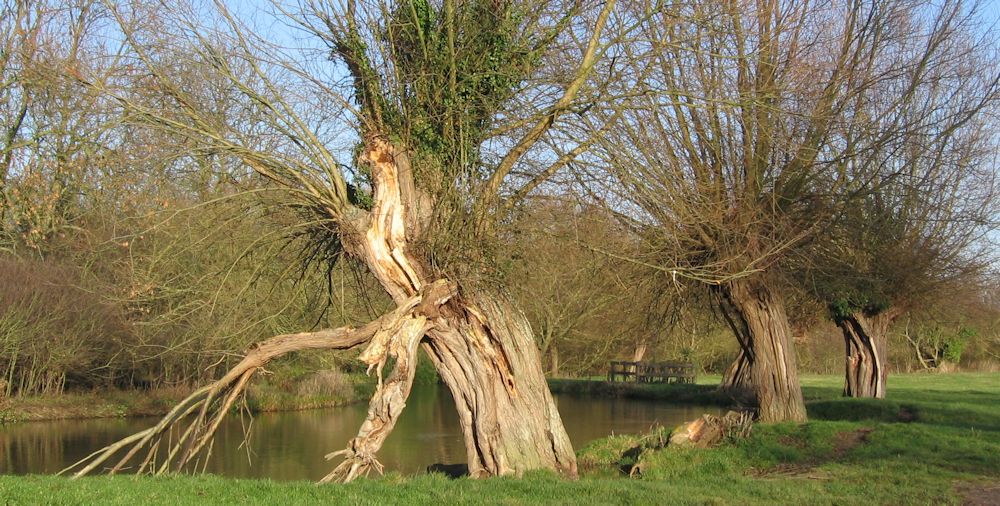
Part of the same walk as the sketch above
Photo by Jo
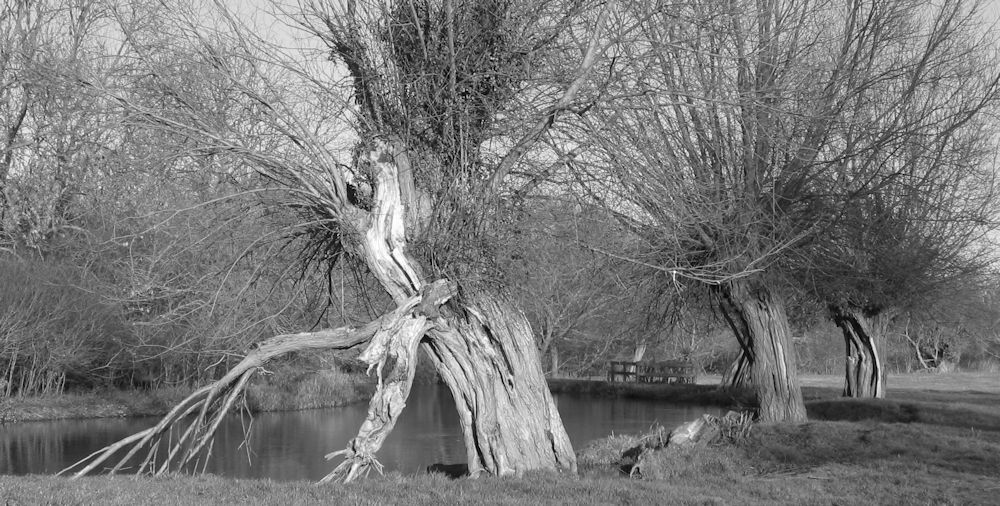
Whether you are drawing or painting in colour, remember that the tones are vitally important to the composition. Note the palest and darkest parts of this image.
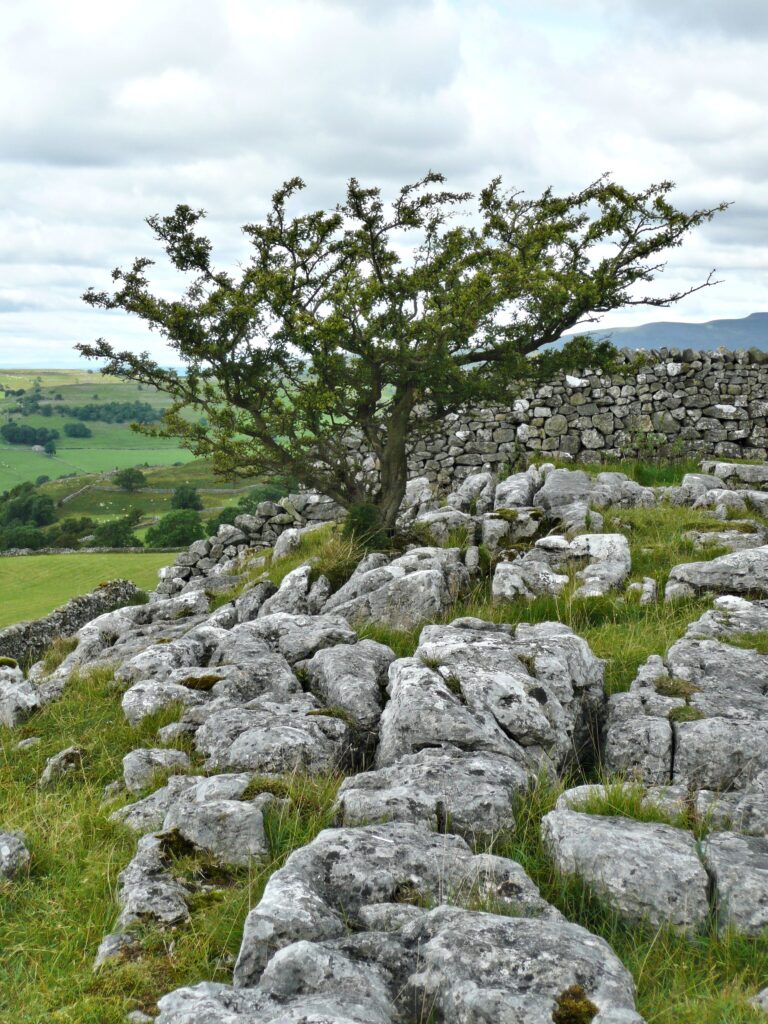
Photo by Jo
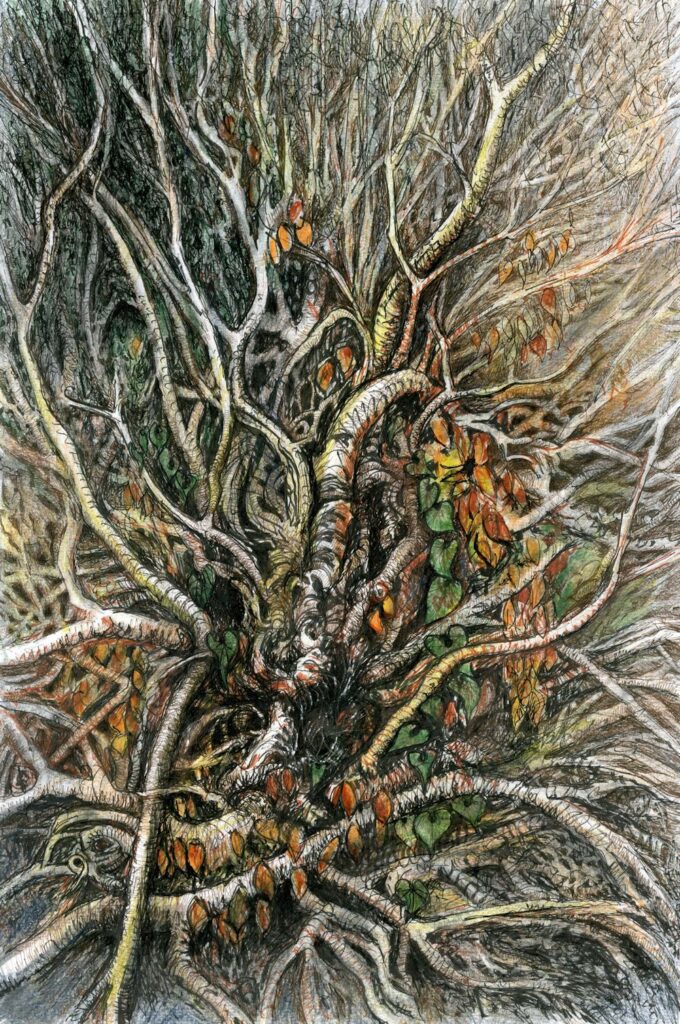
Ink and Watercolour
This is a tangle of overgrown ivy roots rather than the aftermath of a storm uprooting a tree. The challenge of depicting overlapping is much the same though.
Project : Draw a tree that has been caused to struggle for survival by; a challenging environment, lopping, a harsh prevailing wind, lightning damage, being uprooted etc.
Trees stuck by lightning can literally be torn apart but wind damage can be just as severe and result in the tree being uprooted and the tangle of roots made visible. Like branches these root tangles overlap and thread through each other even more so than branches above ground.If a tree near you has come down do get out with your sketchbook and a camera. Make sketches and/or photograph from several viewpoints before homing in on a composition for your final drawing.
The drawing may be a whole or part of a tree but should tell something of its history; probably a whole tree where it has grown with a distinct list to one side because of a prevailing high wind, but in the case of a fallen tree, perhaps just the exposed roots. Either way try to make an interesting composition.
Other suitable subjects would be stunted trees growing out of stoney ground, or choked by Ivy.
Your drawings:
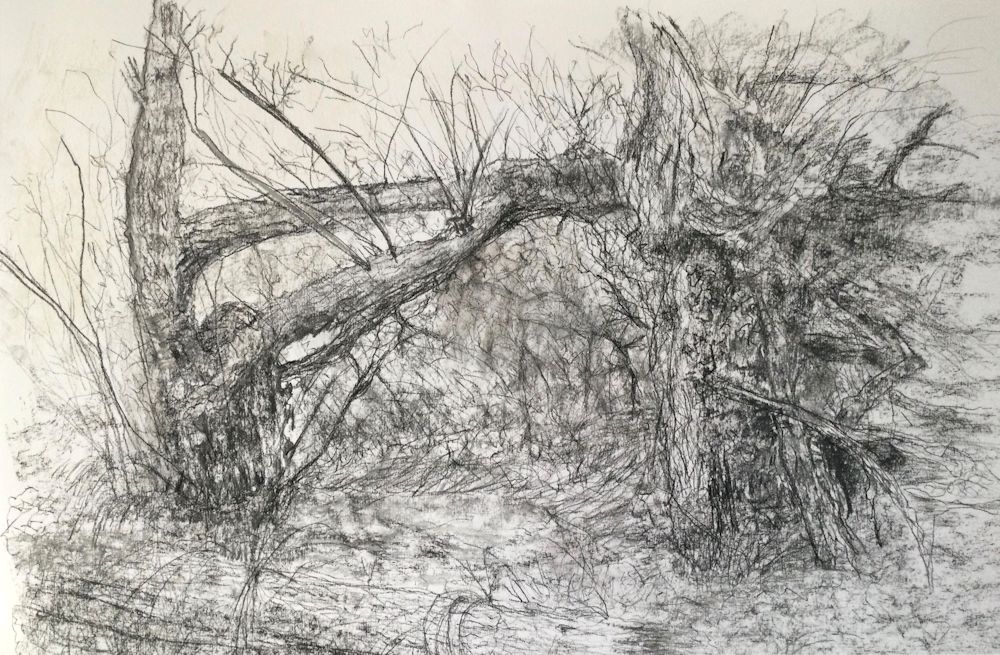
by Virginia
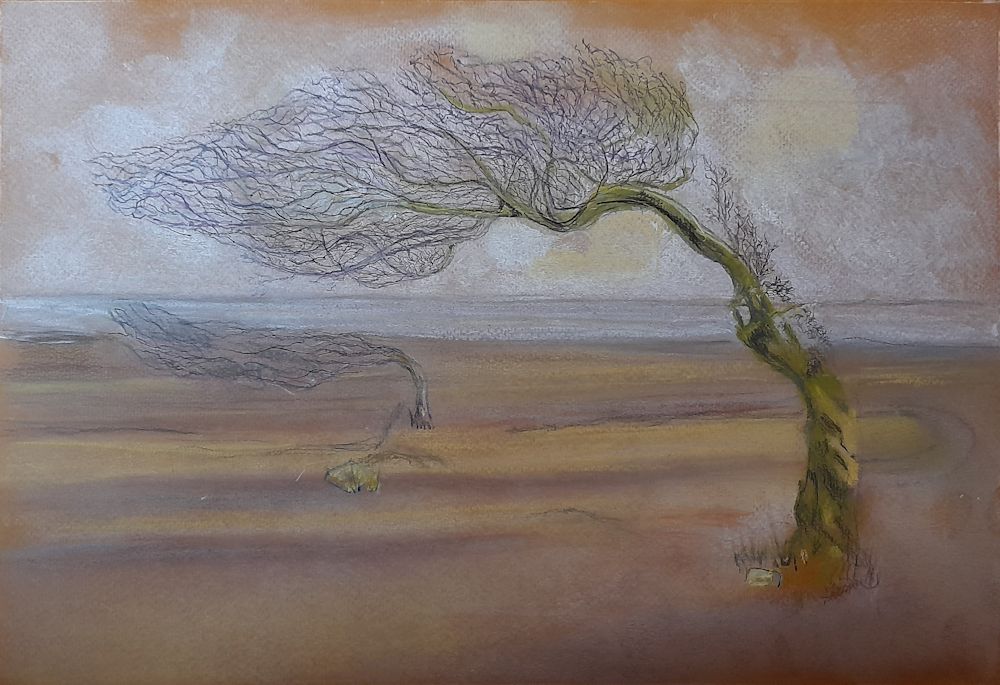
by Kate
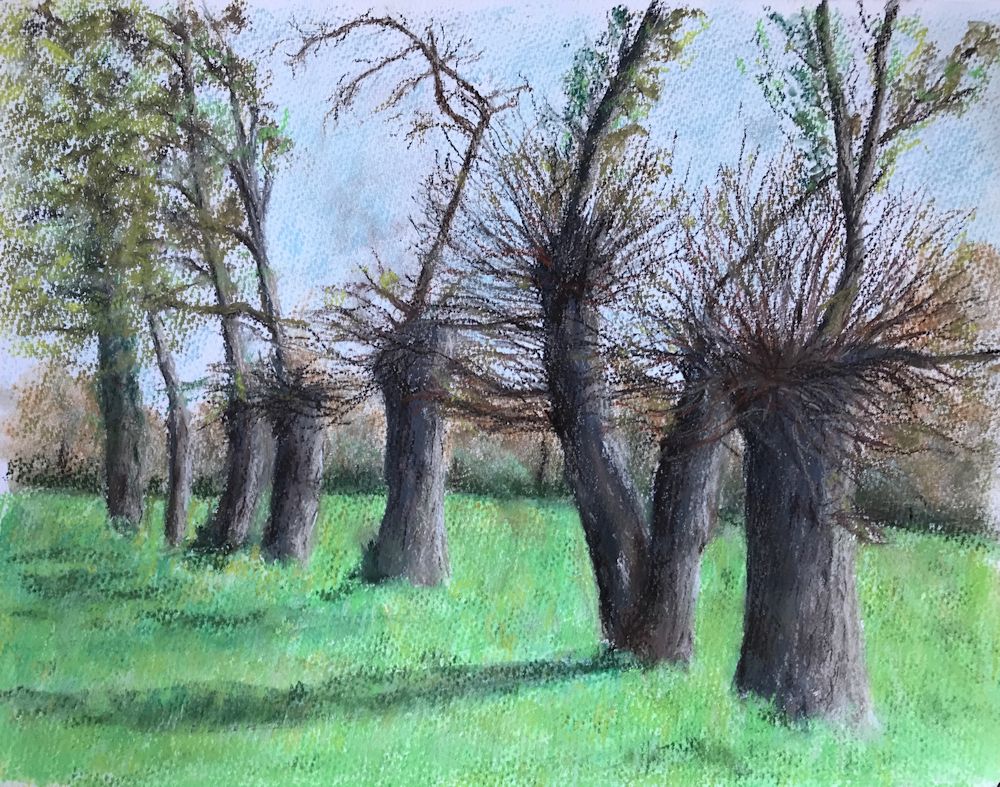
by Mali
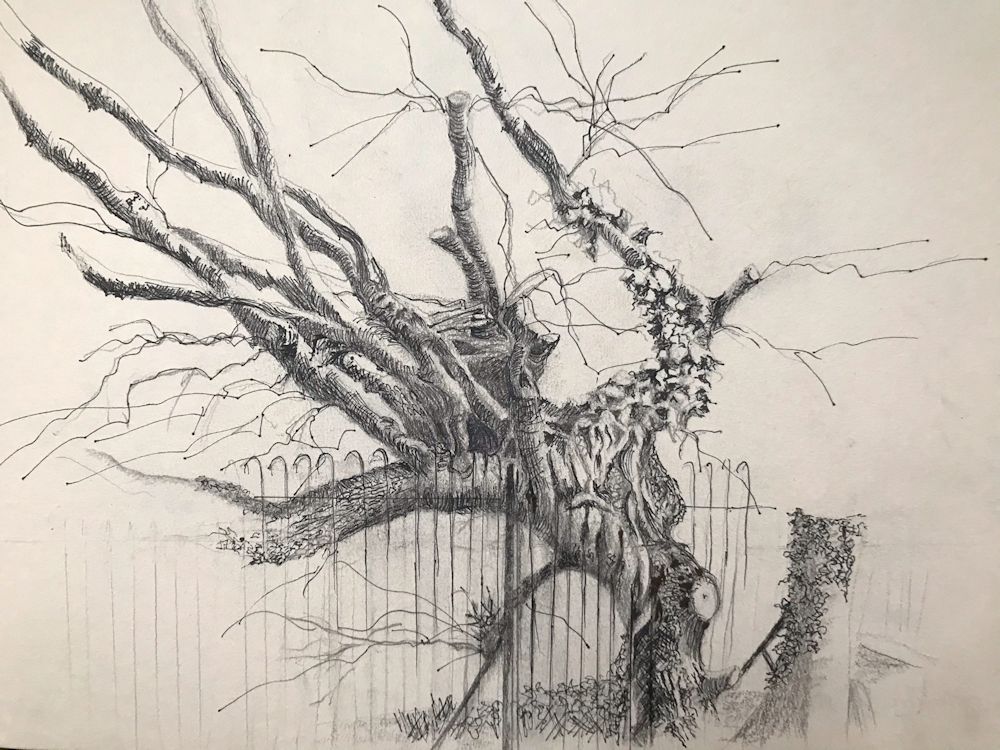
Pencil by Sarah
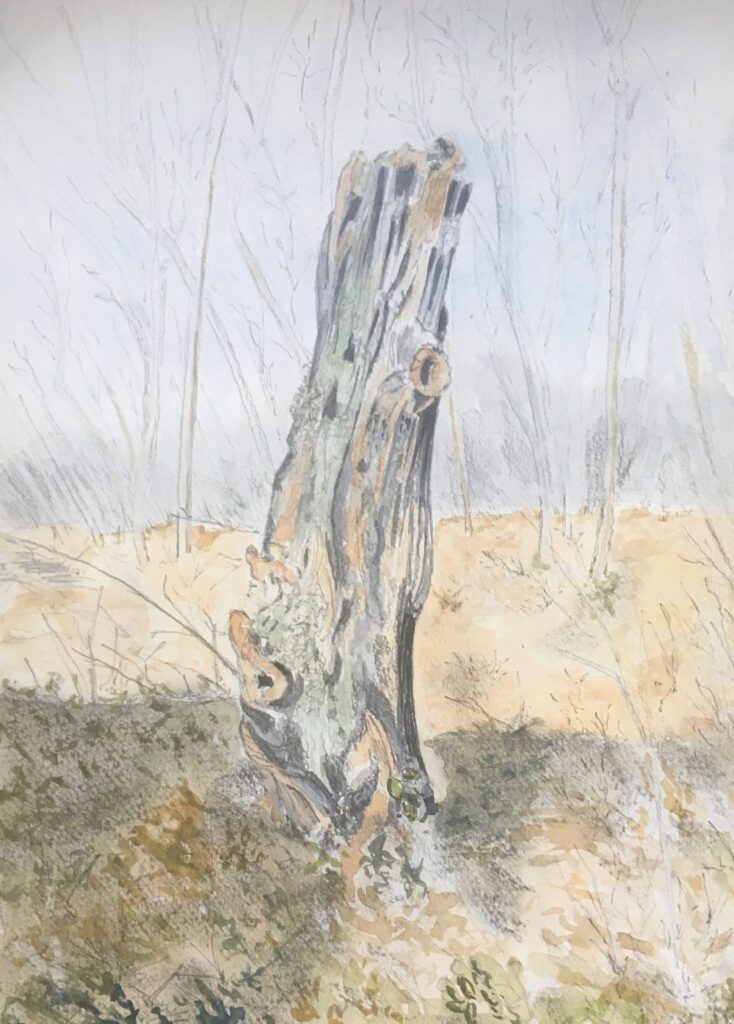
Pencil and Watercolour by Heather
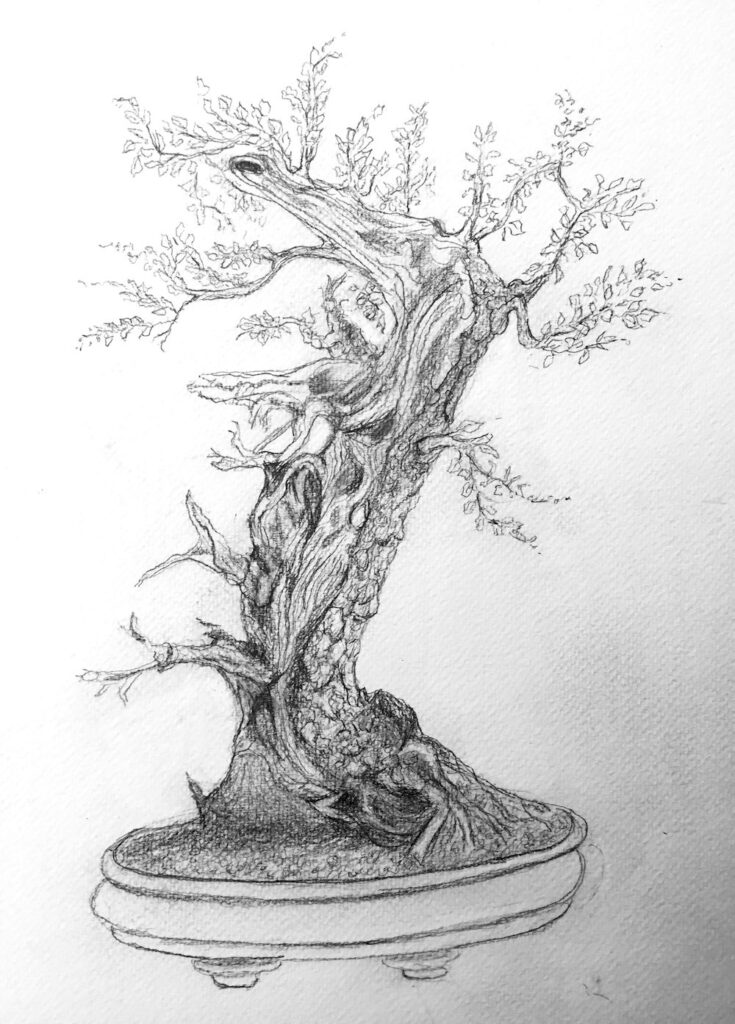
Pencil by Ann
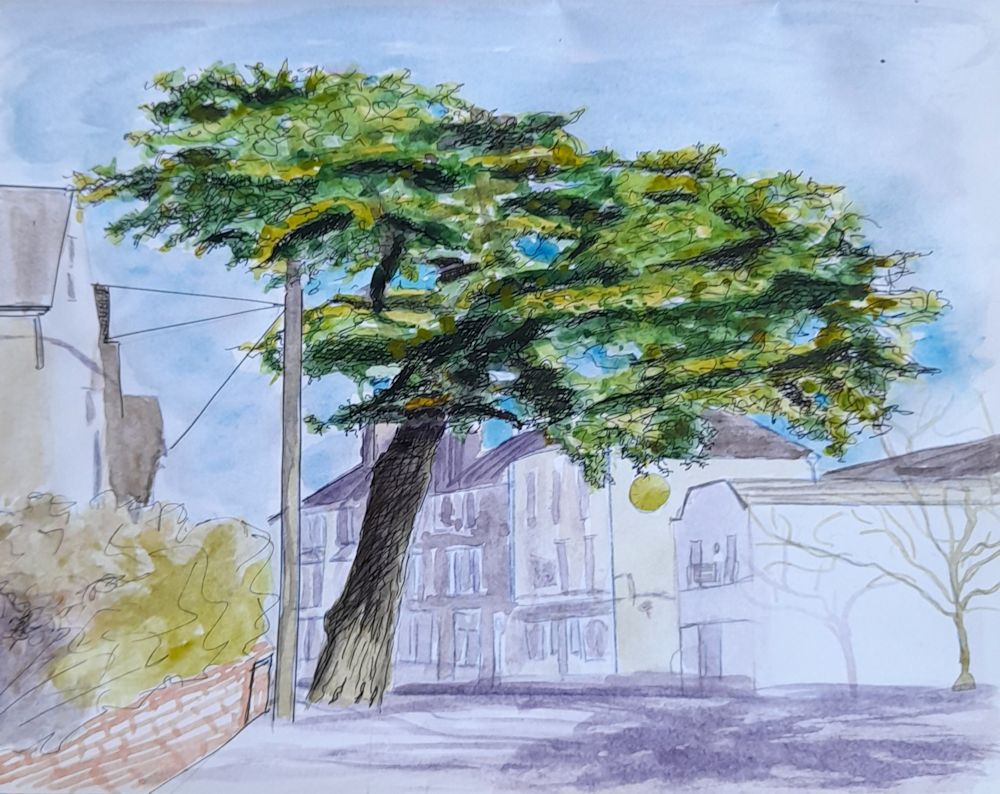
by Maricarmen
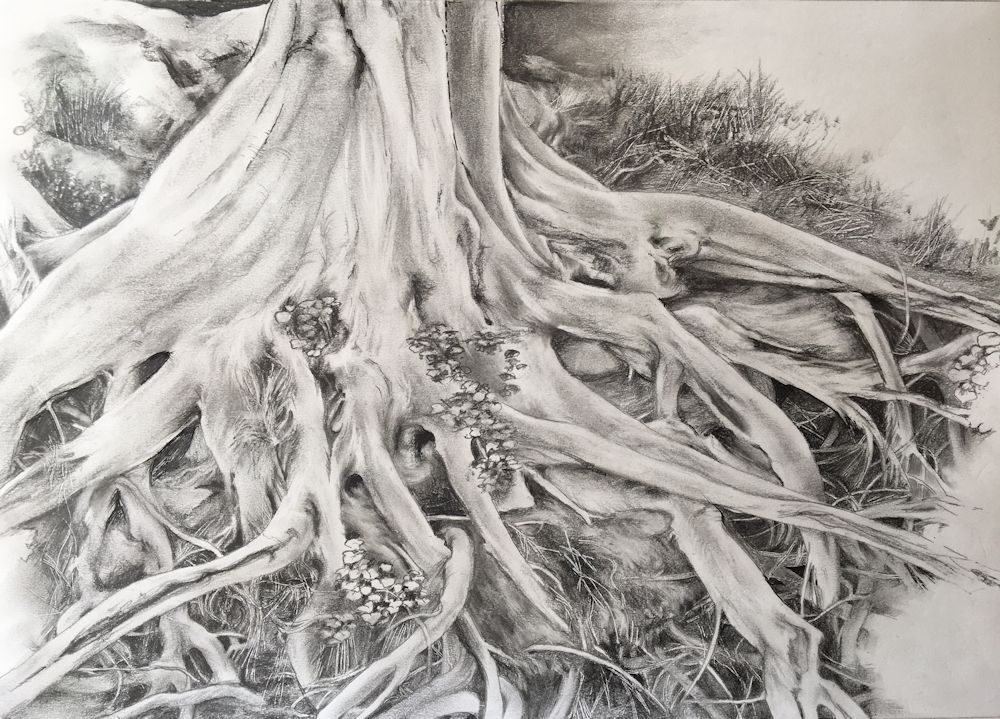
Seen by a dry river bed, Umfolsoi Game Reserve, South Africa
by Maryon
Soft charcoal, graphite sticks and embossing tool
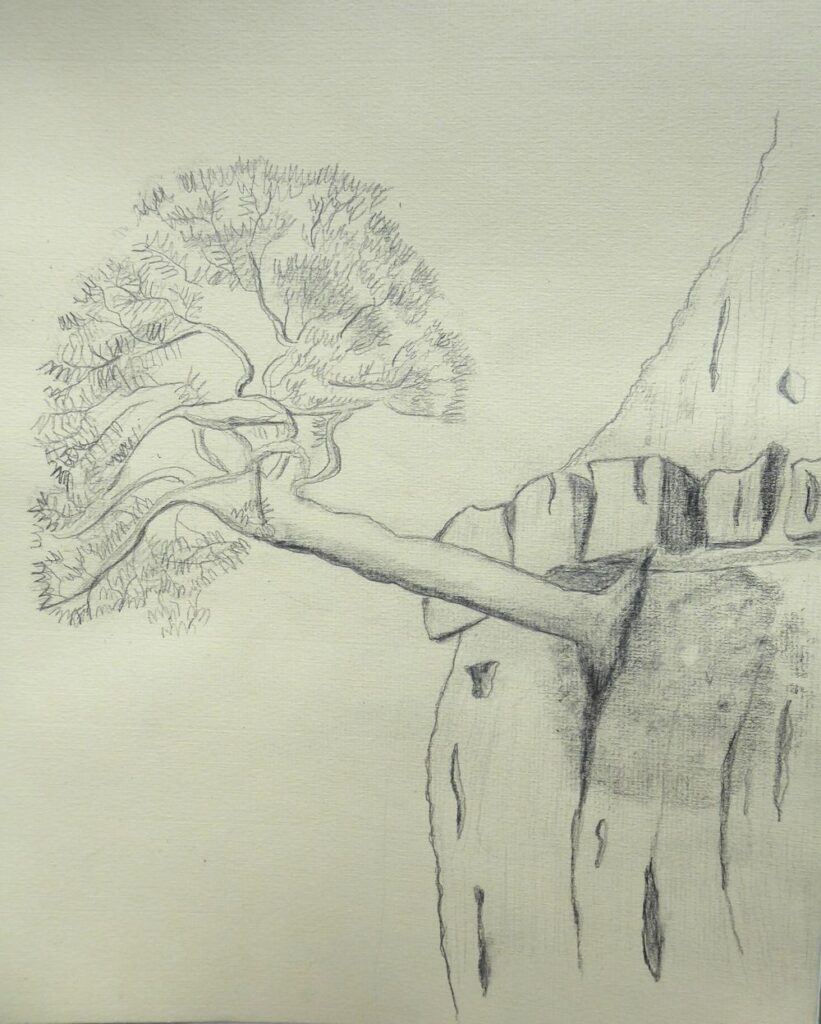
pencil by Anne C
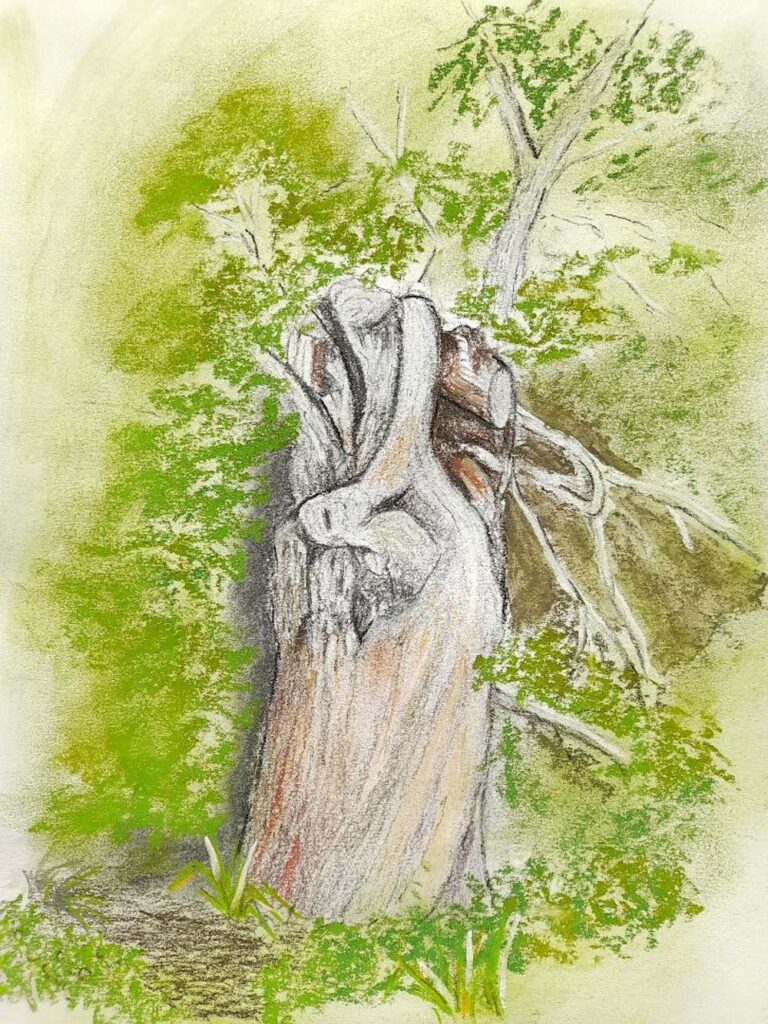
by Liz
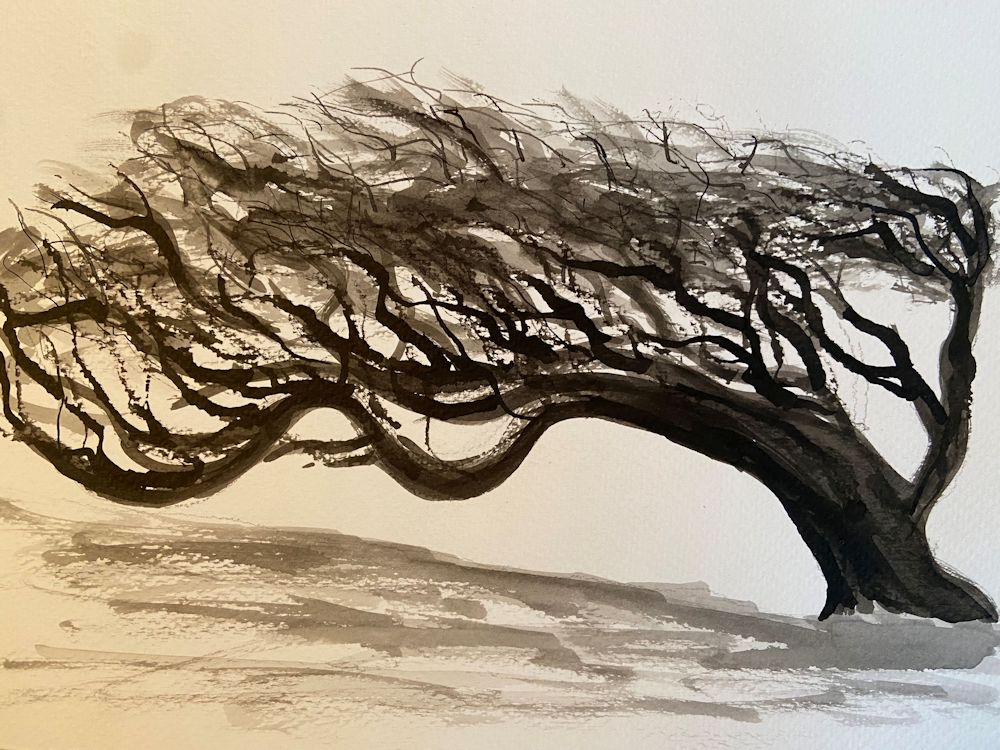
by Anne H
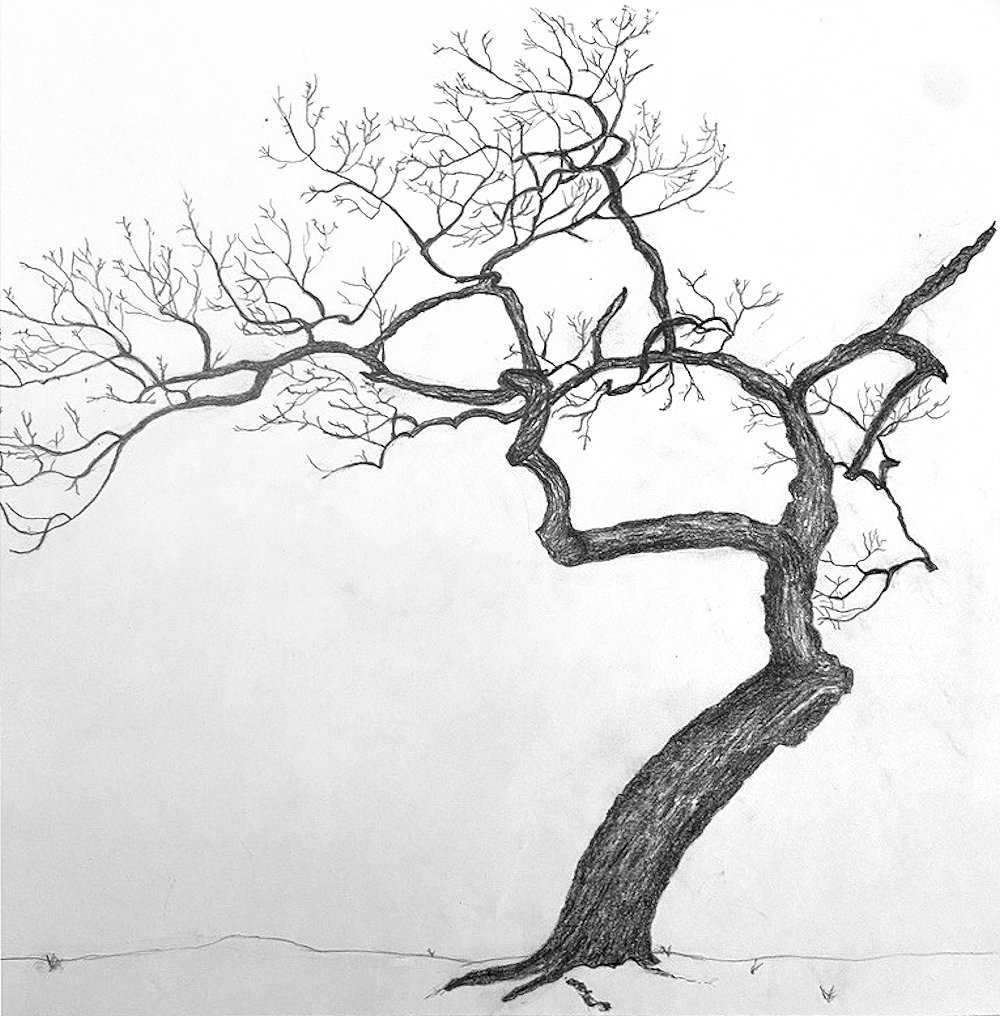
by Anne H
Drawing Trees Week 2: Scars, Bark and Branching
March 3, 2022

Ink, pastel and white gouache on green paper
This week we’ll get close up and look at more of the textures and structural details of trees. So we’ll look at their natural marks, bark patterns and branches, and also at healed wounds.
If you are fortunate enough to have a garden with trees you may like to embark on a project discovering its marks and structures. Perhaps start with the trunk and it’s bark and any scars from lopping or pruning, and observe how the patterns of bark change where a branch develops.
See how many small branches emanate from the stubs left behind when a branch is cut off. Sometimes this leads to huge thickenings as in the drawing of the Spanish Chestnut trunk above.
If you don’t have a garden try finding a tree nearby or work from photographic reference.
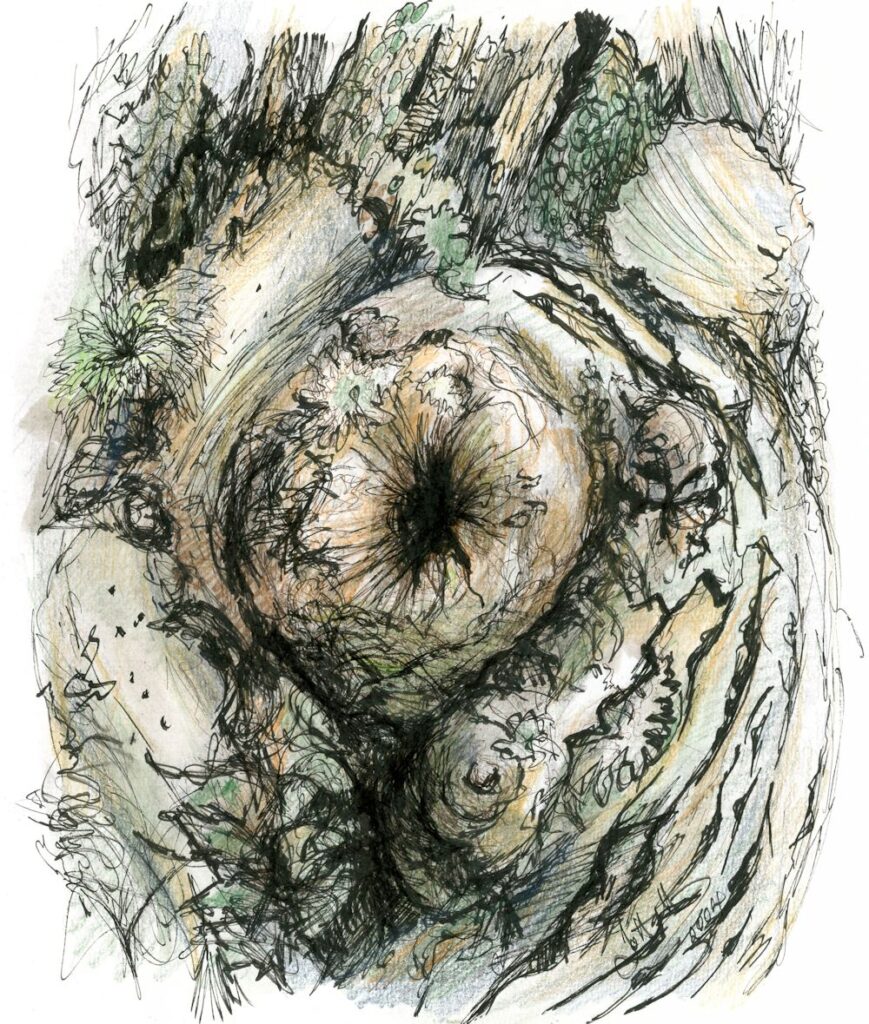
Ink and coloured pencil
Years before this became our apple tree, a major limb had been excised and the scar overgrown with lichen and moss.
A feast of texture!
Project : Make visual notes of at least two of the following in your sketchbook and then make a considered drawing of a part of the tree that sustains your interest. It’s not a comprehensive list so feel free to add your own ideas.
1.Branches: observe whether these follow any sort of pattern, or in the case of palm or banana trees how do the leaves emerge and what happens to the dead leaf bases?
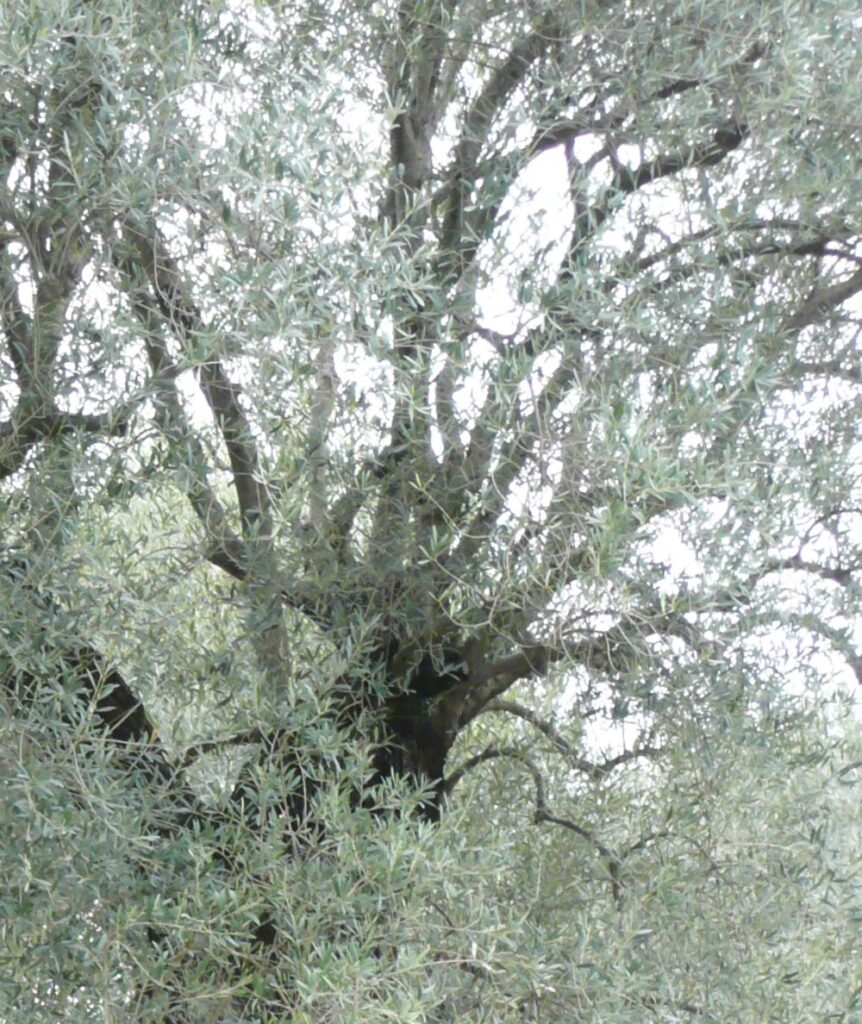
Photo by Jo
2.Bark patterns and marks as they appear on the main trunk and branches; also some trees shed bark pieces, some of the pines do and pieces can be gathered and drawn indoors. More detailed studies of these can appear quite abstract.
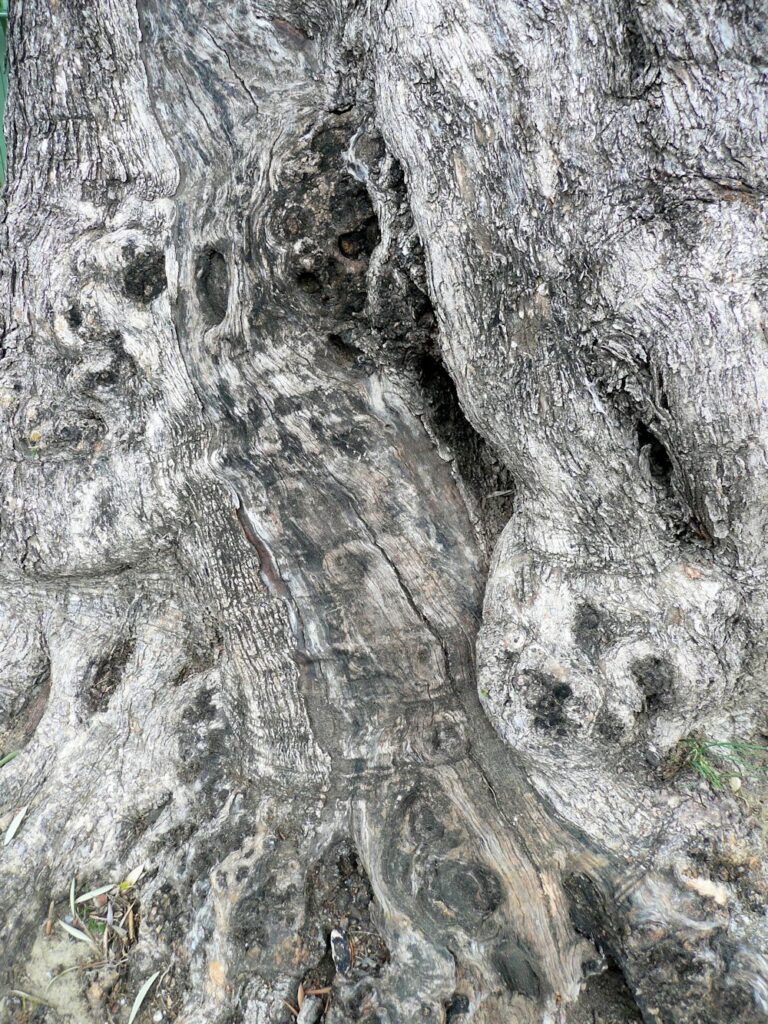
Photo by Jo
3.At branch points sketch how the pattern of the bark changes where new growth emerges
4.Scars and new growth
5.Exposed roots at the base of the trunk
6.Make notes of other life like lichens and moss that cover the bark in places introducing different textures or patterns.
You will have gained a huge amount of information about the tree in this drawing exercise and have found mark making equivalents for some of the patterns and textures observed on the way. Finally make a drawing of a tree, choosing not to draw the whole tree this time, but a part you find particularly interesting.
Your drawings:
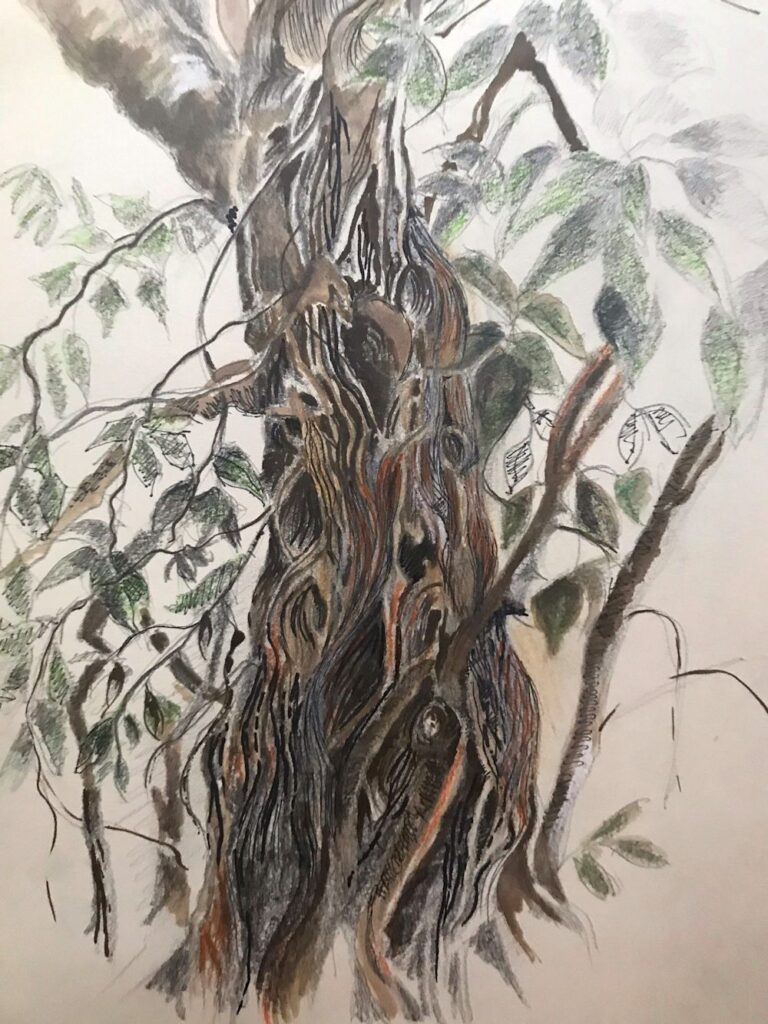
Mixed media drawing by Sarah
6B pencil, black ink and walnut ink, pastel pencil

Pencil by Sarah
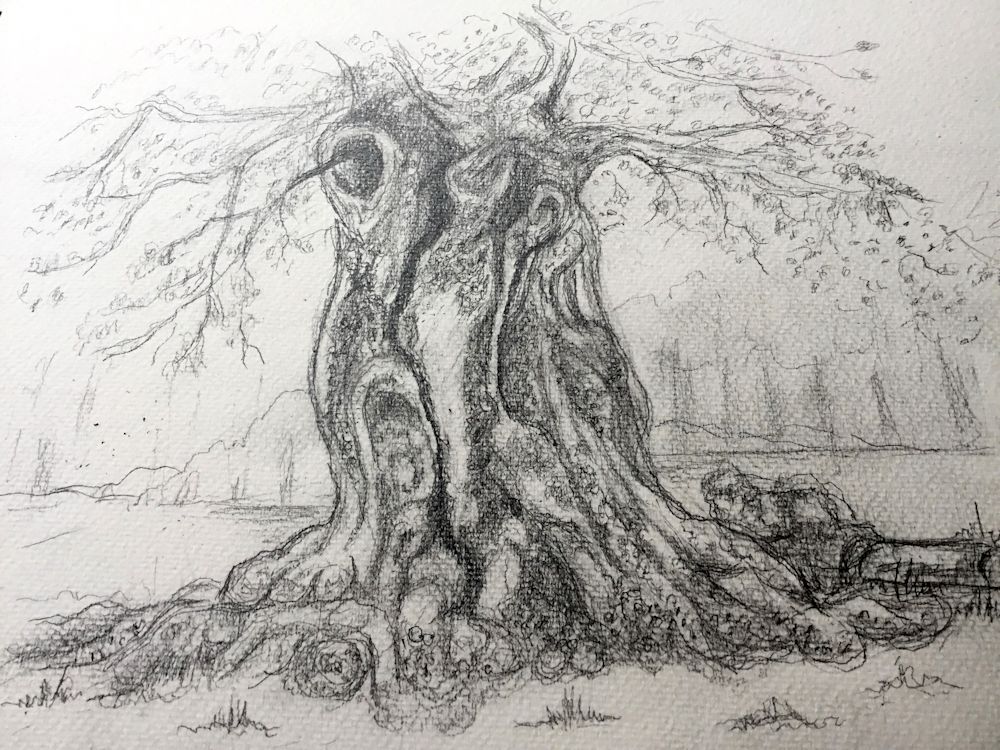
Pencil by Ann
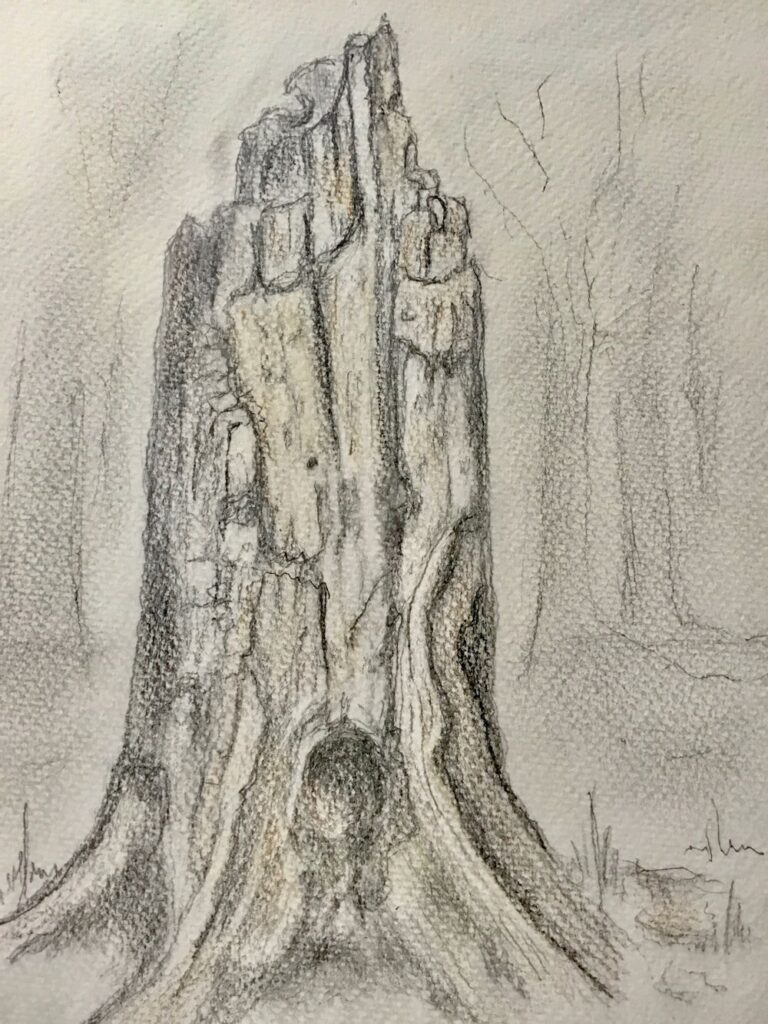
Pencil by Ann
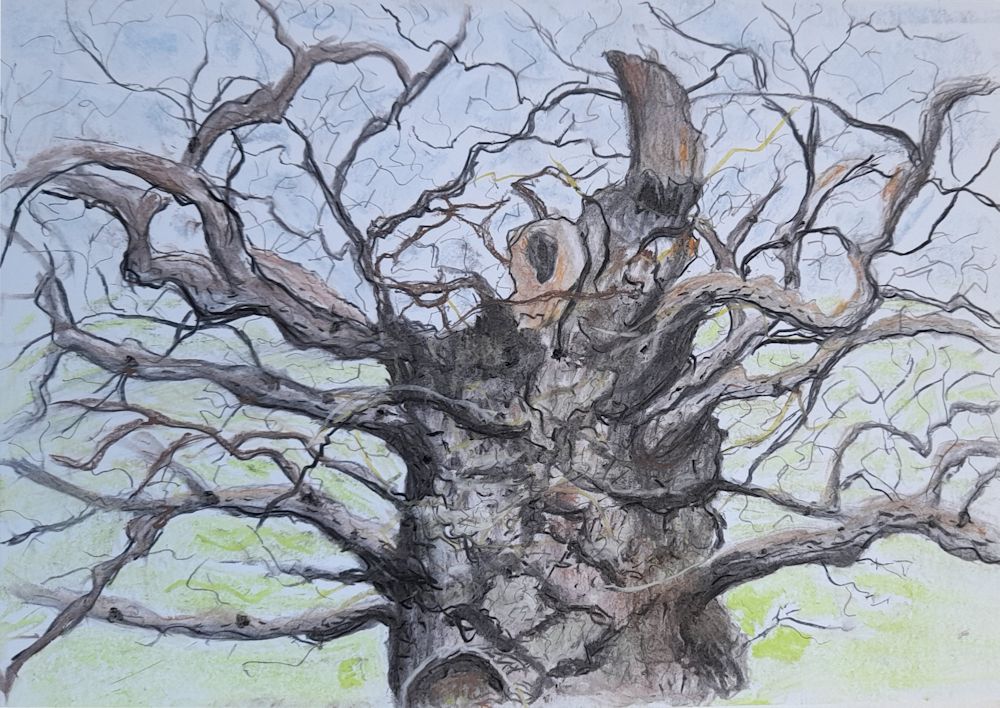
by Maricarmen
How surreal: I feel the oak is watching us!
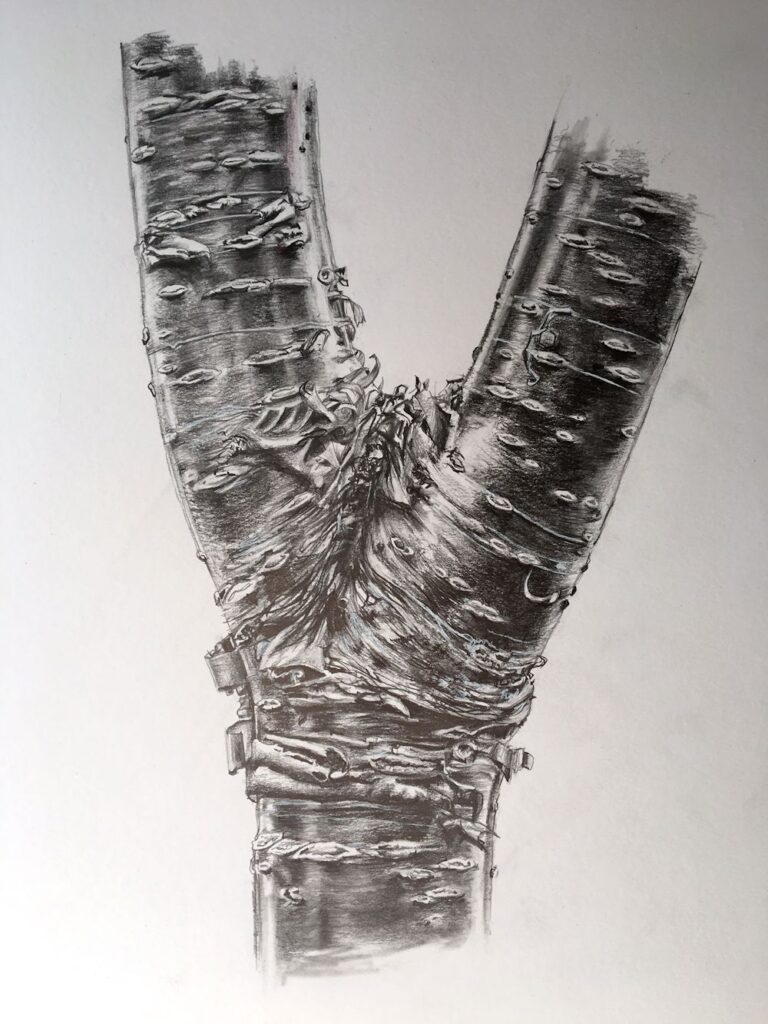
Graphite on A3 paper by Maryon

Pencil by Anne C
Heather has drawn from the same reference in three different media!
See below;
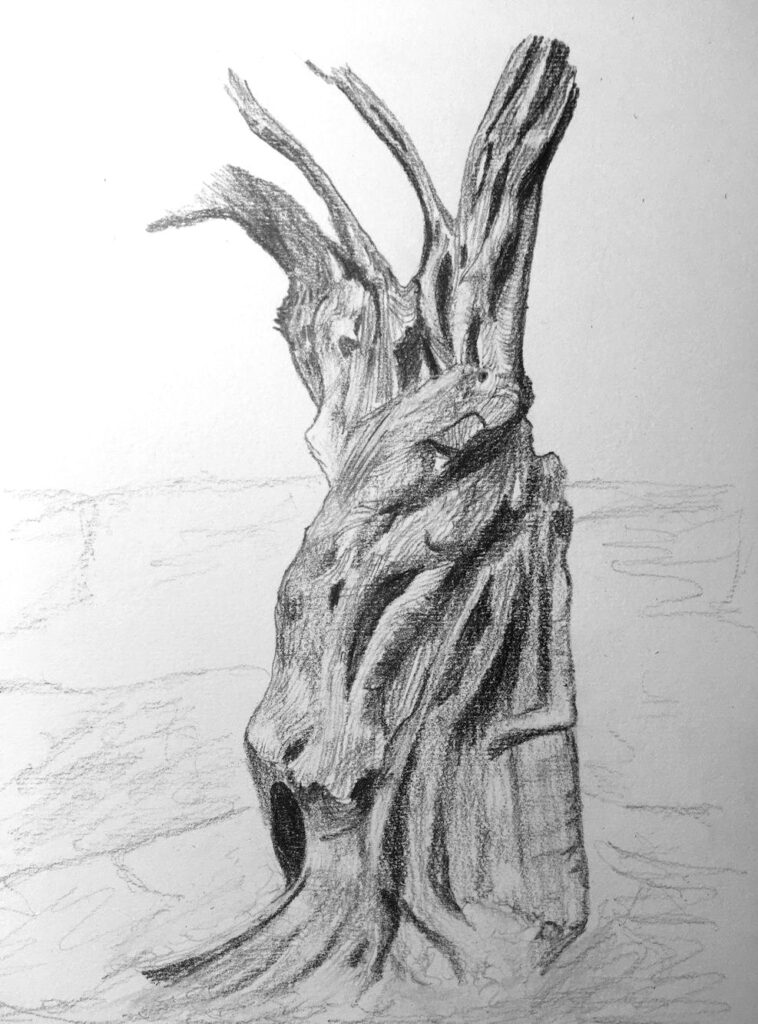
Pencil by Heather
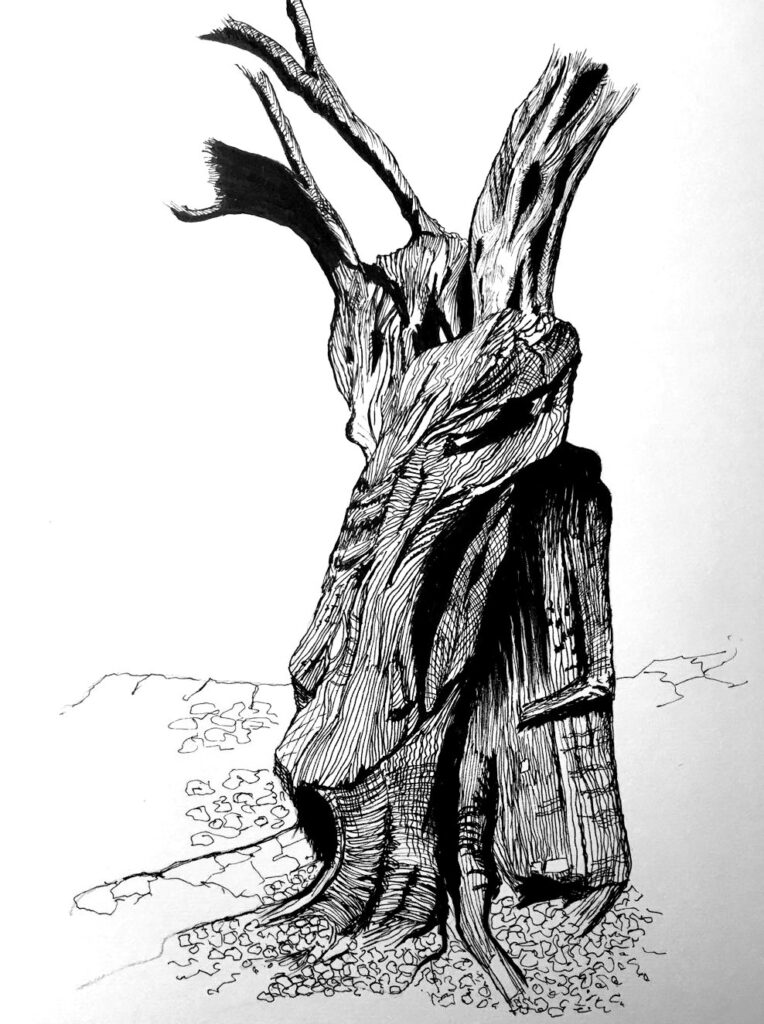
Black ink on white paper by heather
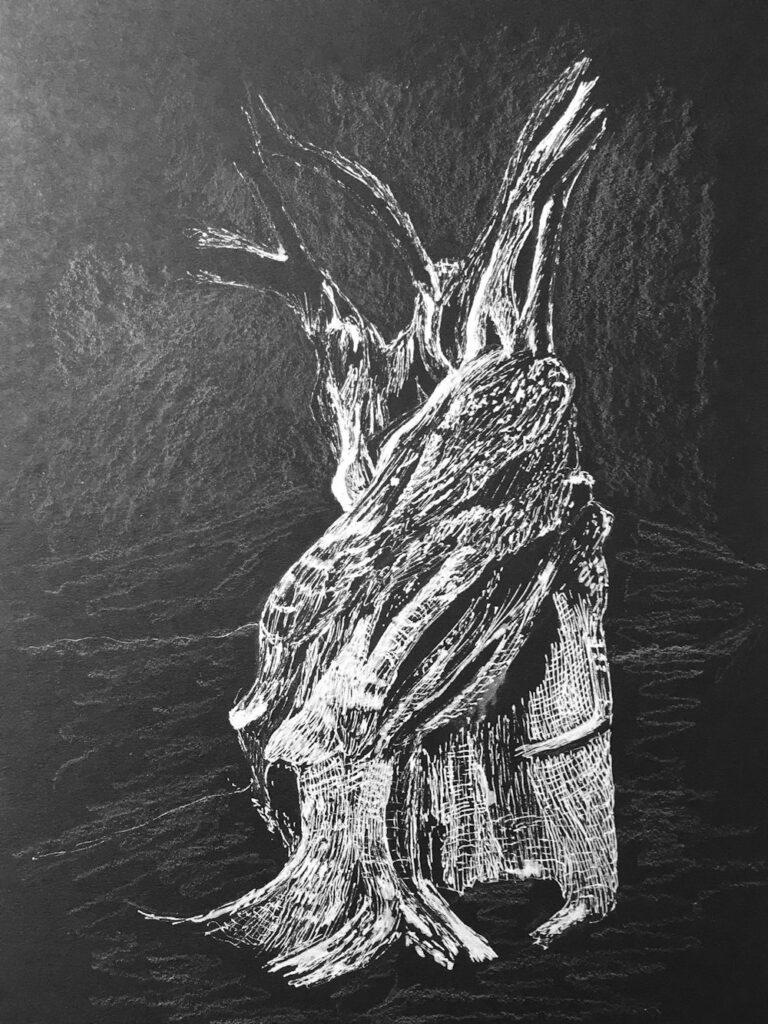
White ink on black paper by Heather

by Mali
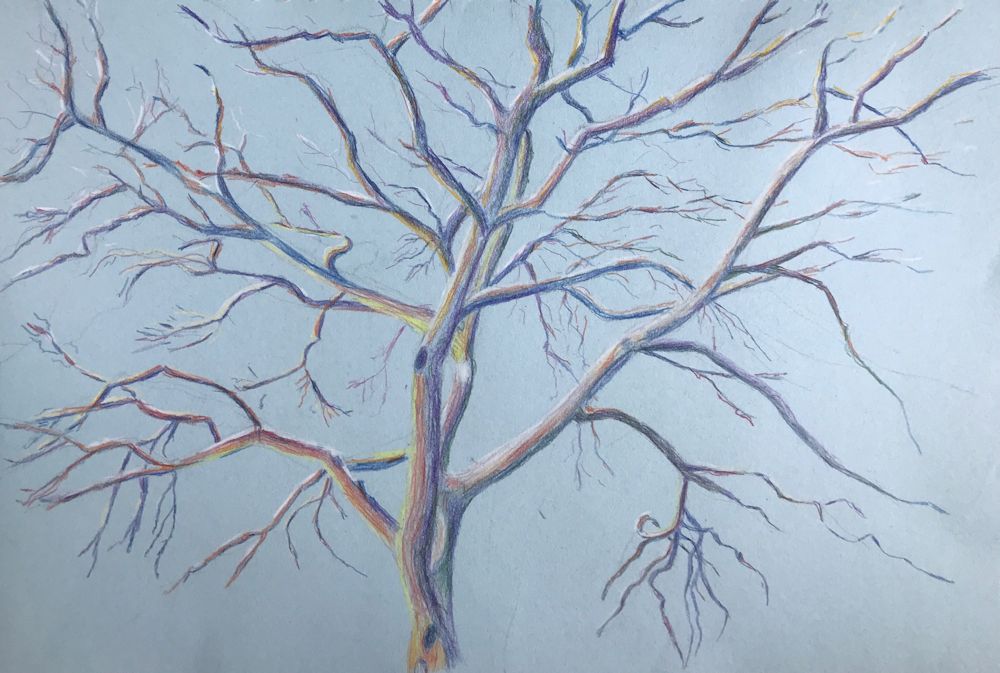
by Mali
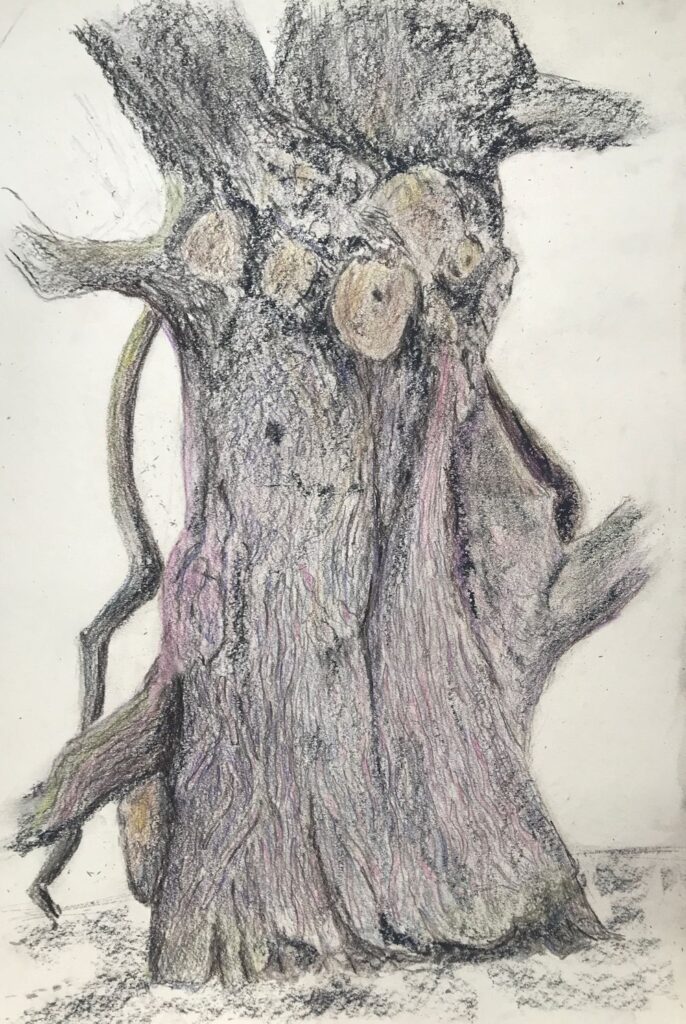
by Mali
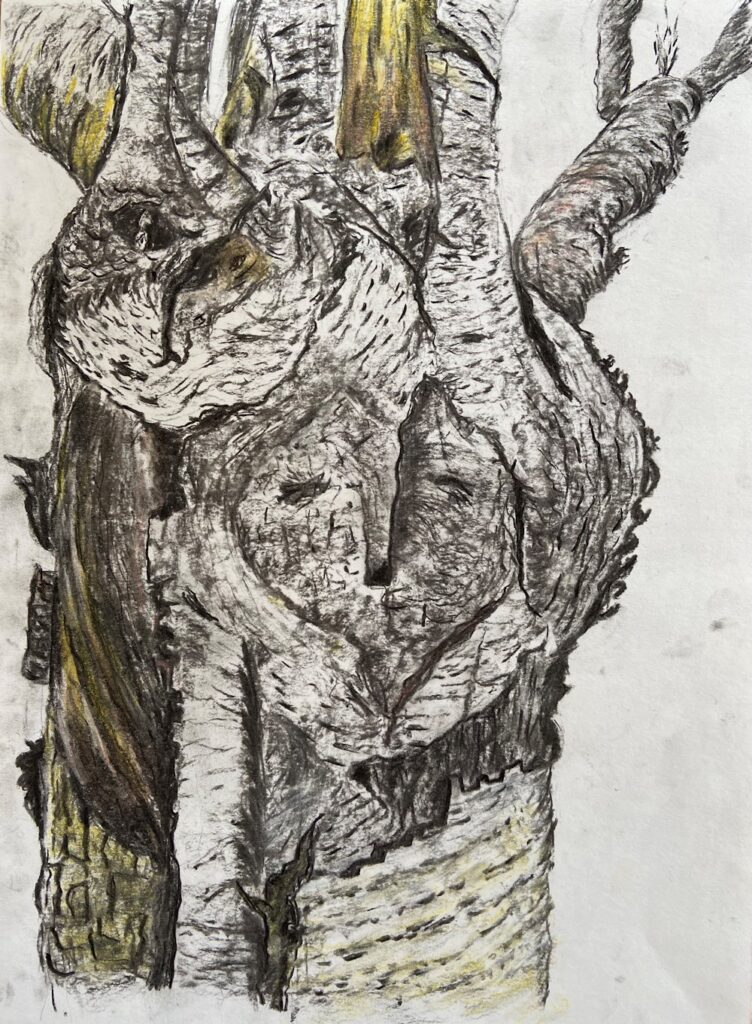
by Anne H
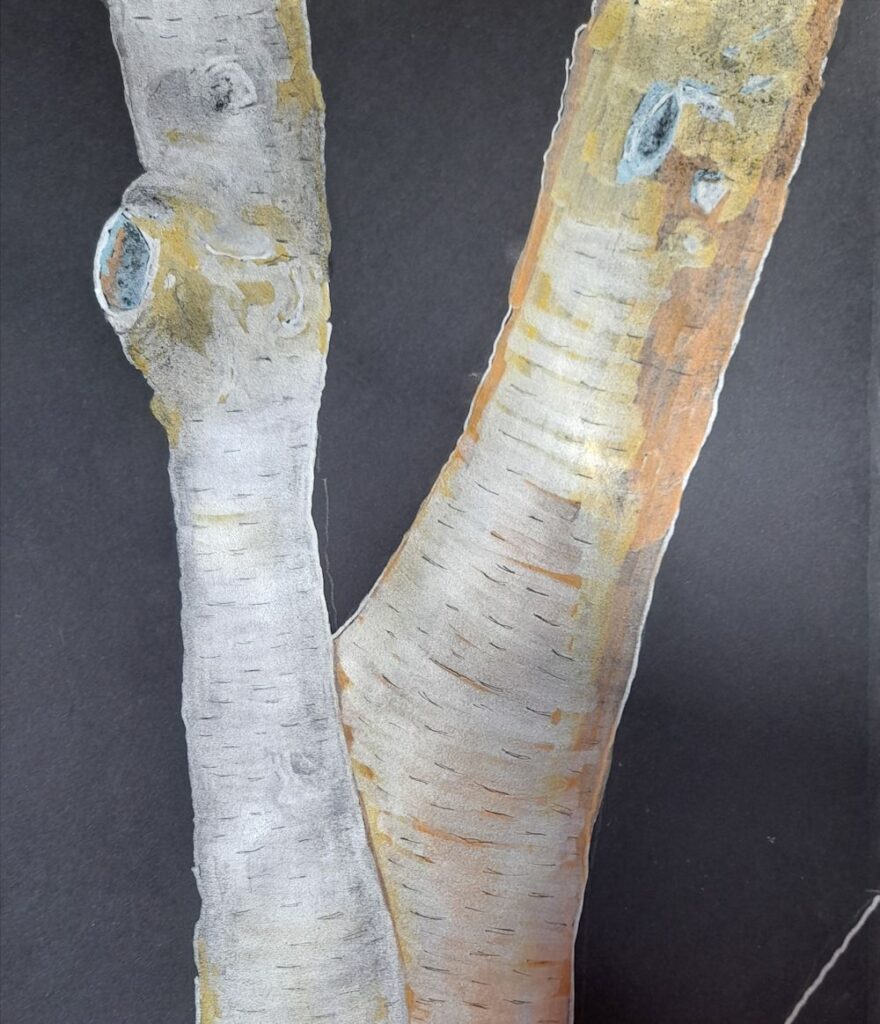
by Kate
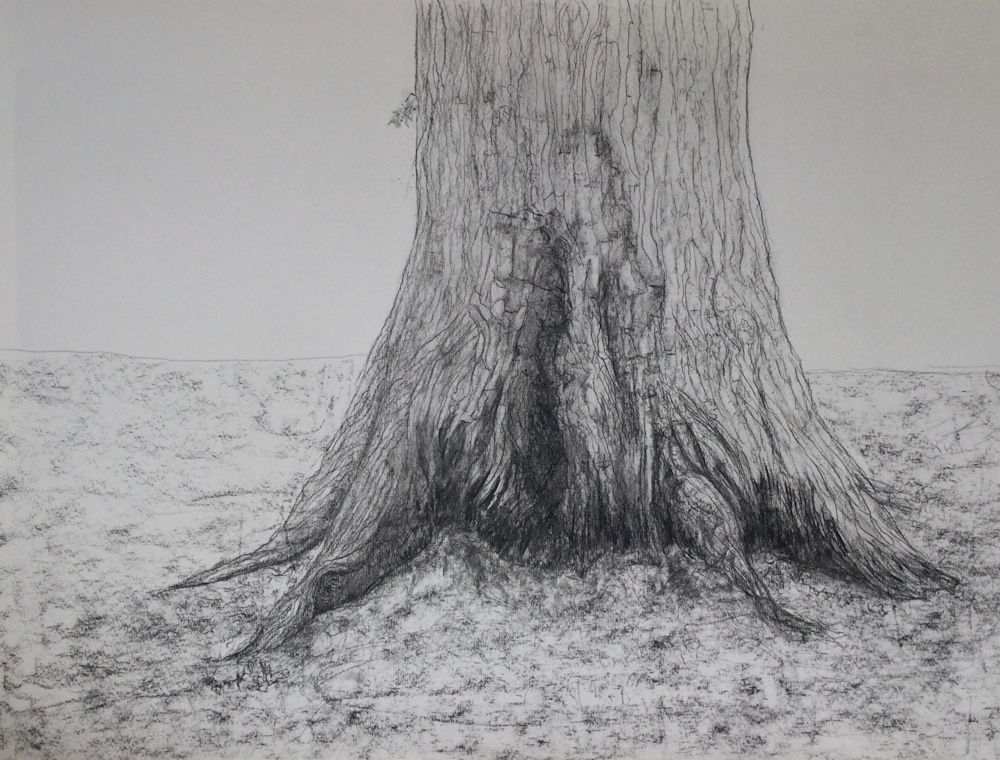
by Virginia
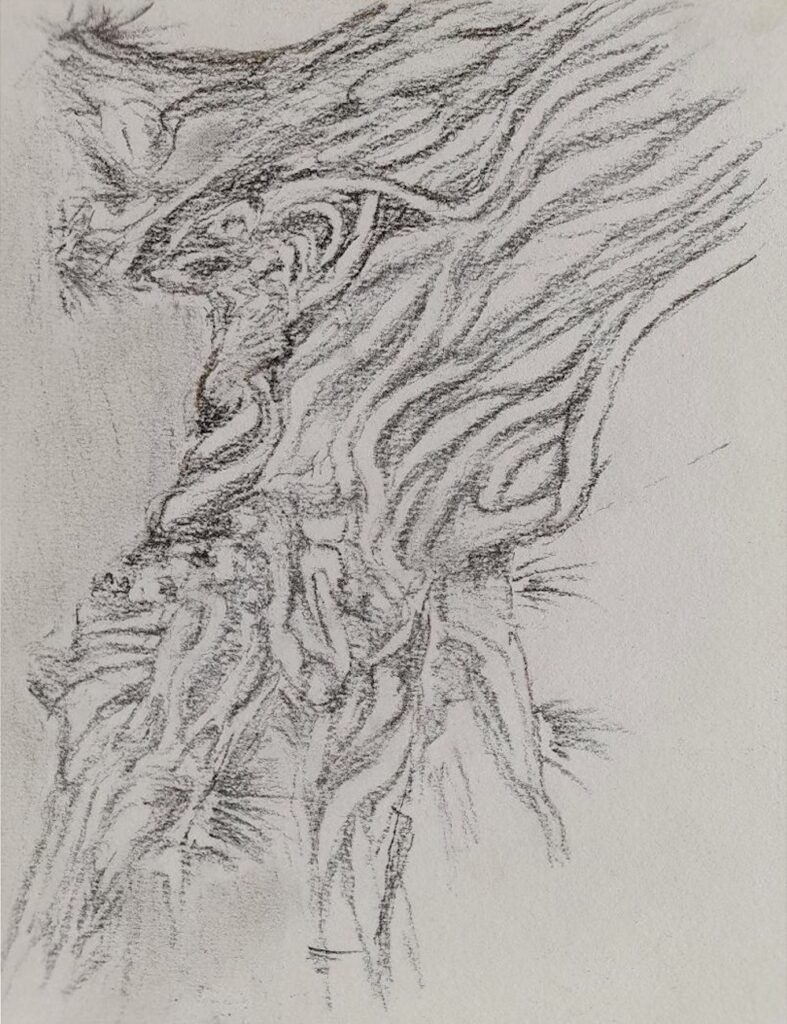
by Liz
